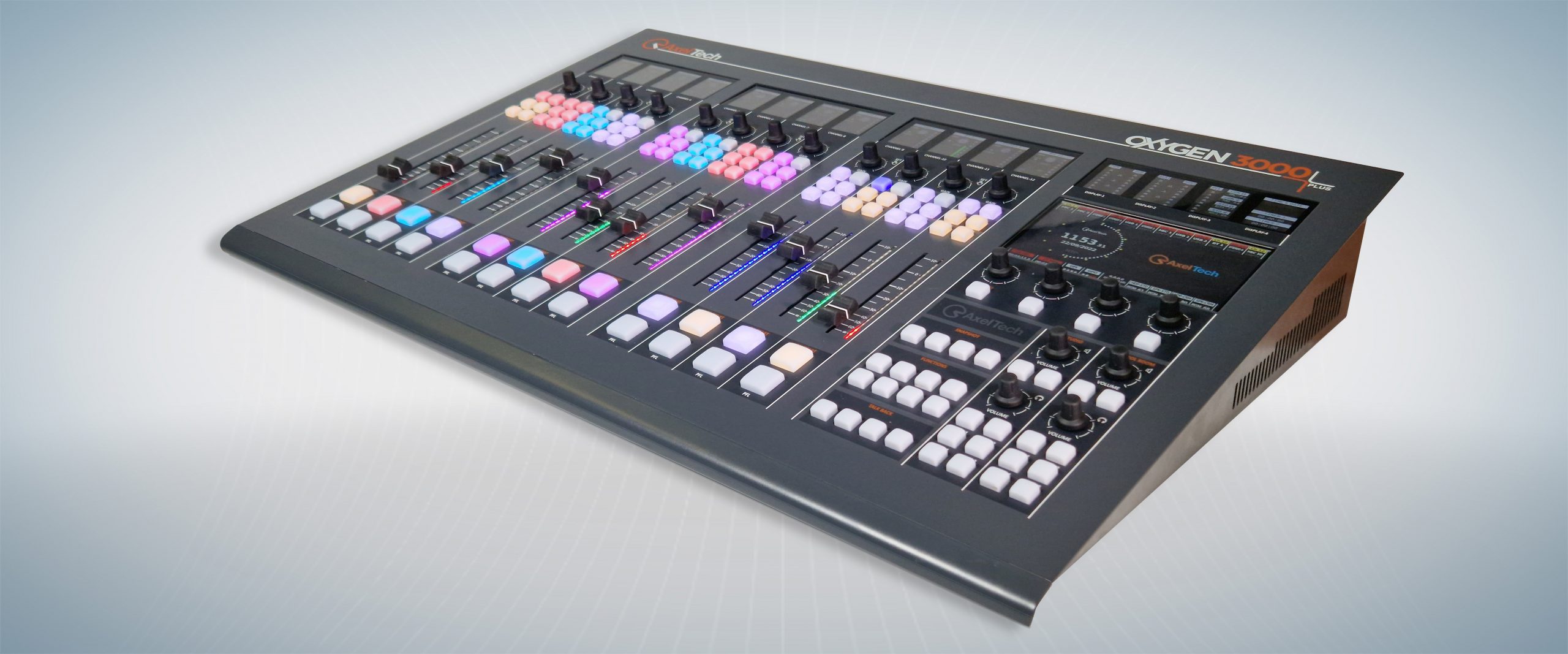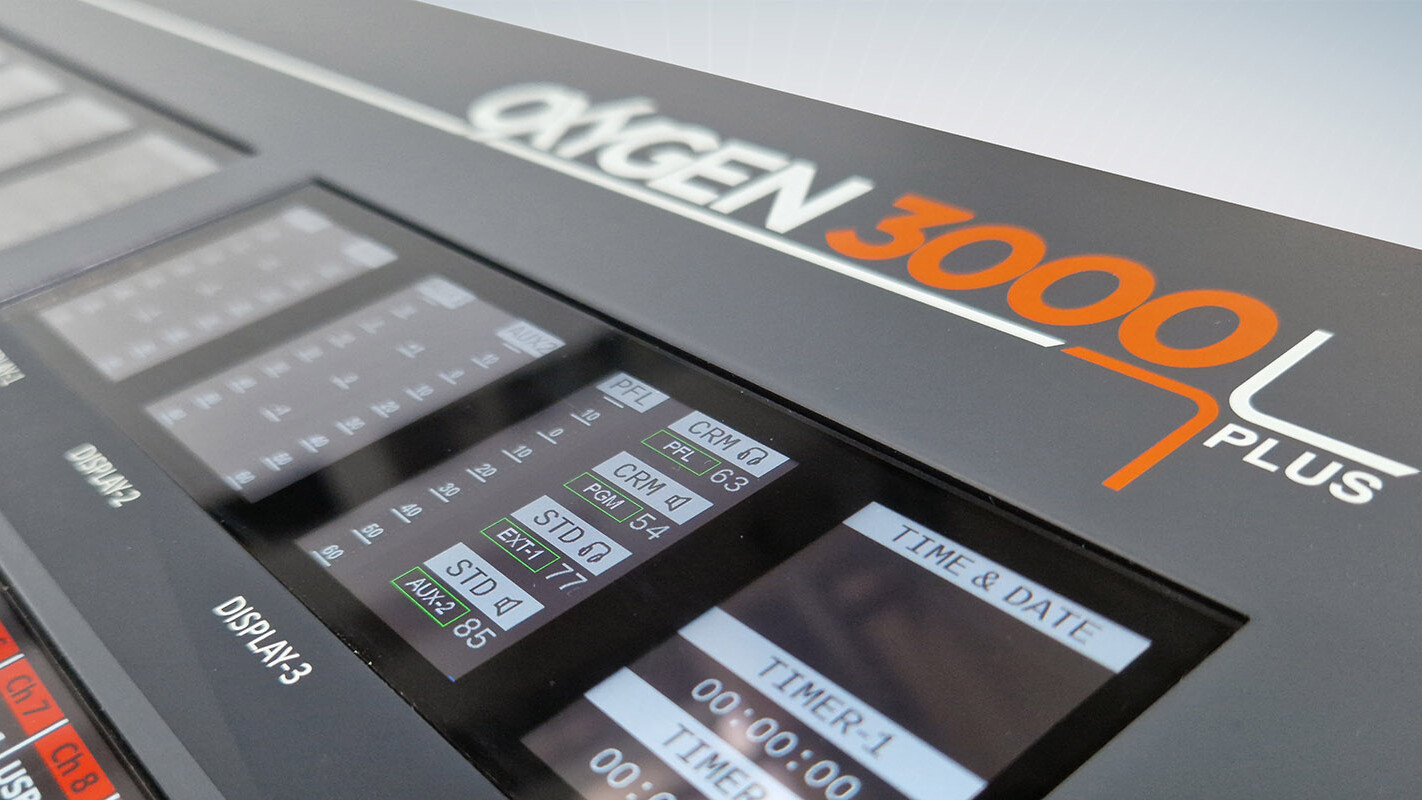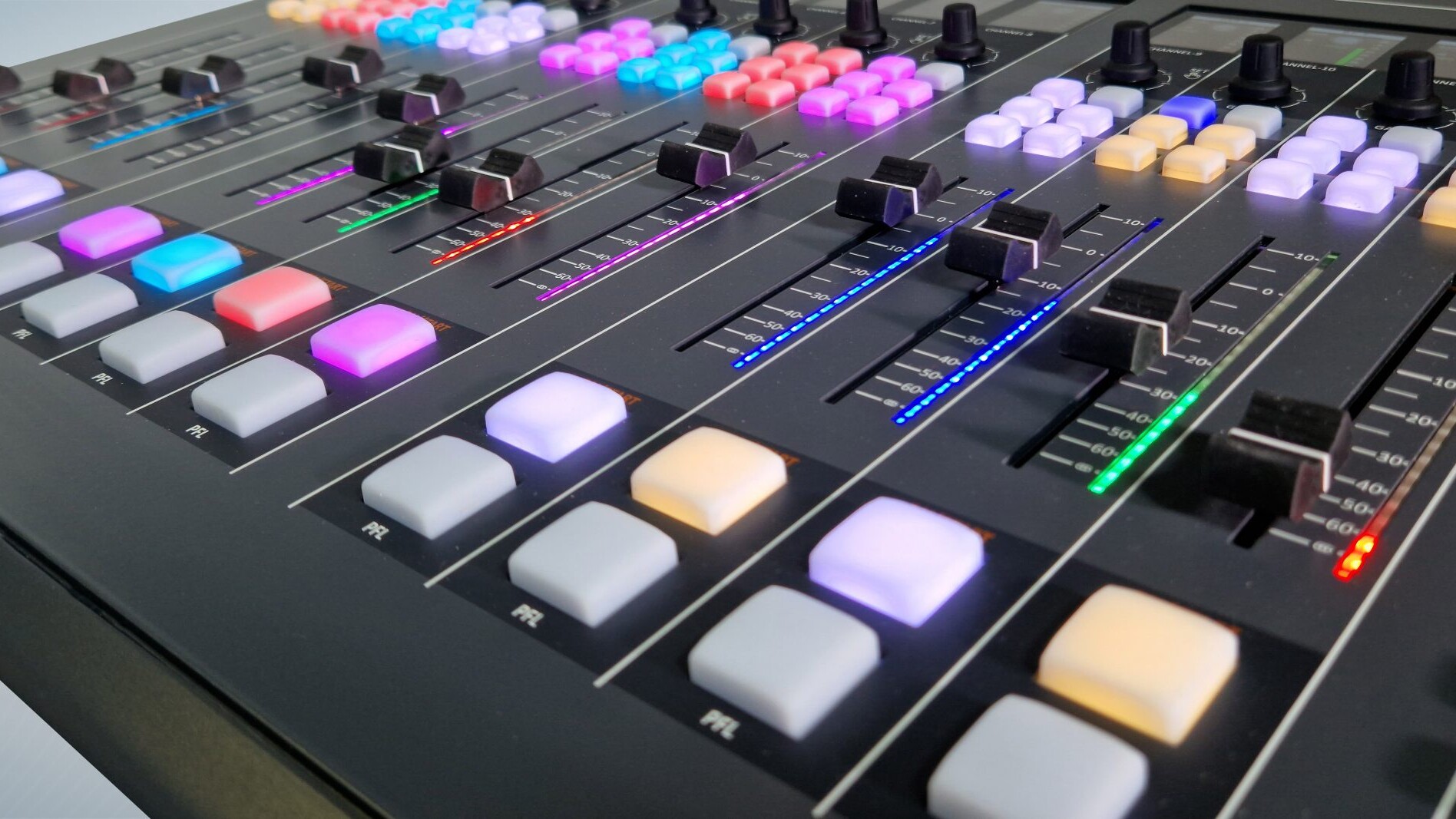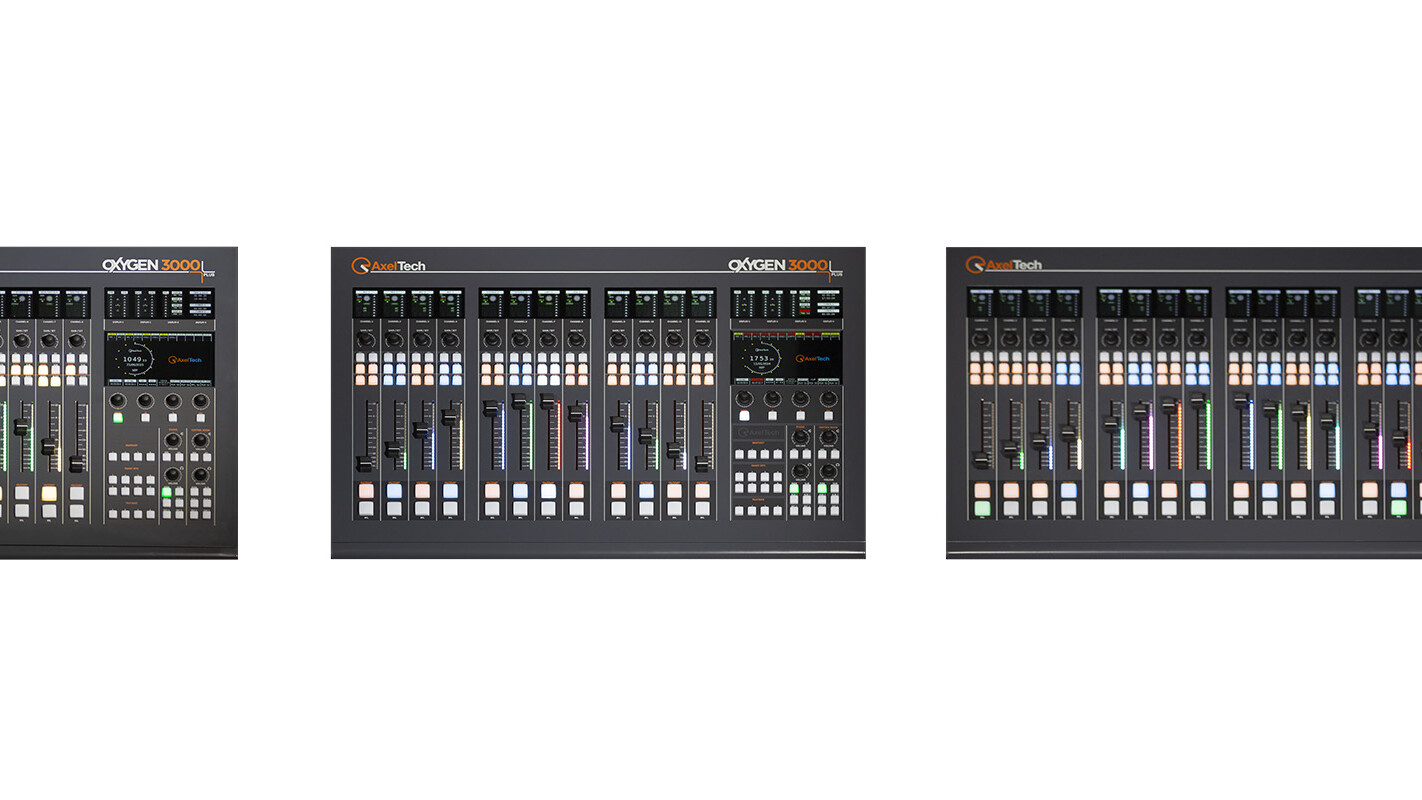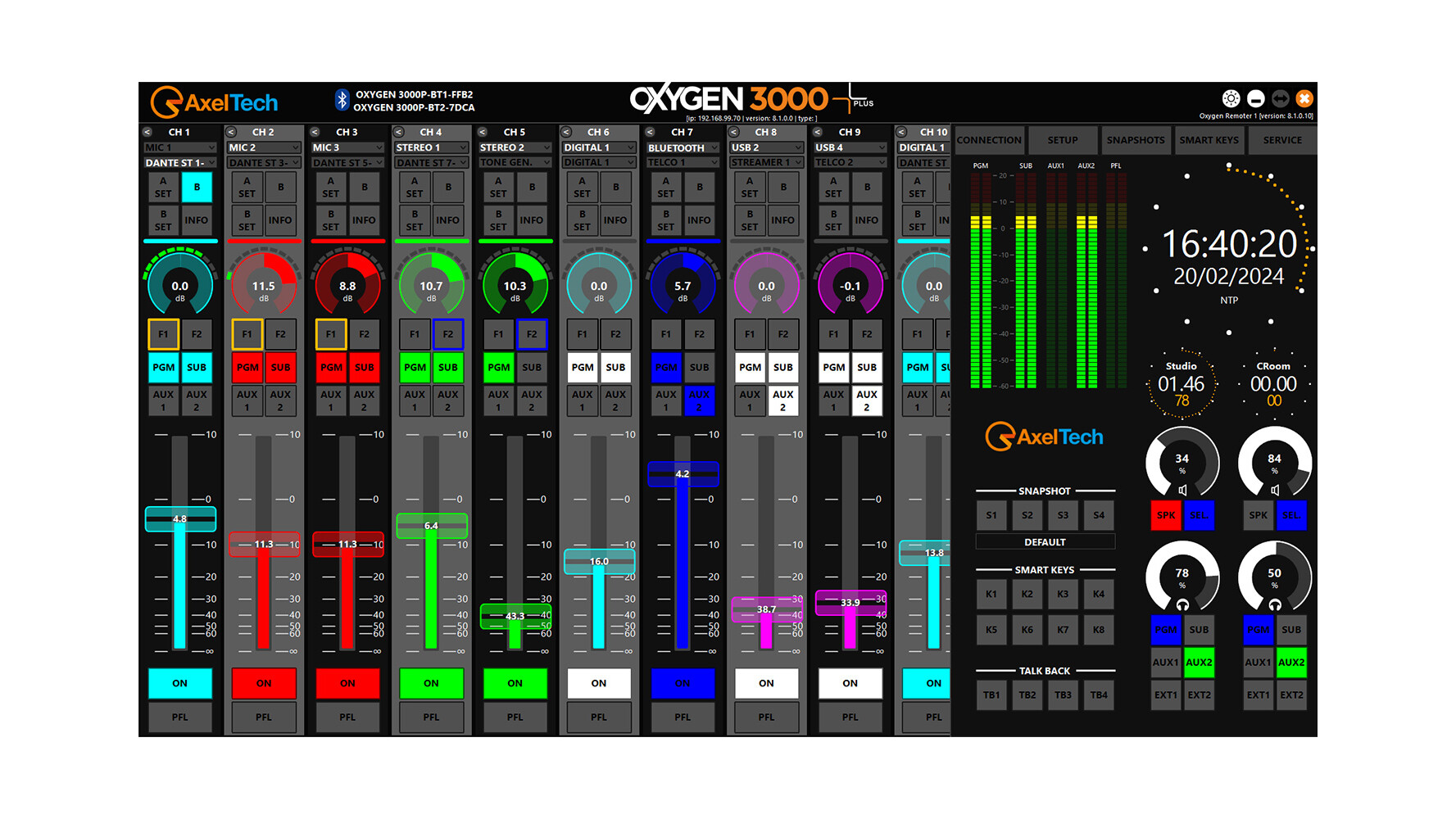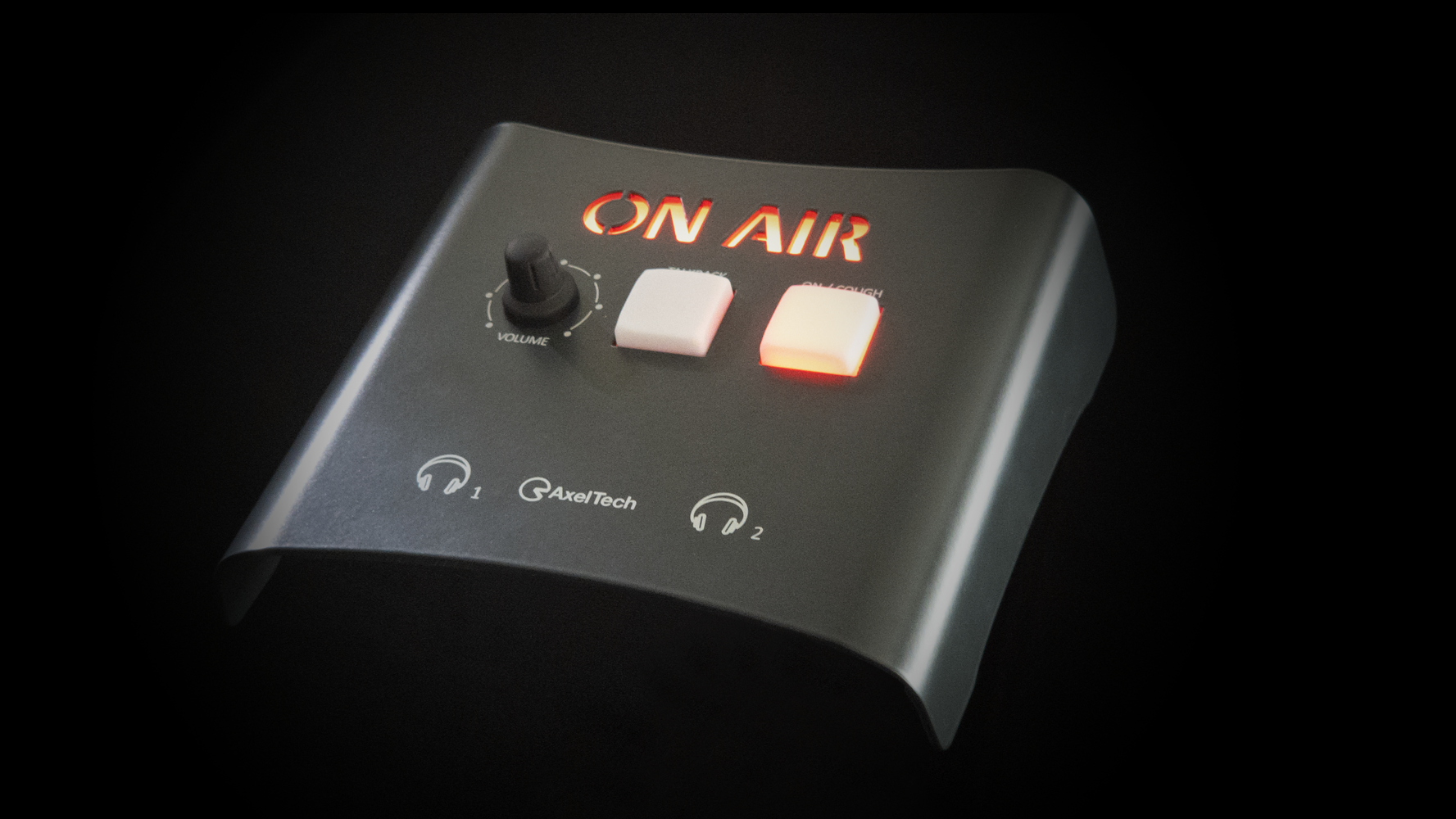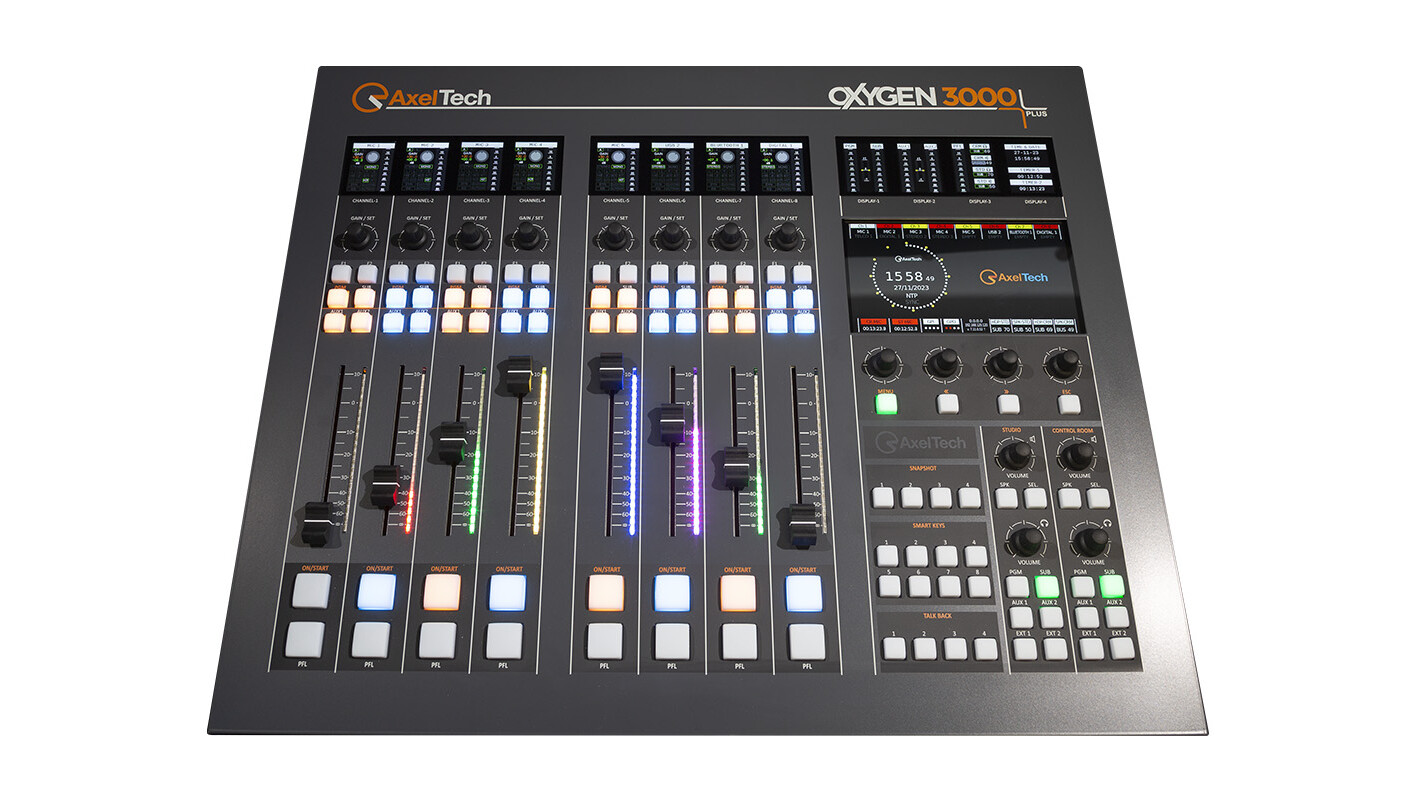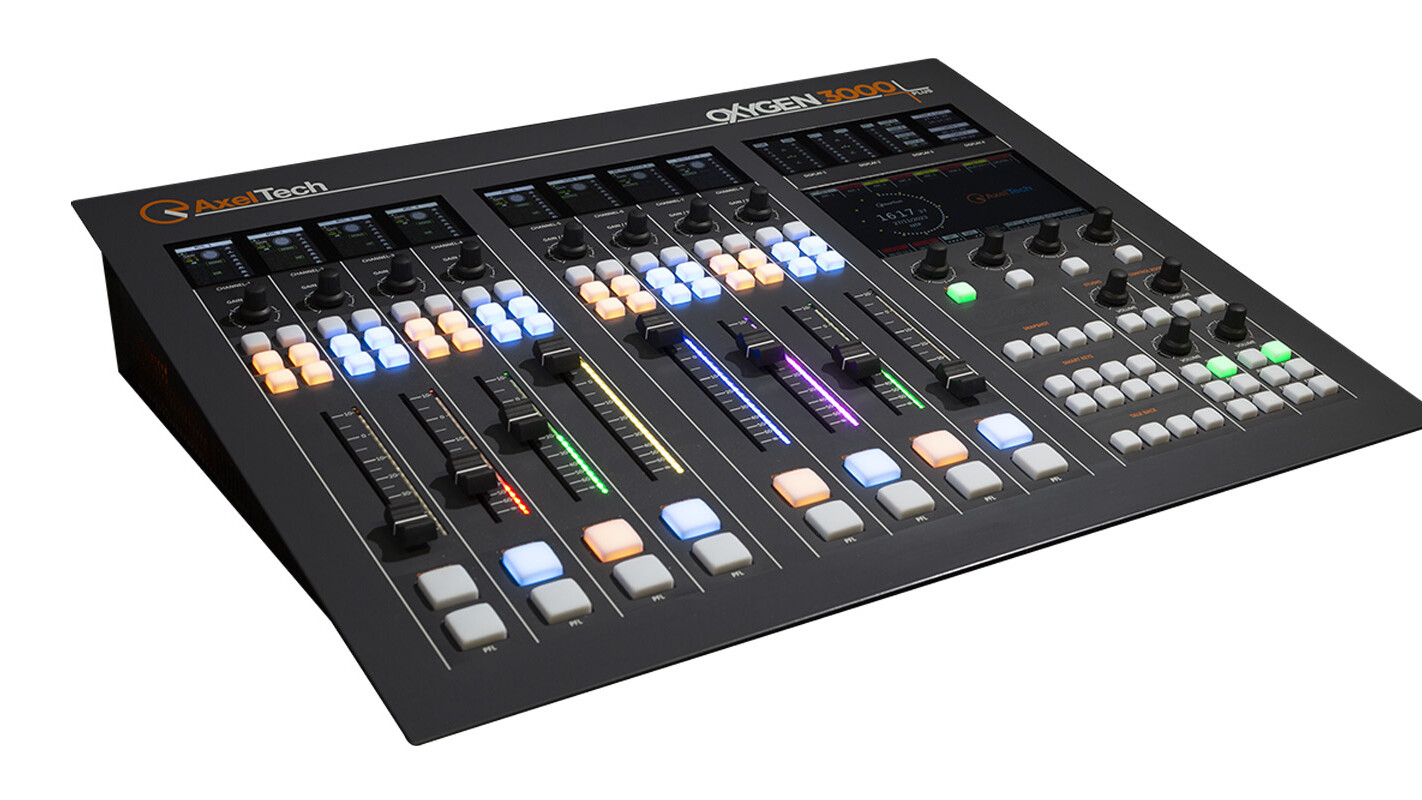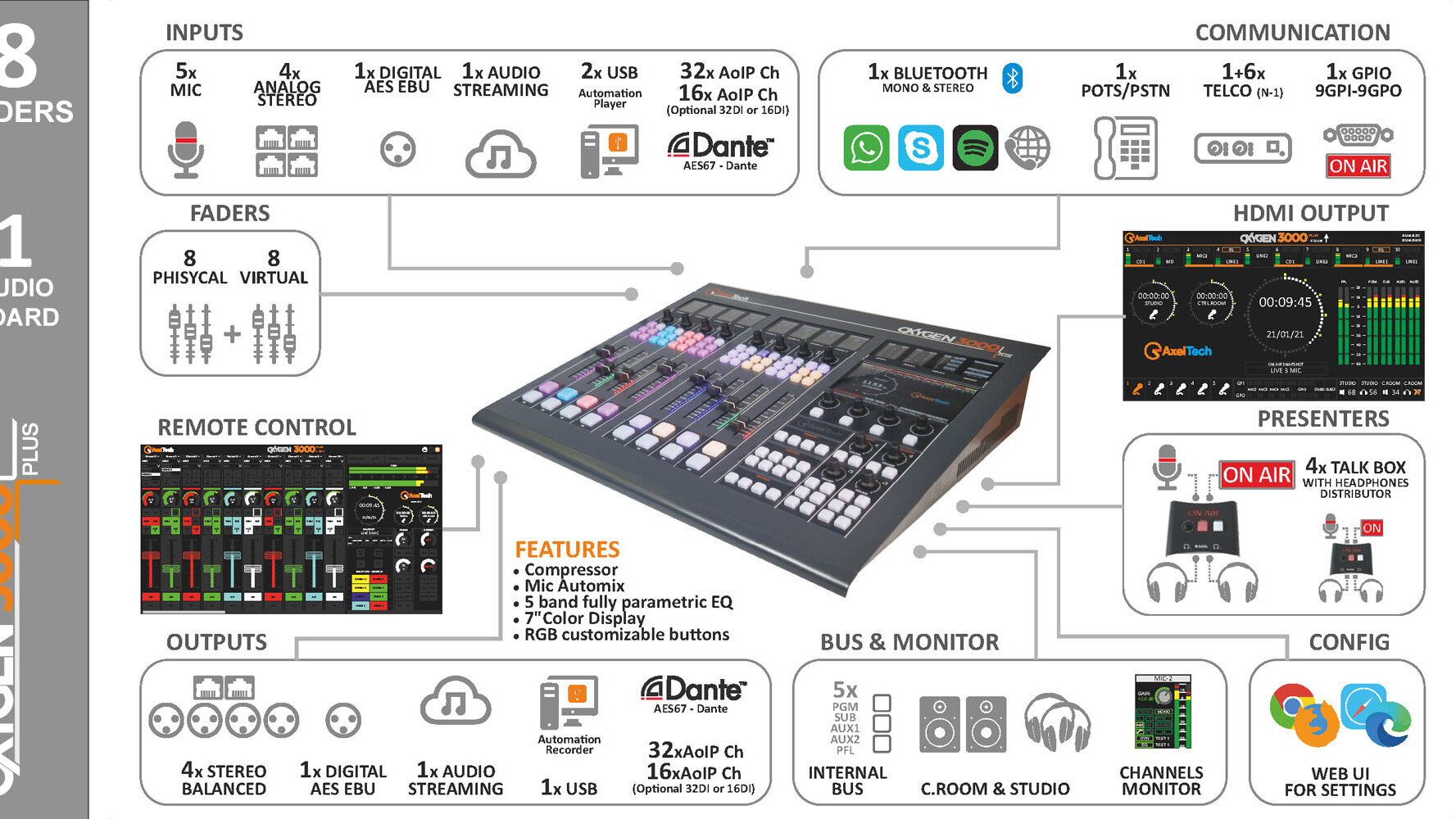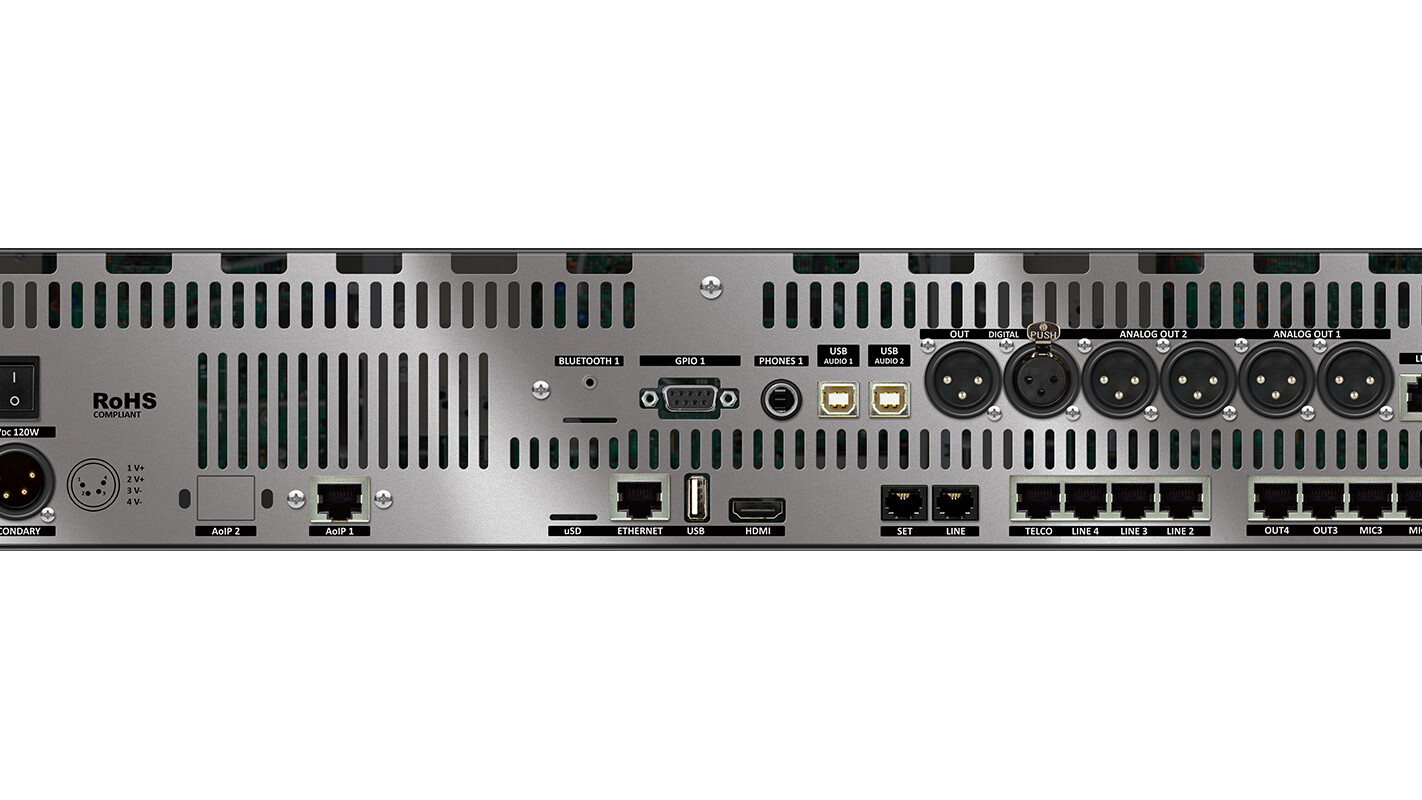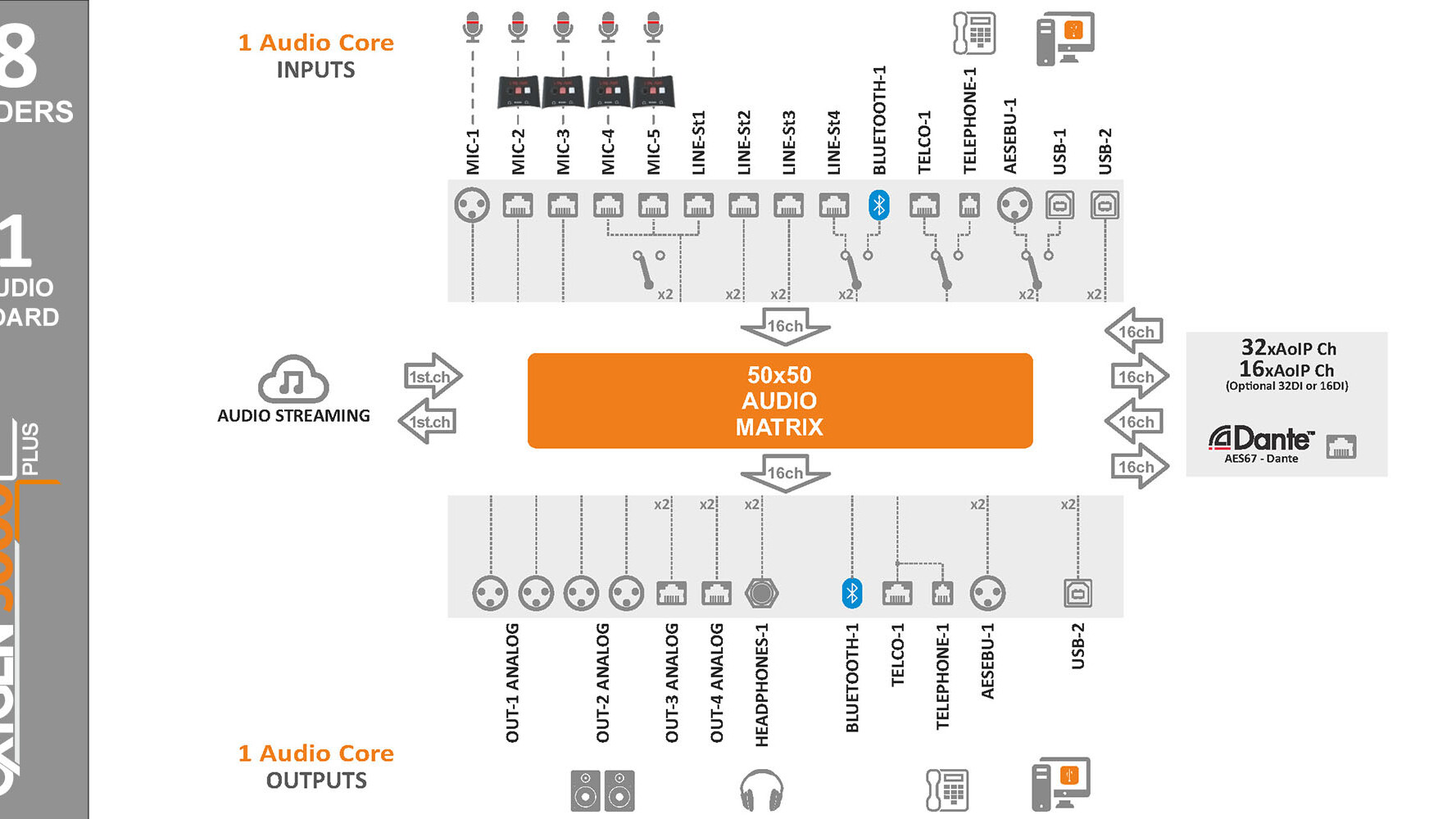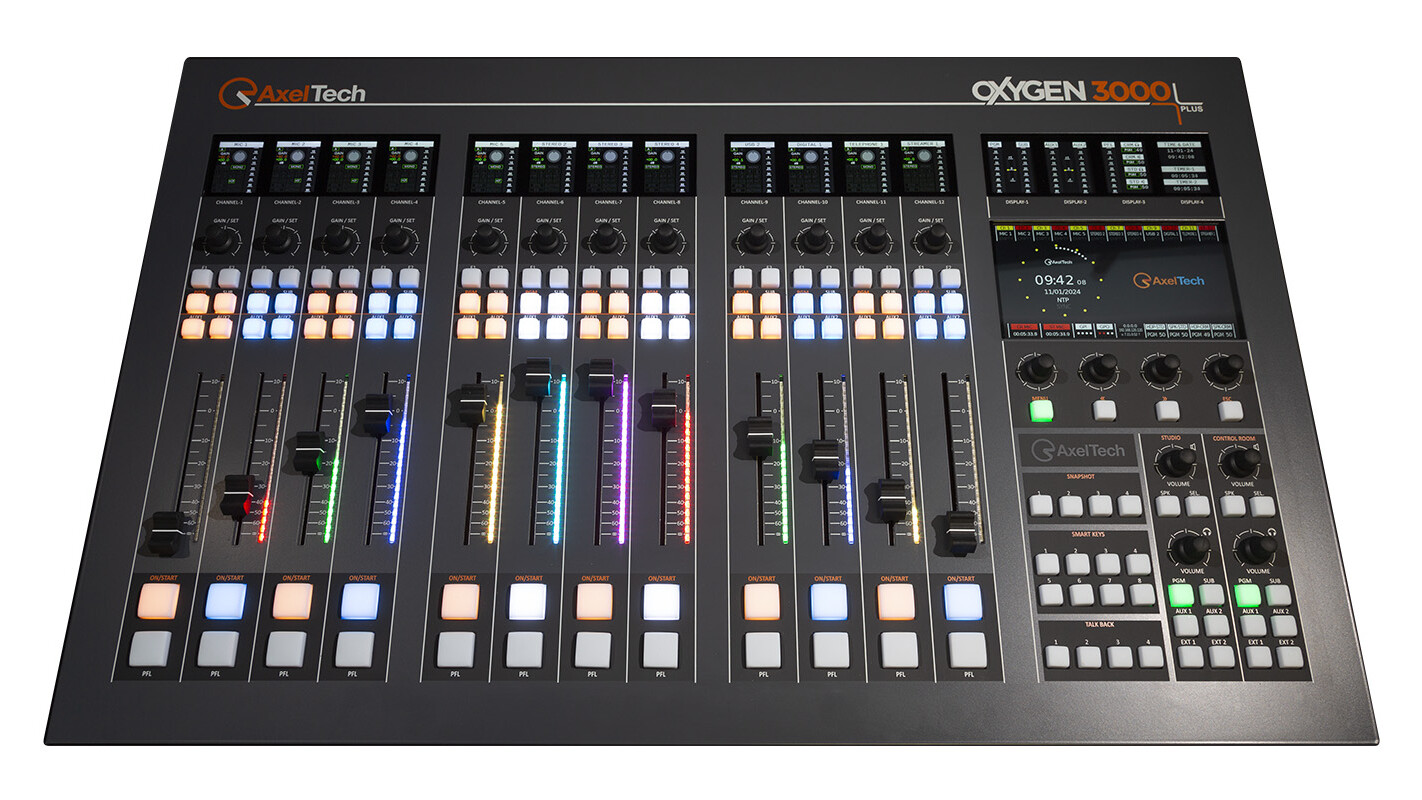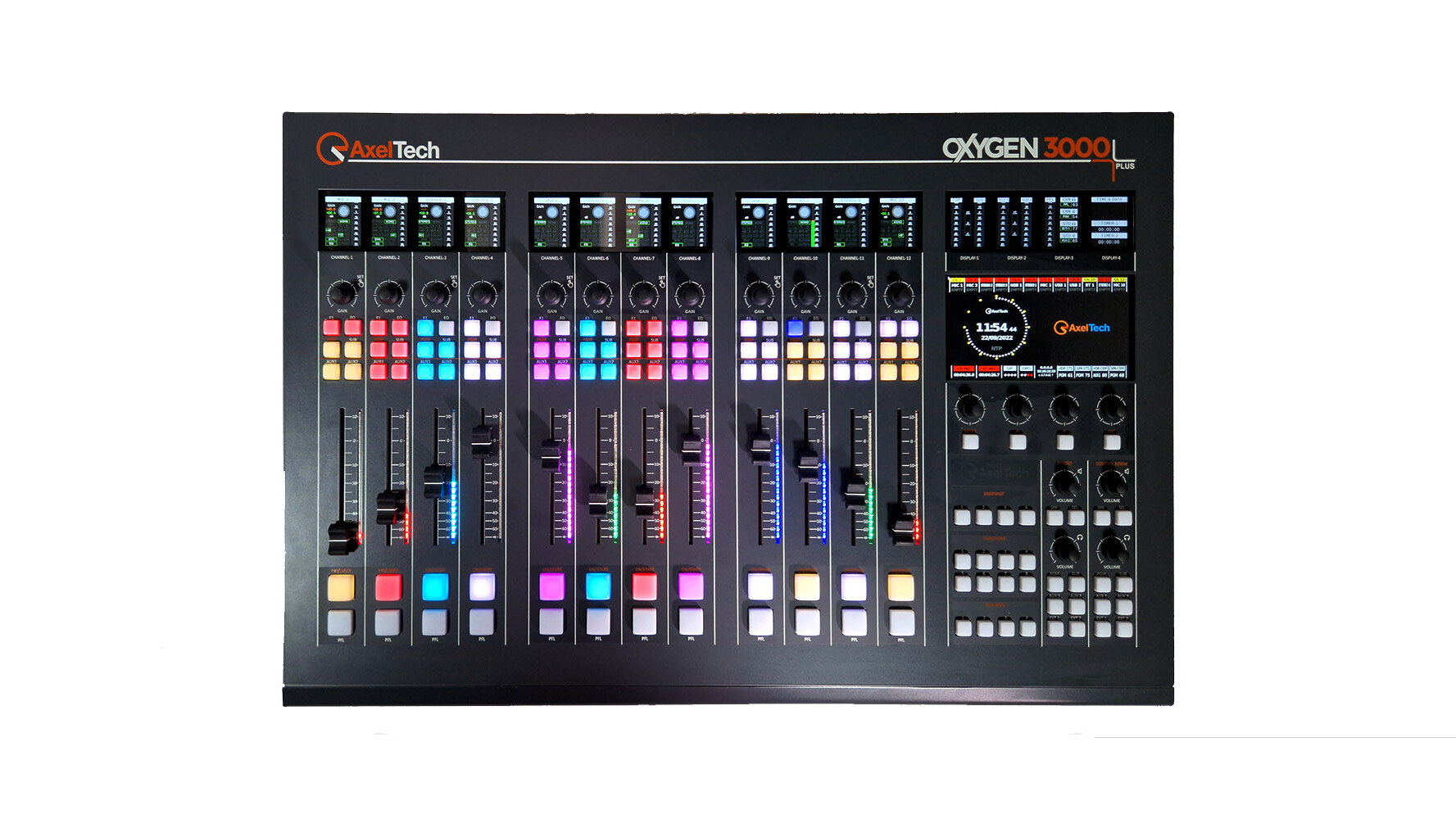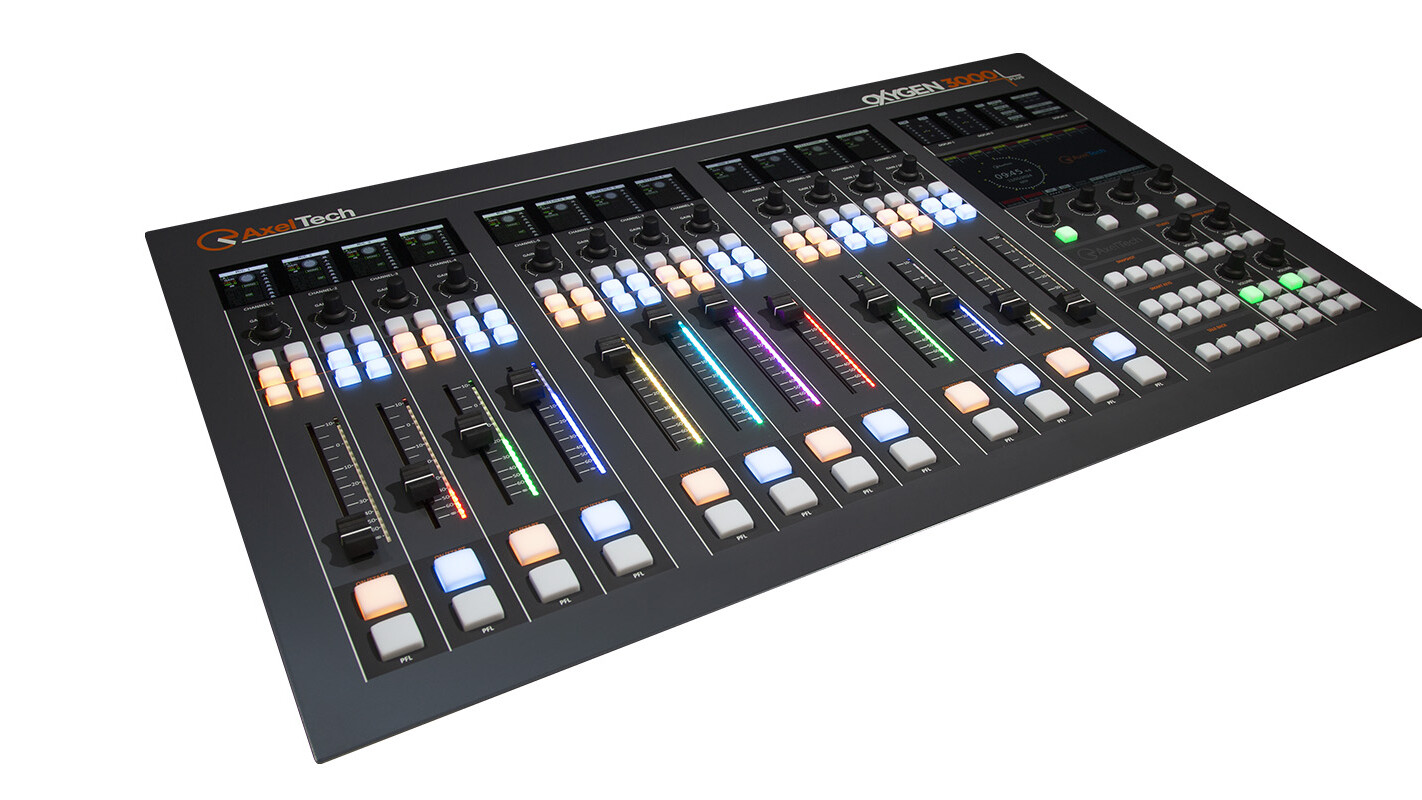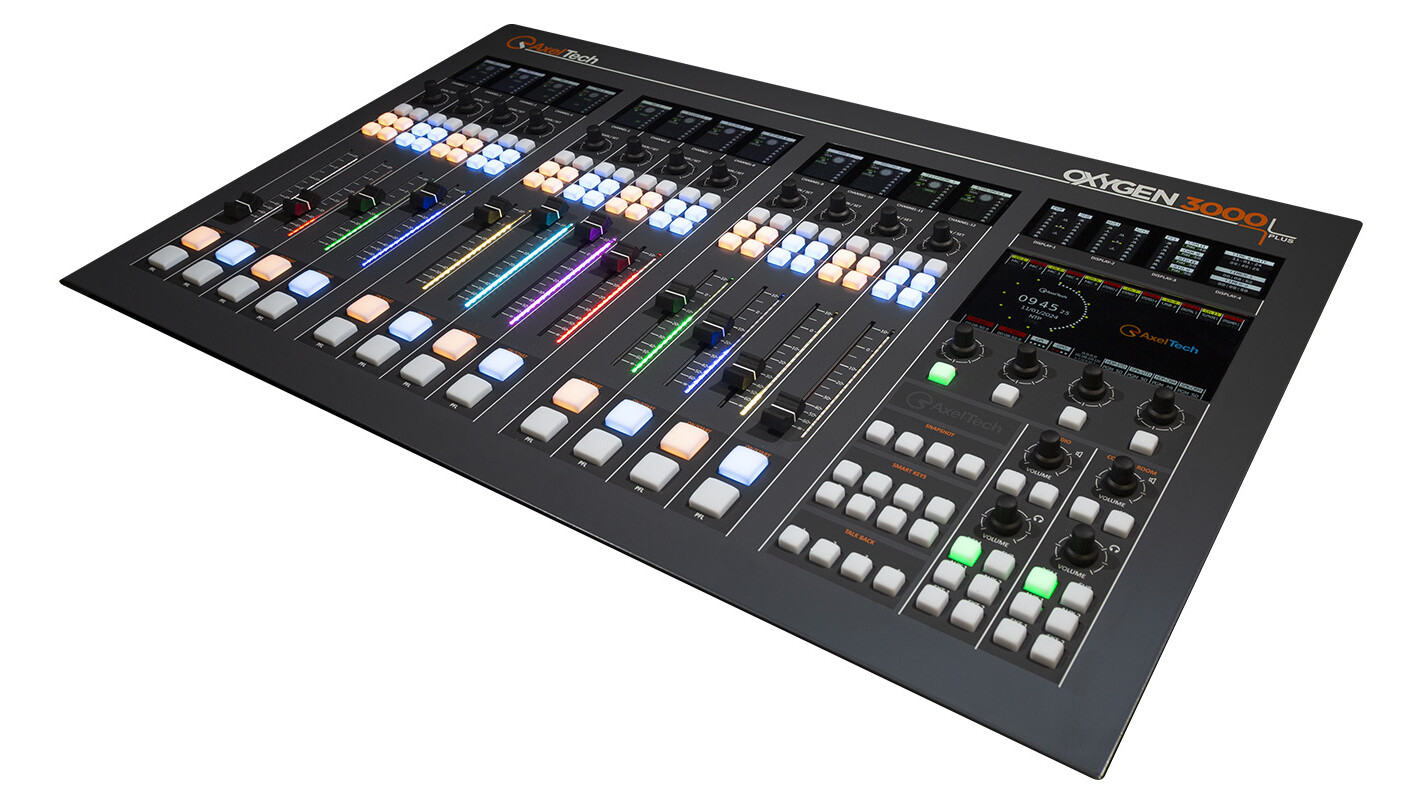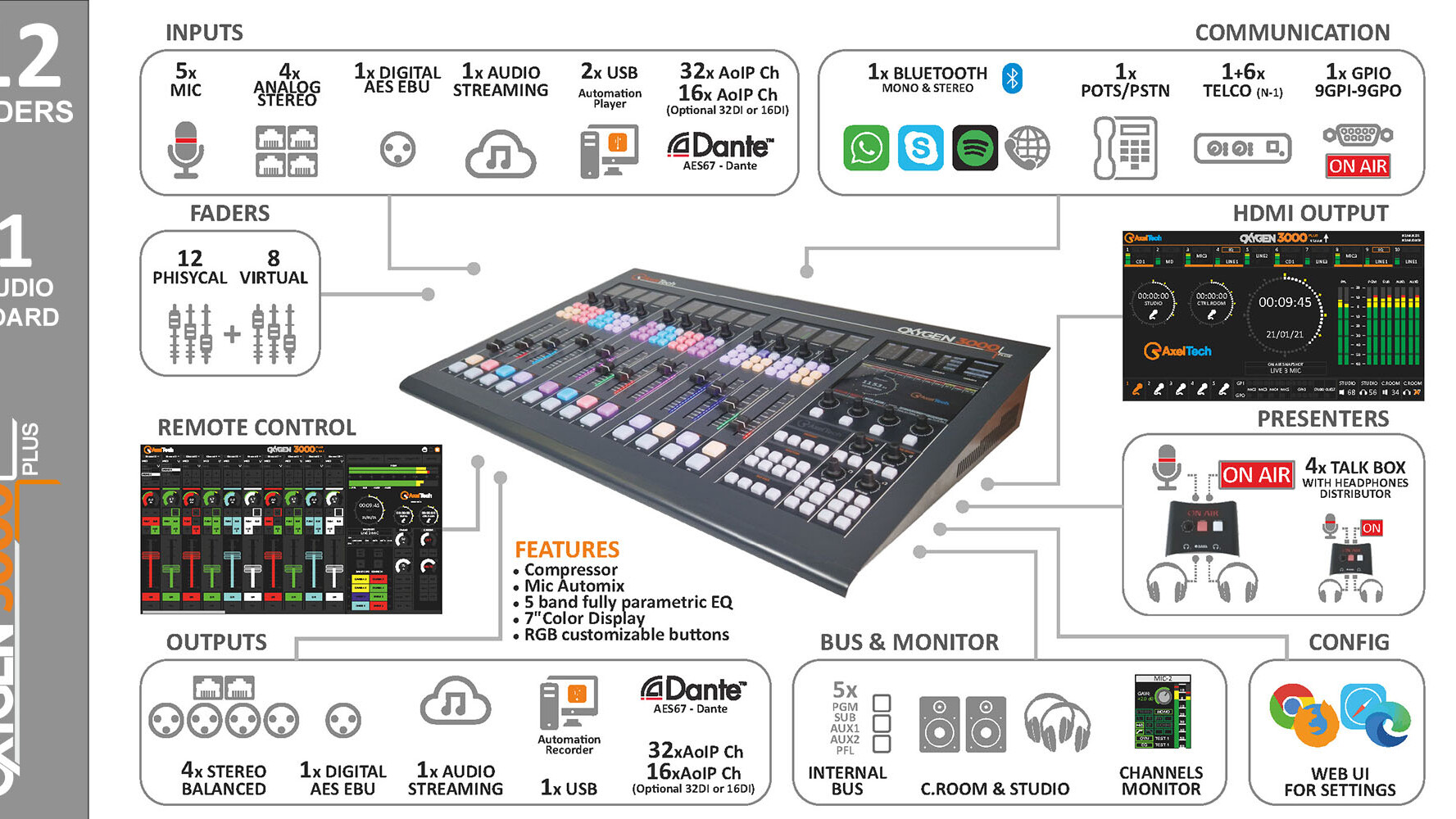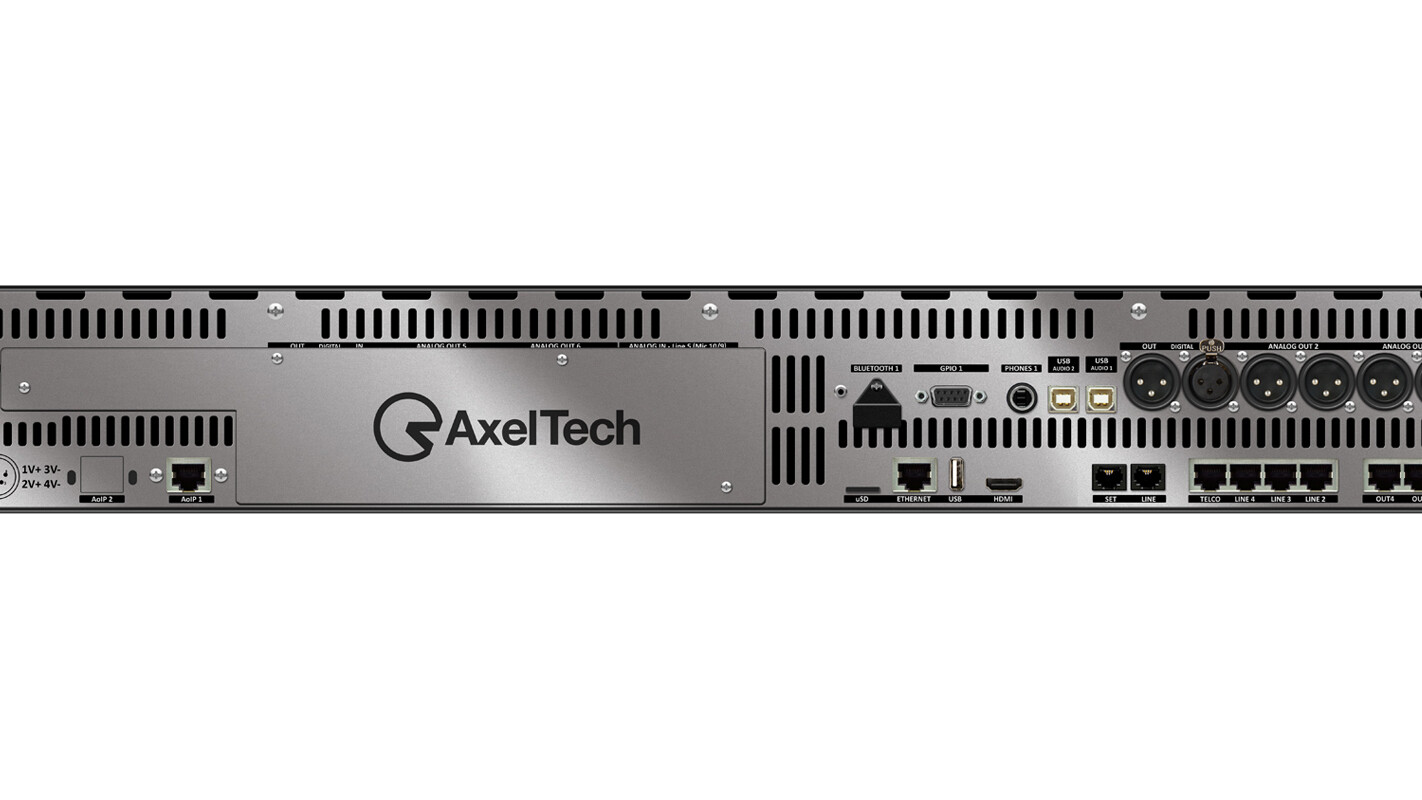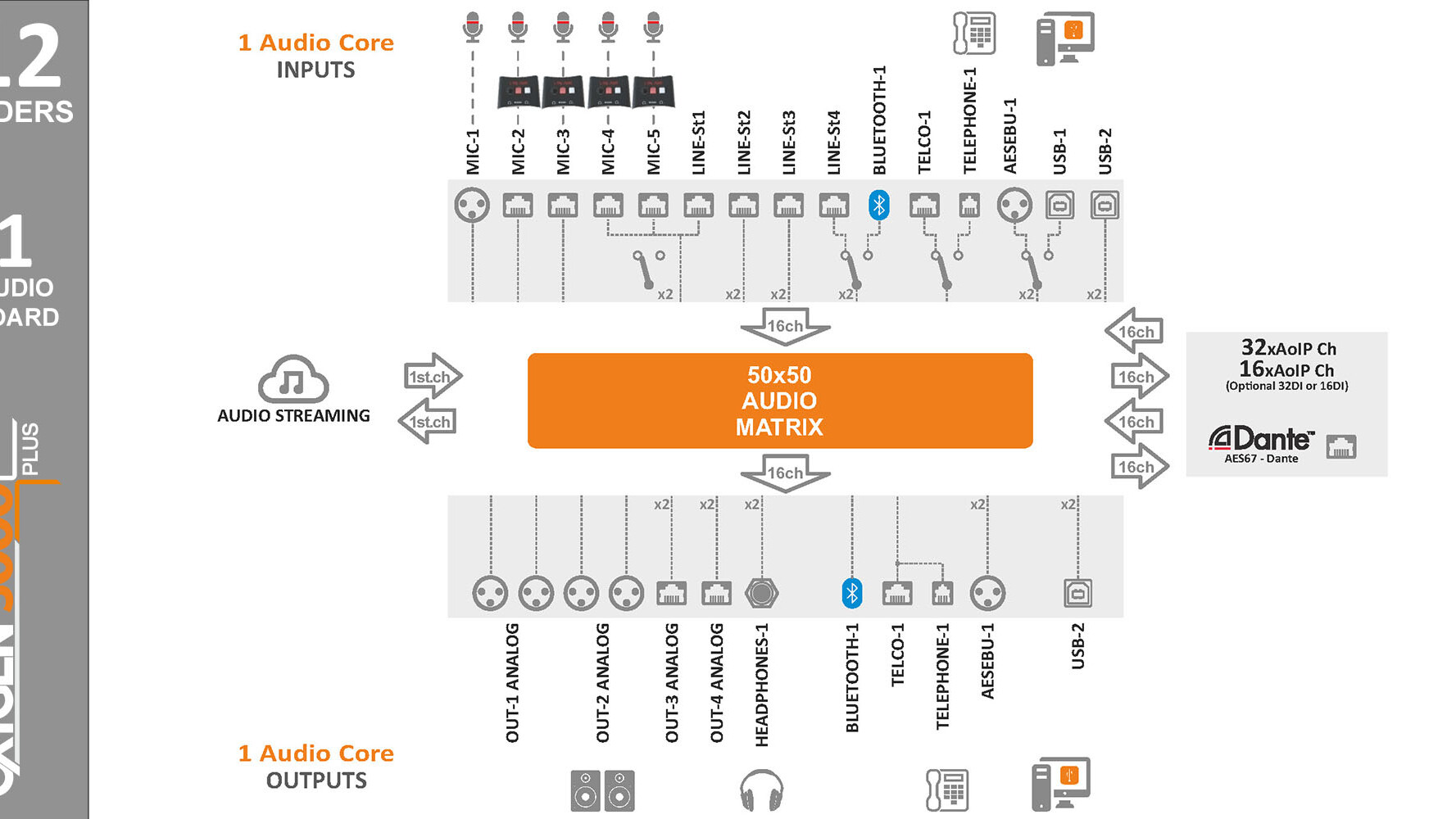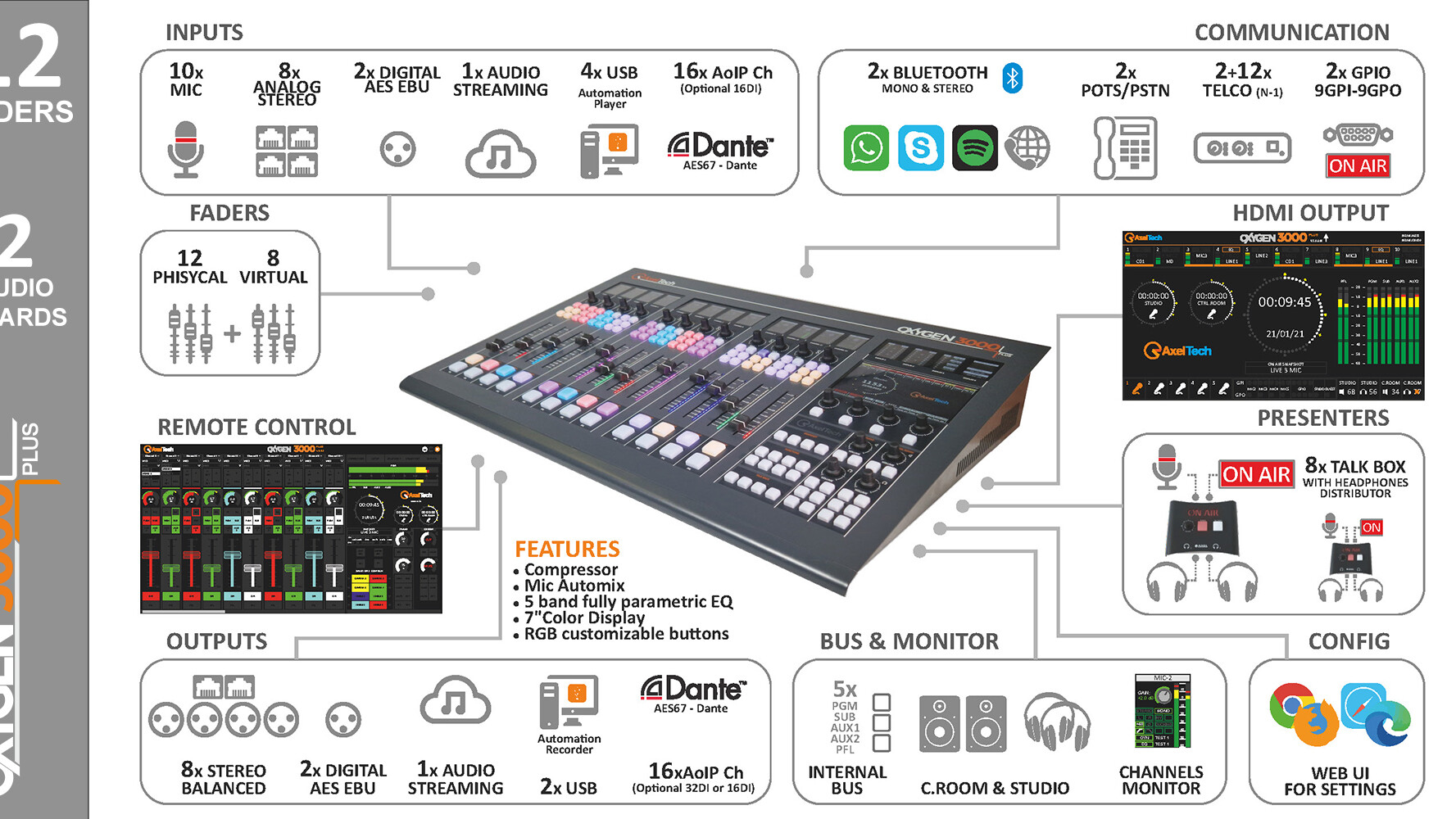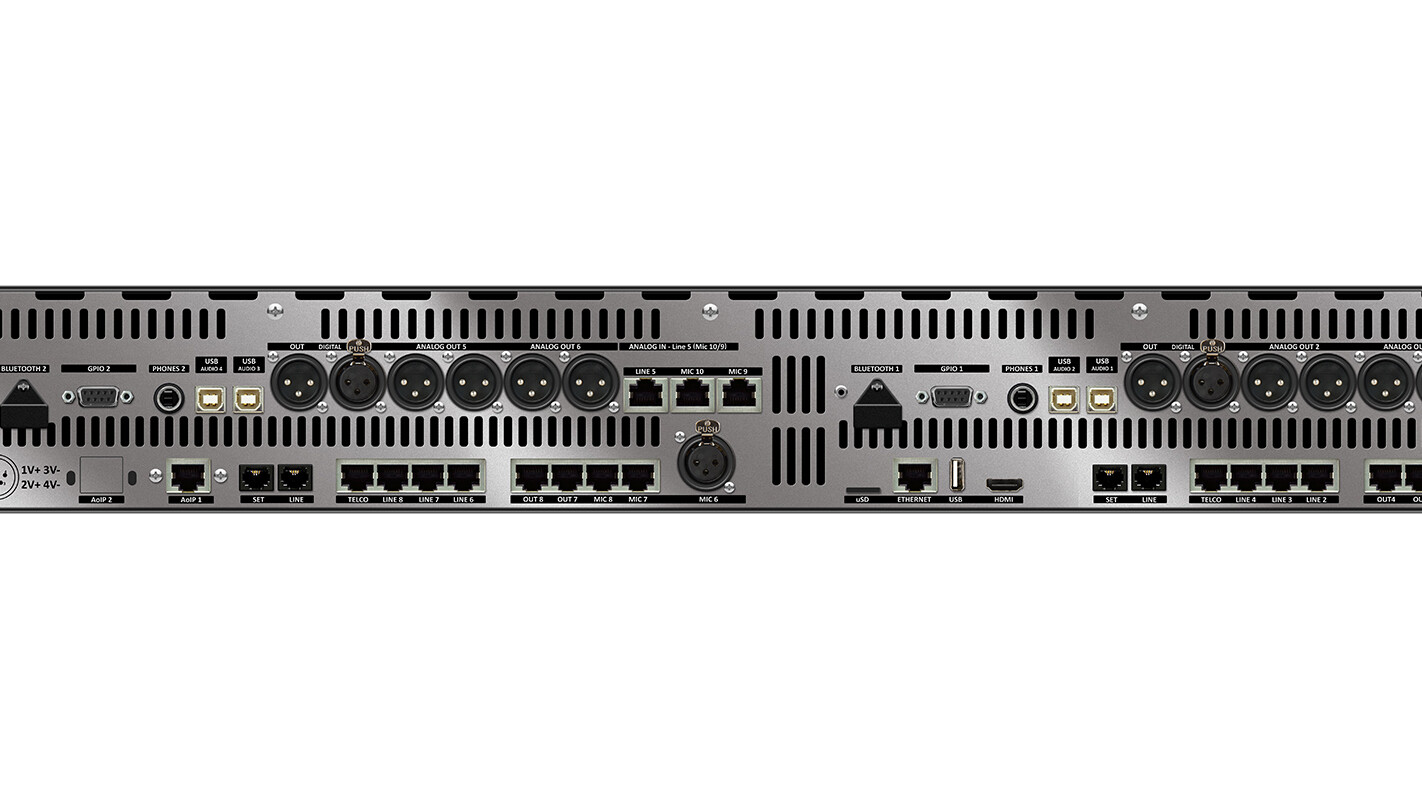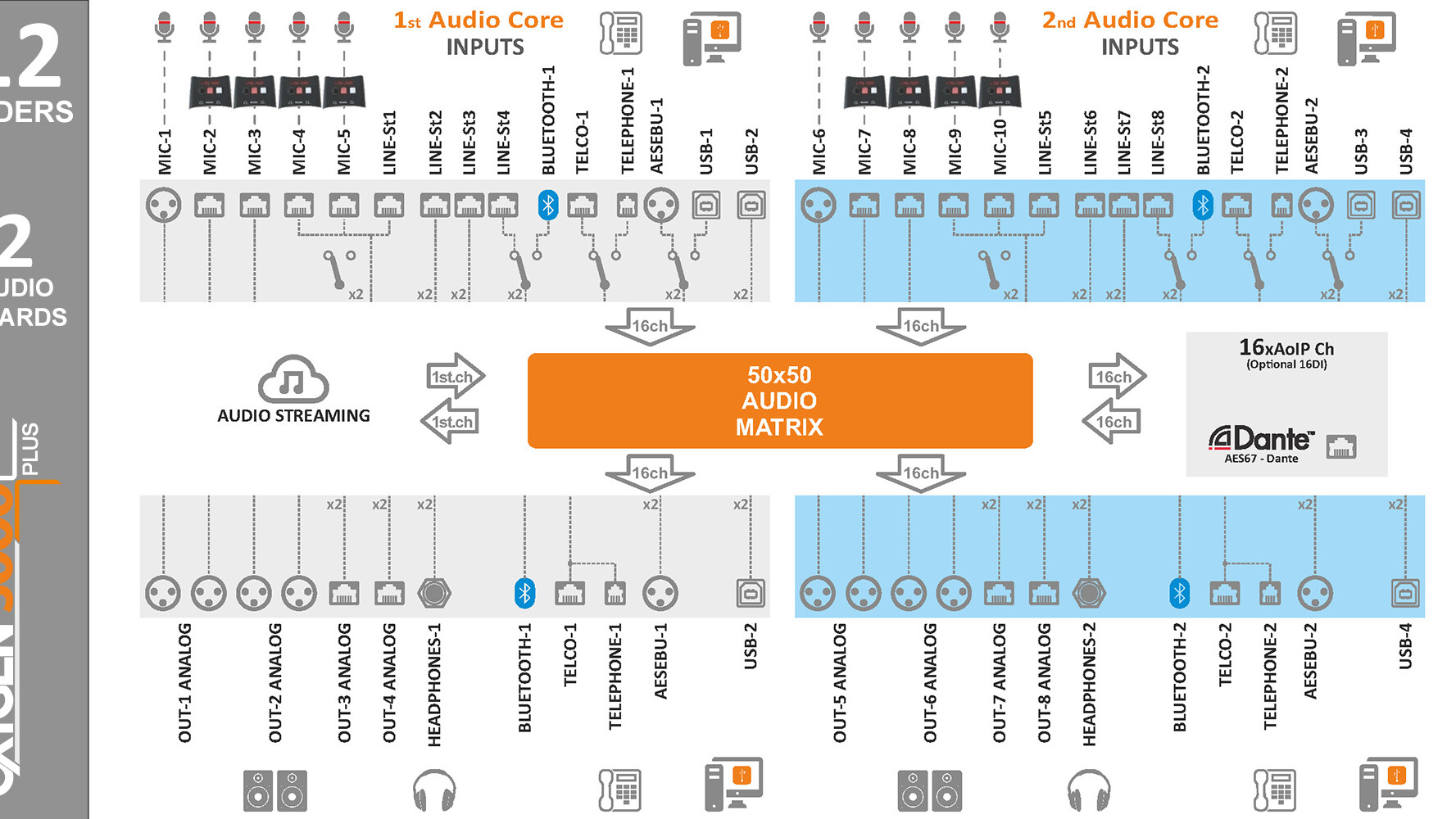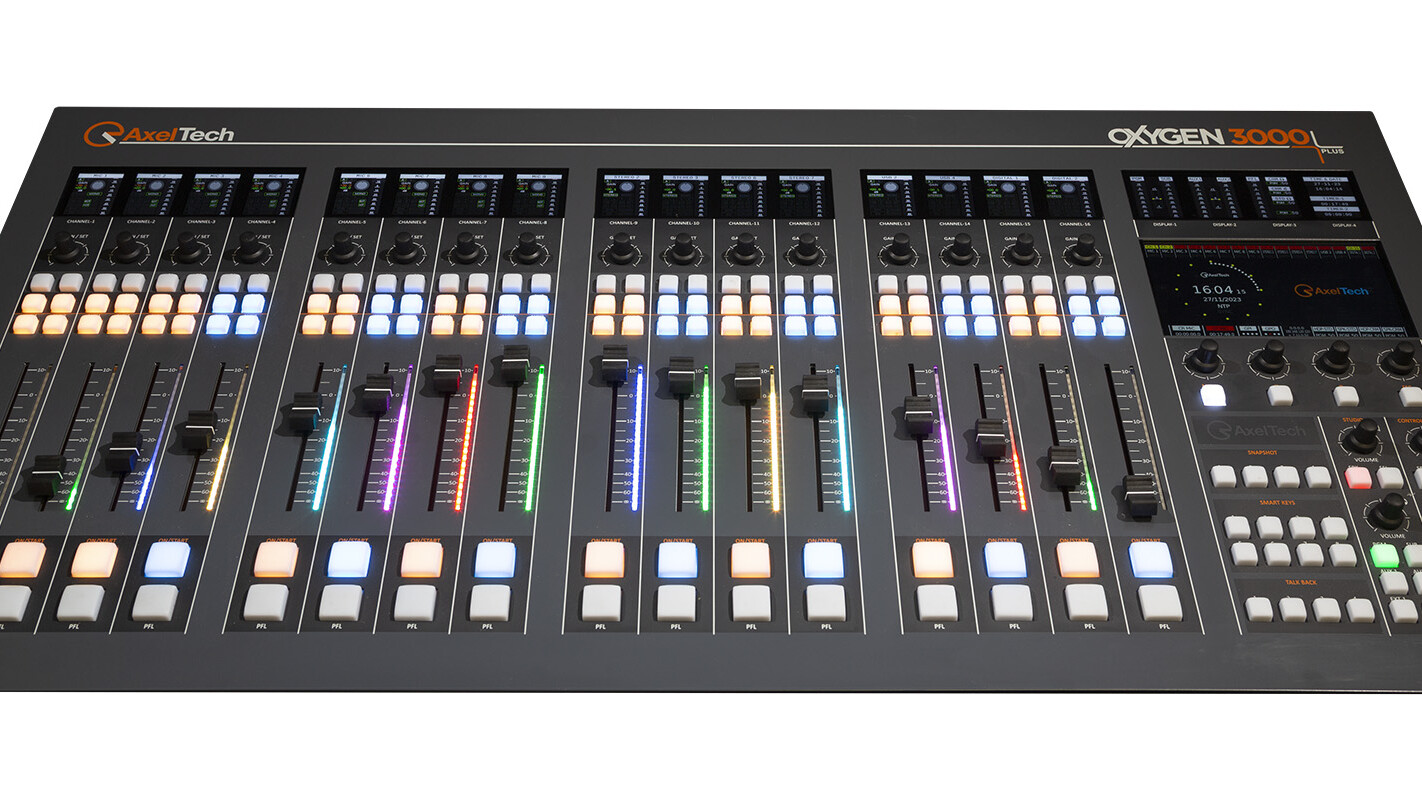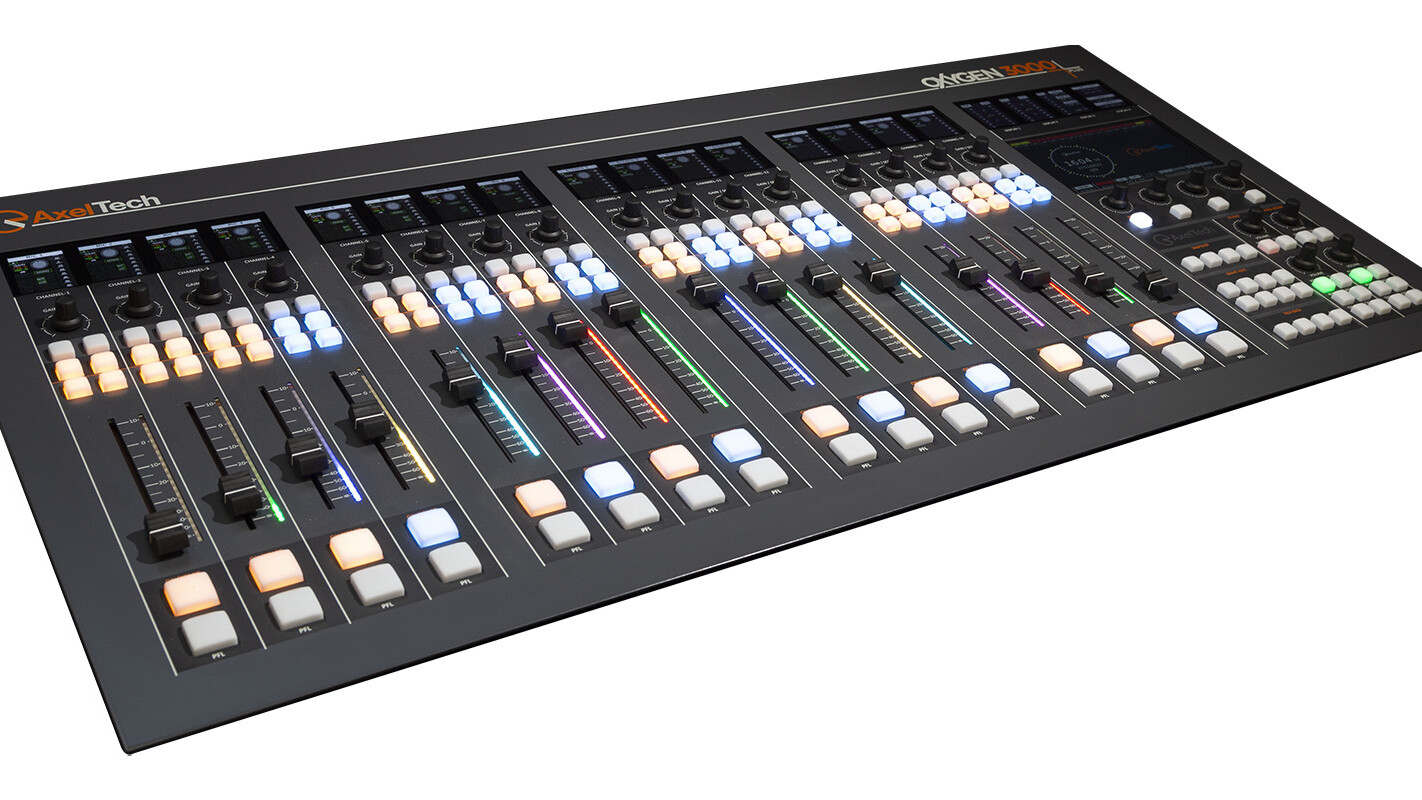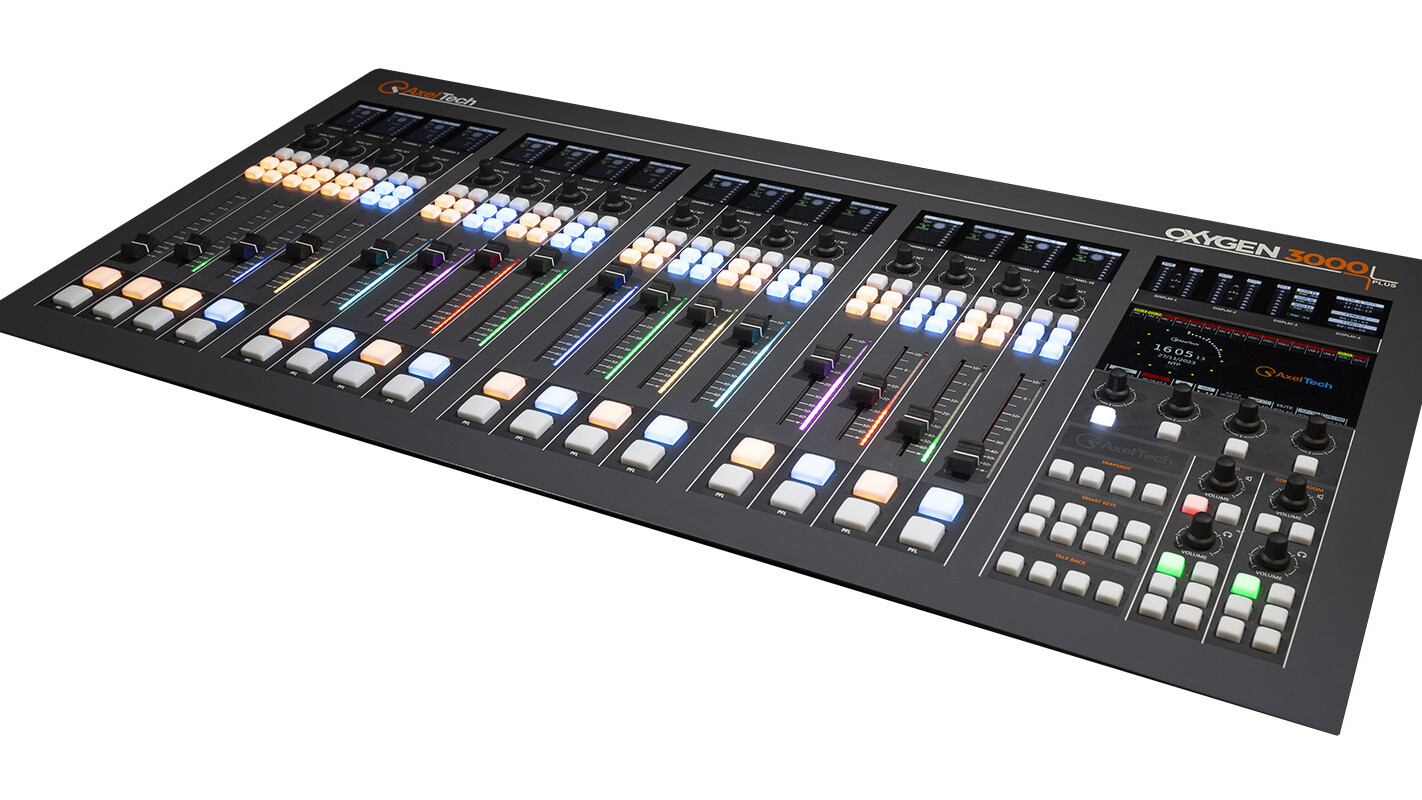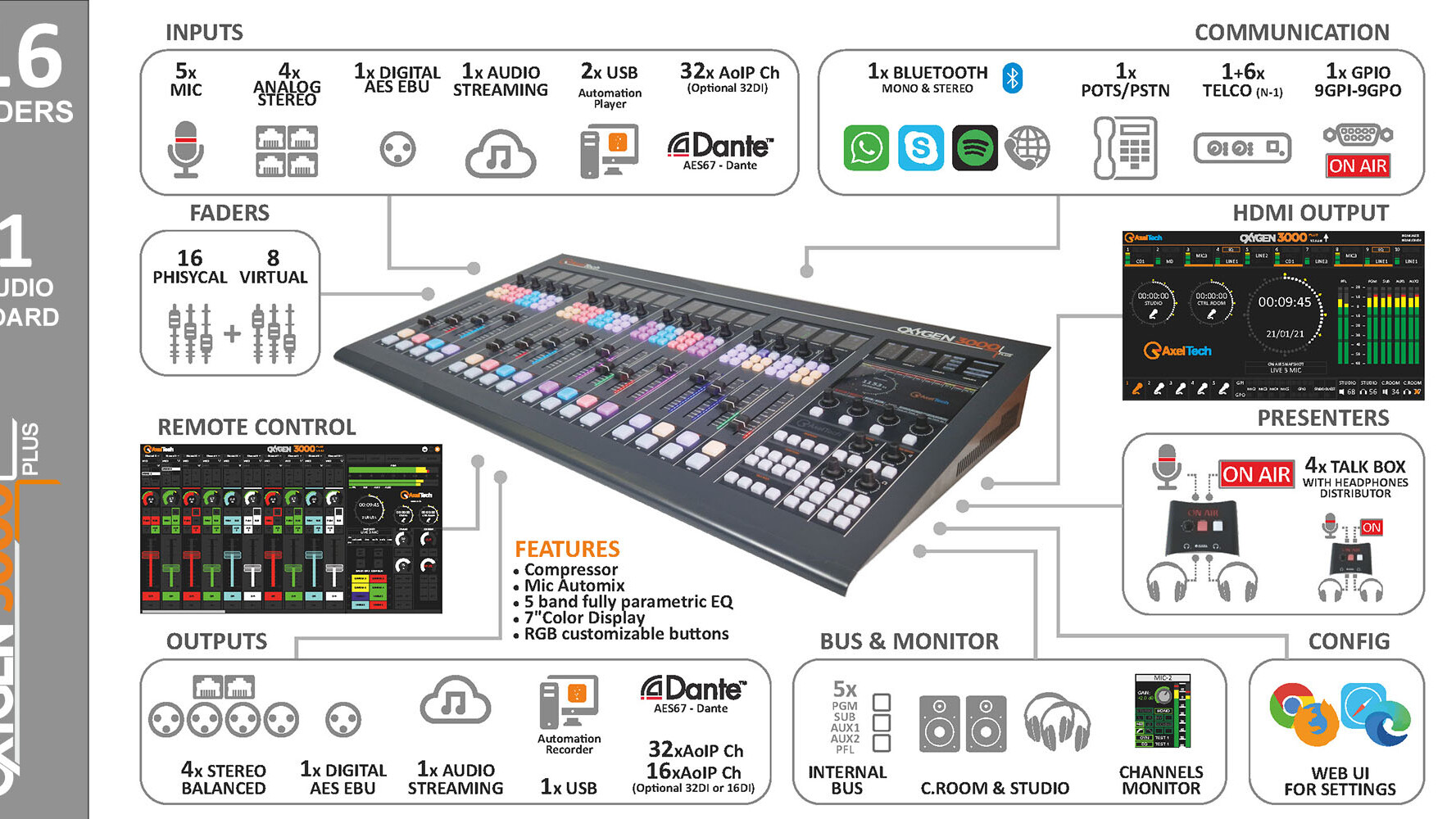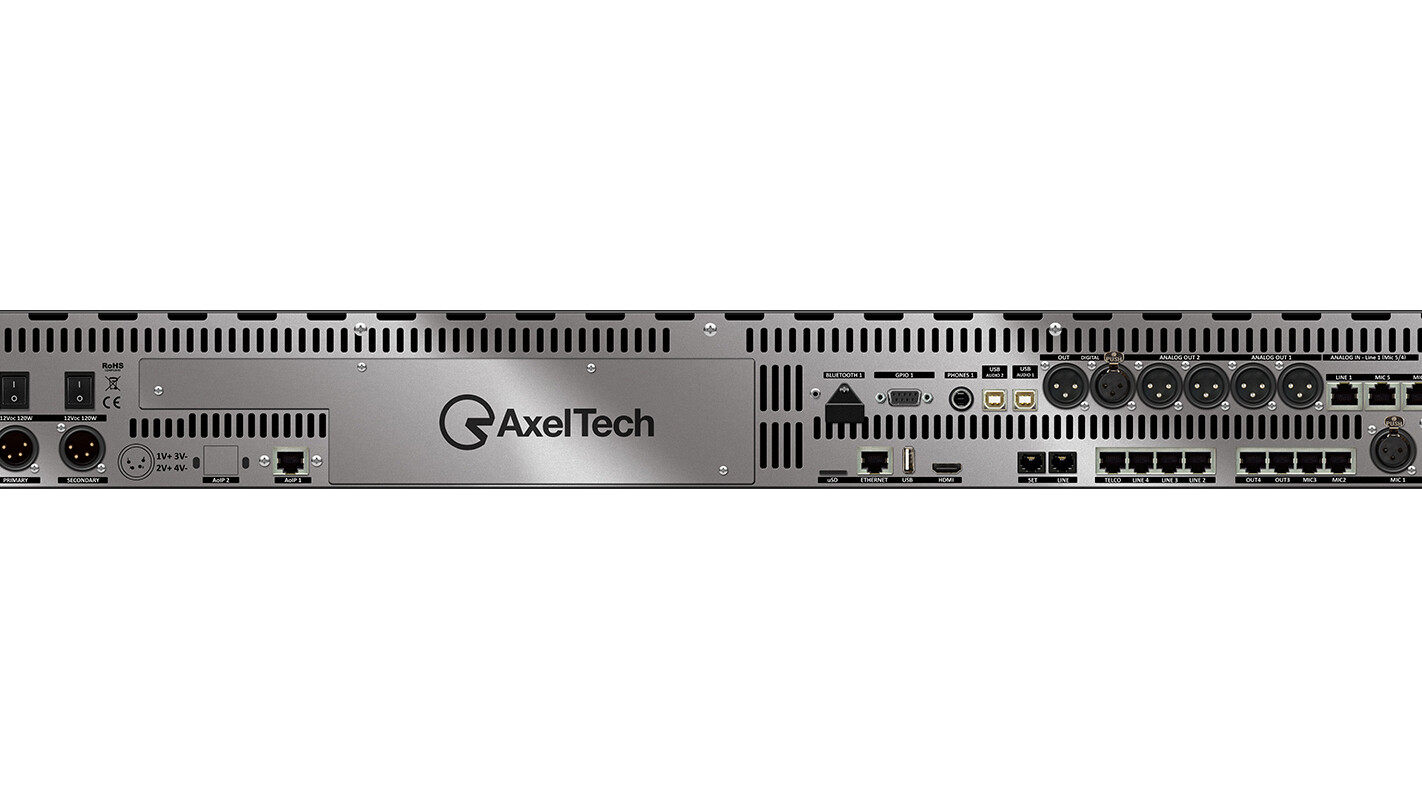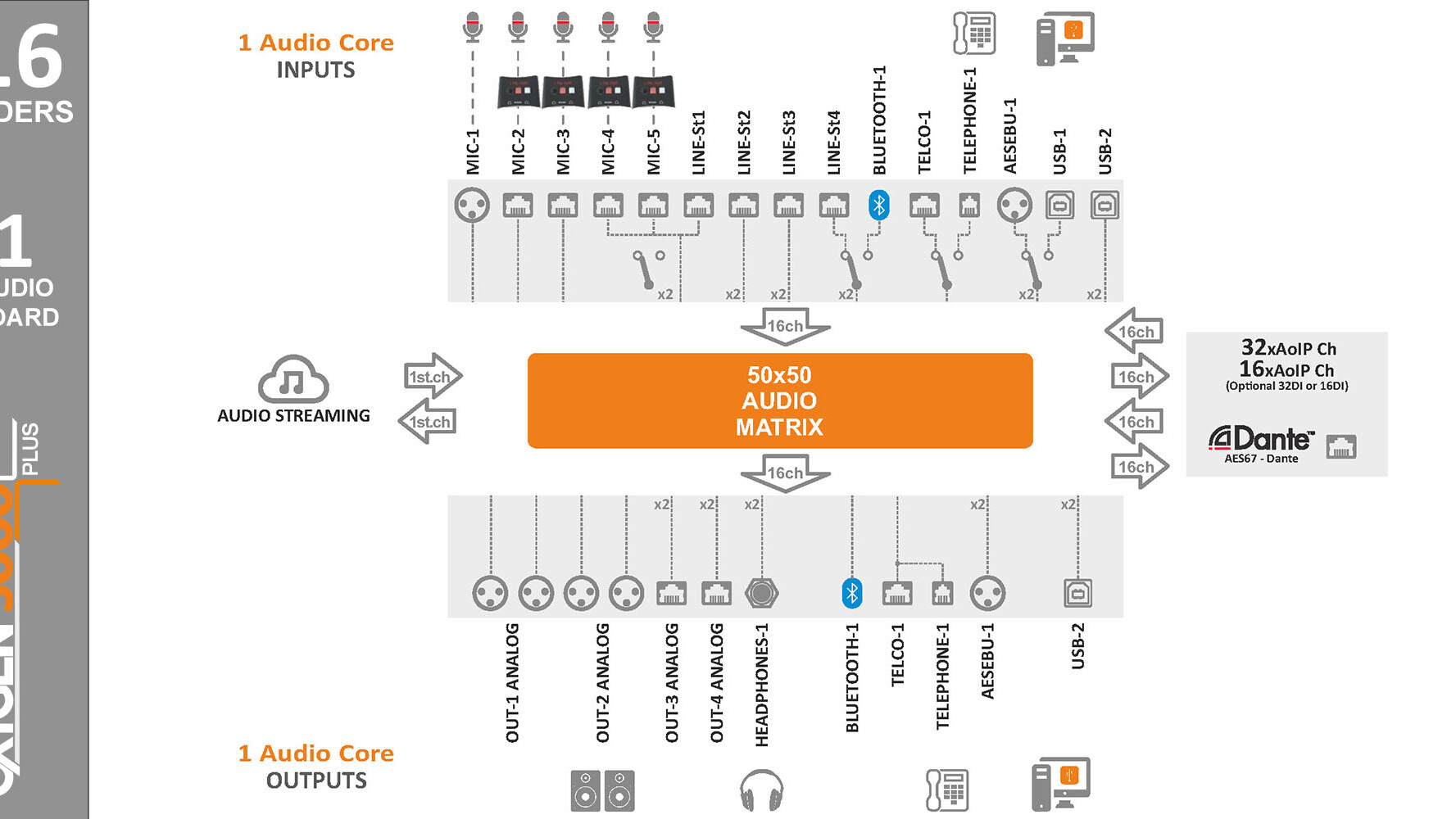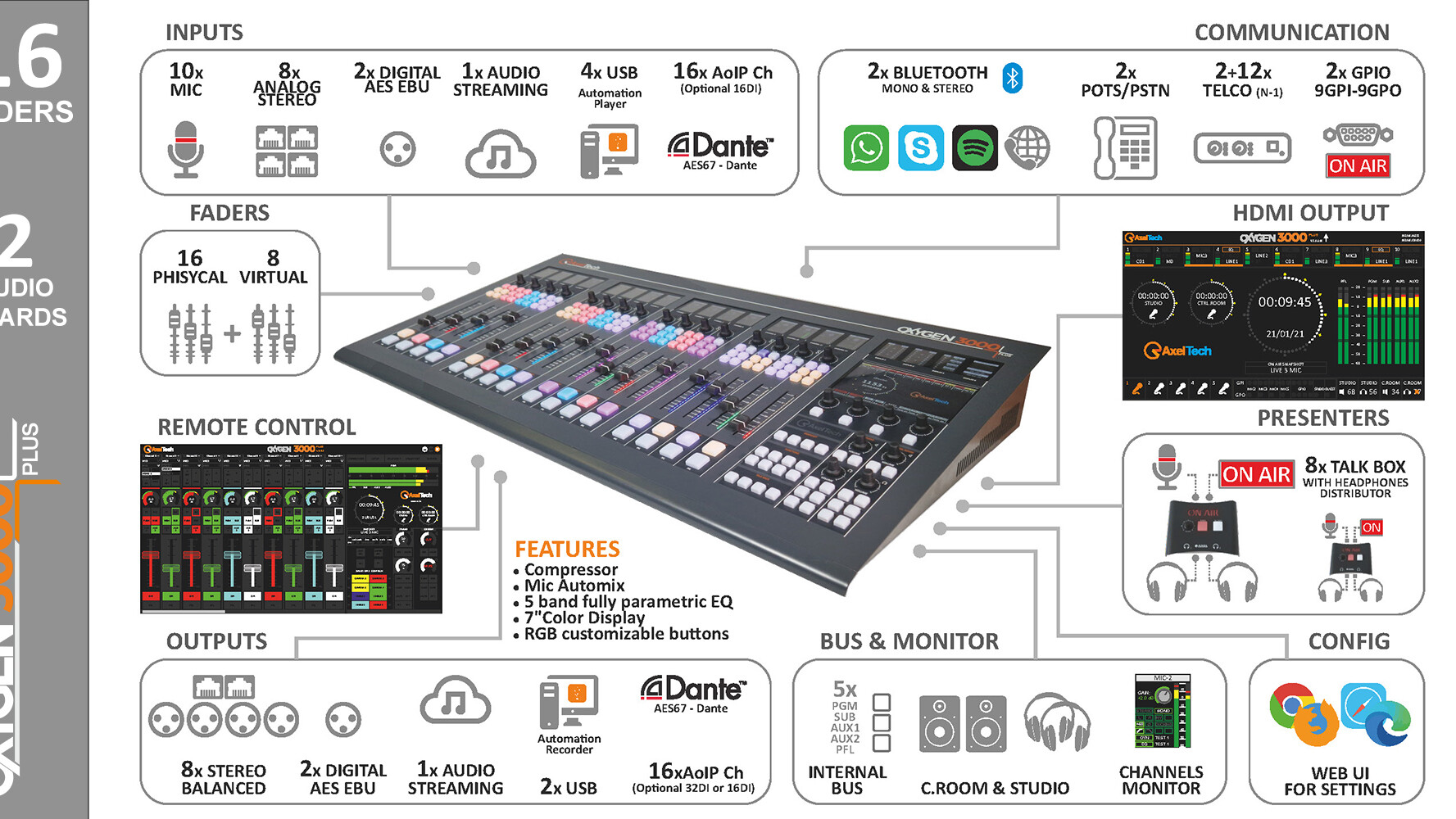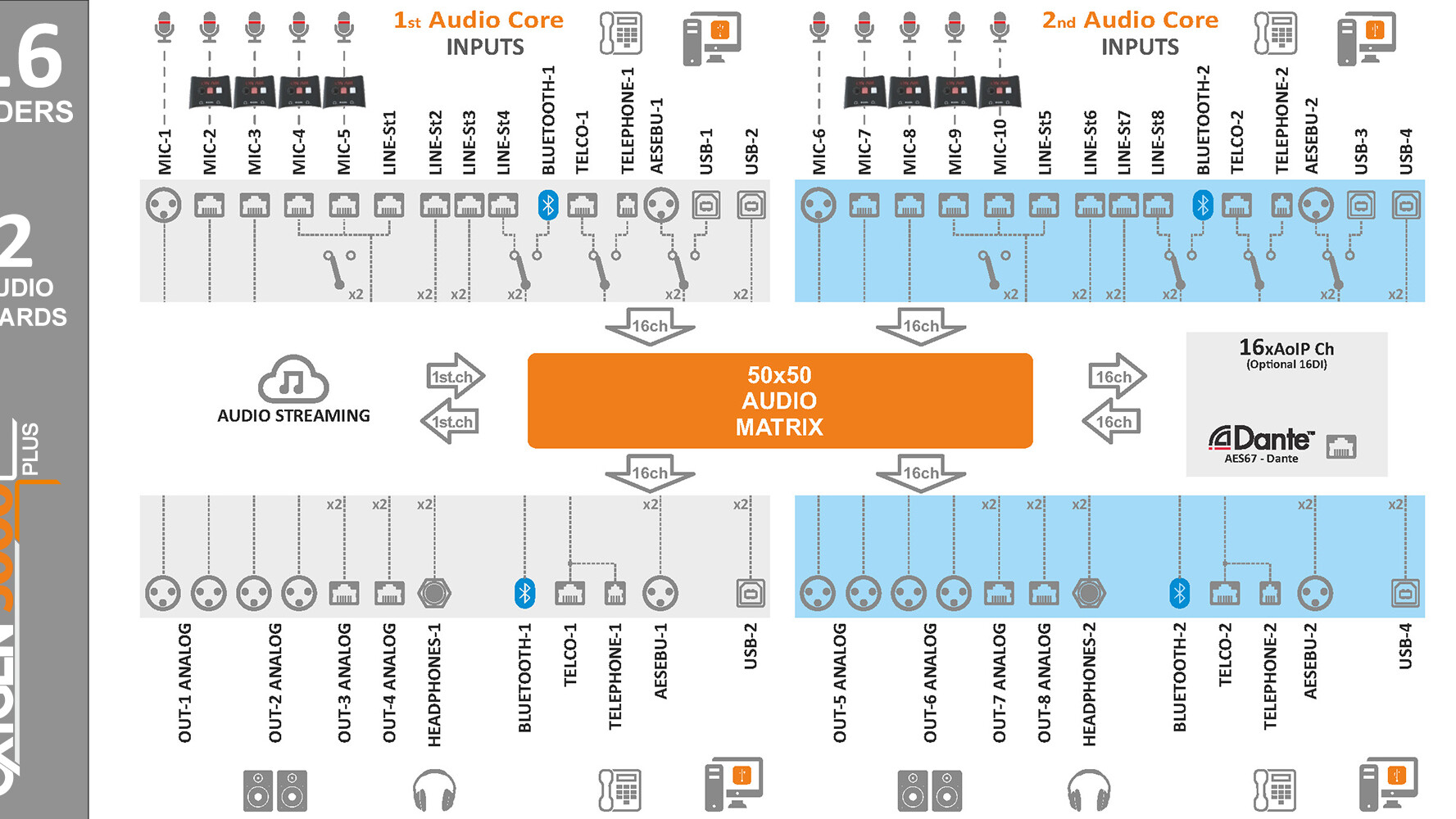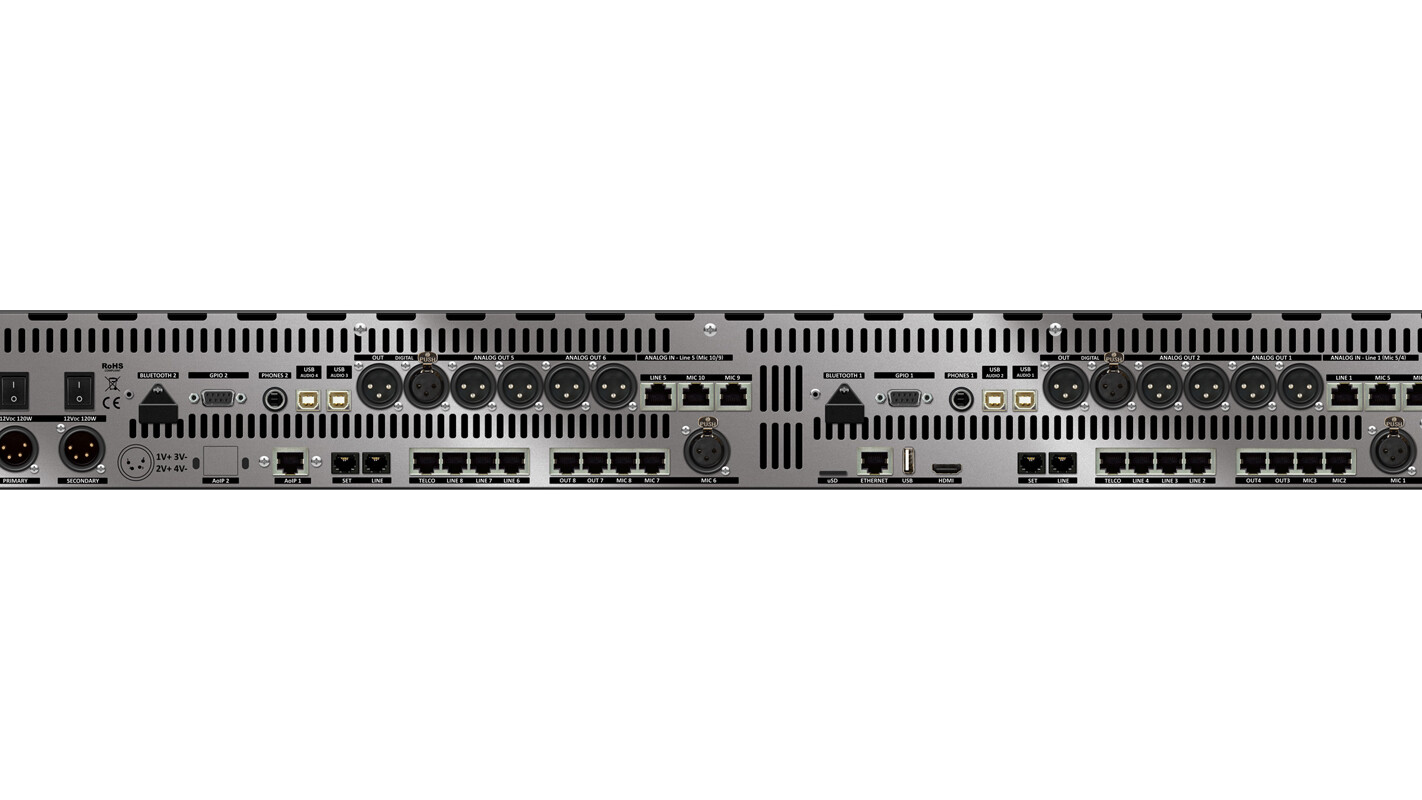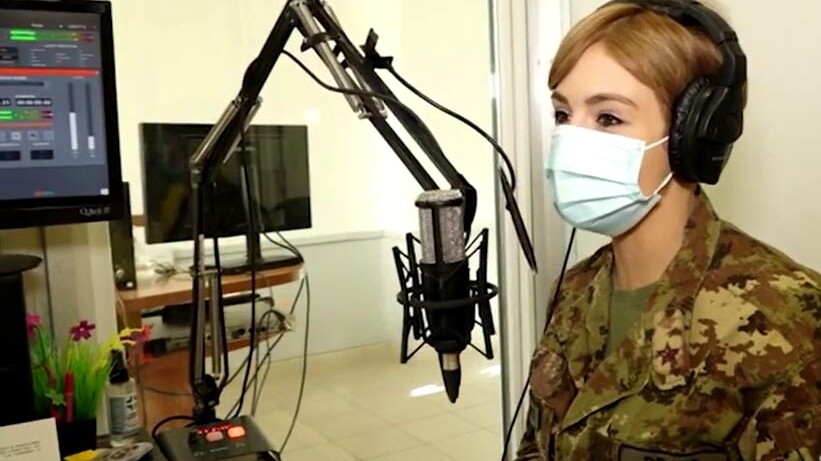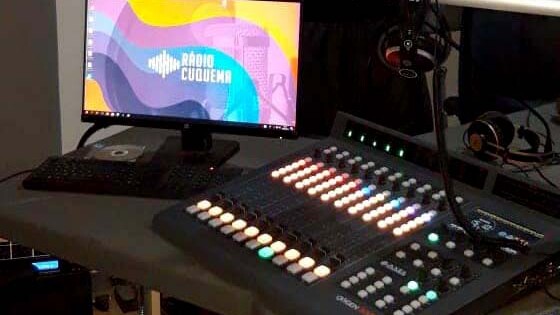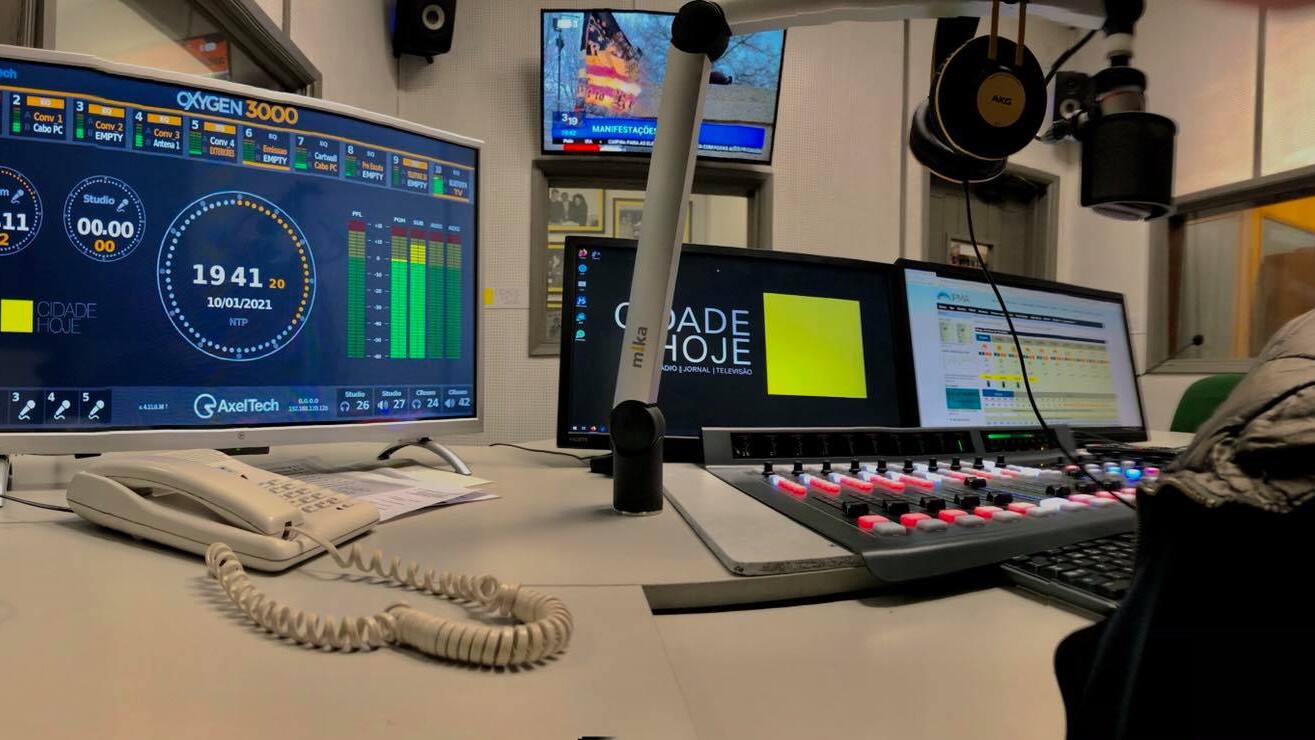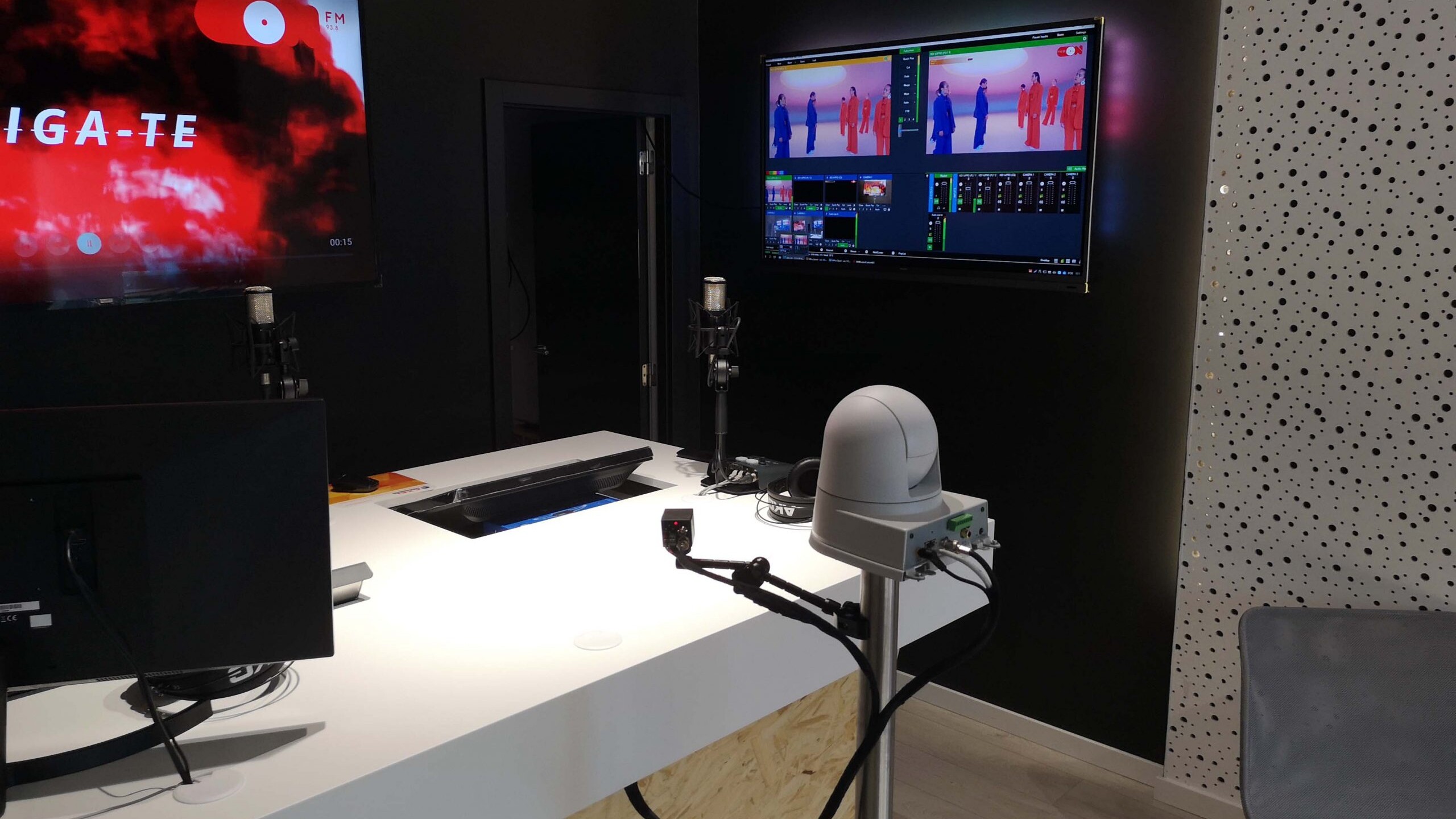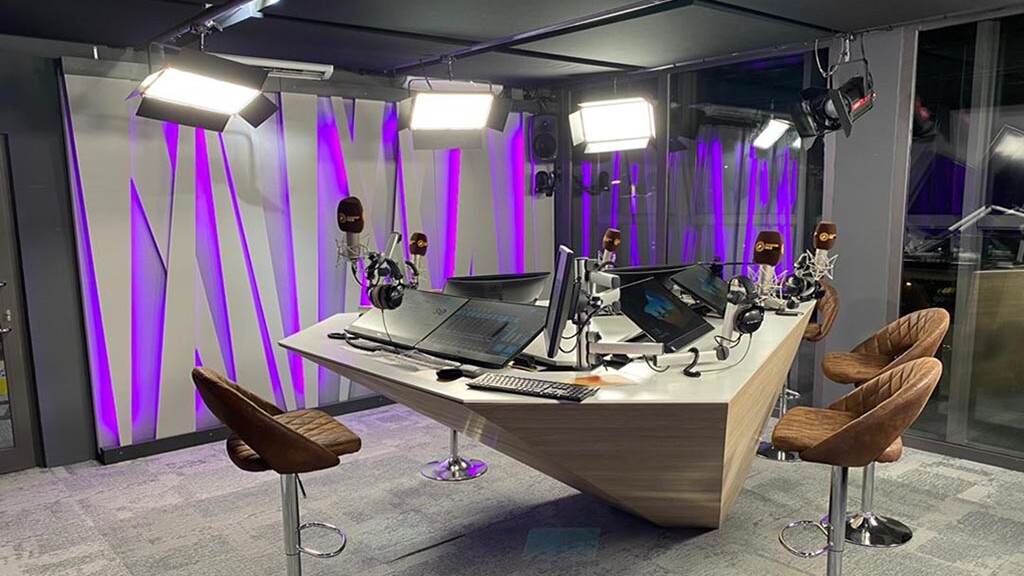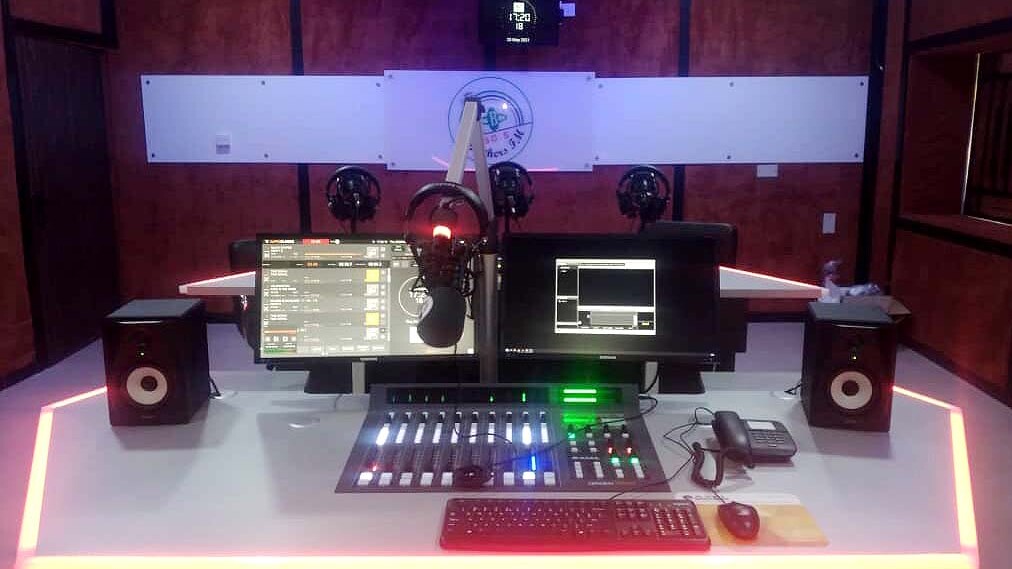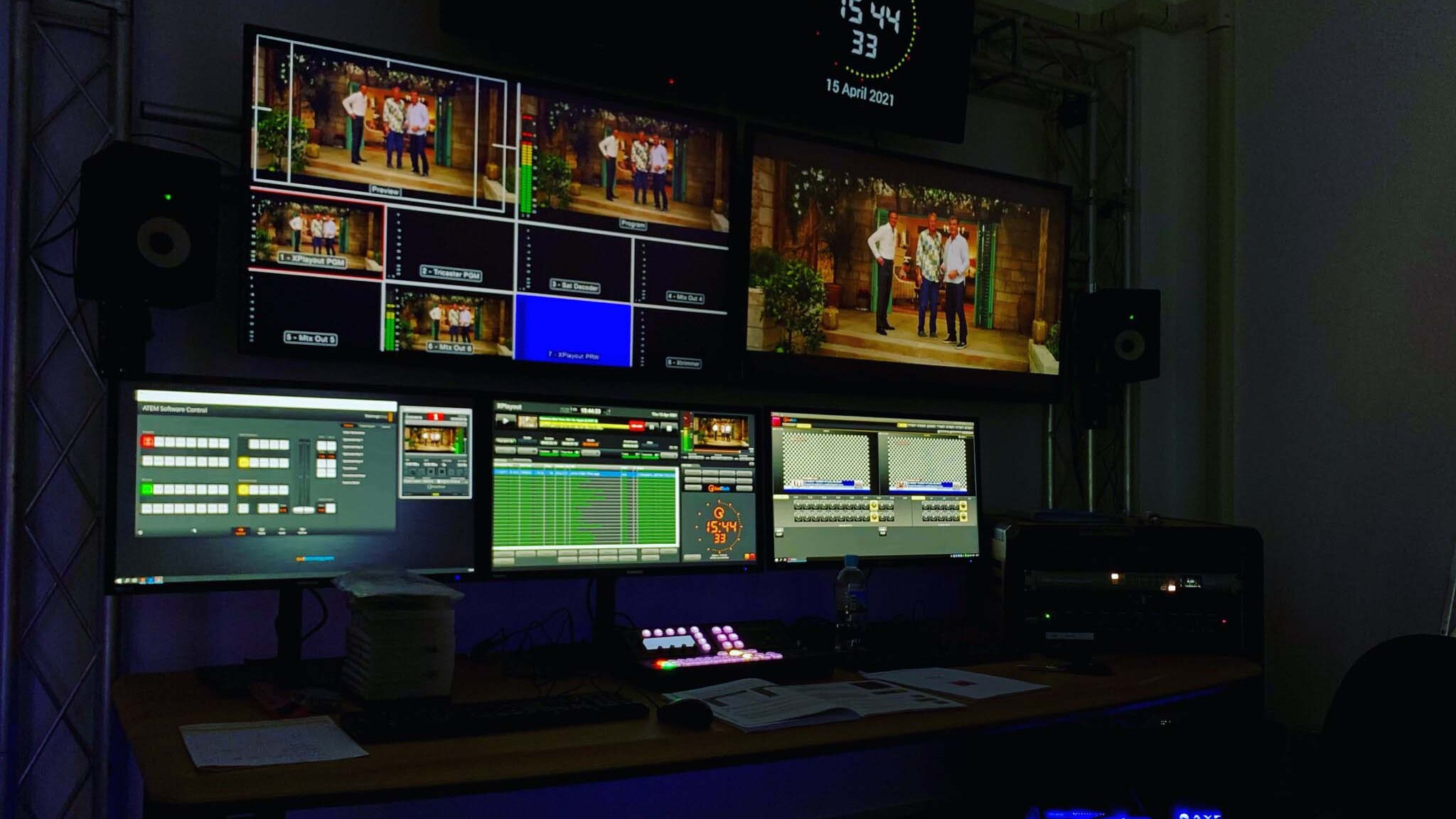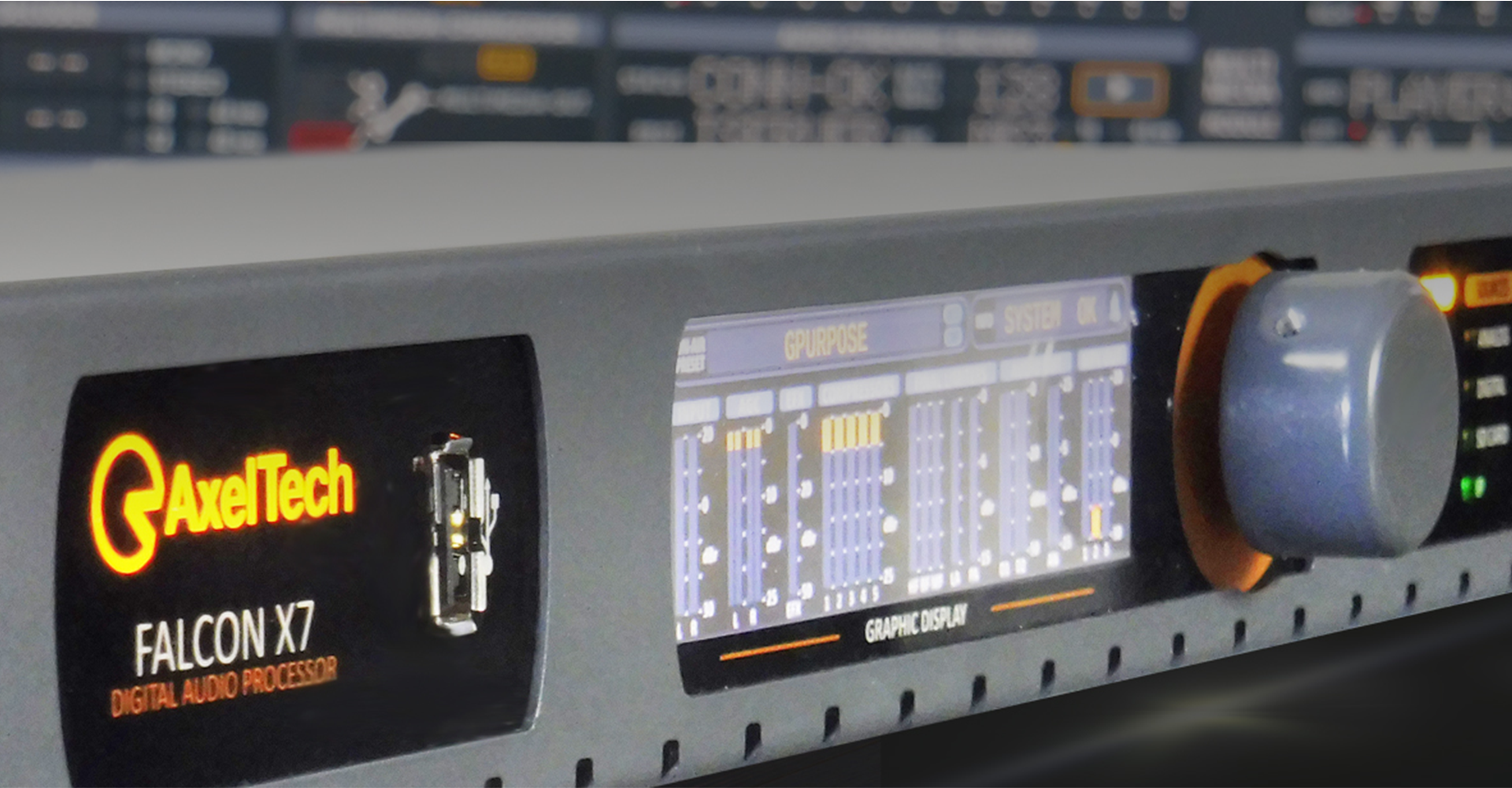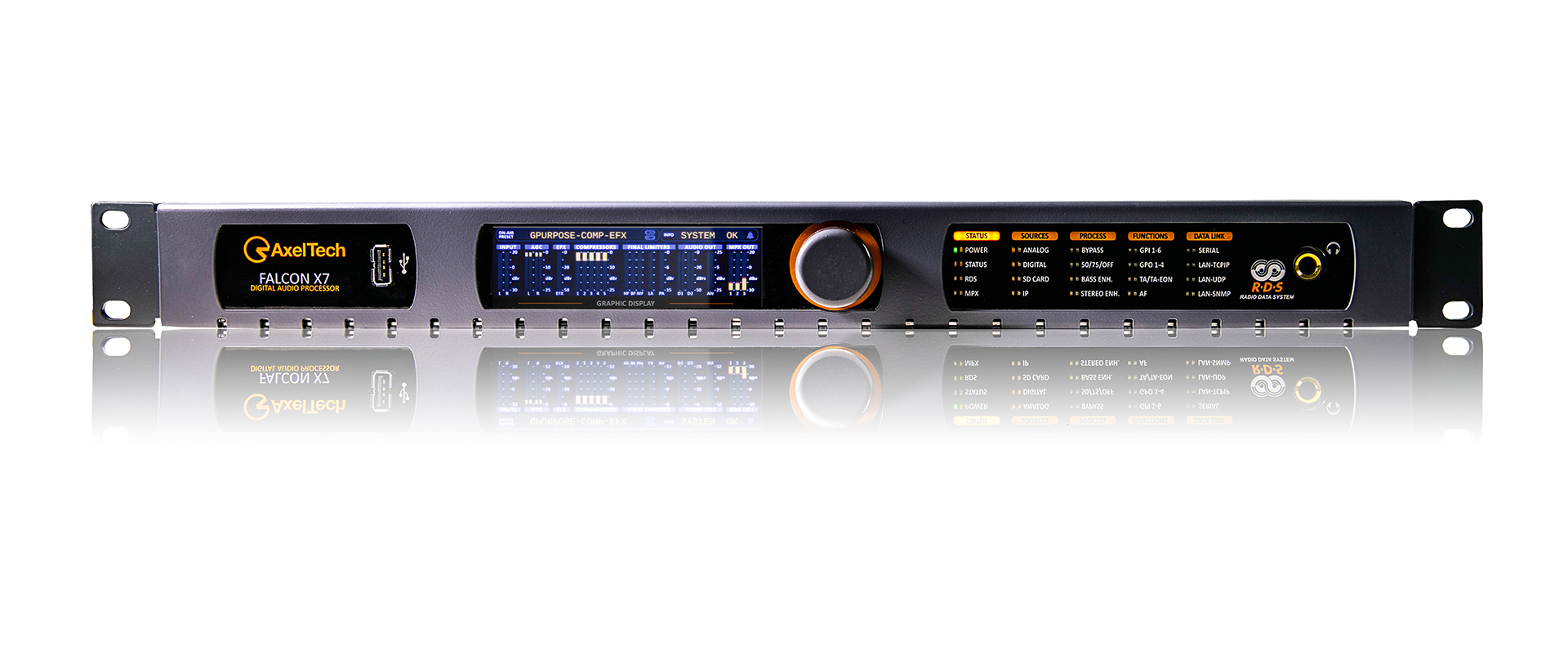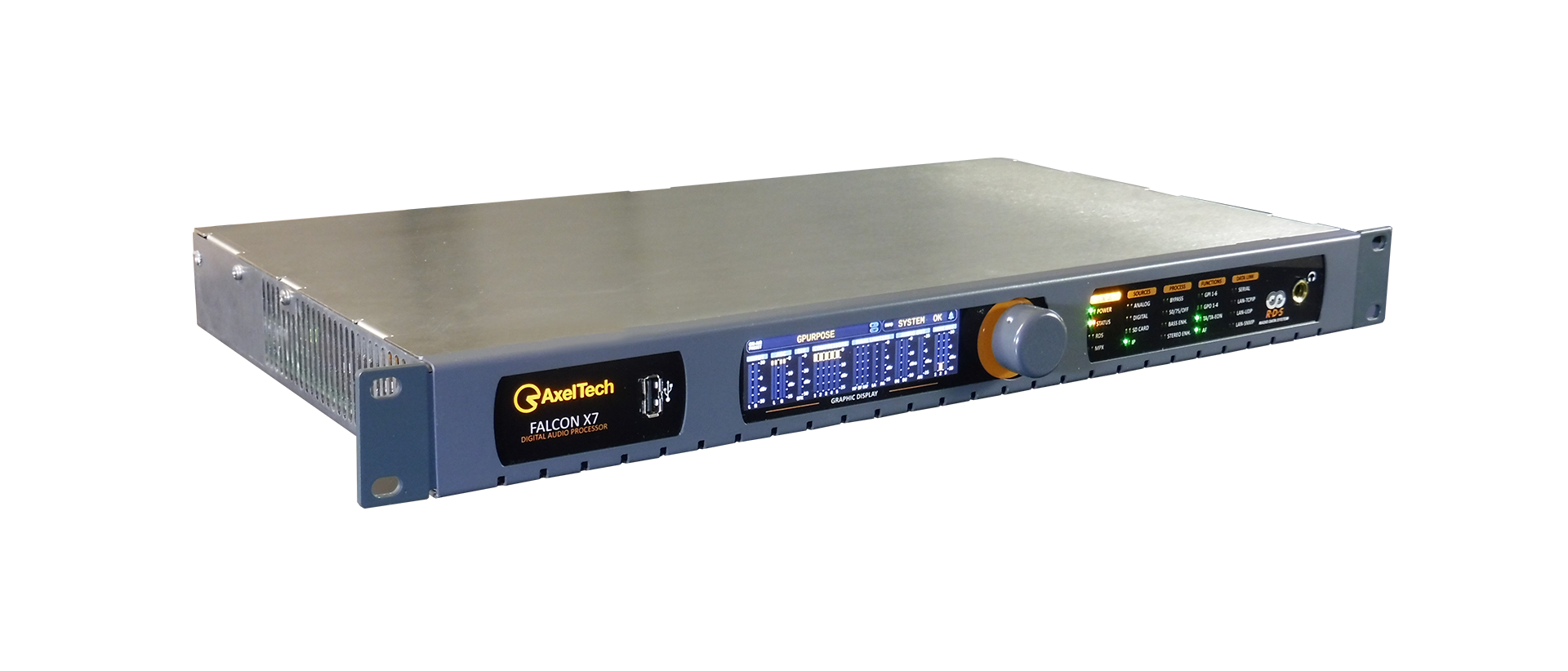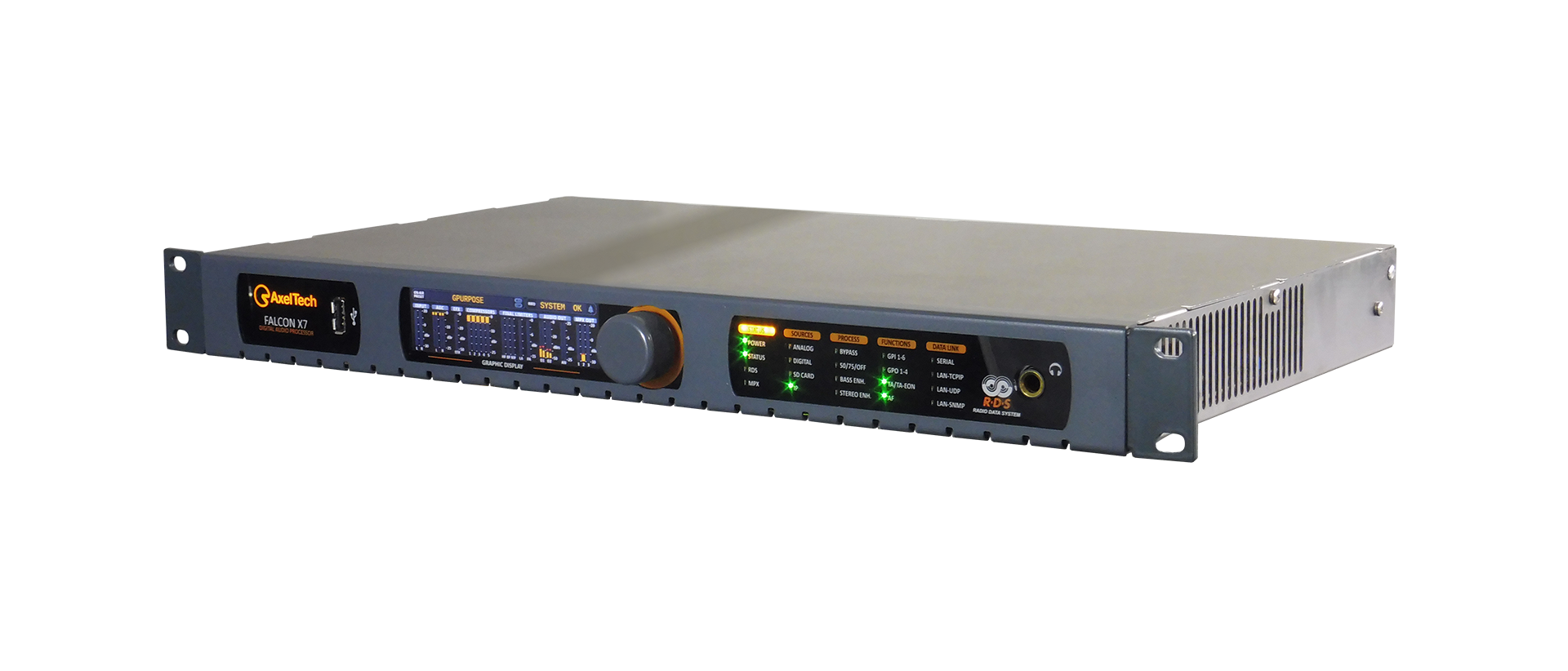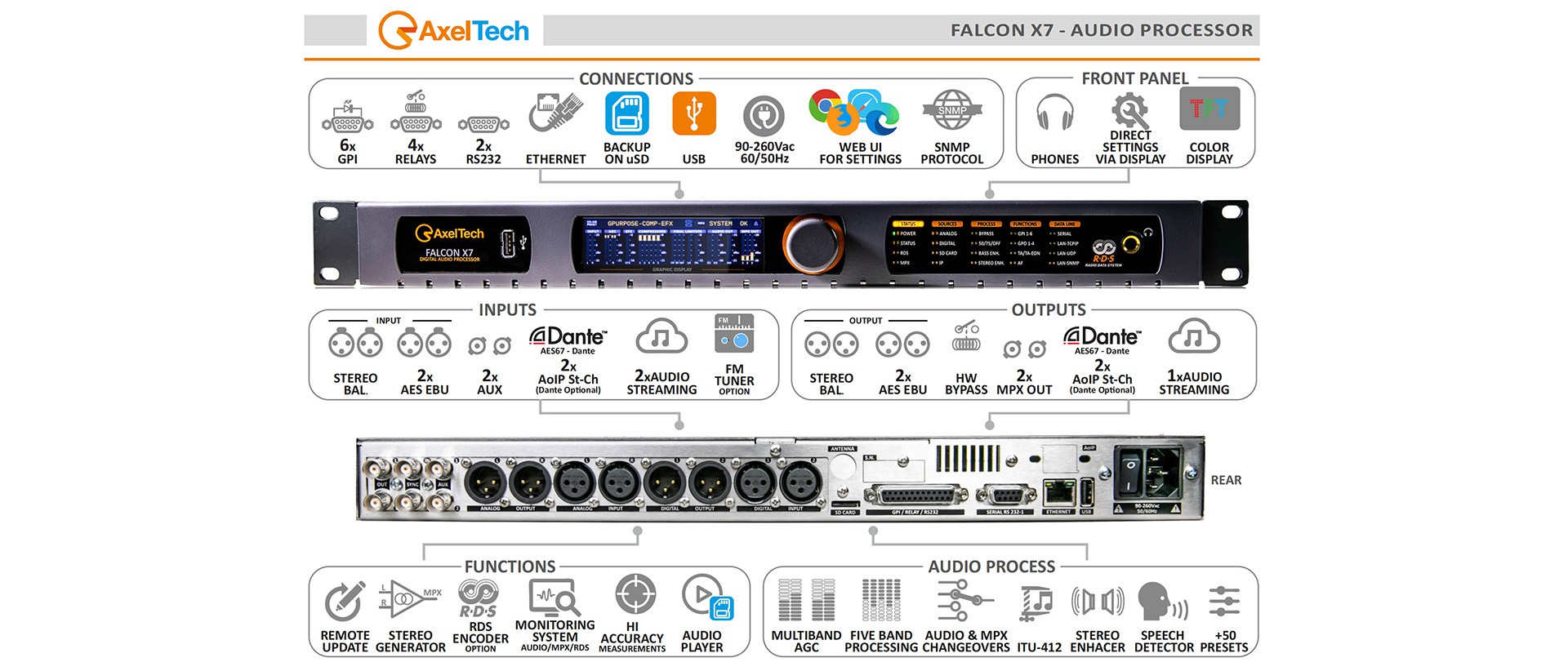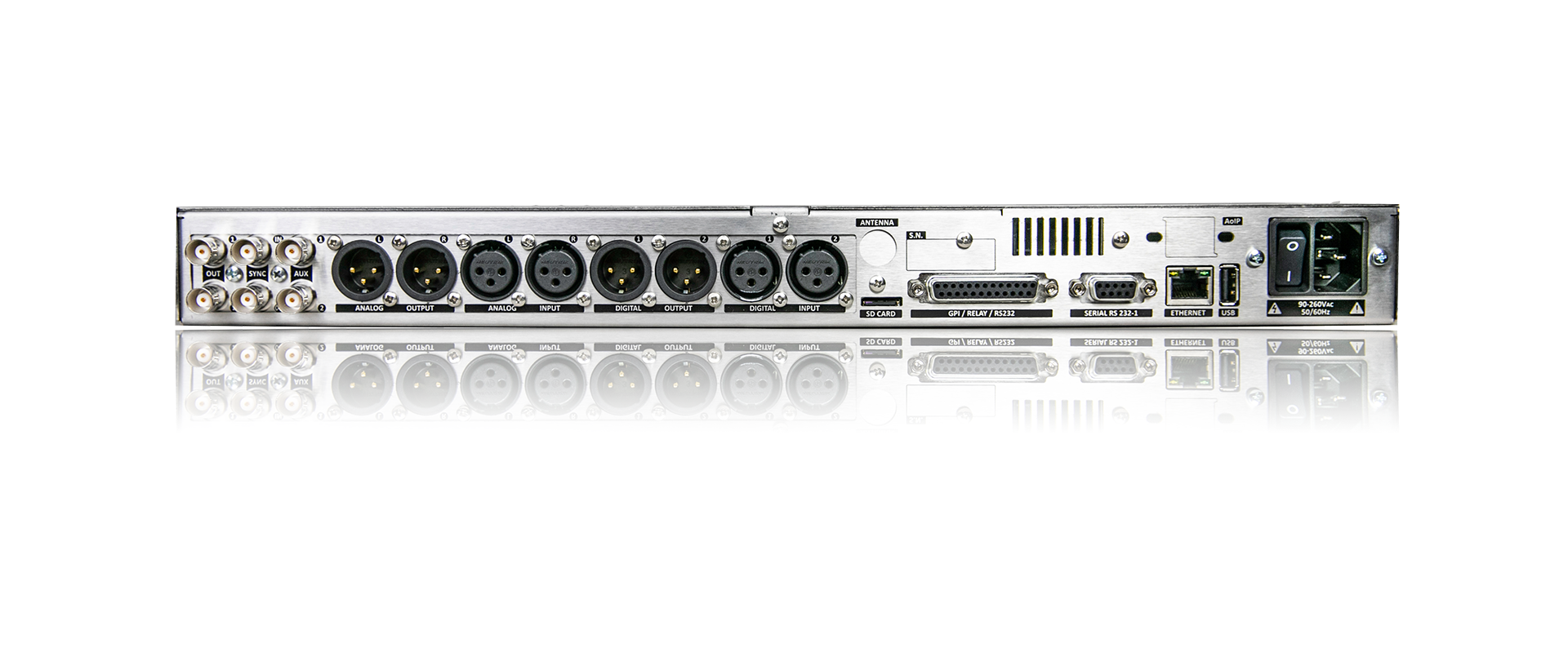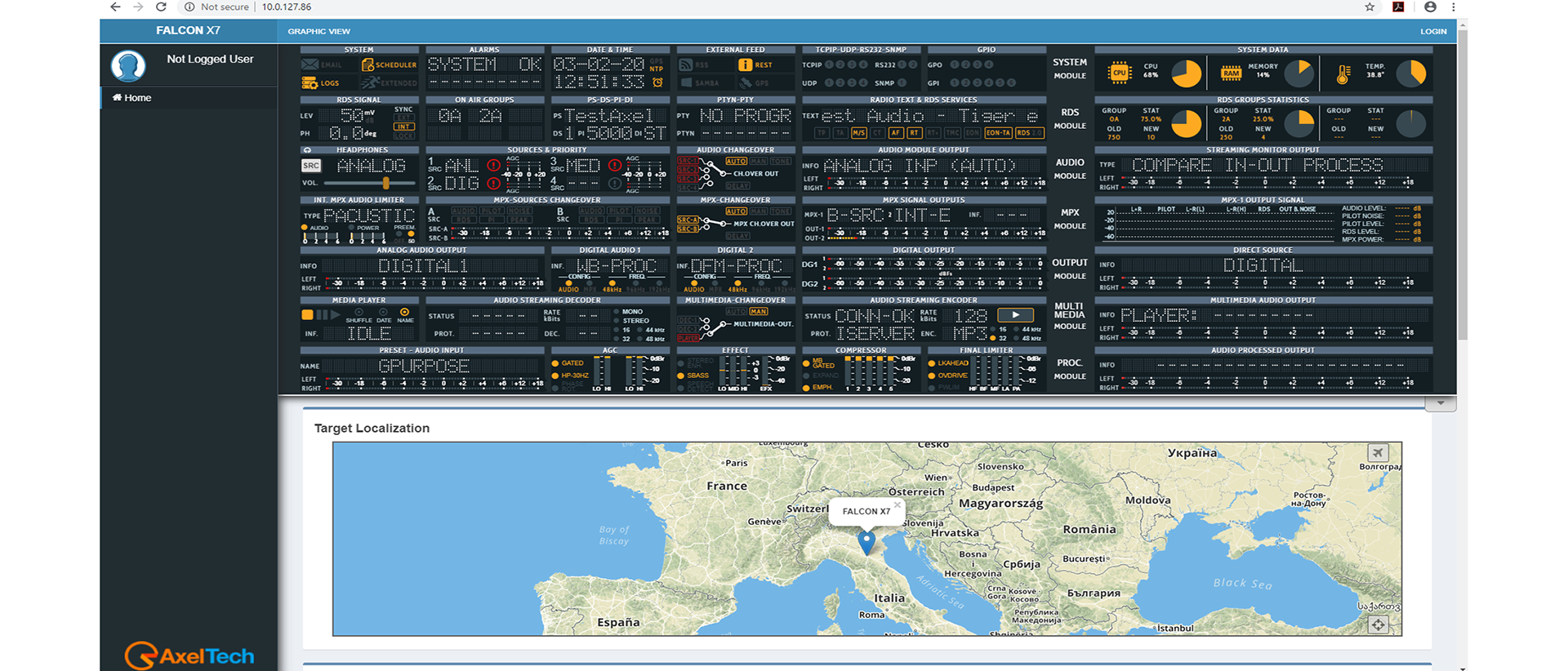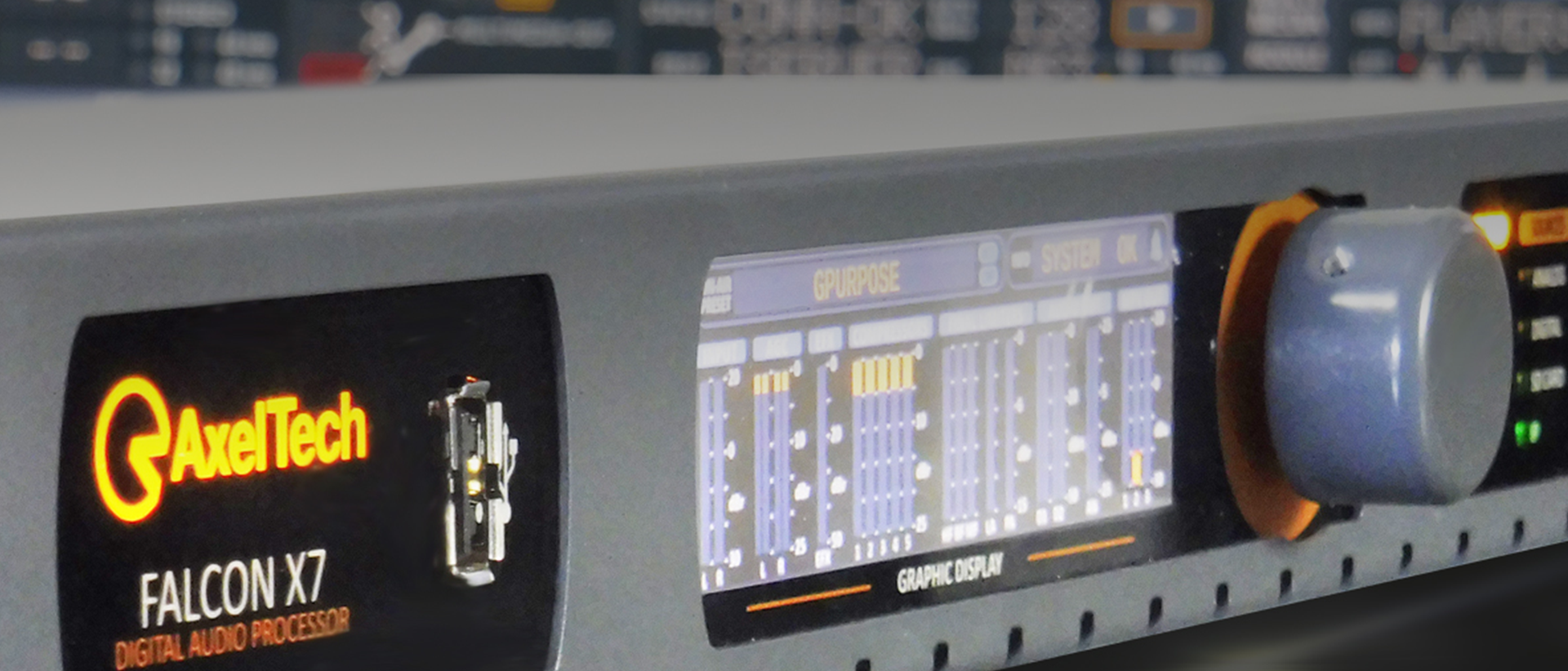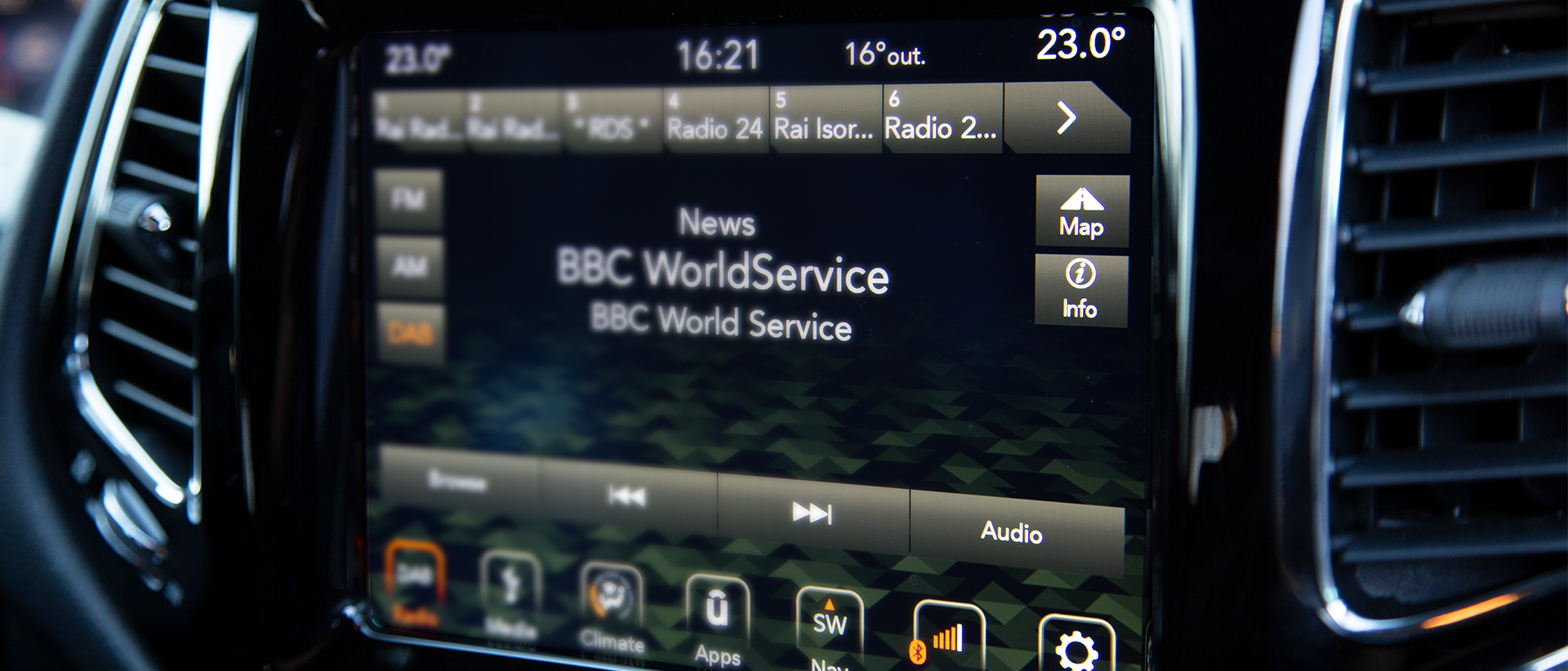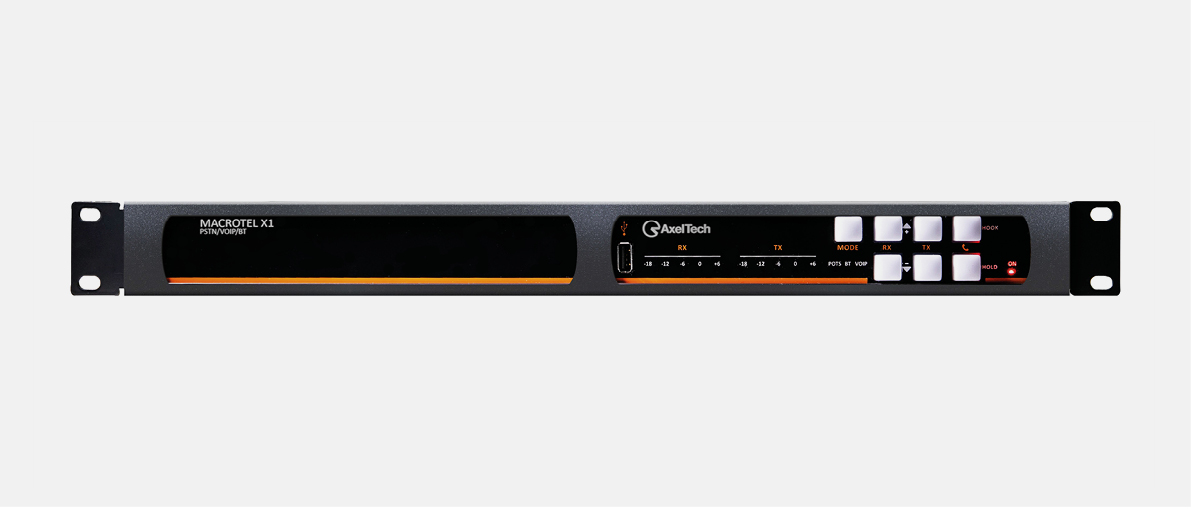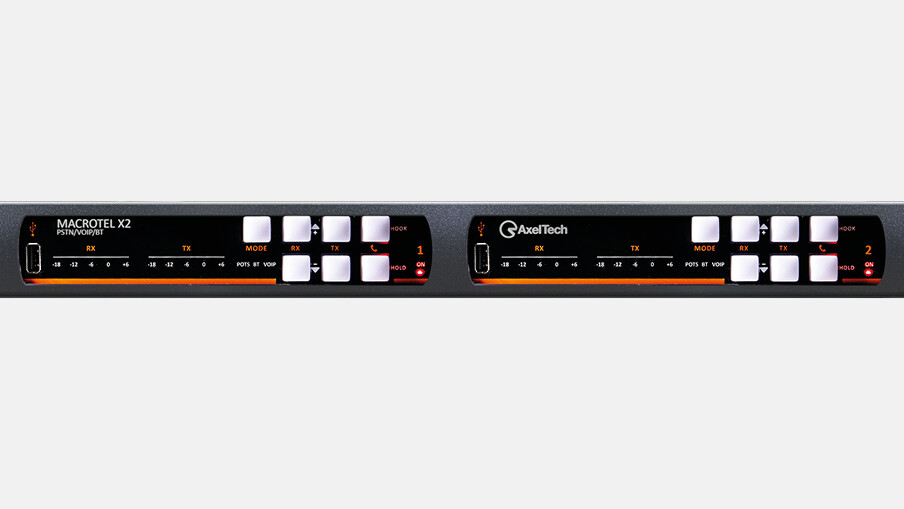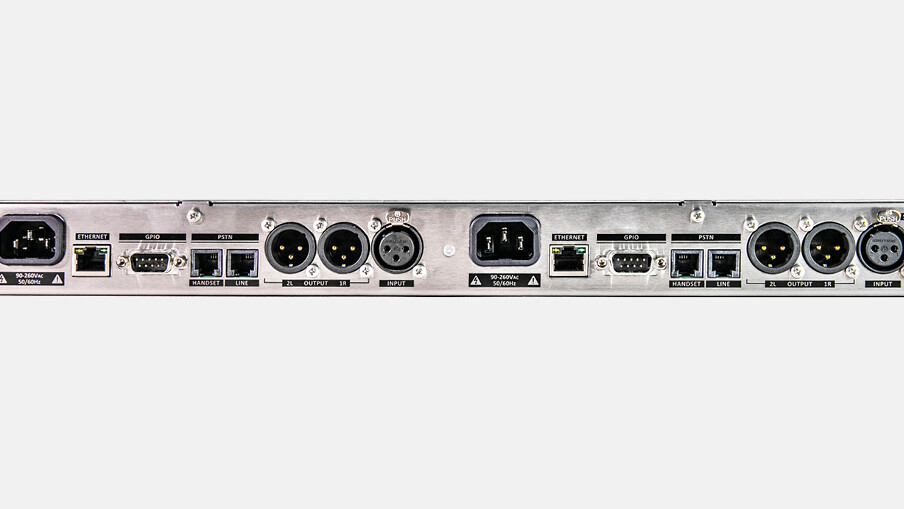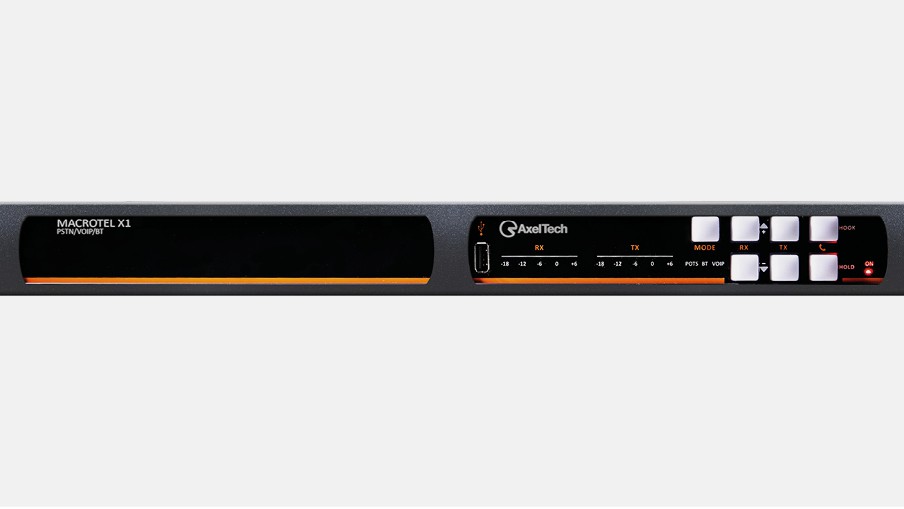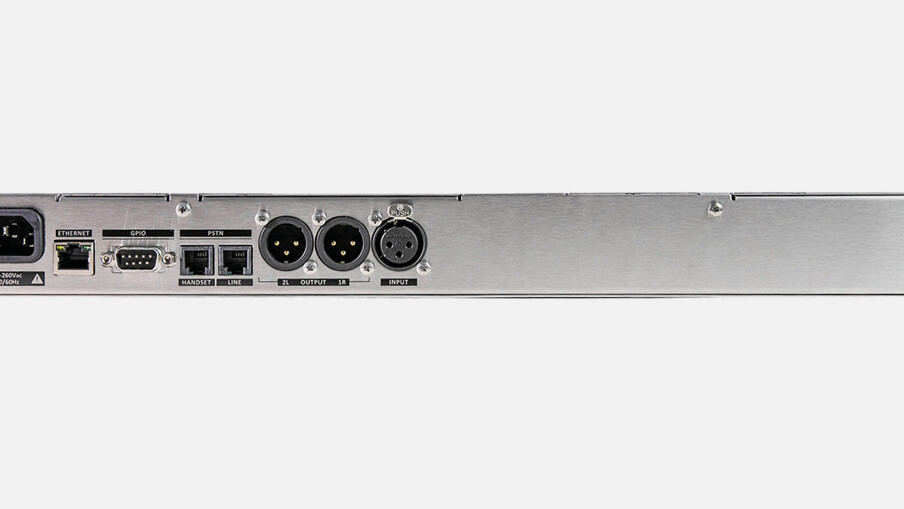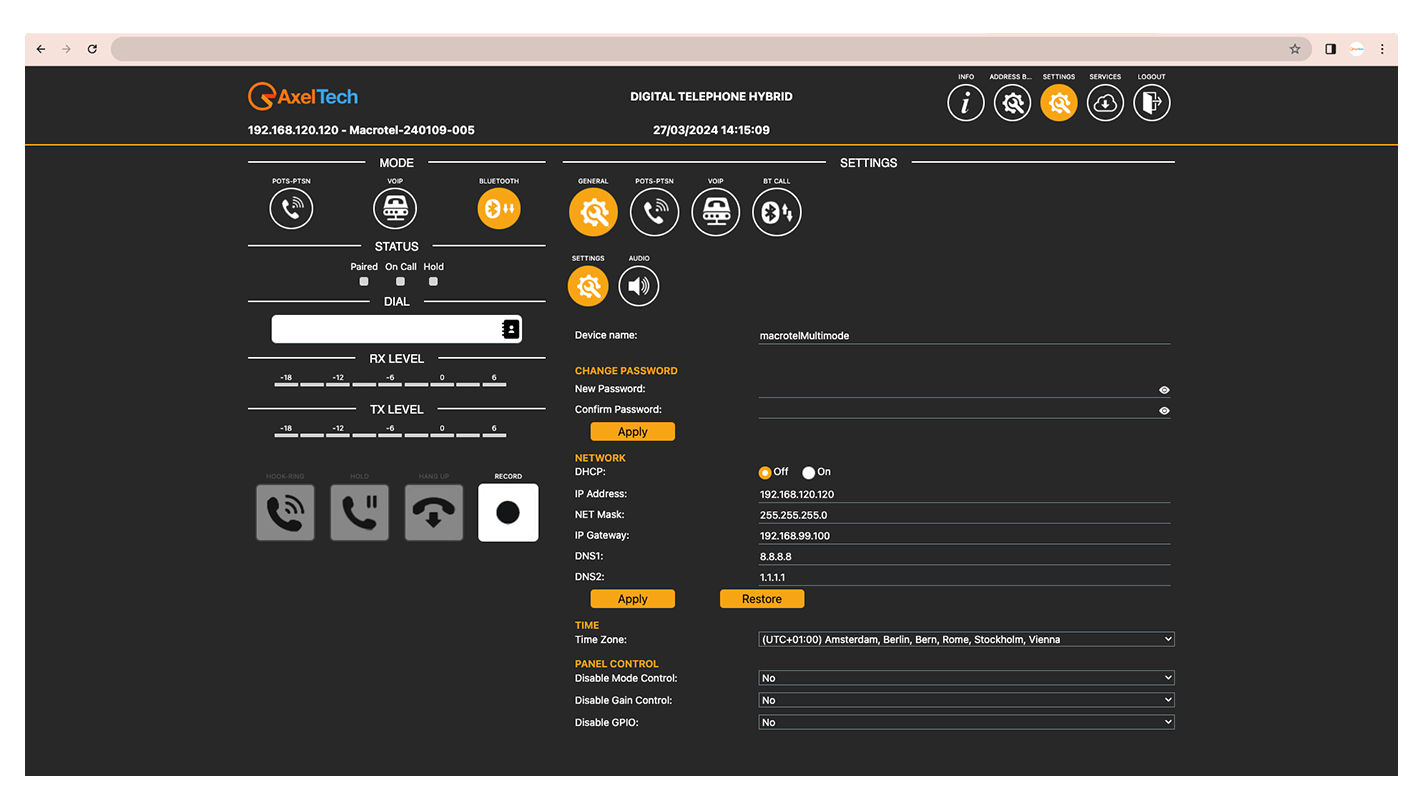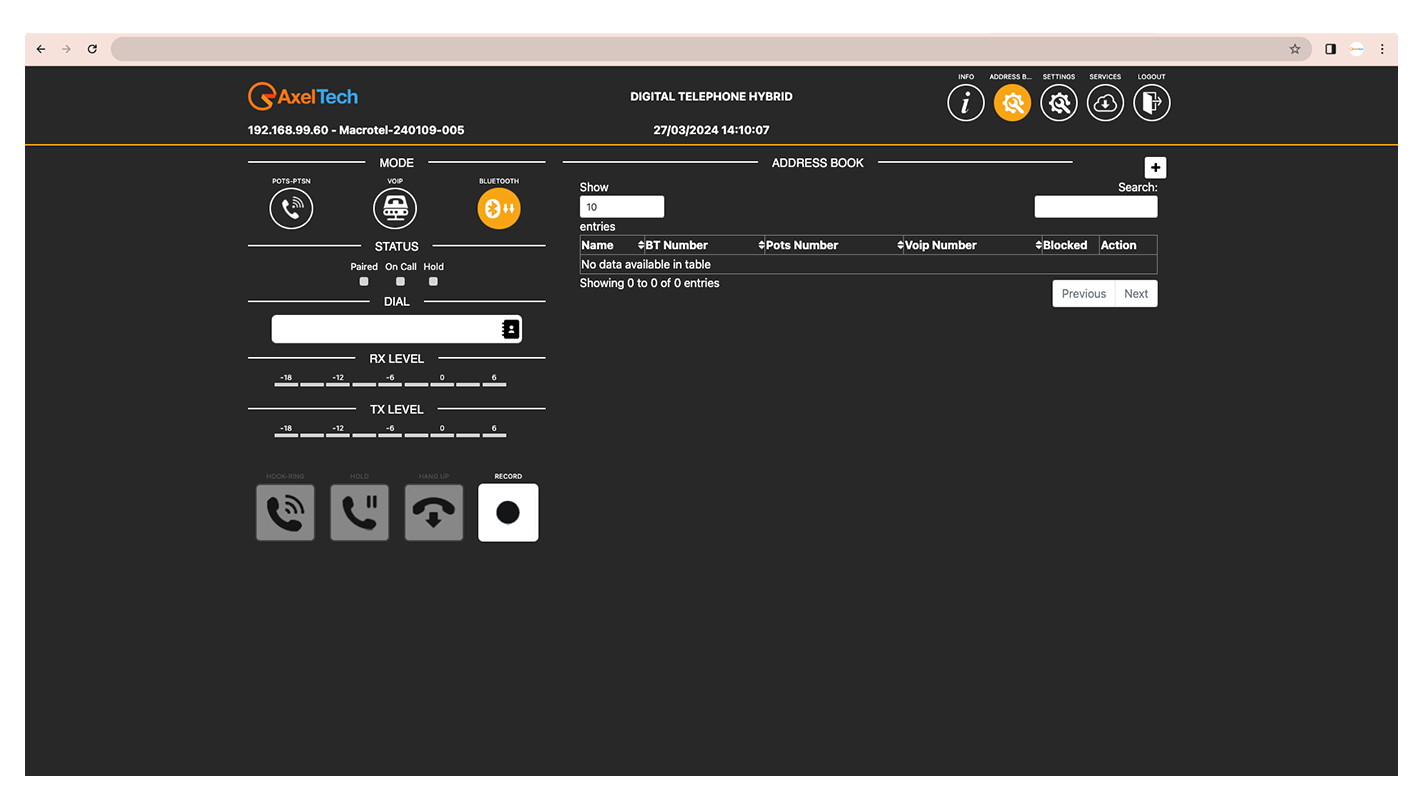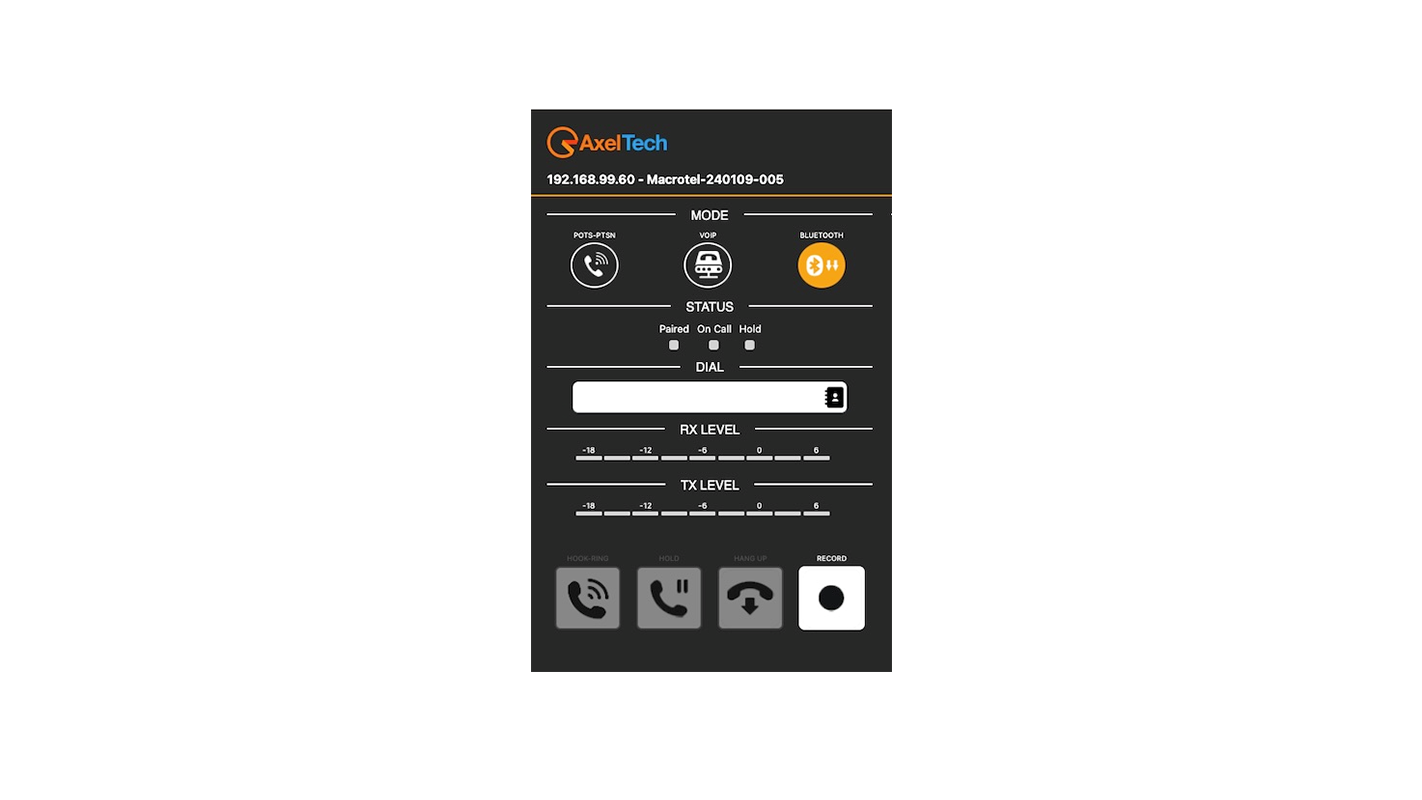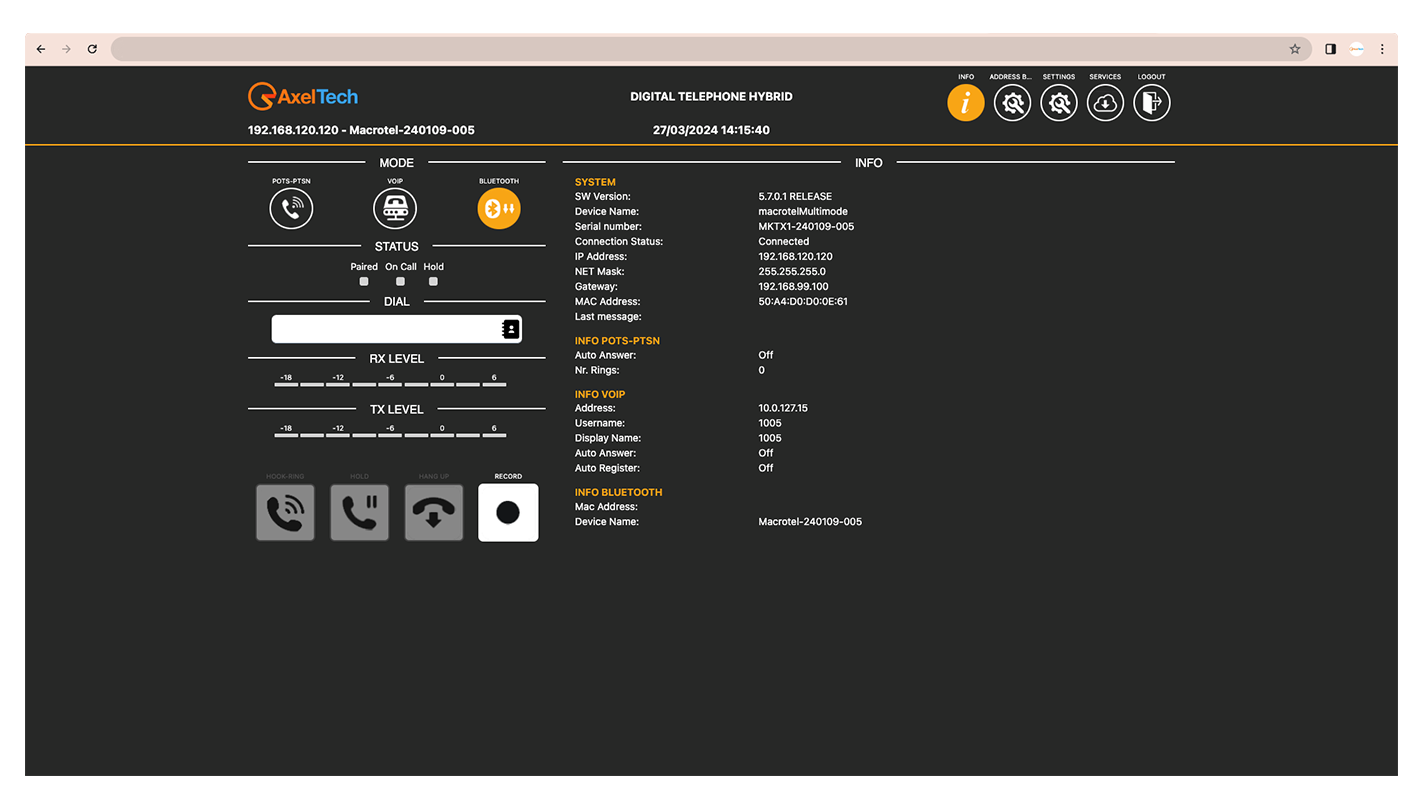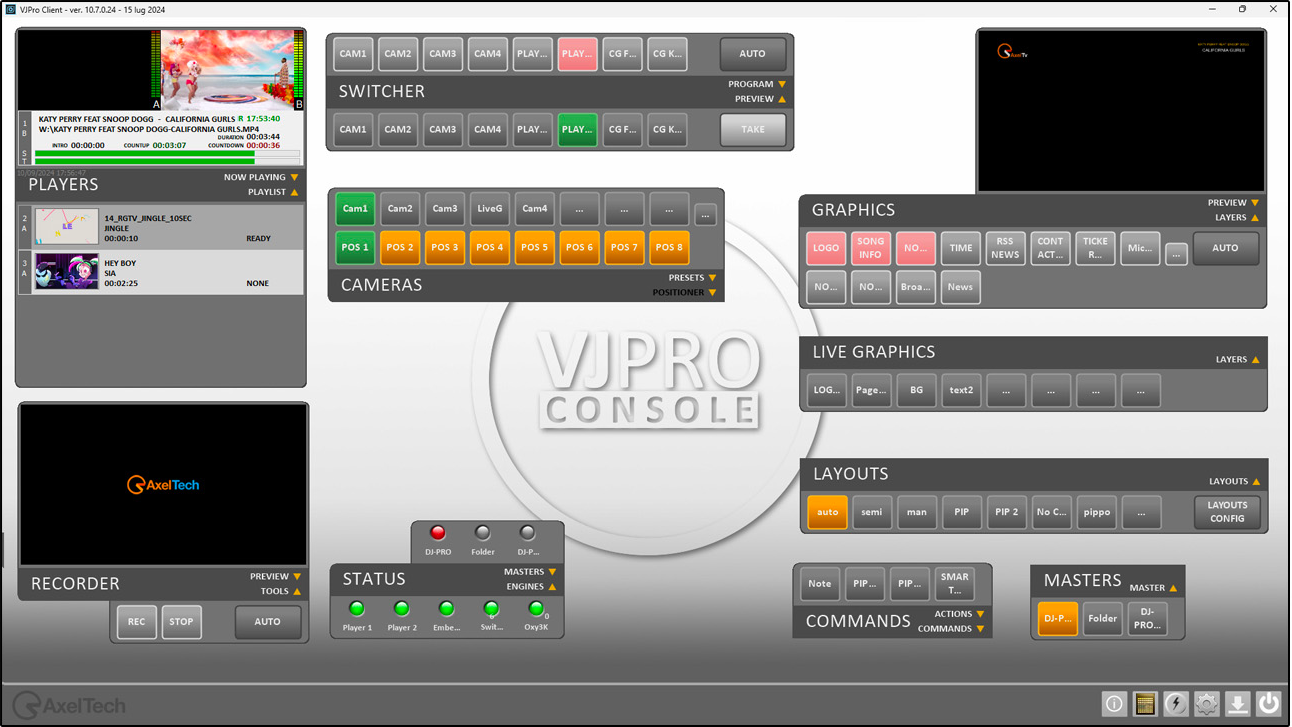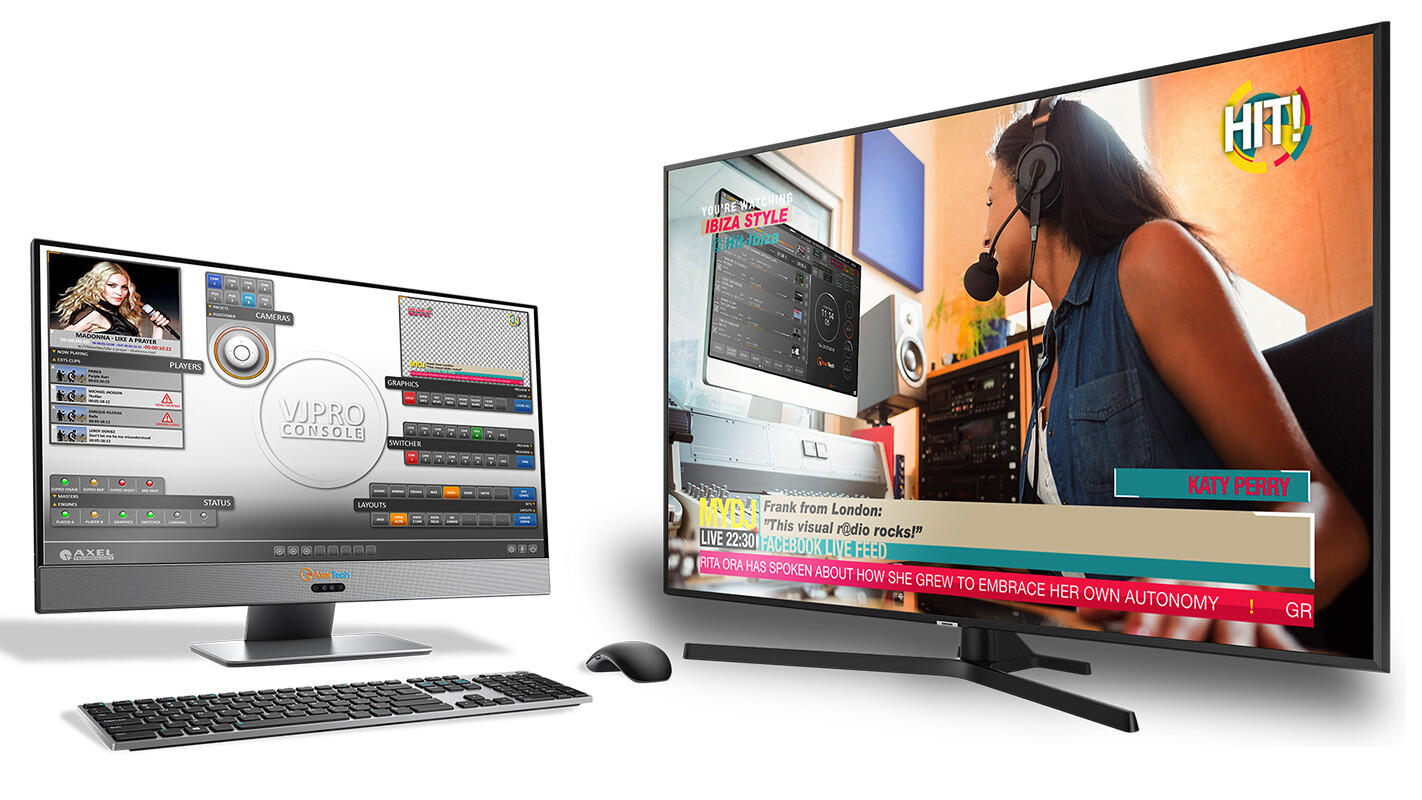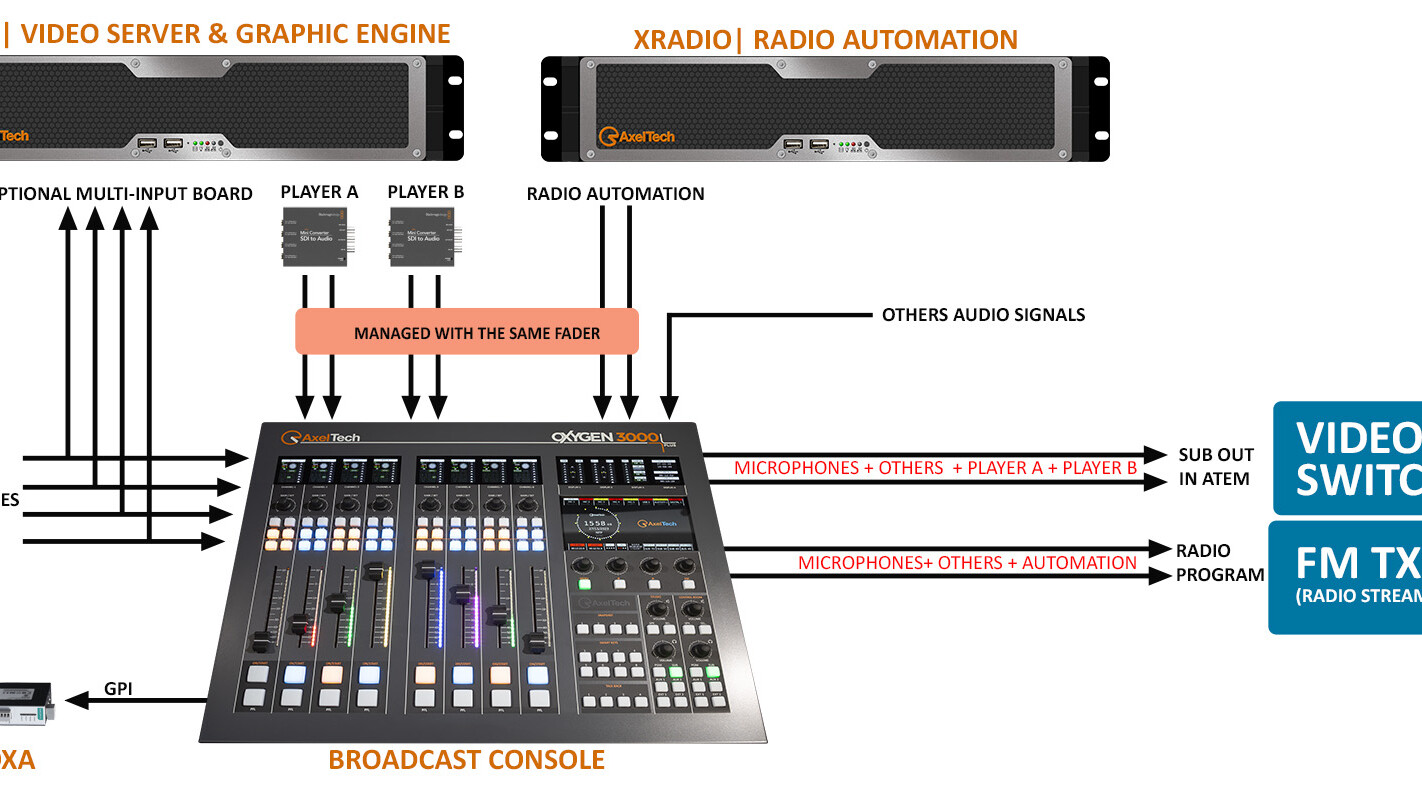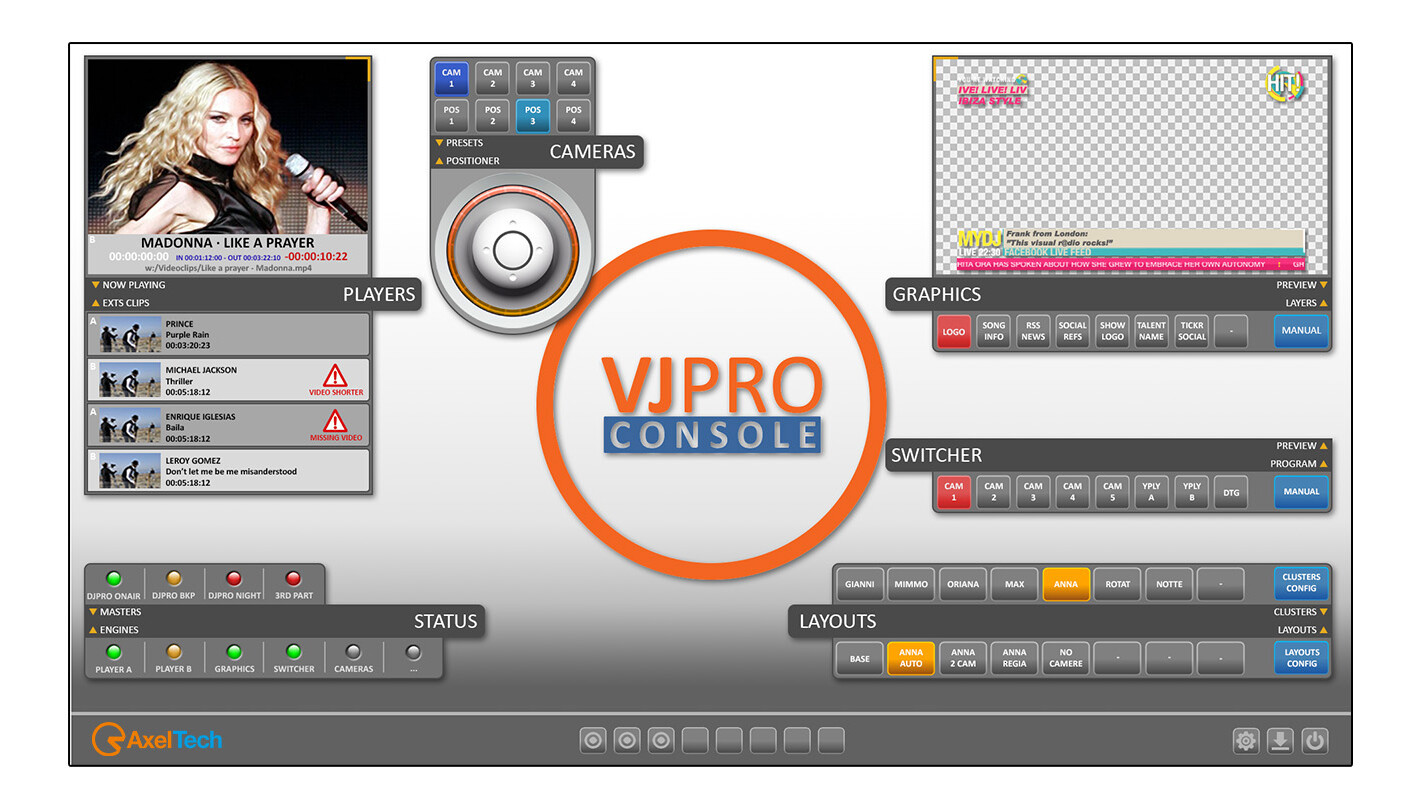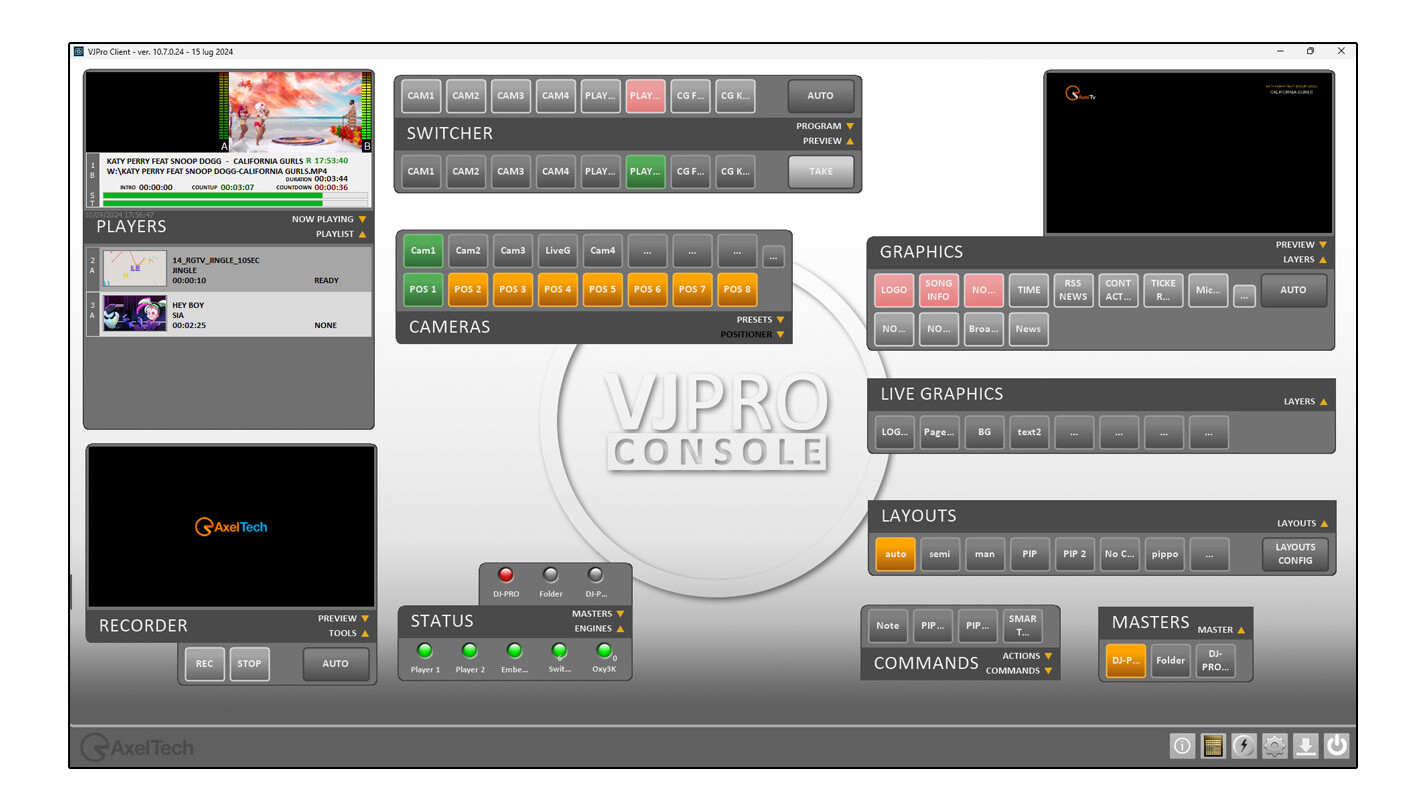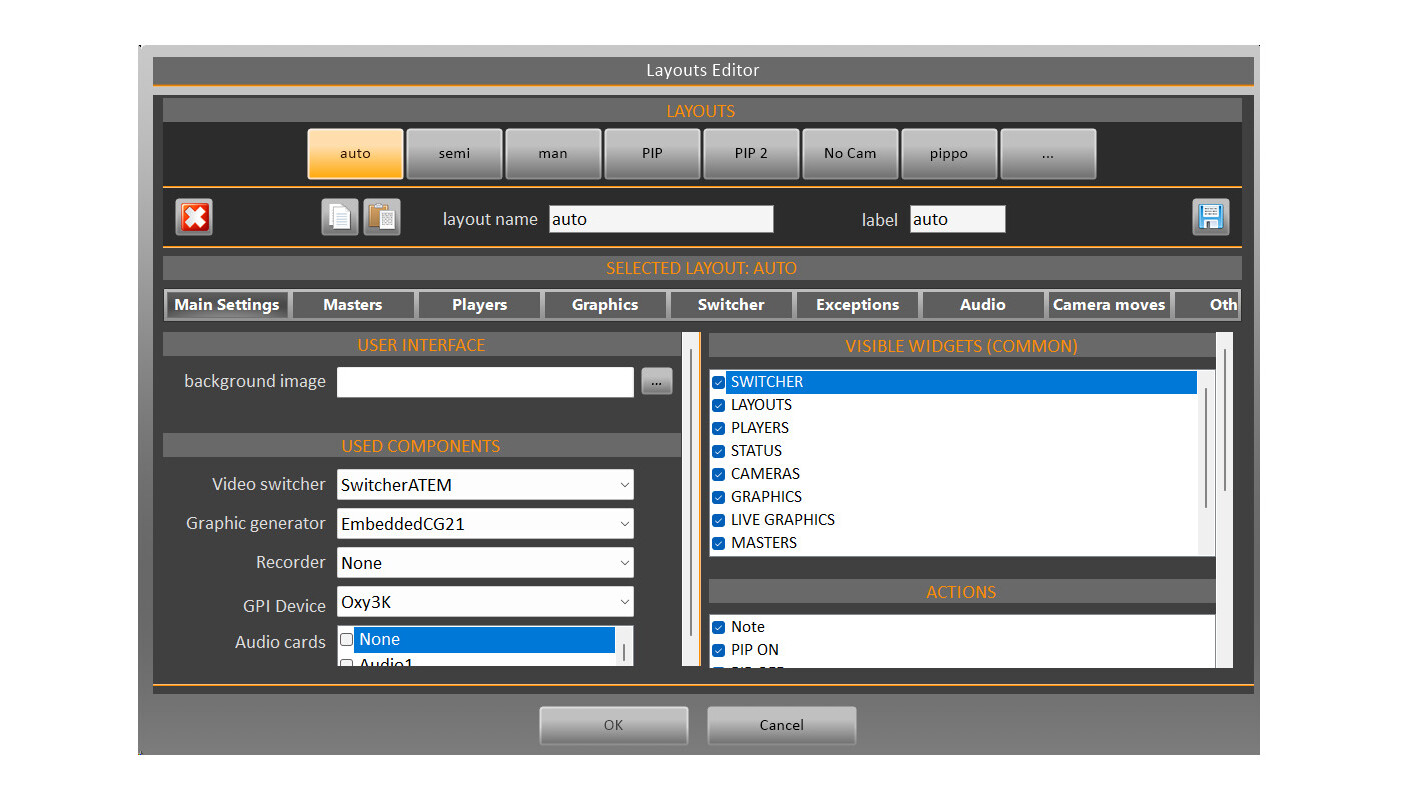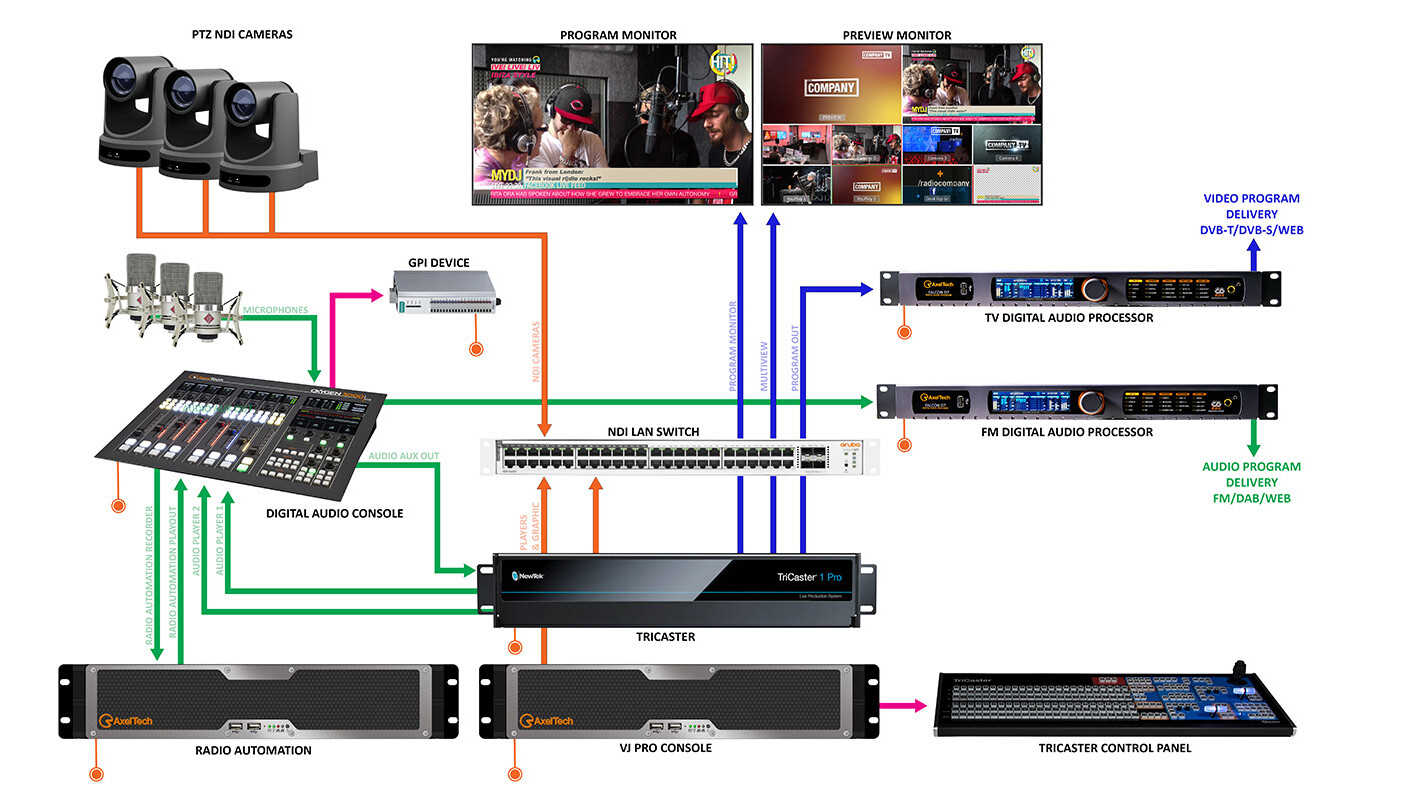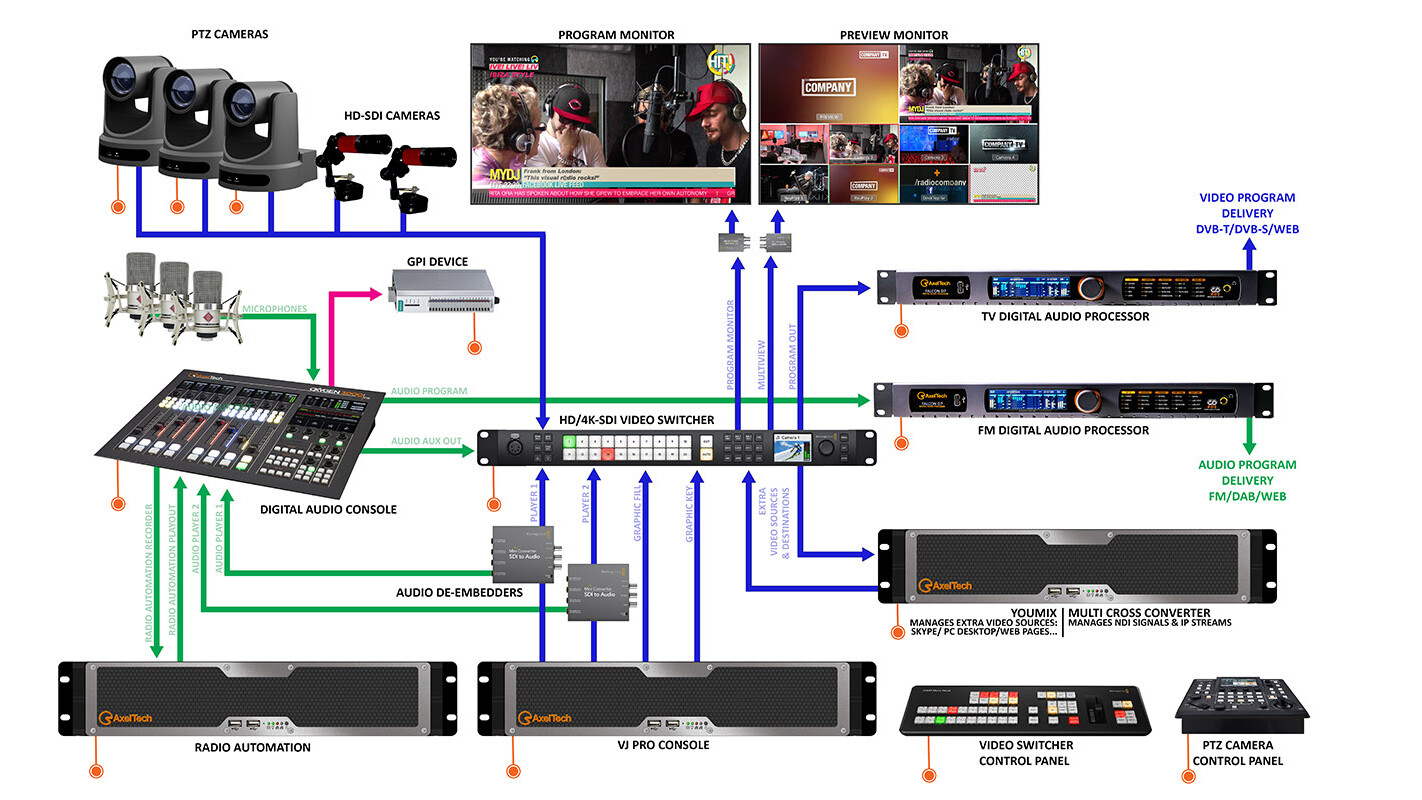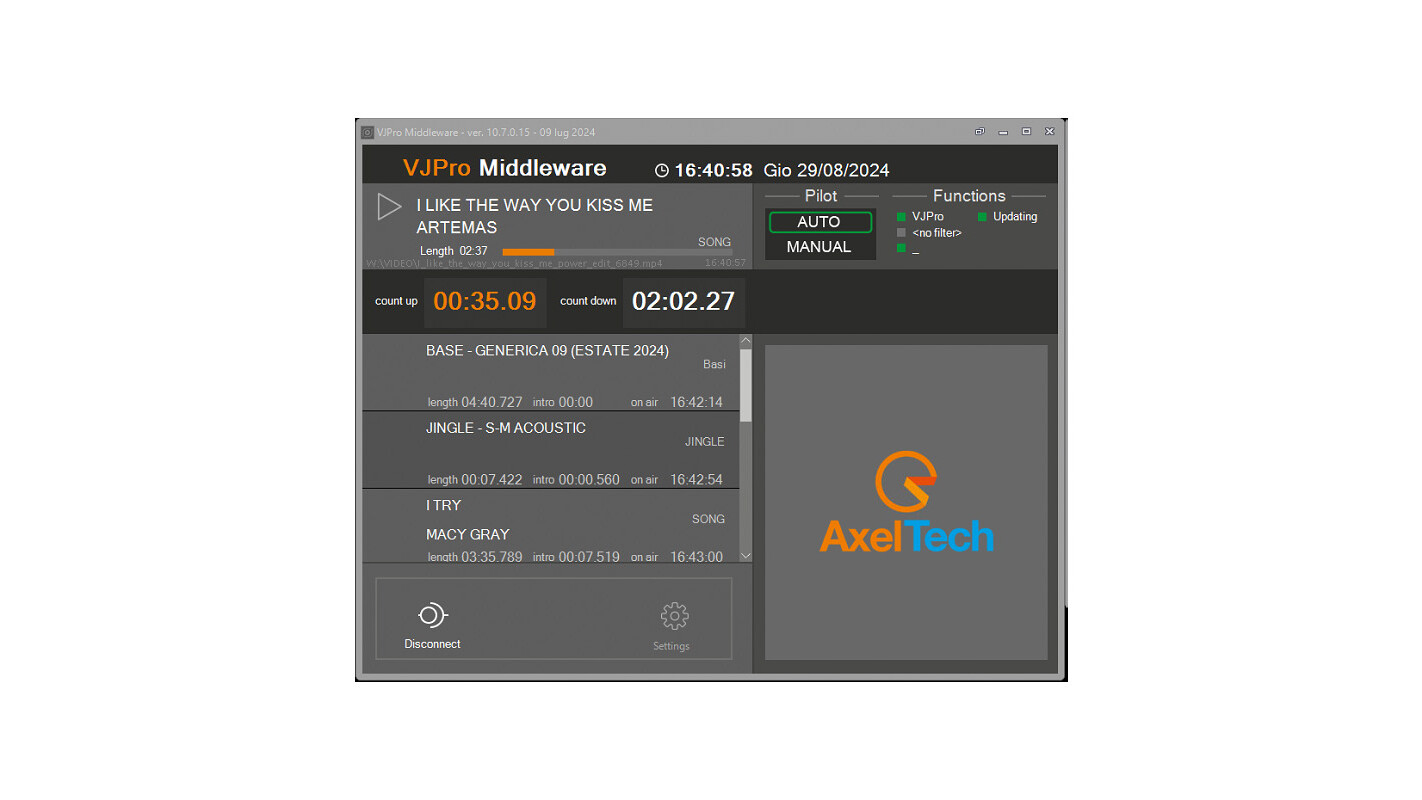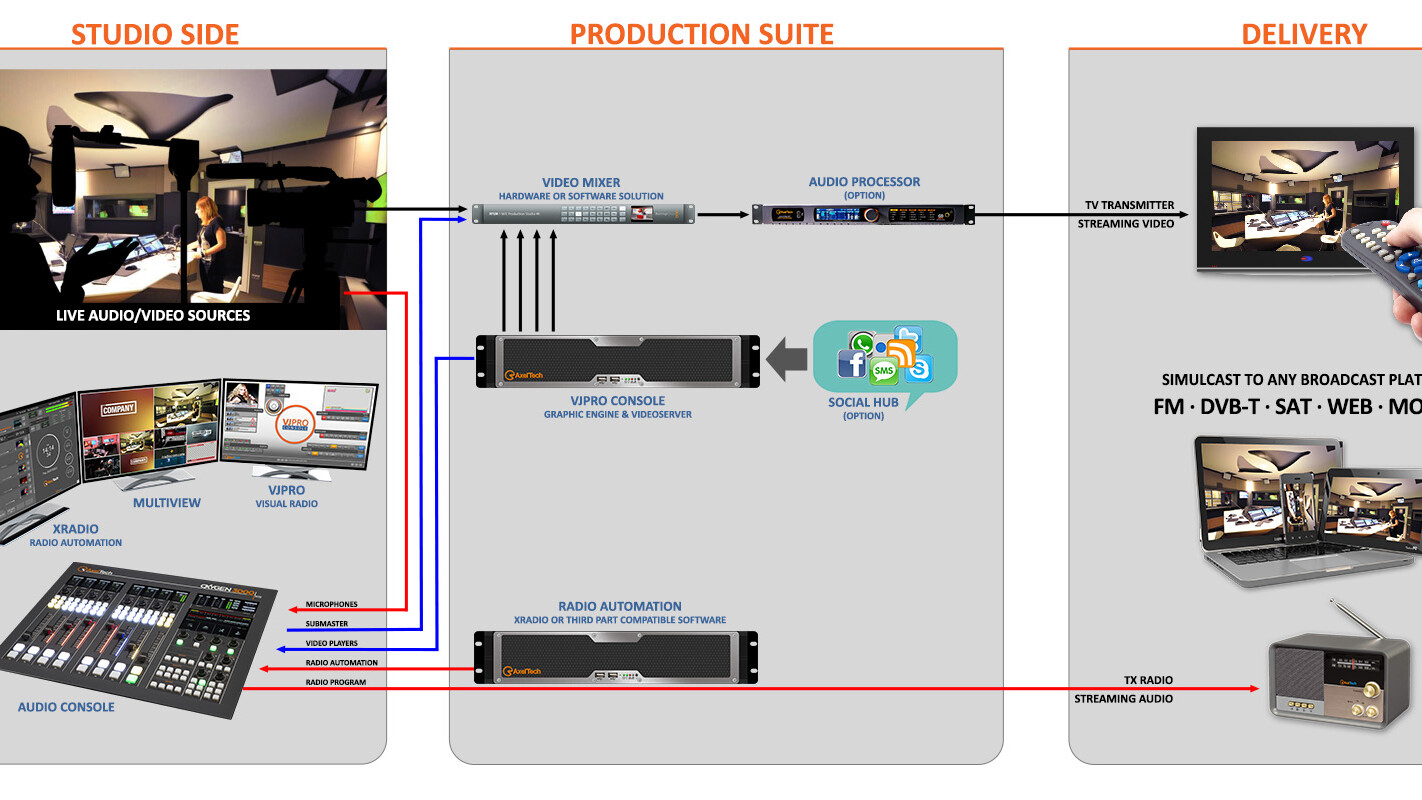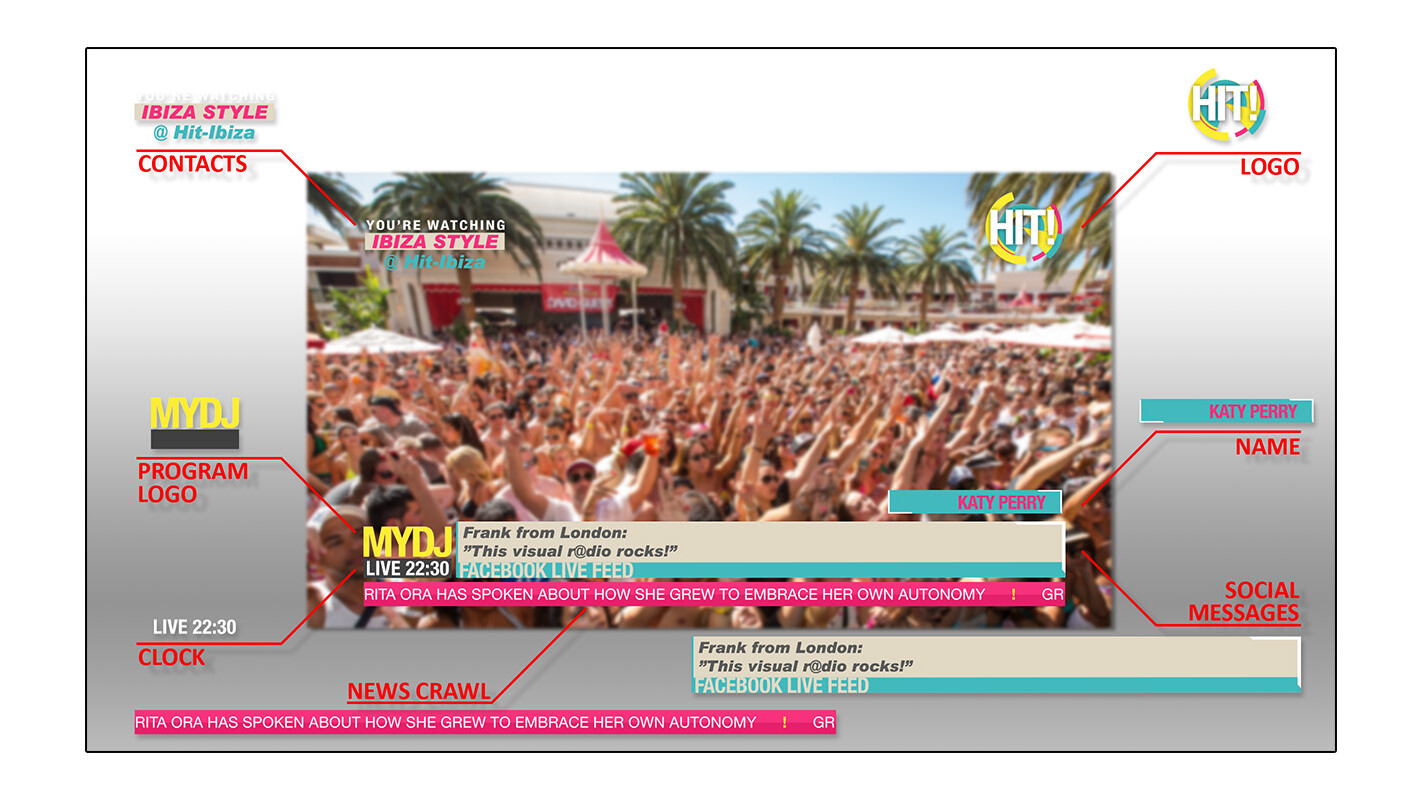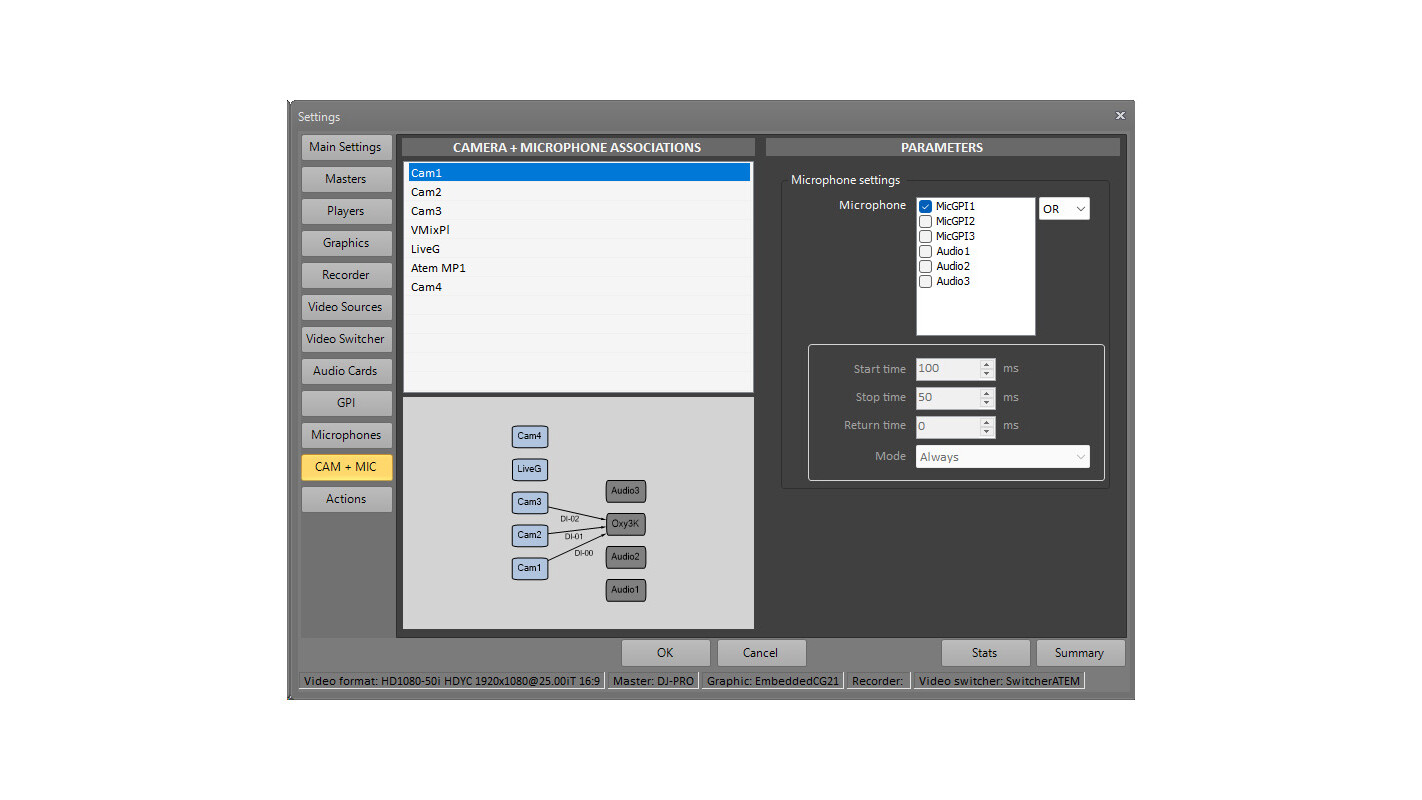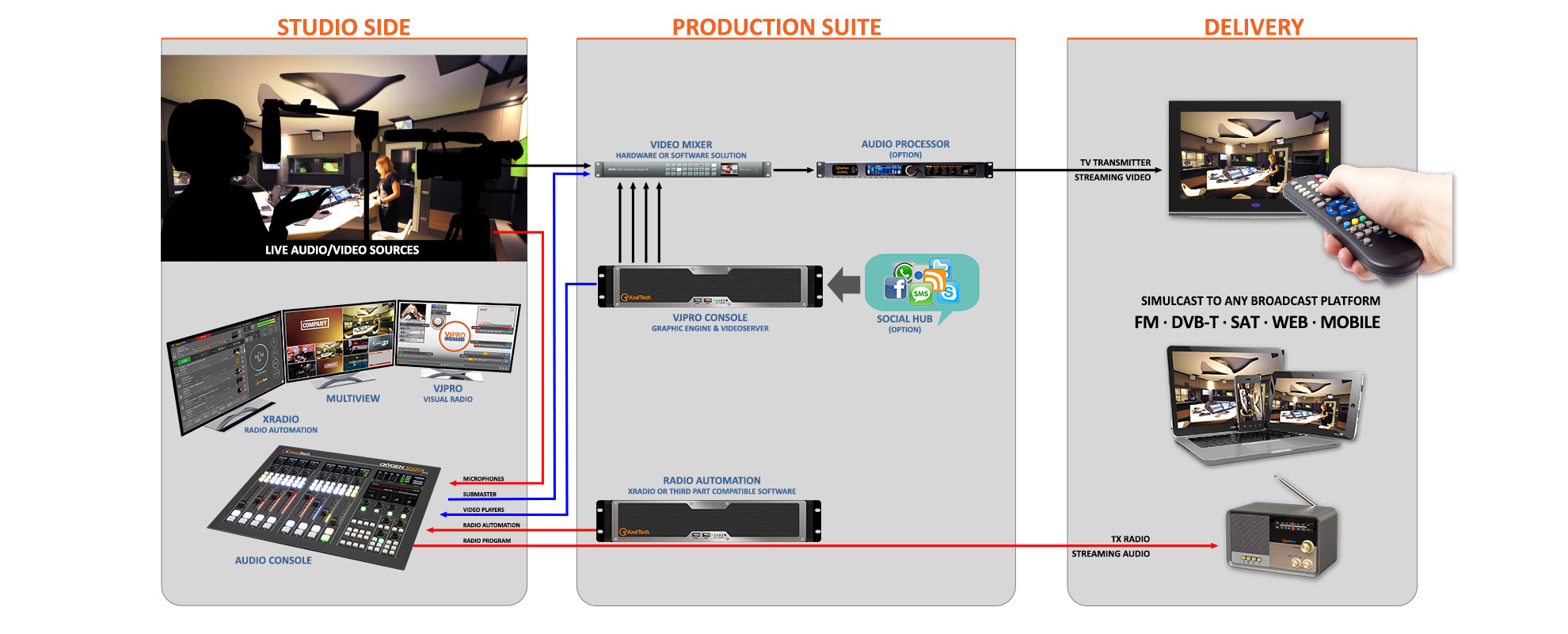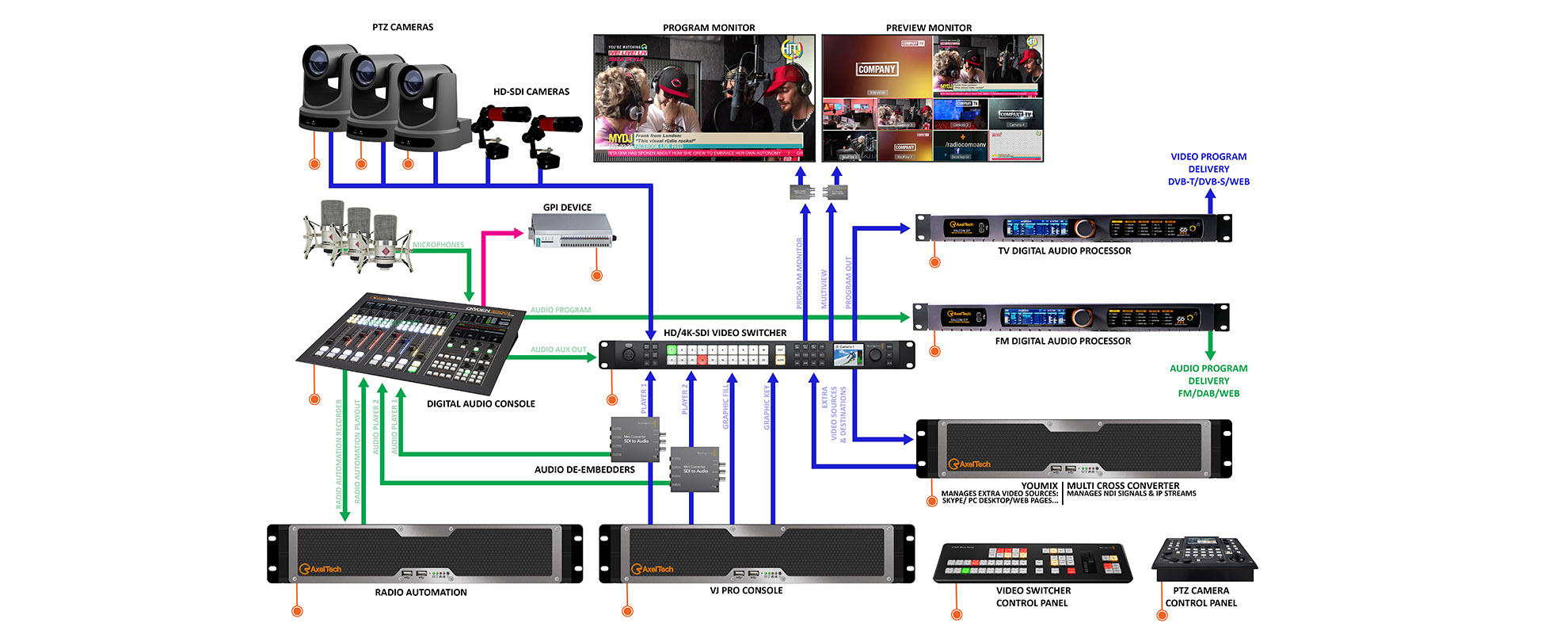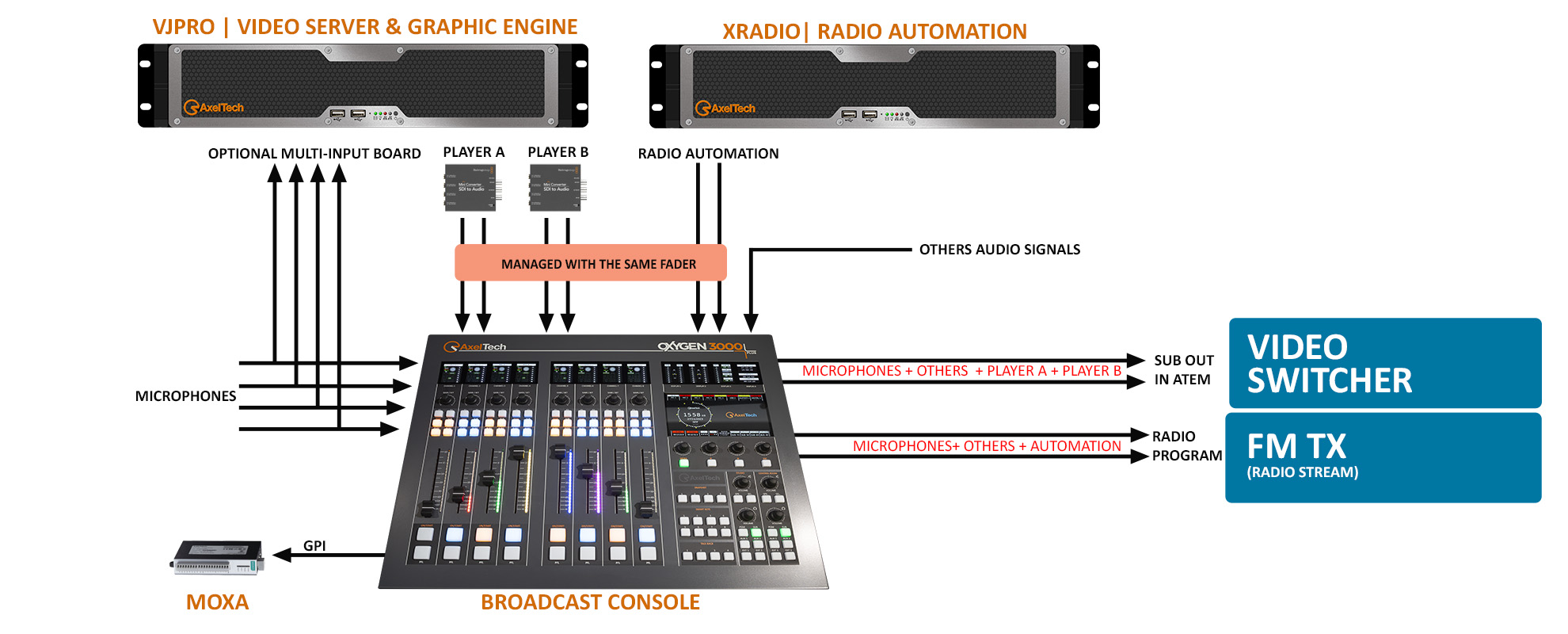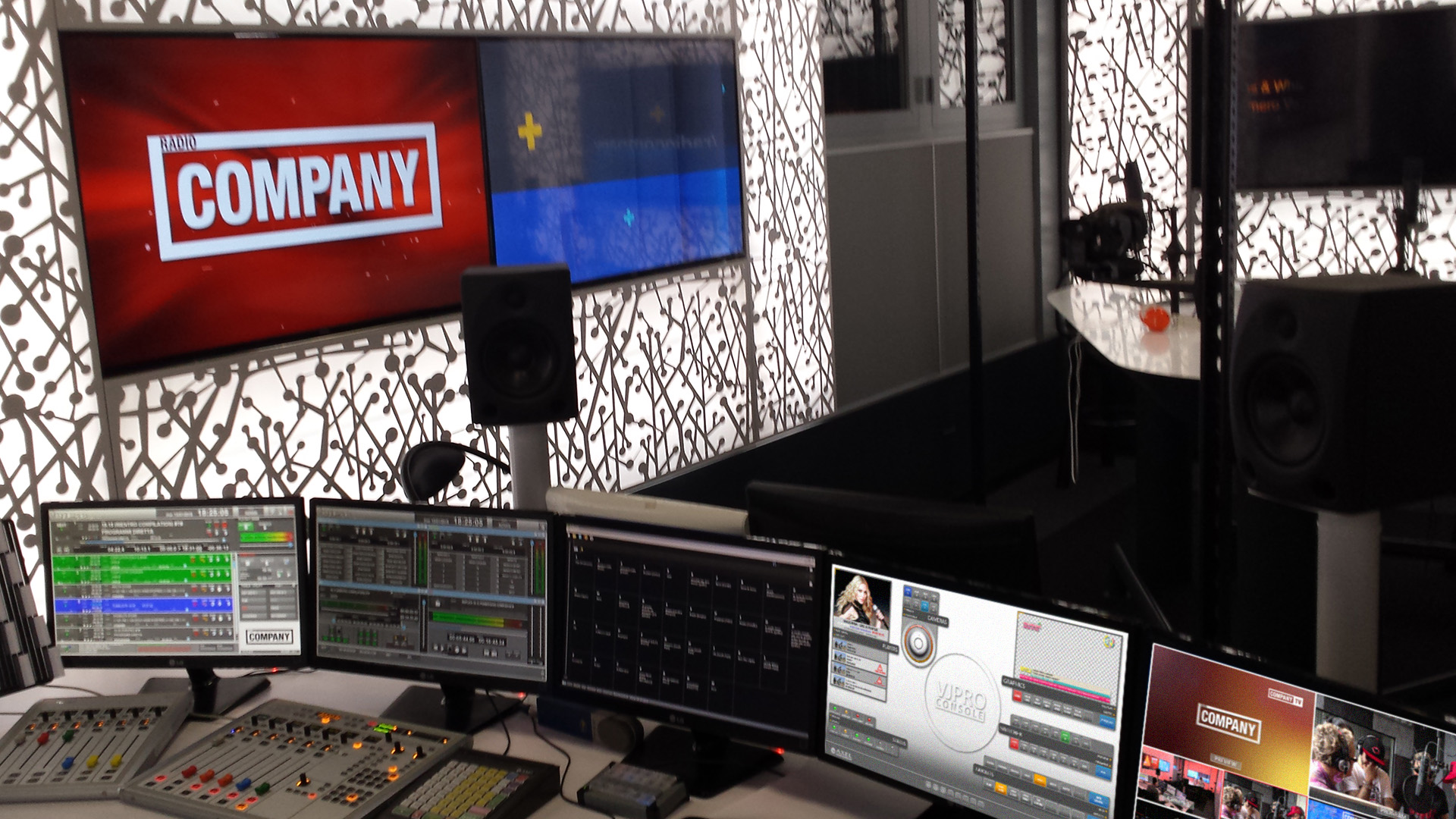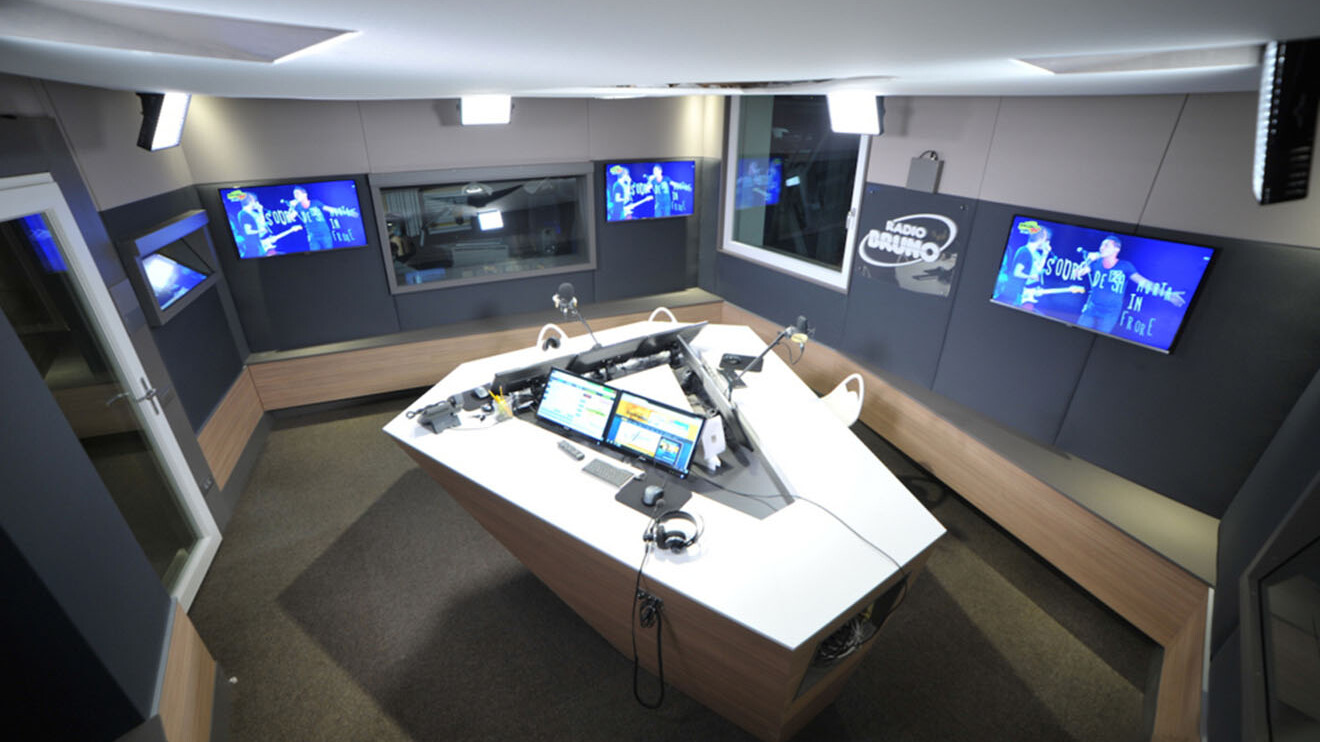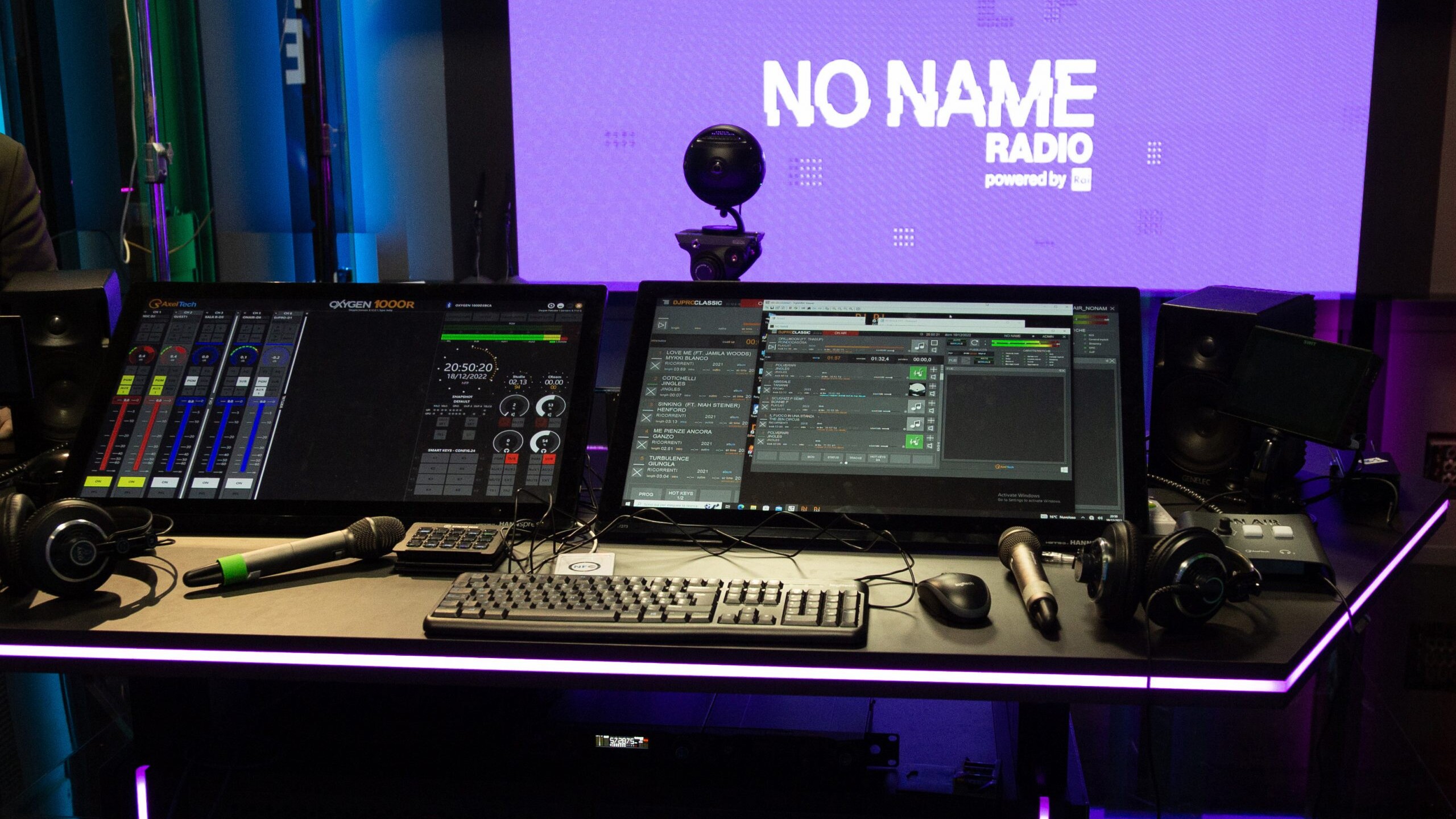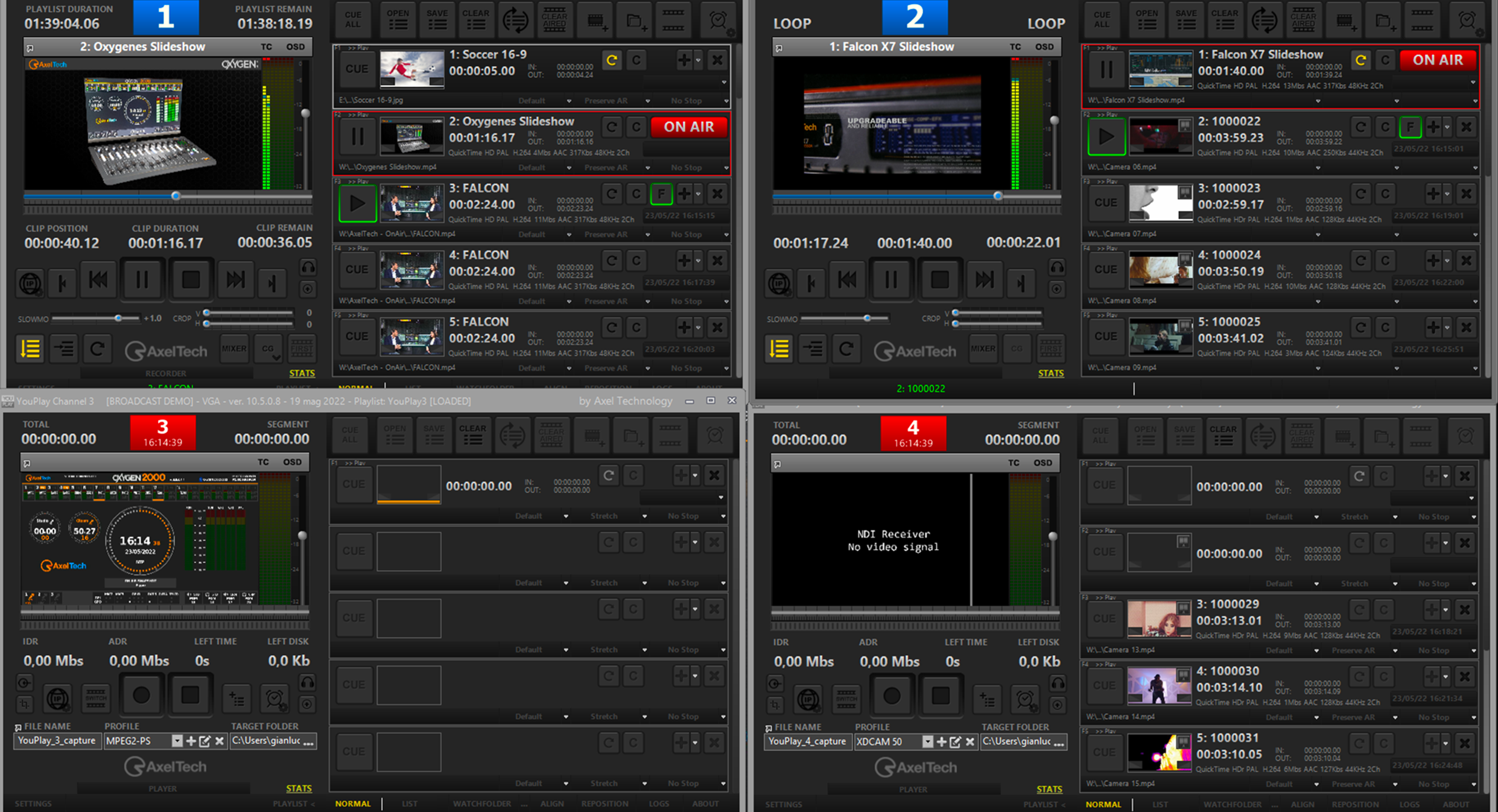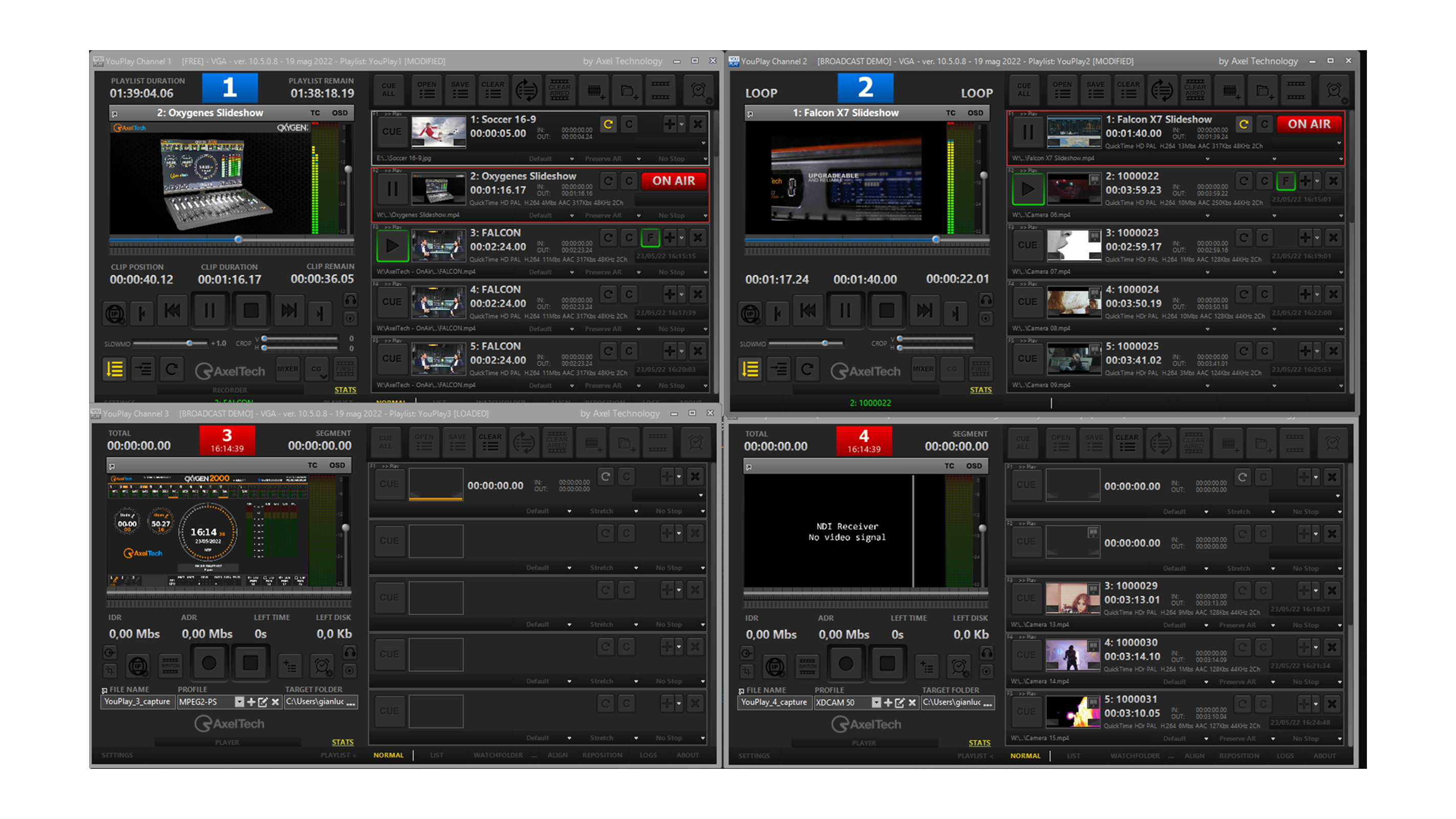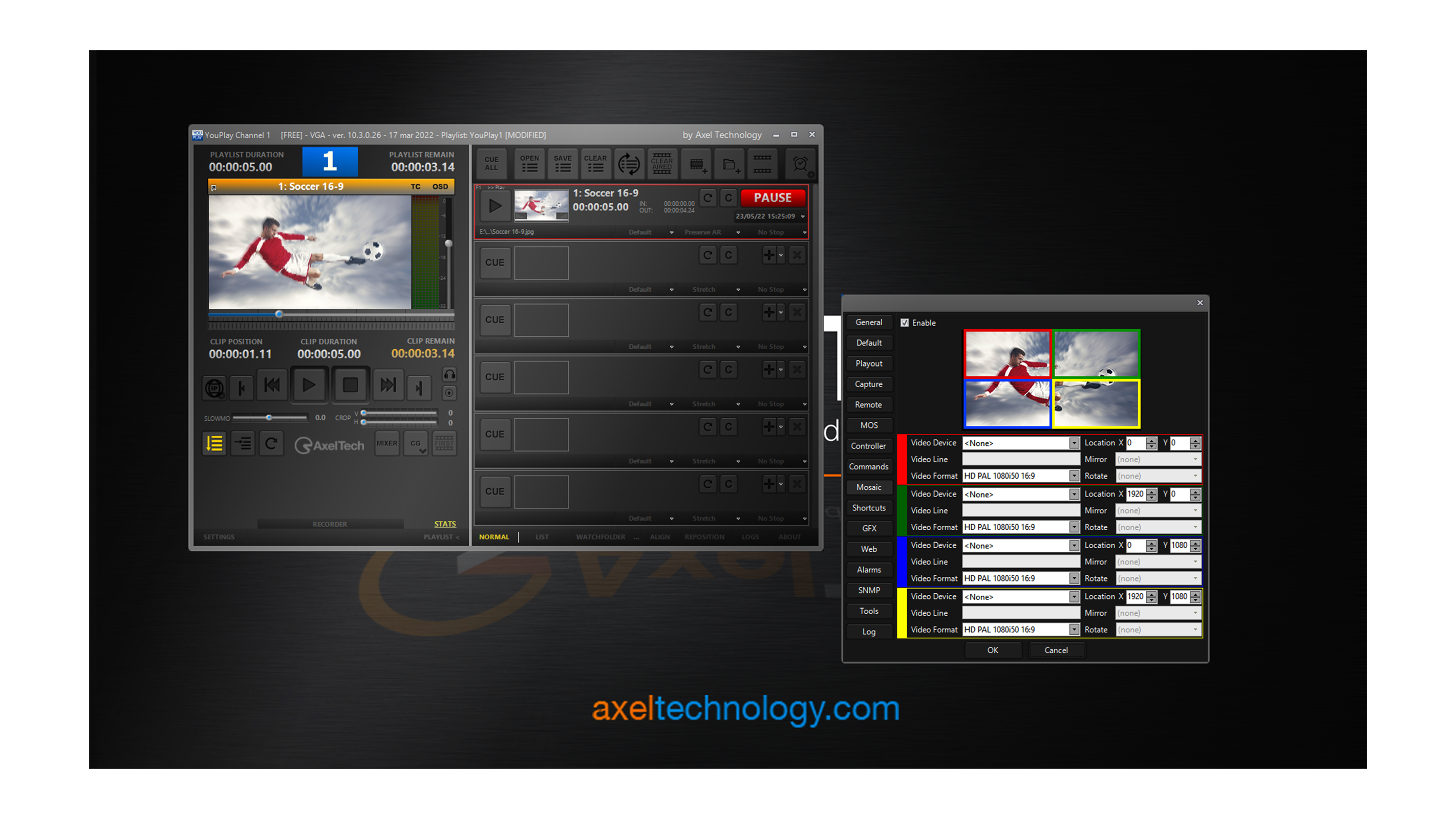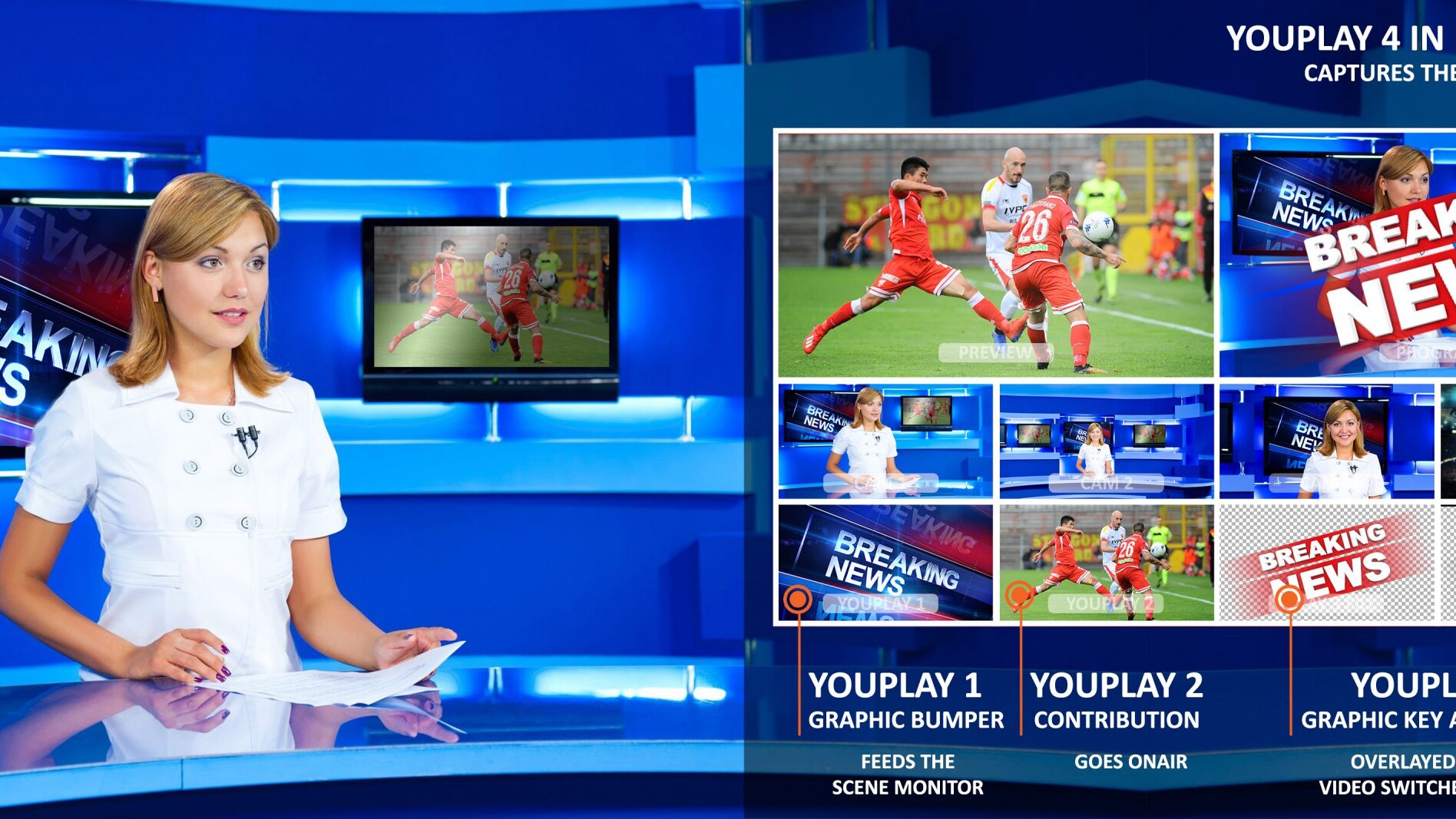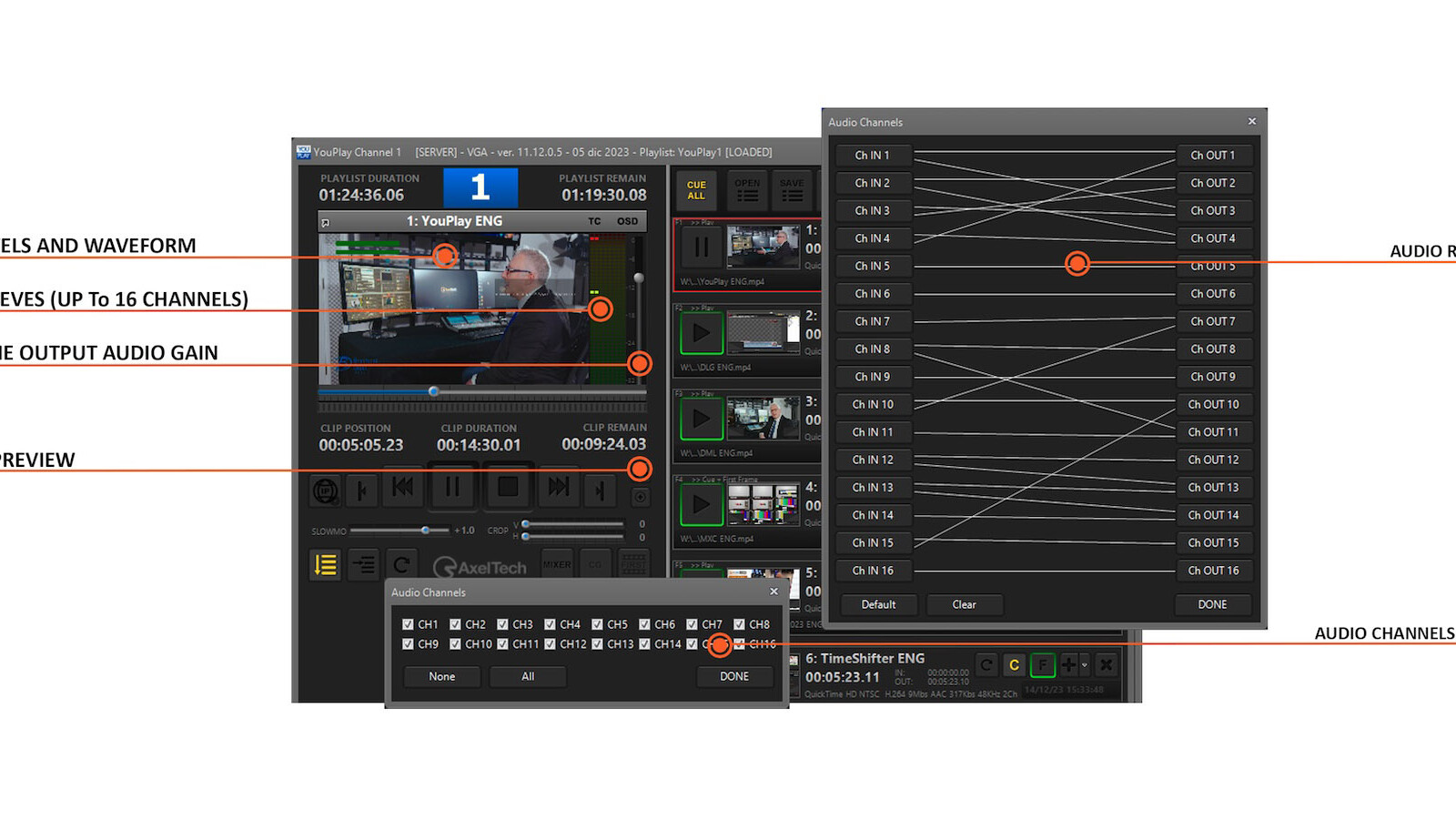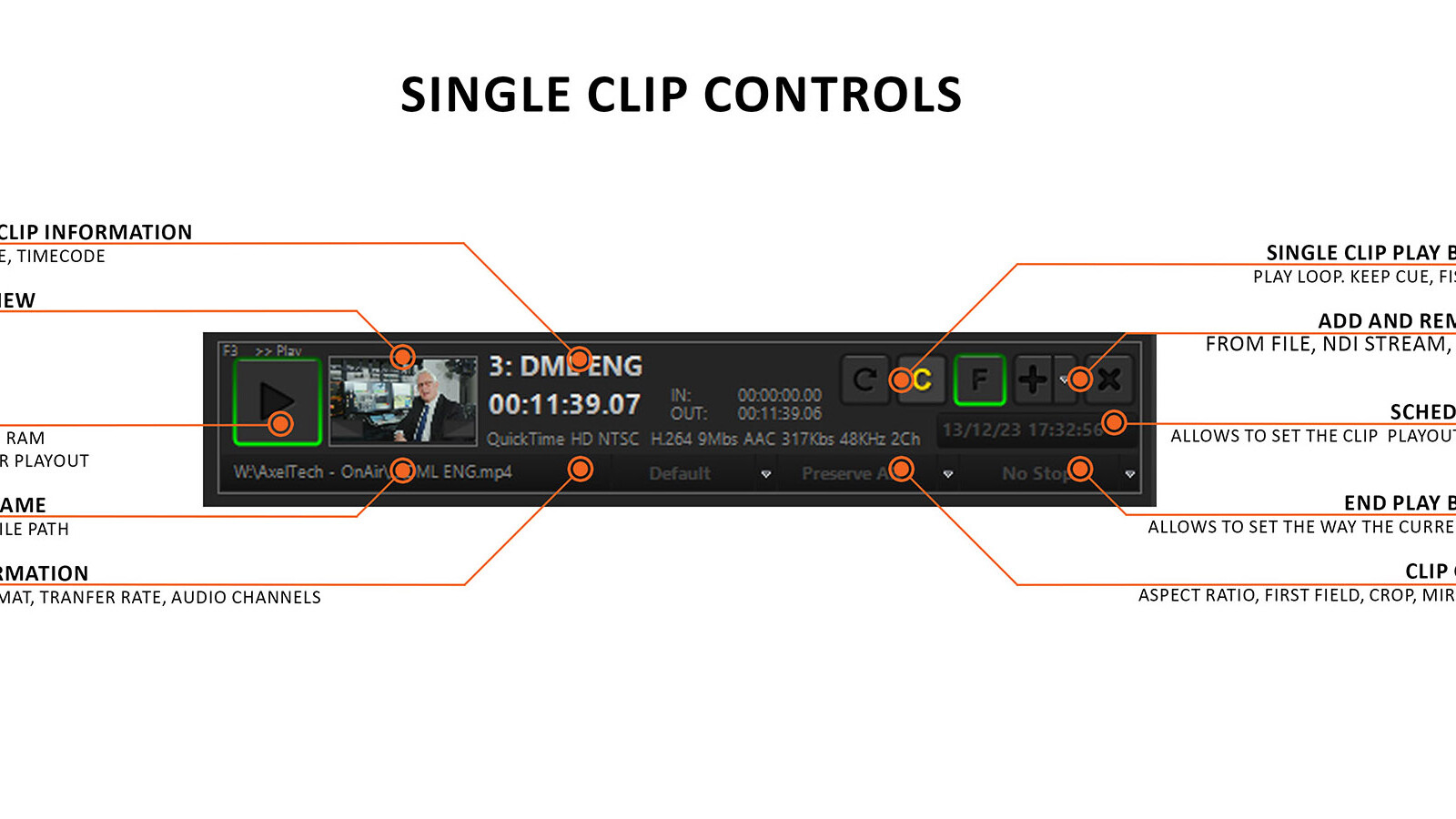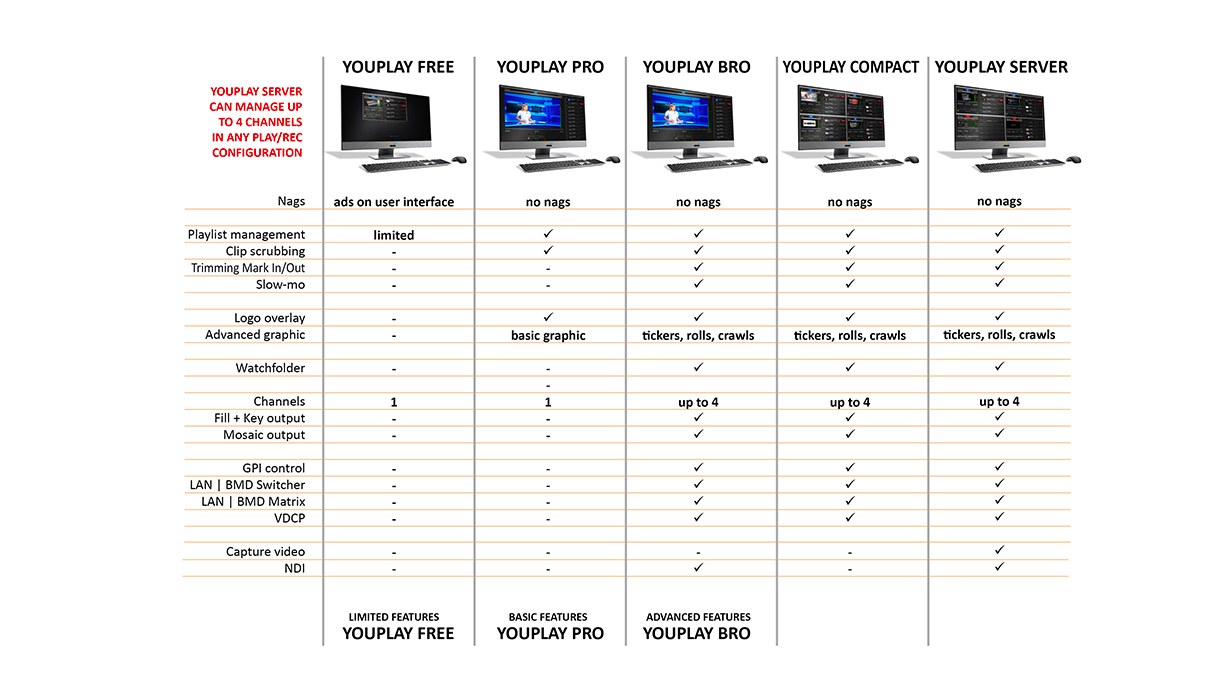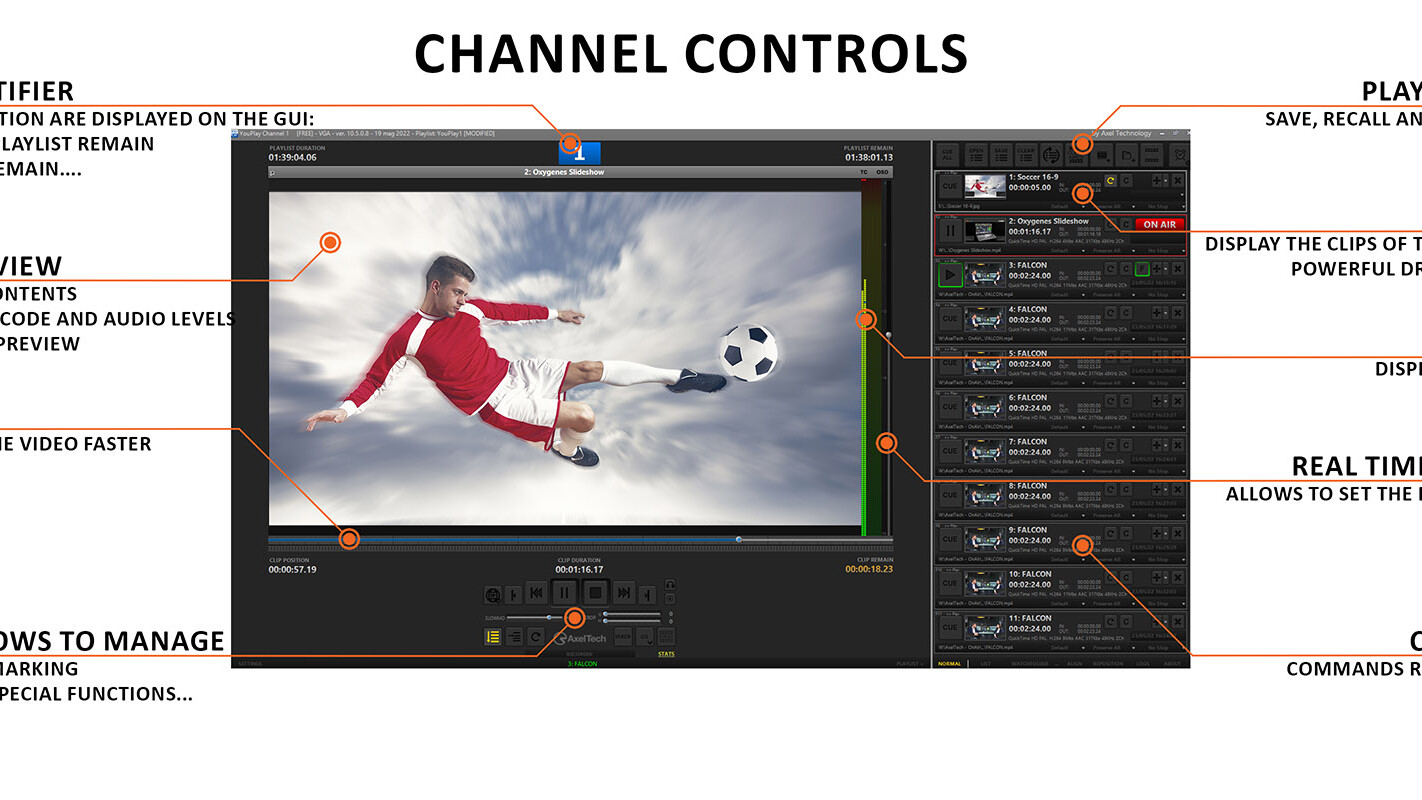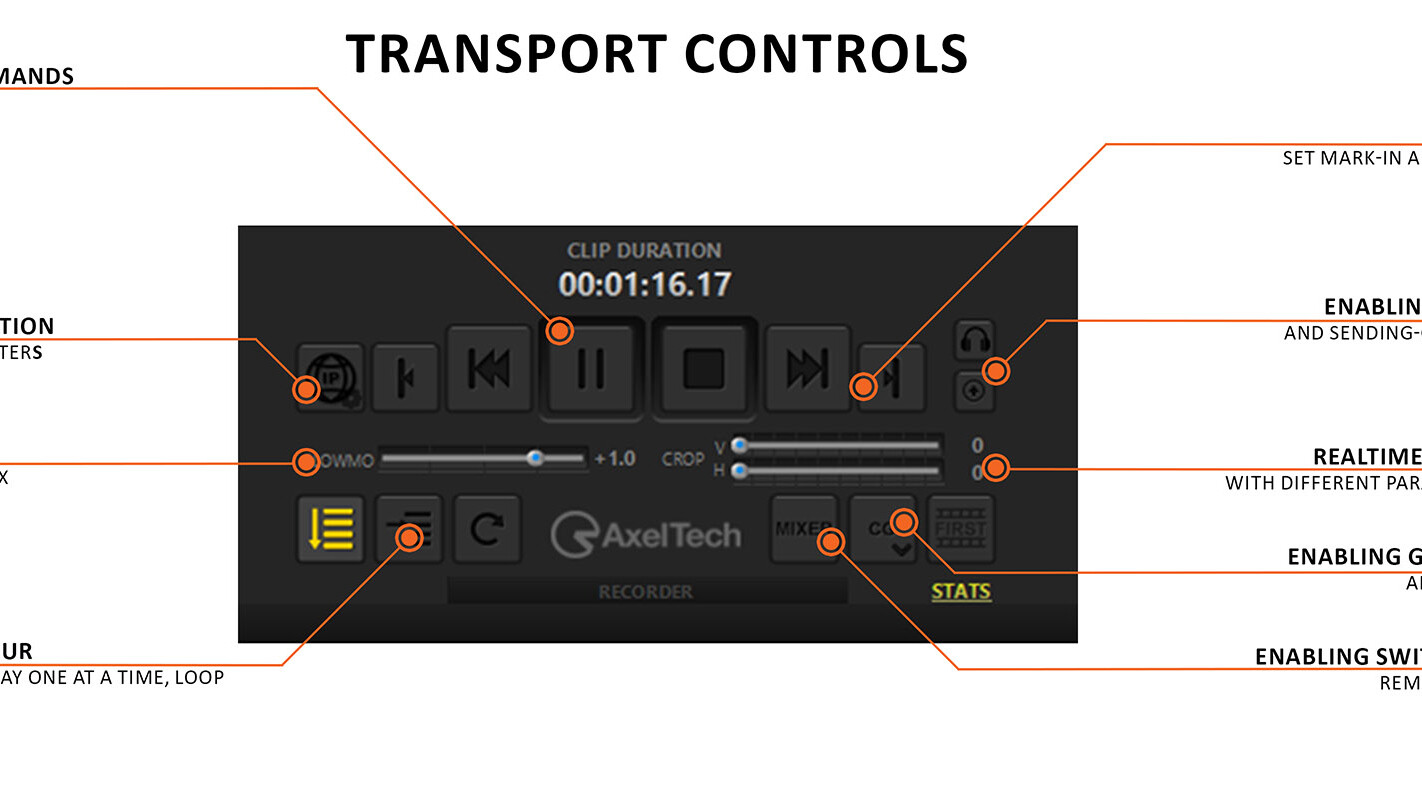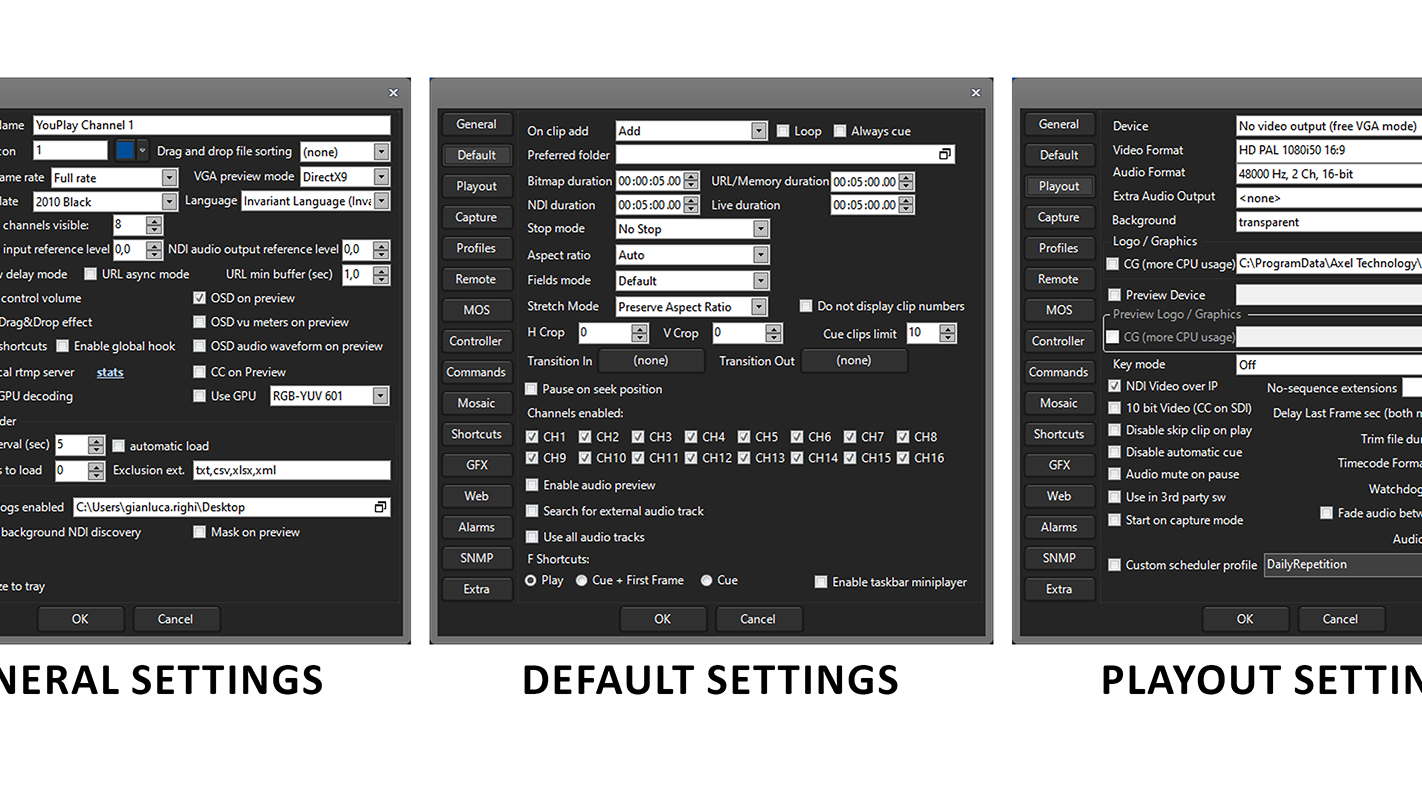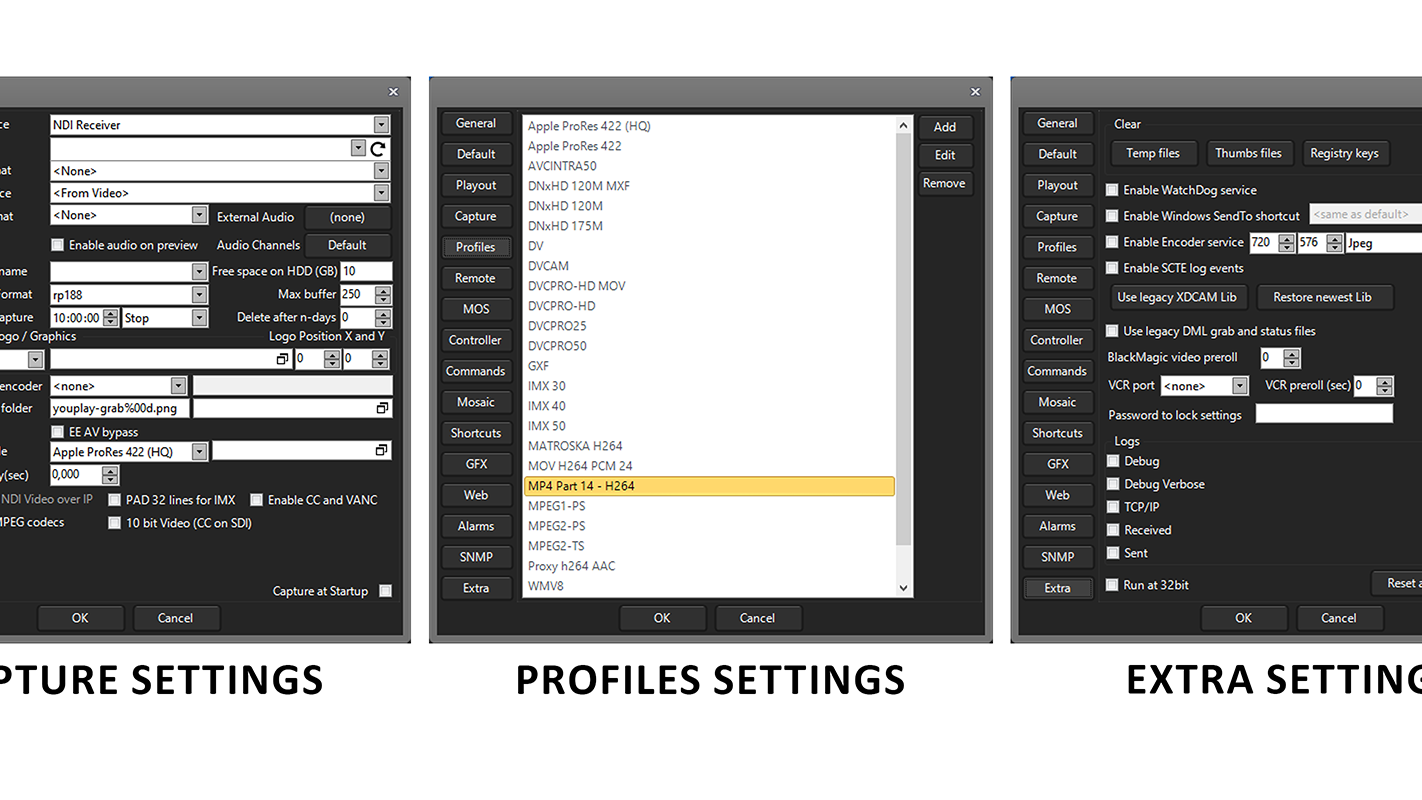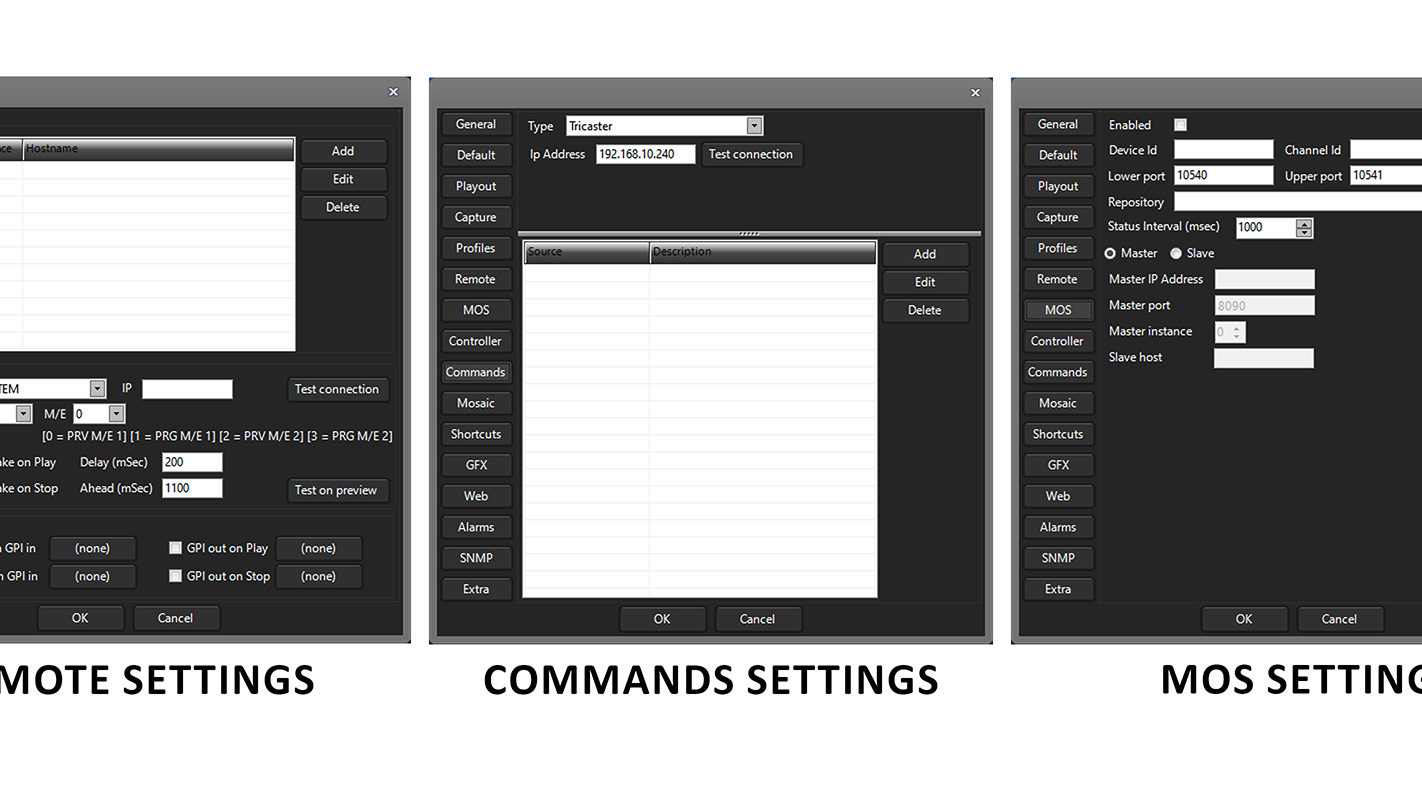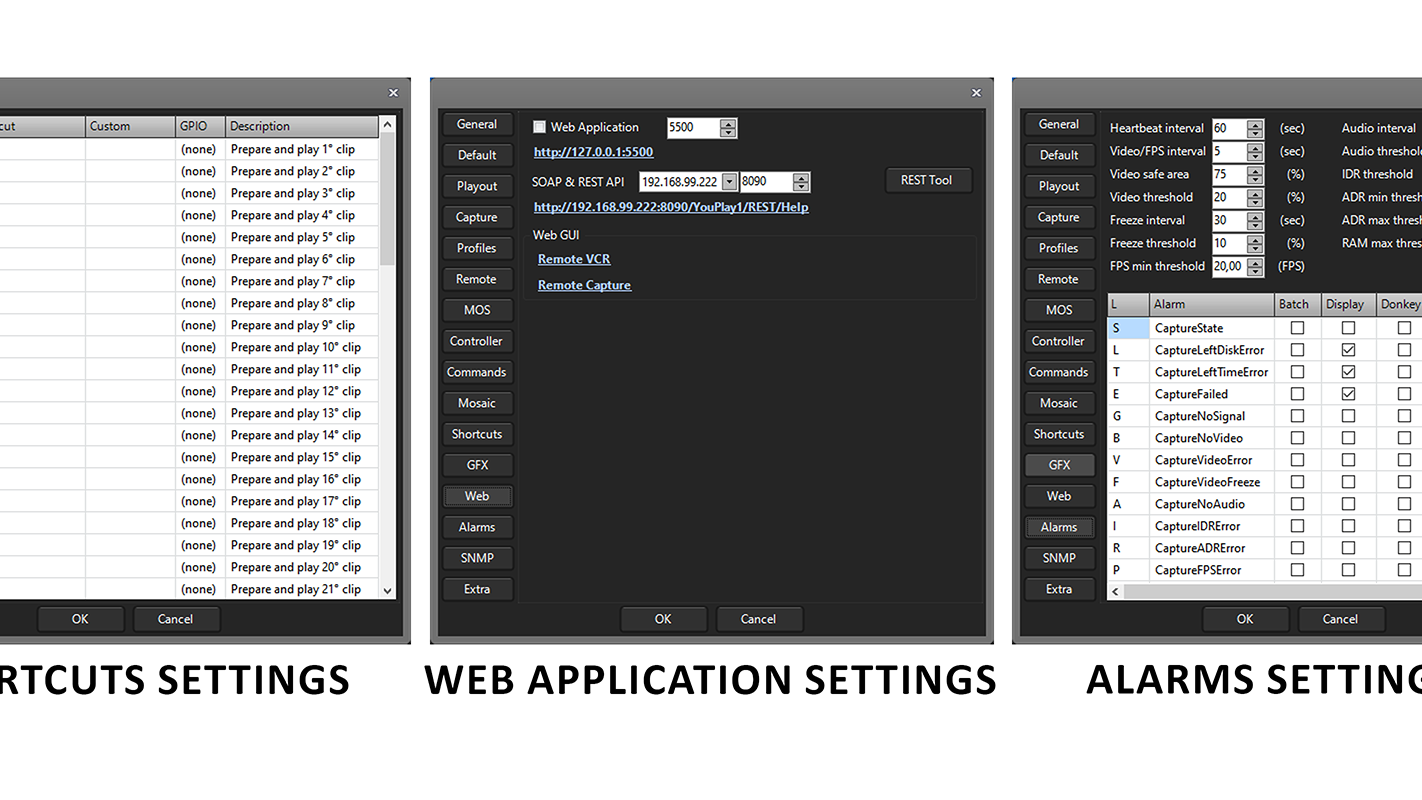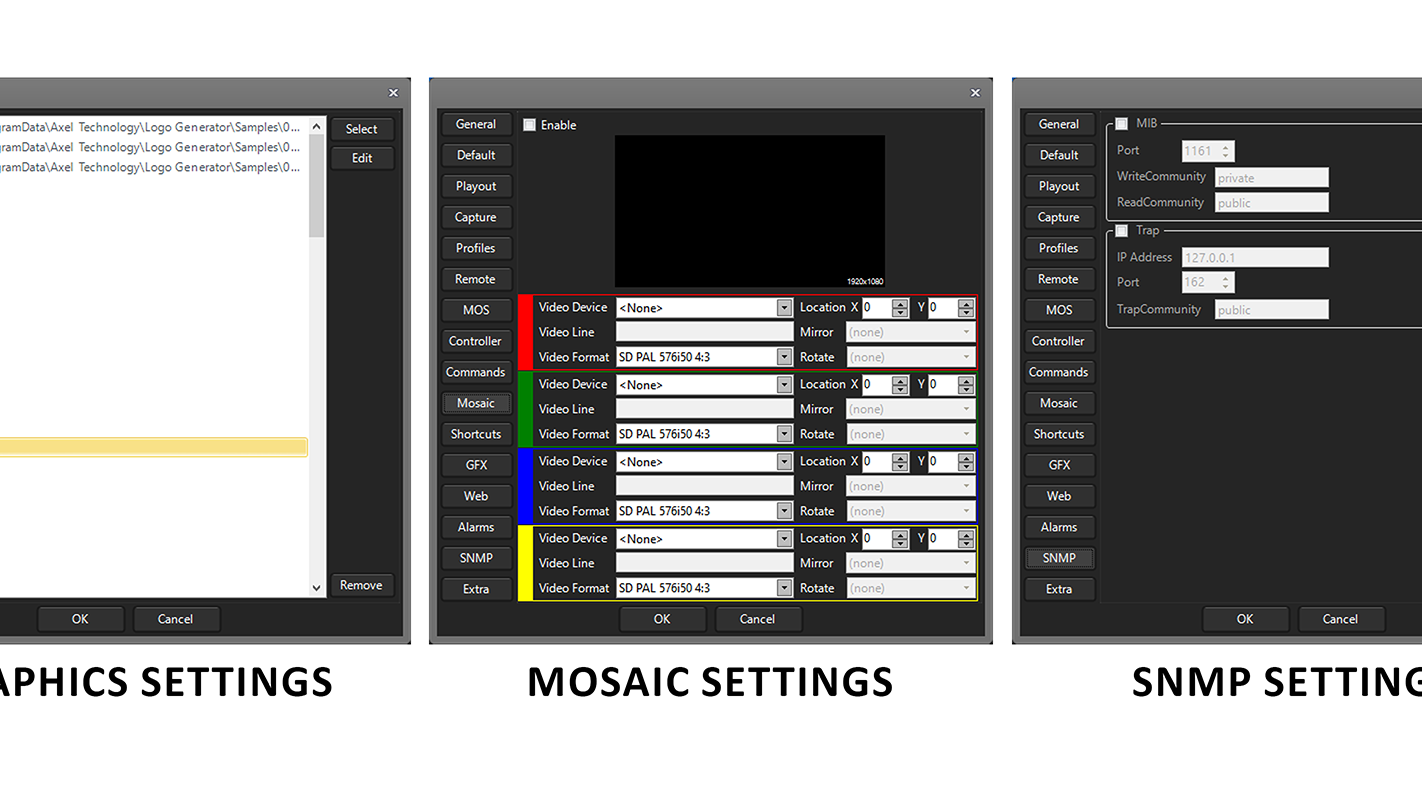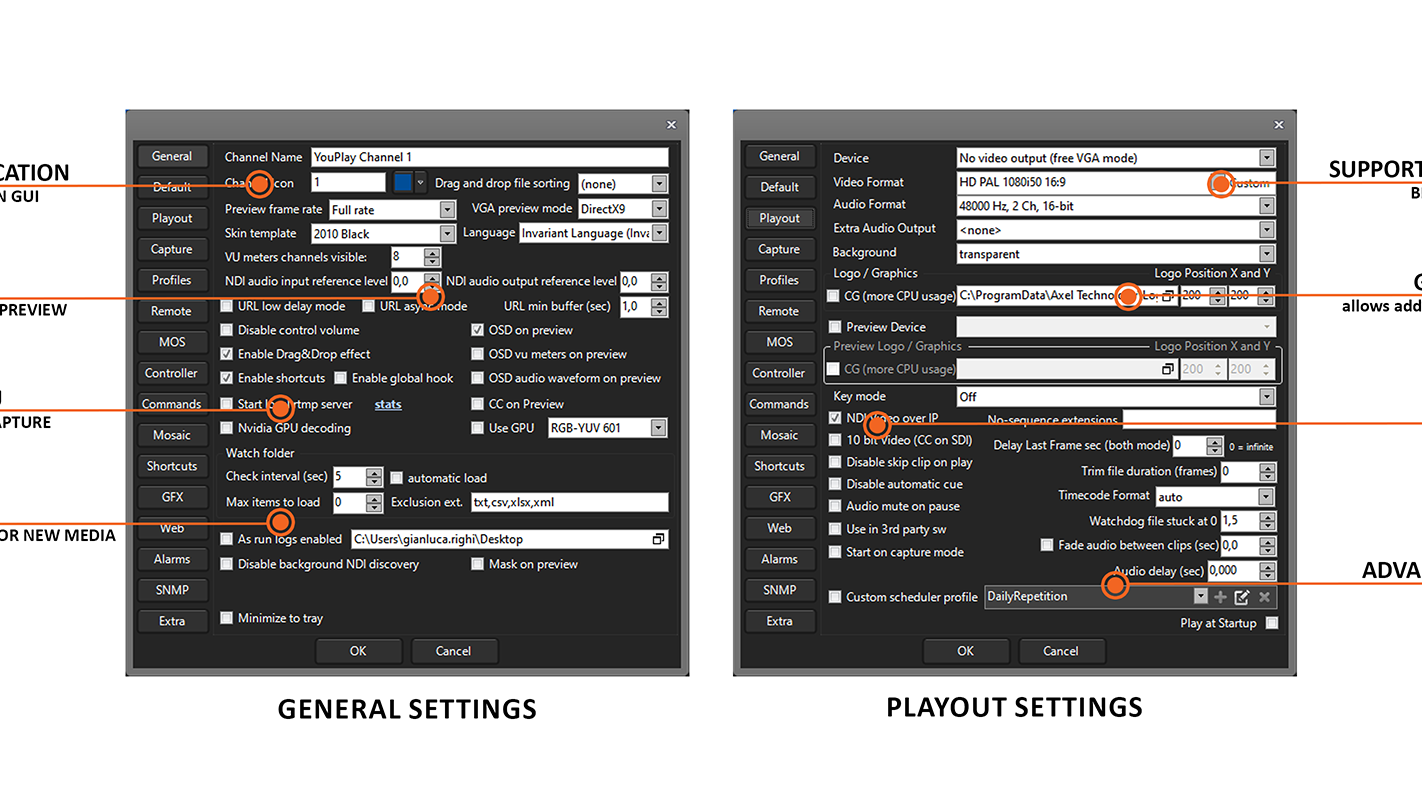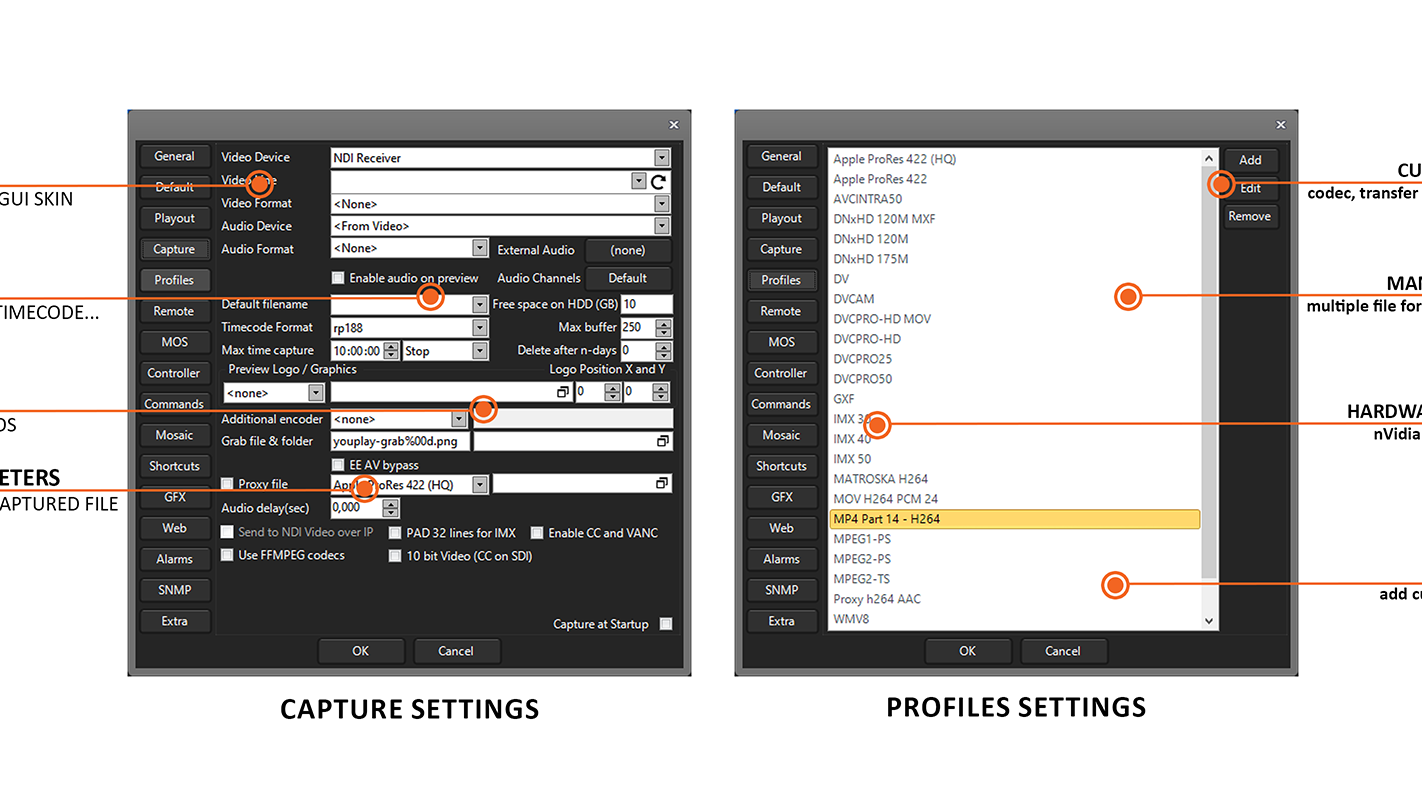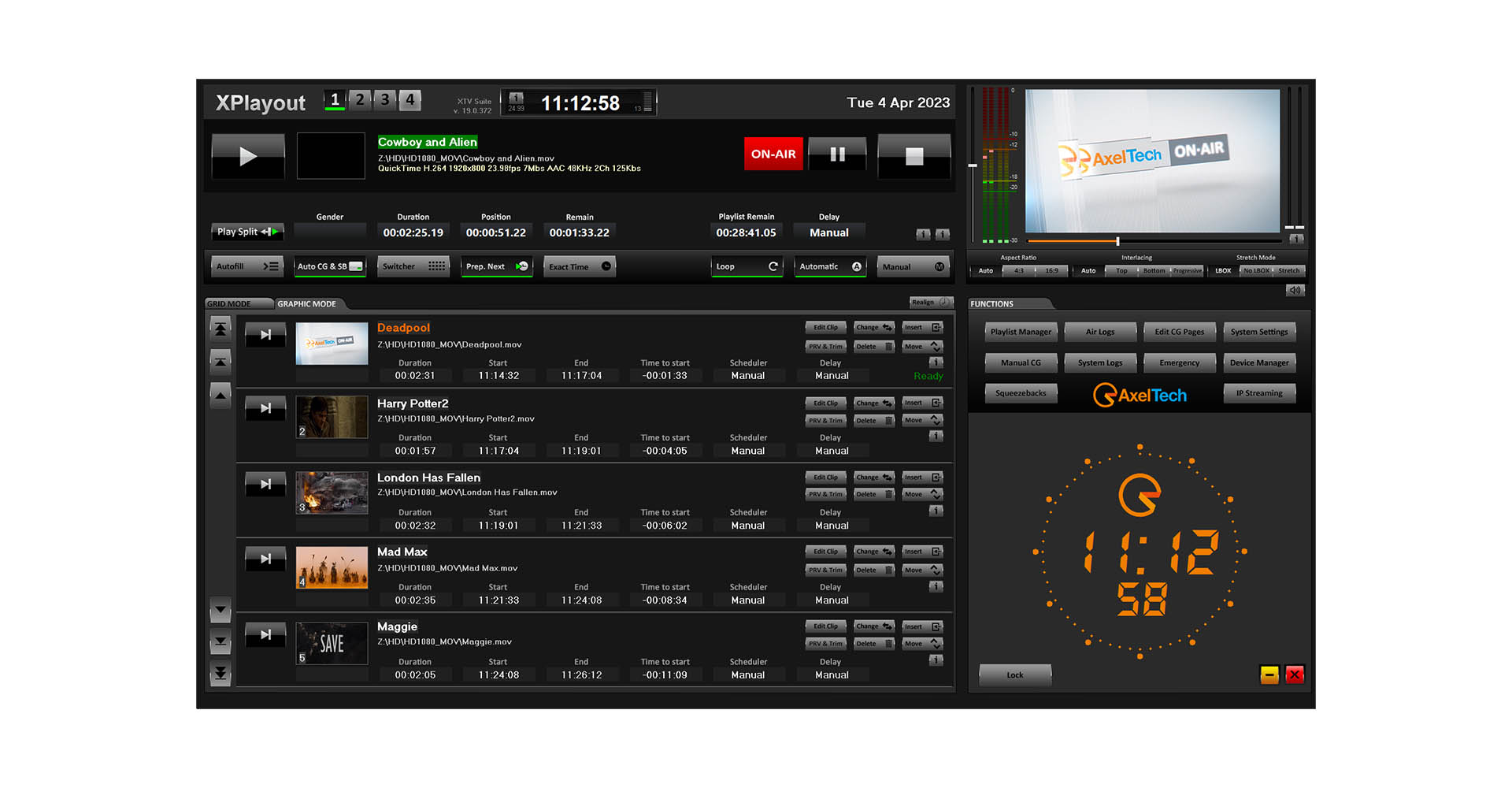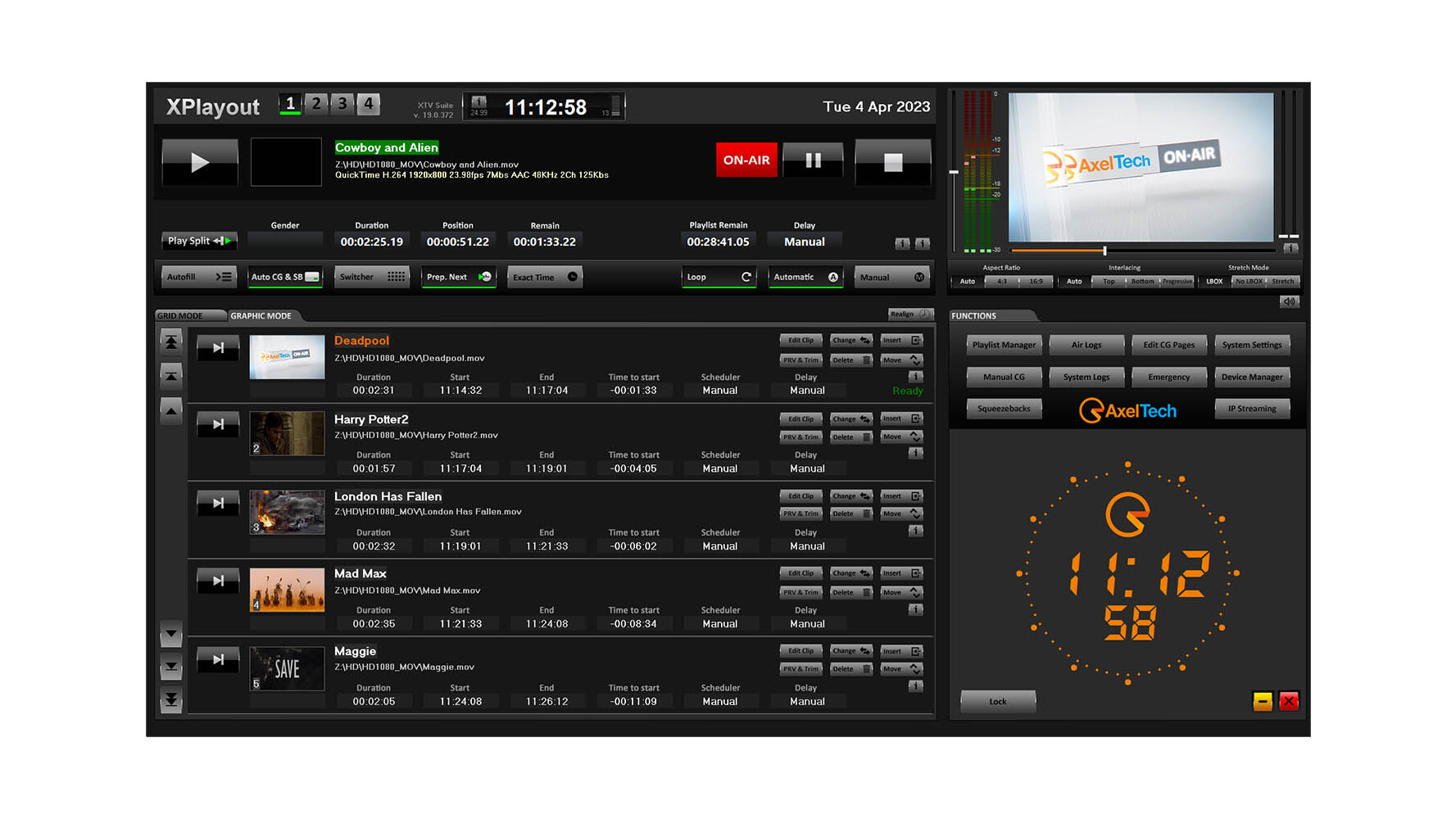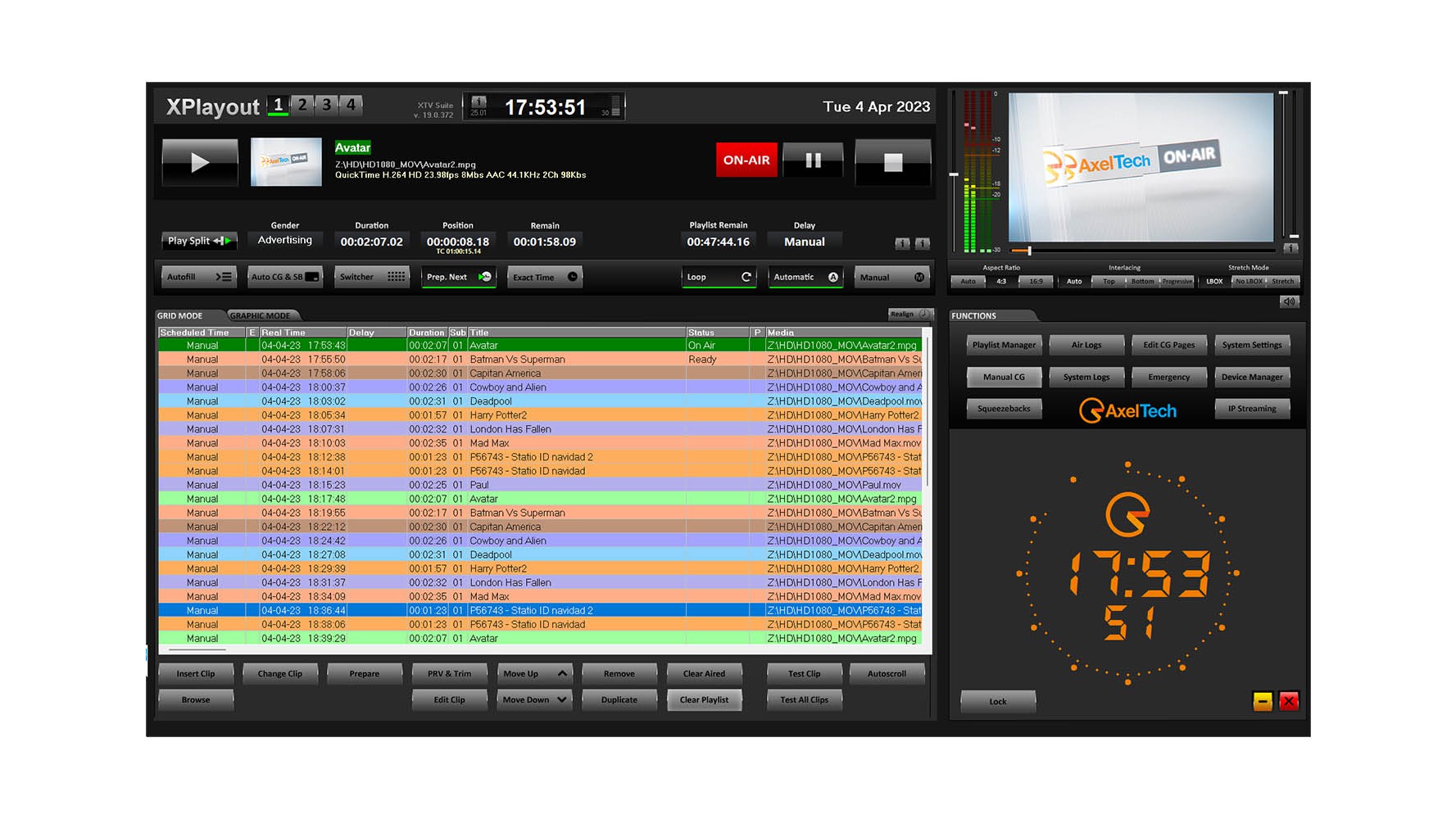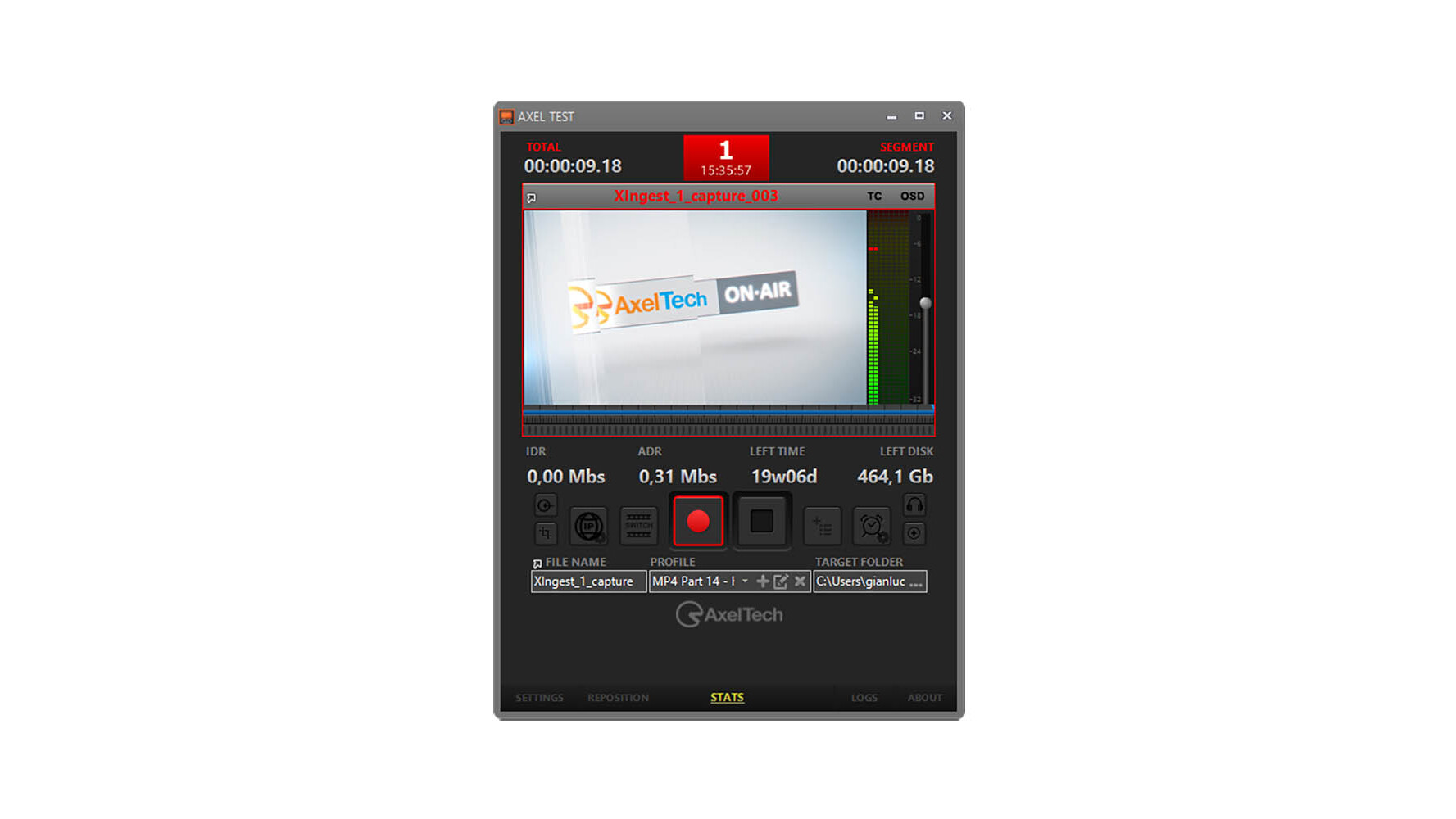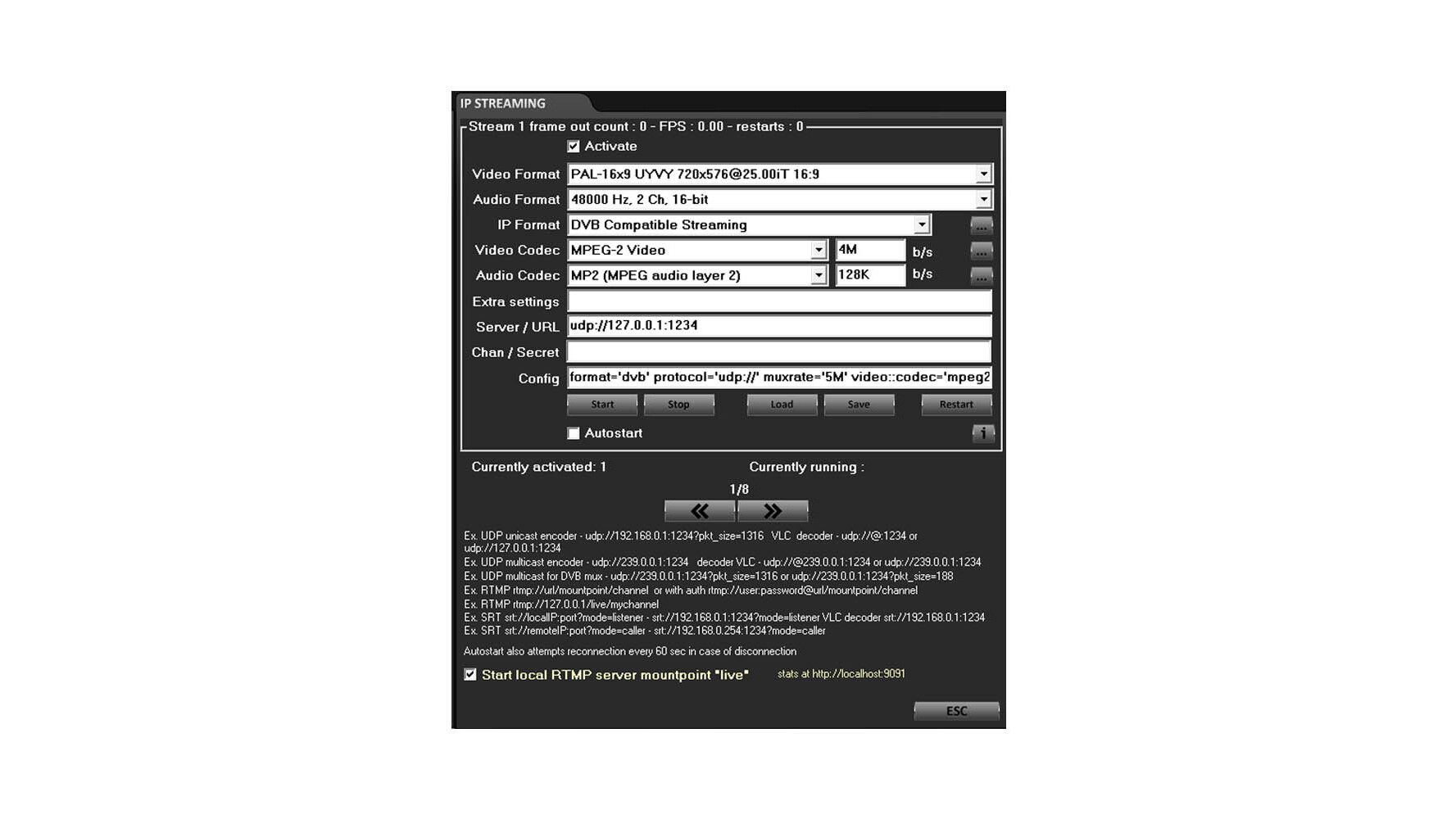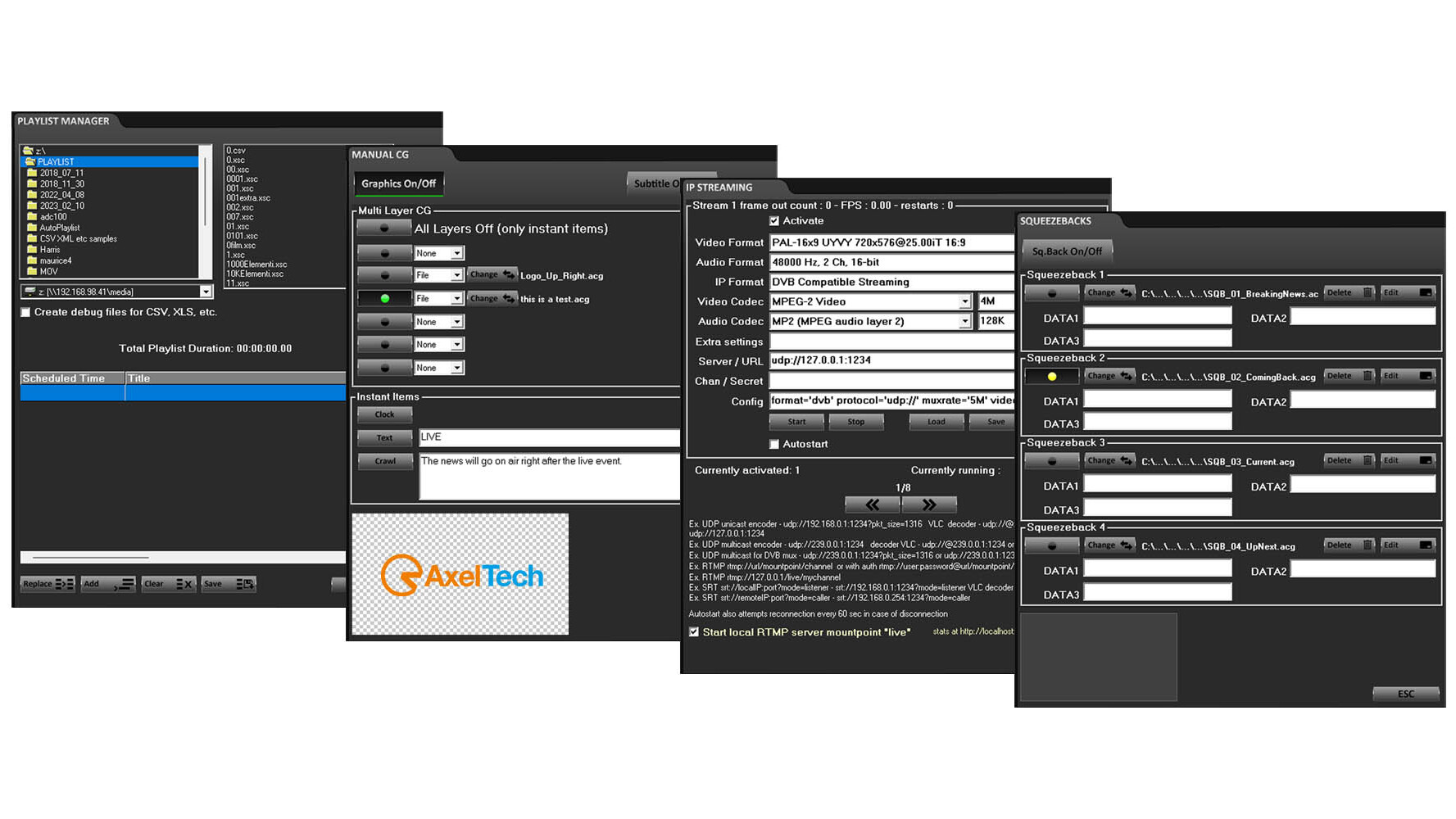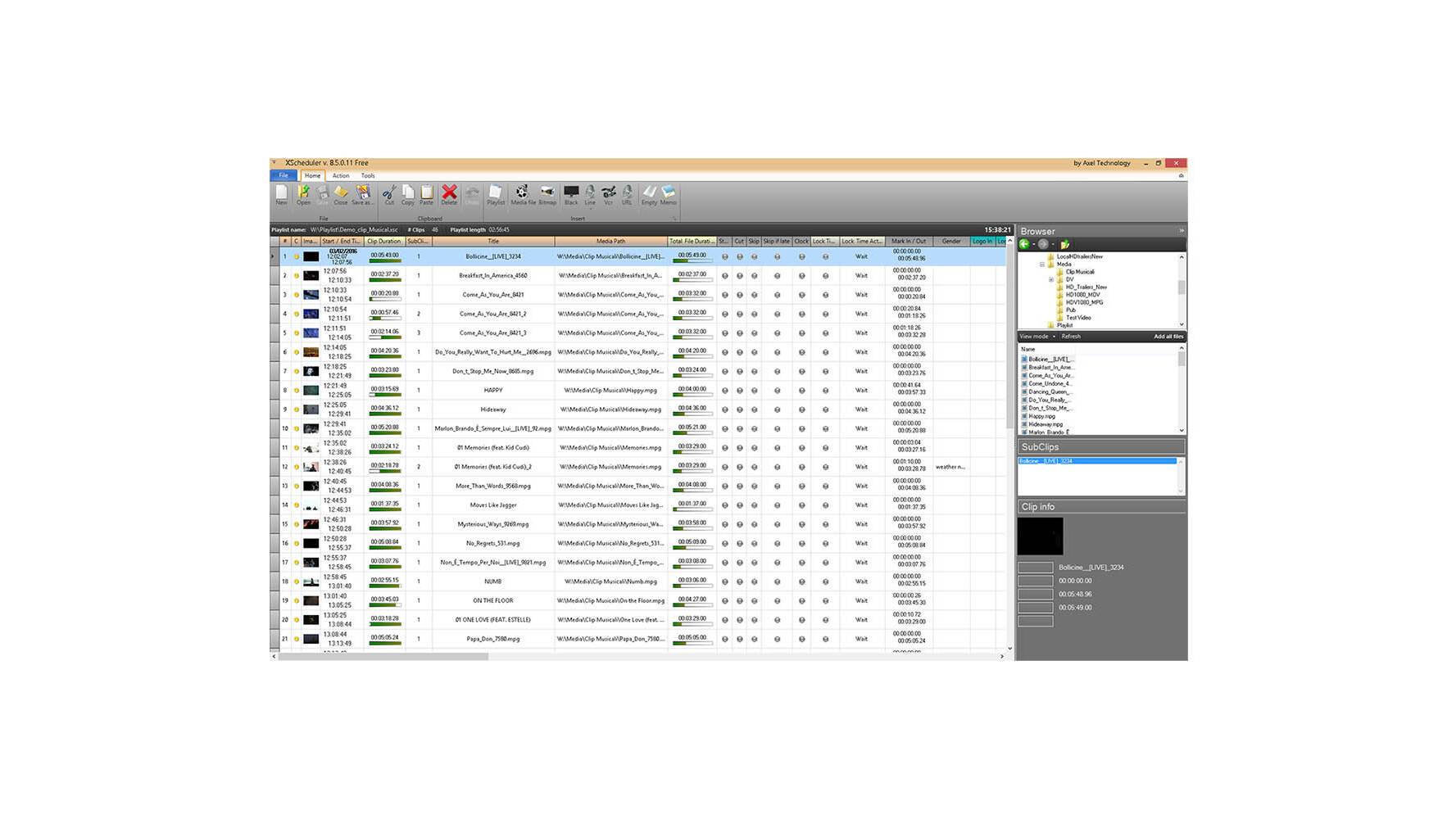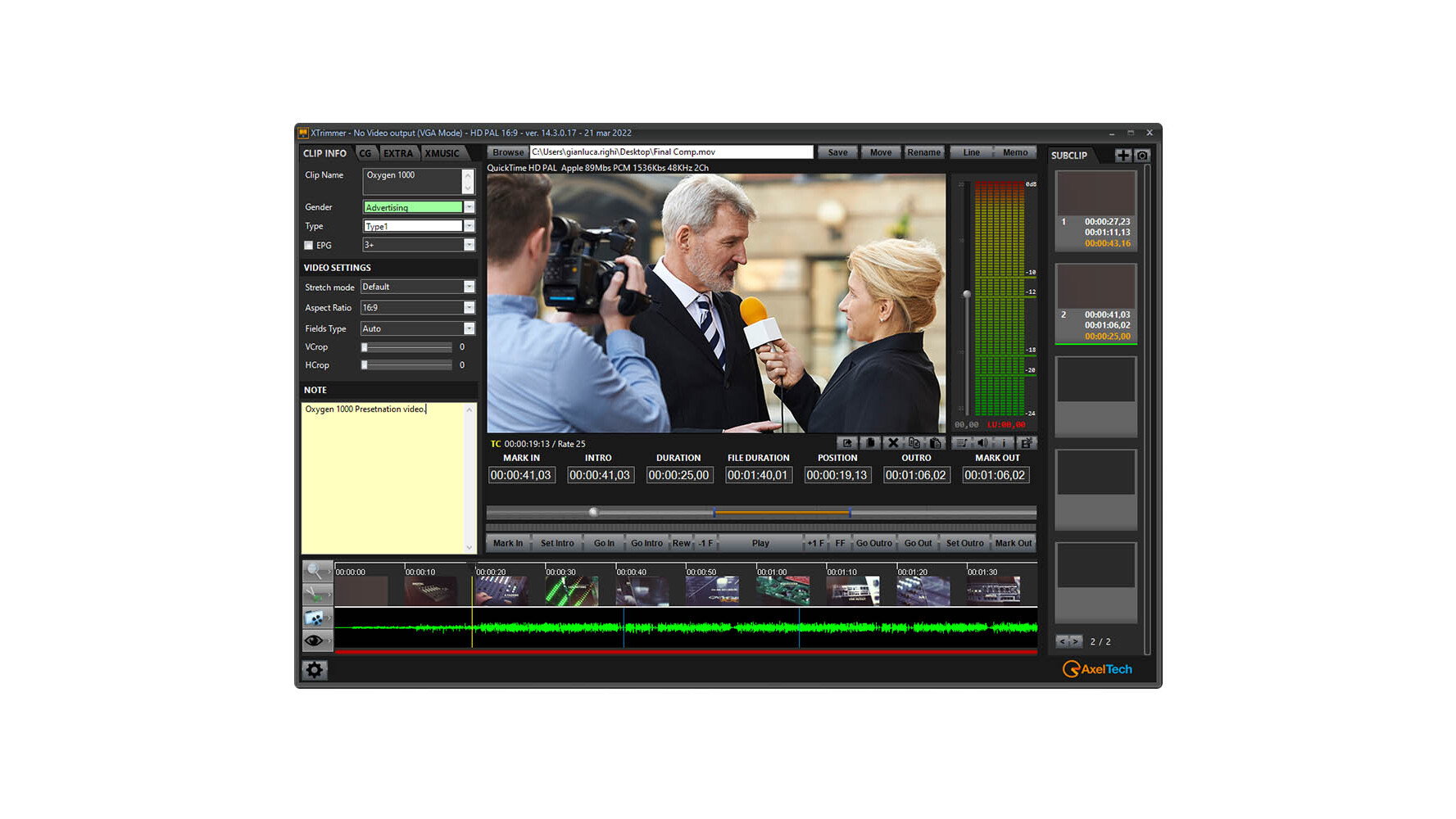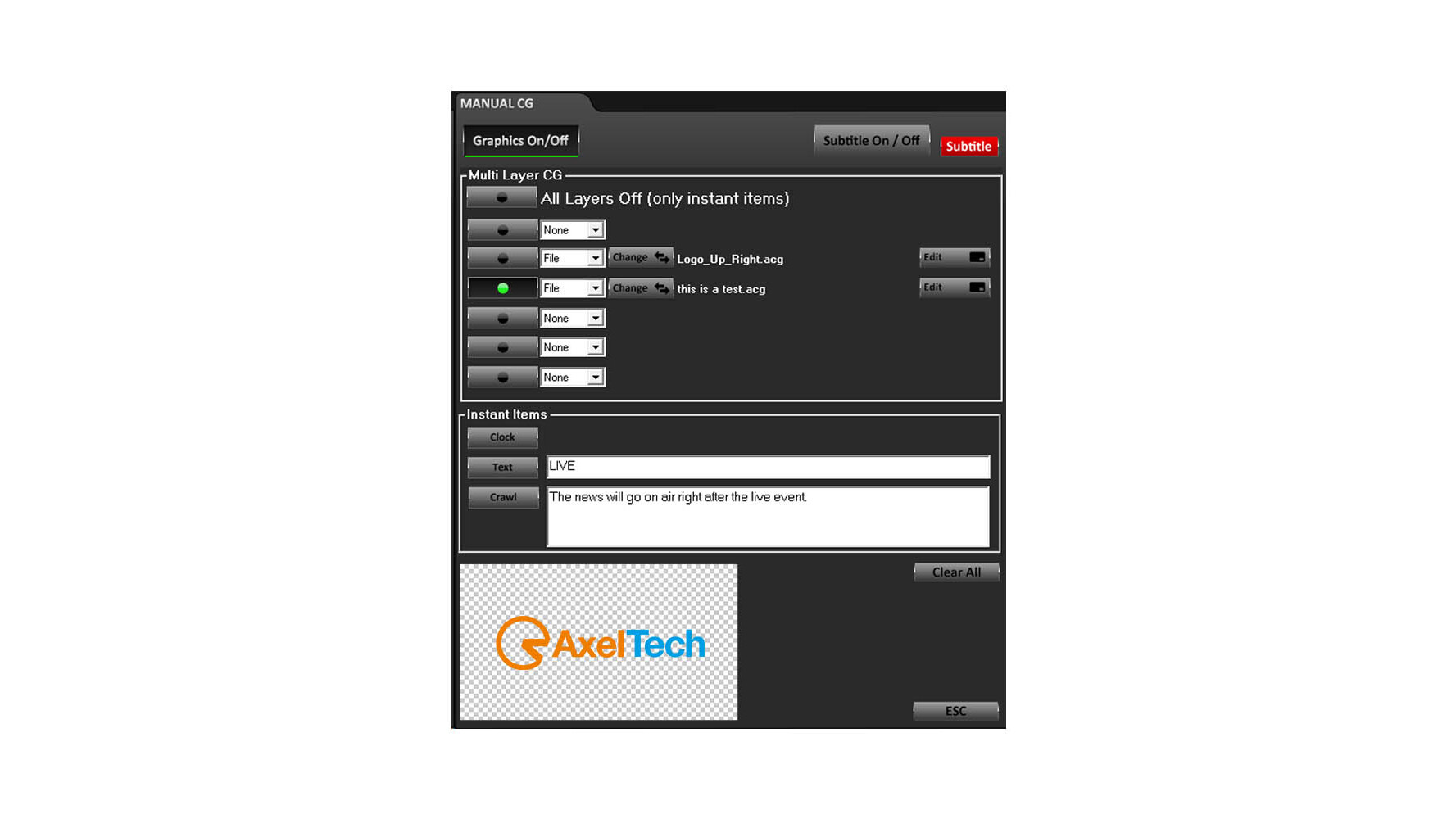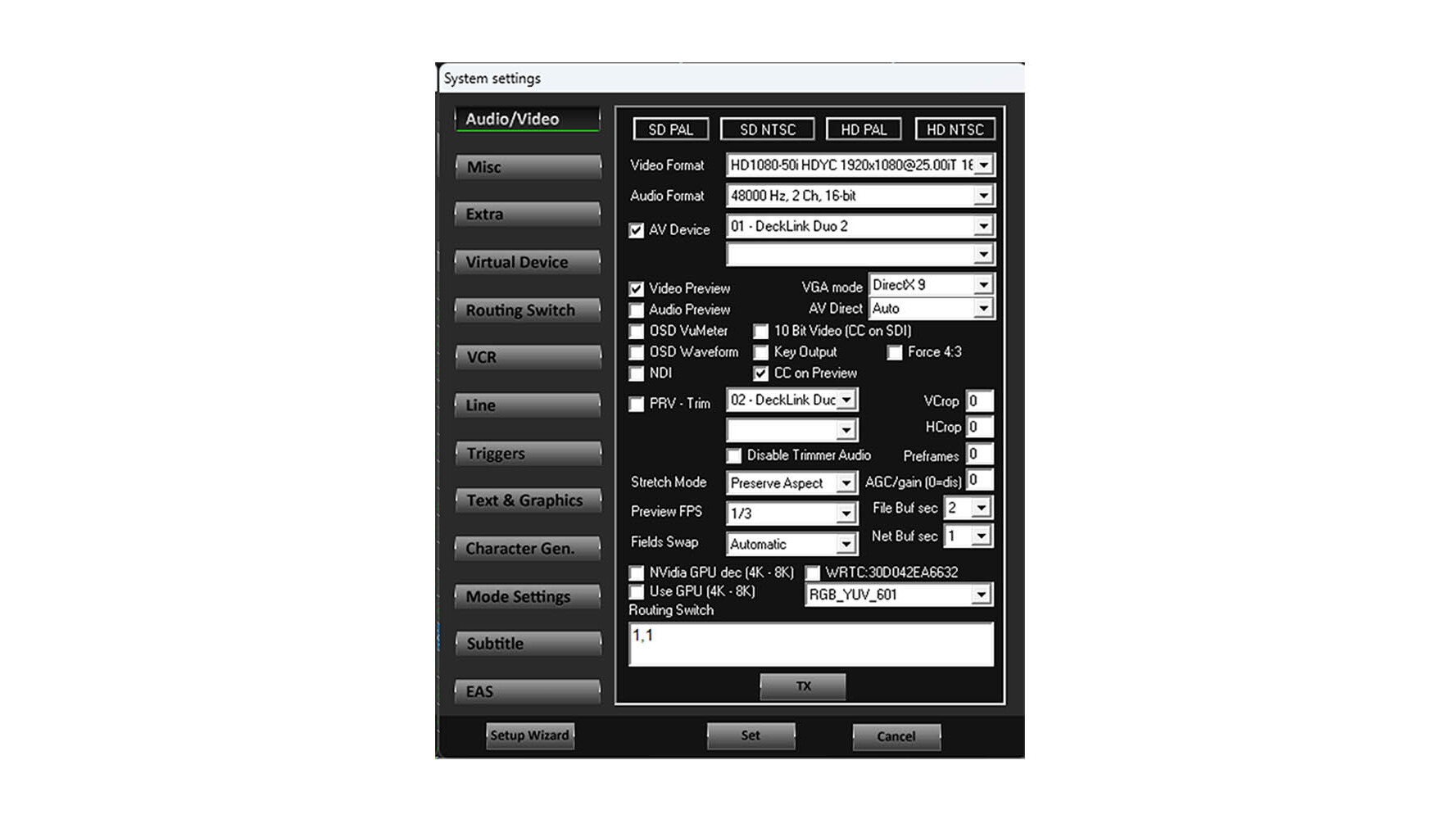Oxygen 3000 Plus
FOCUS ON
Digital Broadcast Console
Oxygen 3000 Plus: much more than a Digital Broadcast Mixer!
A full range of powerful features for Radio On-Air and Production available in 3 different formats and flexible configurations: 8, 12 and 16 faders with 1 or 2 Audio I/O Boards and 16+16 or 32+32 Dante™ I/O.
Oxygen 3000 Plus is the best-equipped console of its category: Low Latency, Users Preset, Smart Keys, EQ, Compressors, Telephone Hybrid, HDMI Output, Analogue and Digital I/O, USB, BT, Dante™ AoIP, Telco, Presenter Talk Box, Streaming In/Out.
The DSP based processing guarantees high-end quality audio and of course you will find the easiness of use that marks all the AxelTech’s products.
Oxygen Remoter Software, which enables up to 8 additional virtual faders for a full I/O control is available on Oxygen 3000 Plus as it is, for free, in any Oxygen Digital Console model.



Input & Output with 1 Audio I/O Board
- Up to 5 microphone inputs with Automix
- 2 stereo analogue inputs, up to 4 Stereo analogue inputs using other input sources
- 4 stereo analogue outputs
- 1 built-in telephone hybrid or 1 Telco with GPIO
- Up to 4 Telco using other input sources
- 1 BT audio interface or 1 stereo analogue input
- 1 digital In (AES/EBU) or 1 USB Input (play)
- 1 digital Out (AES/EBU)
- Up to 2 USB audio Input (play)
- 1 USB audio Output (rec)
- 1 Streaming In + 1 Streaming Out
- 16 inputs + 16 outputs or 32 inputs + 32 outputs via Dante™ (optional) configurable as mono/stereo/telco
Input & Output with 2 Audio I/O Boards
- Up to 10 microphone inputs with Automix
- 4 stereo analogue inputs, up to 8 Stereo analogue inputs using other input sources
- 8 stereo analogue outputs
- 1-2 built-in telephone hybrid or 1-2 Telco with GPIO
- Up to 8 Telco using other input sources
- 1-2 BT audio interface or 1-2 stereo analogue input
- 1-2 digital In (AES/EBU) or 1-2 USB Input (play)
- 2 digital Out (AES/EBU)
- Up to 4 USB audio Input (play)
- 2 USB audio Output (rec)
- 1 Streaming In + 1 Streaming Out
- 16 inputs + 16 outputs via Dante™ (optional) configurable as mono/stereo/telco
General
- Fully Digital Broadcast Console for Radio Broadcasting with 8, 12 or 16 faders
- Knob with A/B Fast source switch or source selection for each fader
- 4+1 busses (PGM, SUB, Aux1, Aux2, PFL)
- Near 0 latency (< 0,7 ms I/O)
- Digital Signals Routing 50×50 matrix with direct Input to Output
- Assignable Stereo N-1 on any output
- Complete Remote Control by means of an application replicating the surface
- Remote configuration and maintenance via Web Interface
- User-definable Presets & Snapshots
- 5 bands fully parametric Equalizer on each input
- Dynamic Processor with expander and compressor section on each microphone input
- Advanced and configurable Monitor Facilities for Control Room and Studio
- Customizable RGB colored buttons
- 7” TFT IPS Graphic Color Display for console configuration
- Four 2,2” TFT IPS displays for the output levels monitoring
- 2,2” TFT IPS displays on top of each fader displaying channel status, levels and source name
- HDMI Out for console status display
- 2 Timers (Ctrl-Room and Studio microphones on HDMI Monitor)
- START/ON Buttons for each fader
- 4 recall Snapshot buttons
- 4 direct Talkback buttons
- RGB led Bar for each fader
- Studio & Control Room Monitor Section
- 8 customizable Smartkey Buttons
- 2 customizable Function Keys for each fader
- TalkBox for guest and presenter (optional)
- Redundant PSU (optional)
Built In Decoder and Streamer
Oxygen 3000 Plus, in addition to analog/digital/AoIP inputs and outputs, is open to integration with the IP world thanks to the ability to decode an audio streams (stereo or mono) as input and generate an output audio stream (stereo or mono).
Versions
- Oxygen 3000 Plus 8 Fader 1 Audio I/O Board
- Oxygen 3000 Plus 8 Fader 1 Audio I/O Board Dante™ 16
- Oxygen 3000 Plus 8 Fader 1 Audio I/O Board Dante™ 32
- Oxygen 3000 Plus 12 Fader 1 Audio I/O Board
- Oxygen 3000 Plus 12 Fader 1 Audio I/O Board Dante™ 16
- Oxygen 3000 Plus 12 Fader 1 Audio I/O Board Dante™ 32
- Oxygen 3000 Plus 12 Fader 2 Audio I/O Board
- Oxygen 3000 Plus 12 Fader 2 Audio I/O Board Dante™ 16
- Oxygen 3000 Plus 16 Fader 1 Audio I/O Board Dante™ 32
- Oxygen 3000 Plus 16 Fader 2 Audio I/O Board
- Oxygen 3000 Plus 16 Fader 2 Audio I/O Board Dante™ 16
Options
- Redundant power supply
- Talk Box
- Dante™ I/O board
- RJ45 adapters for:
- Mic
- Line In
- Line Out
- Telco
- GPIO
The Oxygen Consoles Line Up
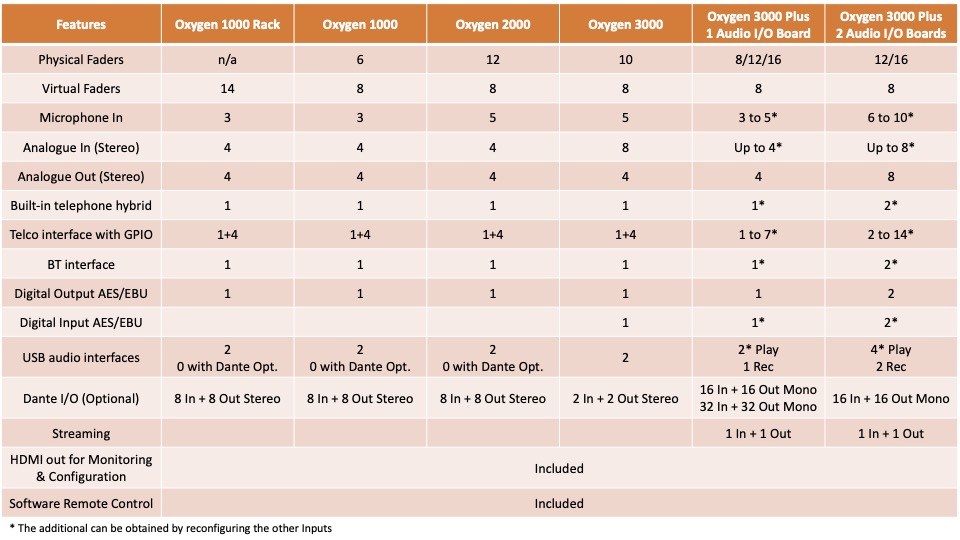
Microphone Inputs
- Up to 5 Microphone Inputs with Automix on each Audio I/O Board
- 3 Mic on XLR and 2 Mic on RJ45 (with Talk Box connector/adaptor) all balanced with + 48V Phantom and GPIO on each Audio I/O Board
- Independent ON AIR Lights and Cut Off control when opening Control Room and Studio microphones
- PFL button switches to private conversation on Hybrid/Telco/BT mode
- Enable TalkBack feature on any Studio or Control Room microphone
- Parametric Compressors/Expander with enhanced features for MICROPHONE and MONO inputs
- Save and recall microphone presets including Compressor/Expander settings
- Phase inversion on microphone inputs
- MONO inputs assignable as EXT source
- Ducking/AutoFader assignable to all sources (automatic attenuation of music on speech)
Automix
The Automix feature simplifies mixing activities if many guests are in the studio.
The Automix adds a new source to the existing ones (called “Automix”) and it will be the sum of all the enabled microphones.
The Automix source has all the features of a normal microphone source such as:
- Studio/Control Room loudspeakers control
- Studio/Control Room light control
- Can be used as audio in Private mode for phone calls
Using the Automix source, the user can manage in a very simple way all the microphones of the studio with many benefits:
- Managing all the studio’s microphones with one fader only;
- A dedicated AGC section for each microphone input automatically adjusts the correct level;
- Automatic management of attenuation on microphones not in use, simulating a slight closure of the fader;
- Final compressor with automatic leveling of the Automix source;
- Possibility to use the microphones individually.
This feature simplifies the work of the mixer engineer, especially if he/she is also hosting the show.
Available settings in the Automix menu:
- MIC-1 ON/OFF
- MIC-2 ON/OFF
- MIC-3 ON/OFF
- MIC-4 ON/OFF
- MIC-5 ON/OFF
- MIC-6 ON/OFF (with second audio board)
- MIC-7 ON/OFF (with second audio board)
- MIC-8 ON/OFF (with second audio board)
- MIC-9 ON/OFF (with second audio board)
- MIC-10 ON/OFF (with second audio board)
- DANTE-1 ON/OFF (with Dante™ option)
- DANTE-2 ON/OFF (with Dante™ option)
- DANTE-3 ON/OFF (with Dante™ option)
- DANTE-4 ON/OFF (with Dante™ option)
- DANTE-5 ON/OFF (with Dante™ option)
- DANTE-6 ON/OFF (with Dante™ option)
- Idle Mic Attenuation
- Attenuation Attack Speed
- Attenuation Release Speed
- Compression Threshold
- Compression Ratio
- Compression Attack Speed
- Compression Release Speed
- Autogain Speed
- Autogain Max Gain
- Autogain Max Attenuation
Analogue Inputs
- 2 balanced stereo analogue inputs on RJ45, up to 2 additional balanced stereo analogue inputs (one on XLR and one on RJ45) using other input sources, on each Audio I/O Board
- Channel mode selection: STEREO, MONO, L, R, INV-L, INV-R, INV
Digital Input Line
- 1 AES/EBU Input on XLR with Sample Rate Converter (32 – 192 kHz), on each Audio I/O Board
USB Audio I/O
- 2 Built-in stereo USB (Type-B) (2 Stereo Inputs-1 Stereo Output) Audio Interfaces on each Audio I/O Board, allow to directly connect the PC to the Oxygen 3000 Plus console, with no need for extra audio cards (the PC detects the console as a digital audio card with 2 stereo inputs and 1 stereo output for simultaneous playout and recording)
Telephone Hybrid and Telco
- Telephone Hybrid: 1 POTS/PSTN telephone line with Line In and Tel Set connection on each audio I/O board
- Telco: 1 in/out N-1 to connect external telephone hybrid with control via TLC/GPIO, on each Audio I/O Board
- Up to 6 Telco using other input sources, on each Audio I/O Board
- GPI and GPO management on max 5 Telco I/O, on each Audio I/O Board
- RING and HOOK on F keys for each TELCO I/O
- N-1 on Telco outputs for all BUS (PGM, SUB, AUX-1, and AUX-2)
Analogue Outputs
- For each Audio I/O Board 4 Balanced Outputs:
- OUT – 1 & 2 XLR – Assignable
- OUT – 3 & 4 RJ45 – Assignable
Digital Output
- 1 AES/EBU output (32 – 192 kHz) on XLR on each Audio I/O Board
Headphones and Local Monitor Outputs
- For each Audio I/O Board, 1 Unbalanced output line on Jack 6.3 for Control Room and Studio Headphones
- Adjustable maximum Control Room and Studio speakers volume
- Adjustable maximum Control Room and Studio headphones volume
- Adjustable CUT or Attenuation mode (-40, -30, -20, -10 dB) on Control Room and Studio speakers
- Independent source selection (PGM, SUB, AUX1, AUX2, EXT1, EXT2) for control room and studio speakers, control room and studio headphones with or without PFL
- Independent Talk Back management on Control Room and Studio speakers
- Independent Talk Back management on Control Room, Studio and Guest headphones
- Selectable source for Guest headphones (PGM, SUB, AUX1, AUX2, EXT1, EXT2)
- Same source selection for Control Room and Studio headphones, with independent level
GPI/GPO
- GPI: 9 on each Audio I/O Board, for Talk back, Telephone Hybrid or other features
- GPO: 9 on each Audio I/O Board, to control OnAir lamps or provide HOOK and RING commands for external telephone Hybrid
- User custom GPIs (e.g. Ring, Talkback, channel ON/OFF, etc.)
- User custom GPOs (e.g. Hook/ONAIR, Studio-Light, Control Room-Light)
Surface & Management
- Direct Firmware update via Internet
- WEB UI for Console configuration and service features (Save, restore, update, logs, etc)
- Conditional Access (4-digit PIN) to limit console configurations to authorized users
- Save and recall EQ presets (up to 10)
- New real-time EQ algorithm with graphic
- Fast and accurate Meters on 2.2” TFT IPS displays
- Save and recall control panel configuration with 10 Snapshots
- Save and recall total console configuration. The configuration can be saved to internal memory (microSD), USB and PC (via WEB interface)
- Gain adjustment knobs with adaptive speed
- Dimmable buttons light
- Adjustable fader ON/OFF threshold (from -50 dB to 0 dB)
- CountUp/Timer on studio and control room microphones on the built-in 7″ display
Telephone Hybrid and Telco
The built-in telephone hybrid allows direct connection of a telephone line POTS/PSTN on RJ-11C.
It’s also available a Telco N-1 in/out, to connect Oxygen 3000 Plus to an external telephone hybrid. Telco-1 N-1 output is always available on RJ45. TLC commands are available on RJ45 connector with Hook and Ring interface for external telephone hybrid.
6 inputs/outputs N-1 are also available (with 4 GPI controls).
Software Remote Control
Oxygen Remoter is a software tool available for free with any Oxygen console. It offers advanced remote control features such as accessing to any set up and information, fader and buttons control and any other operation available on the physical consoles. It is very useful especially for compact consoles and in any environment that has limited space.
The Virtual Fader technology enables users to assign each input to a virtual fader/channel on the remote surface, this is of course very useful when controlling channels remotely. Additionally, transforming the A/B pair into two virtual faders is a smart solution that maximizes the management of the available sources.
Oxygen Remoter can remotely control multiple consoles and create an ecosystem, this can be very helpful for remote productions where, for instance, a portion of the channels may need to be controlled from a studio while the others are still managed from the physical surface in the control room.
Oxygen Remoter is a powerful tool that provides extra flexibility and control’s tools to all the Oxygen consoles.
Oxygen Remoter is downloadable from the Oxygen console’s administration web page.
Displays
On the OXYGEN 3000 Plus AxelTech reinvented the experience between the studio engineer and the console.
The 7″ TFT IPS graphic display shows all the airing parameters and with the 4 rotary knobs allows the fast and intuitive programming of all the mixer’s parameters.
Selectable home page layouts are available with many theme icons. Default page shows the levels and the A & B source names for any fader.
Four 2,2 ”TFT IPS displays have been implemented for an immediate and complete monitoring of the outputs.
The 2,2 ”TFT IPS displays on top of each fader show the channel status, levels, sources and main settings.
HDMI Output
The HDMI output connects the console to a HD display monitor and it can monitor all the following information:
- Audio input source levels
- 4+1 BUS output levels
- A/B source names assigned of 10 channels
- Display On-Air sources
- Microphone On timer (control room & studio)
- Large Clock
- Audio output level (Loudspeakers & Headphones)
- On-Air microphone
- Telephone active
- HDMI output combined with 4 rotary knobs allow the fast and intuitive programming of all the mixer parameters.
- The programming GUI has been designed in order to be very easy and intuitive.
- Selectable home page layouts are available, with many theme icons.
HDMI output can be customized with the user’s logo. Selectable display layouts are available.
BT
Oxygen 3000 Plus has a BT module on each Audio I/O Board. This allows airing the calls made via GSM, Skype, Viber and WhatsApp with a Smartphone, a Tablet or a PC. Oxygen 3000 Plus has two BT connection modes: bidirectional to support phone calls; monodirectional to put on air high quality stereo audio (A2DP) streamed by BT sources.
With BT calls, PFL enables PRIVATE conversation mode.
Built In Decoder and Streamer
Oxygen 3000 Plus, in addition to analog/digital/AoIP inputs and outputs, are open to integration with the IP world, thanks to the ability to decode an audio streams (stereo or mono) as input and generate an output audio stream (stereo or mono).
Supported CODECs:
Input (CBR & VBR):
- AAC (AAC-LC): 32-256 kbps, 16/32/44.1/48 kHz
- Linear PCM – 16 bit, 16/32/44.1/48 kHz
- MP3 (MPEG1-Layer 3): 32-320 kbps, 16/32/44.1/48 kHz
- MP2 (MPEG1-Layer 2): 32-320 kbps, 32/44.1/48 kHz
- OGG VORBIS: 32-256 kbps, 16/32/48 kHz
- OPUS: 6-320 kbps, 48 kHz
Output (CBR):
- AAC (AAC-LC): 32-256 kbps, 16/32/48 kHz
- Linear PCM – 16 bit, 16/32/48 kHz
- MP3 (MPEG1-Layer 3): 32-320 kbps, 16/32/48 kHz
- MP2 (MPEG1-Layer 2): 32-320 kbps, 16/32/48 kHz
- OGG VORBIS: 32-256 kbps, 16/32/48 kHz o OPUS: 6-320 kbps, 48 kHz
Supported Streaming Servers:
- Icecast: MP3, OPUS and Ogg Vorbis
Network and Transport & protocols:
- Transport: Real-time Transport Protocol (RTP), Real-time Streaming Protocol (RTSP)
- Protocols: IPv4, IPv6, TCP/IP, UDP, RTP, RTSP
Casting modes: Multicast and Unicast
Key applications:
- STL and SSL links, DVB S/T audio, WEB radio
- Audio streaming over internet
Redundant Power Supply
Oxygen 3000 Plus is equipped with an external Universal Switching Power Supply 12V (with 4 poles XLR connections) able to operate with a voltage between 90Vac and 264Vac and a frequency between 50 and 60Hz. This PSU can adapt itself to the operating voltage of any country in the world. Optionally the console can be equipped with a redundant power supply: in this configuration the fault of one of the PSU is promptly noticed on the 7” display.
Talk Box
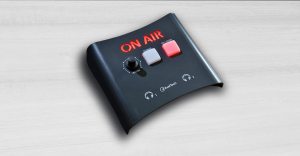 Talk Box is very simple to connect to the On Air Console: it takes 2 RJ45 cables of the length that is needed to connect it to the mixer. It is possible to connect up to 4 Talk Boxes on each Audio I/O Board. The Talk Box manages a direct connection of the microphone and its own On-Air light. It is also possible to connect it to the studio’s On-Air Light. The Talk Box has a headphone amplifier with two 6.3mm outputs. Through the two backlit buttons it is possible to activate and deactivate your own microphone (On/Off/Cough) or enable Talk back to the console.
Talk Box is very simple to connect to the On Air Console: it takes 2 RJ45 cables of the length that is needed to connect it to the mixer. It is possible to connect up to 4 Talk Boxes on each Audio I/O Board. The Talk Box manages a direct connection of the microphone and its own On-Air light. It is also possible to connect it to the studio’s On-Air Light. The Talk Box has a headphone amplifier with two 6.3mm outputs. Through the two backlit buttons it is possible to activate and deactivate your own microphone (On/Off/Cough) or enable Talk back to the console.
Dante™ AoIP Interface
Oxygen 3000 Plus can be equipped with a Dante™ interface (also supporting AES67 and SMPTE ST 2110-30 transport protocols) which provides 16 Inputs and 16 Outputs or 32 Inputs and 32 Outputs on dedicated Ethernet port, with independent Level Control and Sample Rate Conversion.
Dante™ AoIP interface is installed at the factory and has to be requested at the order.
Cable Adapters
RJ45 adapters are available for:
- Mic with GPIO
- Line In
- Line Out with GPIO
- Telco with GPIO
Analog Balanced Microphone Inputs
Connector RJ45 & XLR Balanced – EMI Suppressed
Input Impedance 2,4 KΩ
Nominal Input Level (sensitivity) -9/-66 dBu
Max Input Level (clipping point) +9 dBu
A/D conversion 24 bit / 48 Khz
Signal To Noise Ratio (referred to peak level) >110 dB
THD+N <0,01%
Analog Gain Adjustable +0 ÷ +60 dB (3dB step)
Phantom Power +48V
Analog Balanced Stereo Inputs
Connector XLR & RJ45 Balanced – EMI Suppressed
Input Impedance 10 KΩ
Nominal Input Level (sensitivity) 0 dBu
Max Input Level (clipping point) +18 dBu
A/D conversion 24 bit / 48 Khz
Frequency response +/-0,5 dB from 20 Hz to 20 kHz
Signal To Noise Ratio (referred to peak level) >110 dB
Stereo Separation (referred to peak level) >90 dB
THD+N <0,002 %
Analog Balanced Telco Input
Connector RJ45 Balanced – EMI Suppressed
Input Impedance 10 KΩ
Nominal Input Level (sensitivity) 0 dBu
Max Input Level (clipping point) +18 dBu
A/D conversion 24 bit / 48 Khz
Signal To Noise Ratio (referred to peak level) >110 dB
THD+N <0,002%
Digital Input
Connector Balanced on 1 XLR – EMI Suppressed
Input Impedance 110Ω
Standard AES3
Audio Sample Rate 32/44.1/48/96/192 KHz with SRC
Resolution 24 bit
Dynamic Range (Converter Values) 124dB
Analog Balanced Stereo Outputs
Connector RJ45 Balanced – EMI Suppressed
Output Impedance 23 Ω, nominal 600 Ω
Nominal Output Level 0 dBu
Max Output Level (clipping point) +18 dBu
D/A conversion 24 bit / 48 Khz
Signal To Noise Ratio (referred to peak level) >110 dB
Stereo Separation (referred to peak level) >90 dB
THD+N <0,002 %
Dante I/O
Sample Rates (16x16 Versions) 44.1/48/88.2/96 kHz
Sample Rates (32x32 Versions) 44.1/48/88.2/96 kHz
Audio Flows In/Out Up to 32x32 simultaneous streams
Digital Audio Formats TDM, I2S
Audio Transport Formats Dante Audio over IP, AES67 RTP, SMPTE ST2110-30 RTP (enrolled devices)
Sample Bit Depth 16, 24 or 32 bits per sample
Audio Buffering Up to 2000 samples per channel
Clocking Onboard word clock or external word clock
Form Factor Card edge module. 4.5cm x 6cm (1.75” x 2.4”)
FPGA High performance Xilinx Spartan6 FPGA
Microprocessor Soft-core Microblaze processor
Clock High quality, low jitter onboard SiLabs
Ethernet Standard RGMII/MII interface for Ethernet PHY or switch chip
Power 3.3VDC @ 2W max
Physical Connector Mini-PCI
Control Interfaces SPI Master and Slave; GPIO; I2C
Network RGMII/MII
USB Audio Digital I/O
Connector USB Type B – EMI Suppressed
Playback And Recording Sample Rate SRC 44.1-48 KHz
Resolution 16 bit
Available Stereo Channels 2 stereo USB - 2 Inputs & 1 Output on each Audio I/O Board
Analog Balanced Talkbox Outputs
Connector RJ45 balanced – EMI Suppressed
Output Impedance 100ohm, nominal 600ohm
Nominal Output Level 0dBu
Max Output Level (clipping point) +14dBu
D/A conversion 24 bit / 48 Khz
Signal To Noise Ratio (referred to peak level) >110dB
Stereo Separation (referred to peak level) >90dB
THD+N <0,05%
Analog Balanced Telco Output
Connector RJ45 Balanced – EMI Suppressed
Output Impedance 23 Ω, nominal 600 Ω
Nominal Output Level 0 dBu
Max Output Level (clipping point) +18 dBu
D/A conversion 24 bit / 48 Khz
Signal To Noise Ratio (referred to peak level) >110 dB
THD+N <0,002 %
Digital Output
Connector Balanced on 1 XLR – EMI Suppressed
Input Impedance 110 Ω
Standard AES3
Audio Sample Rate 32/44.1/48/96/192 KHz
Resolution 24 bit
Dynamic Range (Converter Values) 124 dB
PSTN Interface
Connector RJ11
Transhybrid loss >20 dB
System
Audio Core Analog Devices ADAU1452 32bit 294 MHz fixed point DSP
Audio CODECs Cirrus CS42448 24 bit/192 kHz
LAN Connection RJ45 - 1 Gbit
Nominal Delay (analog input to analog output) 0,7 ms
GPIO Inputs/Outputs 4 GPI/4 GPO on DB9; 4 GPI/2 GPO on Mic2 & Mic3 RJ45; 2 GPO on Out3 & Out4 RJ45; 1 GPI/1 GPO on Telco RJ45
Communication Port 2xUSB type-A, 2xUSB type-B , 1xLAN, 1xHDMI
Operating Temperature 0°C ÷ 40°C
Dimensions
8 Faders Dimensions (W; H; D) 584 mm; 113,5 mm; 495,5 mm
12 Faders Dimensions (W; H; D) 764 mm; 113,5 mm; 495,5 mm
16 Faders Dimensions (W; H; D) 944 mm; 113,5 mm; 495,5 mm
Weight 15 to 25 Kg
PSU
Type External Universal Switching Power Supply 12V with 4 poles XLR connections - Optional Redundant
Power Supply 90-264 VAC / 50-60 Hz / 120 W
Case Histories
Radio Cuquema – Radio Station
Angola with SiteMaster
Cidade Hoje – Radio Station
Portugal with SiteMaster
ON FM – Visual Radio
Portugal with SiteMaster
Asaase – Visual Radio
Ghana with Bahamus
Brothers FM, Lobi Broadcasting
Nigeria with Ecalpemos
Nauru National Media Centre
Radio/TV Facility Facility - Nauru
Falcon X7
FOCUS ON
Broadcast Audio Processor for FM & HD Radio
Falcon X7 is the top level unit among AxelTech’s Audio Processors new generation: the traditional quality, reliability and cost effectiveness, recalled by the name Falcon so well known in the broadcast world.
Falcon X7 makes your Radio sound great enabling you to set up your perfect sound identity by choosing the pre set that suits better with the style of your radio or by tailor making your own set.
Falcon X7 embeds the New Falcon Platform: a brand new firmware with cutting-edge technology that combines ease of use and high level quality sound.
Falcon X7 is an all-in-one equipment: Audio Processor. MPX Generator, RDS Encoder, Loudness Control, Change Over. It works for FM and DAB, HD Radio, Sirius XM, Web.
All these features make Falcon X7 a unique unit among competitors of the same and even higher range of prices.

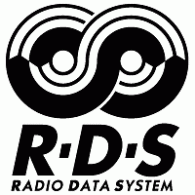

- All-in-one 5 Bands Audio Processor with MPX Generator, RDS Encoder (optional), MPX power Control and Change Over/Silence Detector.
- Parallel Dual Processing allows Falcon to feed at the same time FM (15 kHz) and digital broadcasting (20 kHz) such as DAB, HD Radio, Sirius XM and Web Radio.
- Fully customizable top class Audio processing tools with 5 bands compression control, adjustable Drive and Threshold, Dual AGC, 3 Bands Equalization (Low, Mid and High frequency), Stereo Enhancer, Voice Detector and Brightness Control.
- Mono Sound Phase Control gives a more natural and pleasant sound to the human voices. The final limiter enhances the sound presence.
- More than 240 Factory Presets + 20 User Presets to tailor at best your channel.
- MPX Encoder and Optional Dynamic RDS encoder both integrated in the DSP structure to provide the ideal MPX signal: easy to integrate with the customer infrastructure thanks to the MPX digital AES-192 and two independent analogue MPX outputs.
- Loudness control: EBU R 128 (https://tech.ebu.ch/publications/r128) and ITU-R BS.1770-4 (https://www.itu.int/rec/R-REC-BS.1770) recommendations for digital and analogue audio outputs.
- Power MPX control: ITU BS.412 MPX Power Recommendations available for MPX processing (https://www.itu.int/rec/R-REC-BS.412/en).
- Fully configurable Audio Changeover/Silence Detector to switch over four out of the Analog, Digital, MPX, IP, AoIP, Dante™ (optional) and Built In Player inputs.
- The hardware bypass circuit guarantees audio presence and programs continuity.
- Full range of outputs: one analog, two digital audio (over XLR connectors), two Optional Dante™ and two independent MPX.
- Falcon can integrate with existing infrastructure via Ethernet port, two RS-232 serial ports, two USB ports and six GPI ports with optical coupler and four relays.
- A LAN port and a built-in Web Server to control & configure the processor from any device and tune audio from anywhere also using the IP streams I/O.
- Falcon Logs every second on the external microSD card the value/status of 8 out of 88 internal parameters for 1 year (at the end of the period oldest data will be overwritten). The user can choose the 8 parameters to be logged and can select a time lapse among the logging to export the data on a CSV file for any analysis.
- Falcon processors are equipped with a universal 90-260 V AC power supply, working at 50 or 60 Hz, ready to be used in every country around the world. Thanks to the low power consumption (max 15 W) Falcon is also a green equipment.
- Falcon 1 Rack Unit robust design is sustained by the extensive use of steel and aluminum. Falcon appliances are immune to strong electro-magnetic fields and are suitable to be installed in extreme climate environments.
- A dedicated digital test signal generator can send to all the physical outputs (analogue, digital and MPX) signal sample with variable frequency and amplitude to help calibrate the whole audio chain.
The Falcon X Series
Different users have different needs: that’s the reason why AxelTech features a whole line up of processors with different models suitable for different workflows. Falcon X7 is the full option unit, Falcon X6 embeds the same features only except the controls on the front panel, perfect to be remotely installed and managed through the WEB interface. Falcon X5 is entry level unit with the same processing power of the Falcon X7 and a simplified I/O and changeover sections.
Falcon audio processors integrate many extra though needful features for the radio workflow: RDS coding (optional) and Stereo Generator or innovative technologies such as DAB and audio over IP.
Falcon series equipment ensures top quality performances and high level audio. It features powerful DPSs, 5-bands architecture, dual bands AGCs, 3-bands equalizer, stereo enhancer, speech detector and 5 limiters.
The comprehensive and accurate control of each audio parameter allows to perfectly shape the audio to broadcast unique and exceptional branded sound.
Complete set of inputs
Extended Changeover/Silence Detector with configurable source priorities out of the following sources: 1xAnalog, 2xAES/EBU, 2xIP, 2xMPX, 1xMPX-AES192, 2x Dante™ (Optional), 1xInternal Player
Sampling rate from 32 kHz TO 192 kHz
Complete set of outputs
1xAnalog, 2xAES/EBU, 1xIP, 2xMPX, 1xMPXAES192, 1x Dante™ (Optional)
Built-in audio player
Suitable like a backup source or for test purposes. A Test Signal Generator is also available.
Advanced SNM (Simple Network Management Protocol)
Allows data interchange and simplified configuration of third-party appliances connected in the same LAN using shared datasets MIB.
MPX Changeover
Manages the routing of MPX signals for Advertisement Area Splitting.
Advanced RDS (Optional)
Dynamic RDS fully supported, UECP Input implemented, 8 Datasets available. Suitable for network infrastructures.
Upgradable and Reliable
Internal microSD card with OS for Disaster Recovery. Easily Upgradable via WEB or Windows application.
Built-in audio encoder and streamer
Can manage two audio streams like an input, can generate an output audio stream.
Web based control panel
The whole system can be managed through a WEB page generated by the internal web Server. The main functions can be managed through the physical panel.
Advanced features
Processing delay
A configurable delay (from 0 to 3.5”) can be applied to the FM process to synch with those distribution channels having a significant latency like the DAB.
Dual Processing
15 kHz processing allows to use it as FM Audio Processor.
20 kHz processing for digital broadcasting, allows to use it as DAB Audio Processor, HD Radio Audio Processor, Sirius XM Audio Processor, Web Radio Audio Processor.
MPX Loudness processing
ITU BS.412 MPX Power Loudness Recommendations available for MPX processing chains compliant with every country loudness rules.
MPX over AES 192 (AES3)
This is the standard for exchange the digital MPX+RDS signals between professional audio devices.192 kHz standard is supported by several transmitter manufacturers.
Advanced Changeover
The Advanced Audio Changeover/Silence Detector can switch between any available input source: Analog, Digital, MPX, FM, IP, Dante™, Internal Audio Player.
Real time monitor
Processing delay is quite non audible, 10 to 30mS depending on the processing complexity.
Audio Processing
Clarity of sound
Falcon processors high-quality hardware design and software algorithms produce a detailed, crystal-clear sound on any speaker system, always preserving original audio signature.
Voice processor
A dedicated processing section boosts presence of voice delivering a soft, silky sounding effect. Vocals are always on top of the mix making lyrics comfortably audible. Each instrument and vocalist gains dominium of its own space.
Extreme density
Falcon processors deliver full impact sound at the highest volume density preserving original audio detail, identity and mood. The dedicated ‘Bass Enhancer’ stage delivers a strong and effective ‘drum punch’ for a deep musical emotion.
Here are the processing tools to make it sound as you like:
AGC – Automatic Gain Control
- AGC Enable
- Cross Frequency
- Filter Slope
- Drive
- Attack Time
- Release
- Gate Threshold
- Release Acc. Hold
- Release Acc. Coeff.
- Work Zone Threshold
- Work Zone Release
- L/R Linkage
- Bass vs Master Coupling
- Idle Compression
- Idle Speed
- HP Filter
EFX/EQ
Stereo Enhancer
- Mode, Band, Effect Limiter, Effect Drive, Effect Depth
Post-AGC Equalizer
- Low Band
- Mid Band
- High Band
- Low Pass Frequency
- Center Frequency
- High Pass Frequency
- Low Pass Slope
- Band Pass Width
- High Pass Slope
Speech Detector
- Mode
- Action
Phase Rotator
- Phase Rotator
Multiband
Multiband Controls
- Drive
- Attack Time
- Release
- Gate Threshold
- Release Acc. Hold
- Release Acc. Coeff.
- Idle Compression
- Idle Speed
- Band1 vs Band2 Coupling
- Band2 vs Band3 Coupling
- Band4 vs Band3 Coupling
- Band5 vs Band4 Coupling
Compressors
- Threshold (for each of 5 bands)
- Relative Attack (for each of 5 bands)
Compressor-Limiters Feedback
- Feedback (for each of 5 bands)
Limiters
- Drive (for each of 5 bands)
- Attack Time (for each of 5 bands)
- Release (for each of 5 bands)
- Hold (for each of 5 bands)
Downward Expander
- Expansion (for each of 5 bands)
- Expansion Threshold (for each of 5 bands)
Bands Mixer
- Gain (for each of 5 bands)
Final Limiters
Limiters Setup
Bass Limiter
- Bass Drive
- Bass Attack
- Bass Release
- Bass Threshold
- Super Bass Mode
- Super Bass Gain
- Lookahead Mode
Main Limiter
- Mid. Freq Drive
- Mid. Freq Attack
- Mid. Freq Release
- Mid. Freq Threshold
- Mid-High Peaks SubDrive
- Mid-High Peaks Attack
- Mid-High Peaks Release
- Mid-High Peaks Threshold
Bass/Main Limiter Setup
- Bass Limiter Mix
- Main Limiter Mix
Lookahead Final Limiter
- Overdrive
Brilliance adjustment
- Wide Band Process Brilliance Attenuation
MPX Bass Control
- Mode
- Drive
- Clipping Threshold
MPX Limiter Deemphasis
- Drive
- Attack
MPX Limiter Emphasis
- Drive
- Attack
MPX Limiter Emphasis 2
- Drive
- Attack
MPX Limiter Global
- Attack
Factory Presets
The right sound for your Radio or TV in a few clicks thanks to our Factory Presets.
In our Factory Presets there is all our expertise acquired in thirty years of experience, enriched by the advice of the most important experts in the sector.
FM & HD Radio Applications
Falcon processors are populated with 8 Families of Factory Presets for FM & HD Radio, allowing sound engineer to rapidly find the desired sound. For each Family are available some Flavors.
All the Factory Presets are available in the 50 µsec and 75 µsec Pre-emphasis versions, some are available in a specific version for HD Radio.
For each Flavor, are available 4 additional versions:
- +1: slightly emphasized
- +2: moderately emphasized
- EFX: as +2 with some Bass & Stereo enhancing
- Voice: slightly reduced to highlight speech
Combining all of this, the Falcon gives you more than 240 presents, one of which is the right for you.
General Purpose (50 µsec, 75 µsec, HD)
The easiest and fastest way to go on the air. This preset is the best possible compromise between various musical genres, speech and advertising.
Flavors:
- All Purpose
- Classic Hits
- Rockloud
- General Purpose
Clean (50 µsec, 75 µsec, HD)
A clean preset for VOICE or music formats that requires a transparent processing with a good amount of AGC.
Flavors:
- CHR Hot
- Newstalk
- Clean
Open (50 µsec, 75 µsec)
Open and clean with a touch of color and loudness.
Flavors:
- Rock open
- Open
Compressed (50 µsec, 75 µsec, HD)
For who search a compressed, loud and big sound.
Flavors:
- RNB
- Bass punch
- Compressed
Loud (50 µsec, 75 µsec, HD)
Loud and open preset for a competitive sound.
Flavors:
- CHR Loud 1
- Loud
POP-Contemporary (50 µsec, 75 µsec)
Processed and loud preset for contemporary music.
Flavors:
- AC Bright
- CHR Bright
- Electra V2
- Gigawatt
- POP Contemporary
Oldies-Generic (50 µsec, 75 µsec)
Loud, big and compressed preset with a good amount of auto equalization for oldies format radios.
Flavors:
- Oldies
- Oldies Generic
Oldies 70-80 (50 µsec, 75 µsec)
Like Oldies Generic but with more gentle processing and a different approach to oldies music processing.
Flavors:
- Loud 80s
- Oldies 70-80
Signal Routing and Changeover
The new Falcon processor includes a technologically advanced Audio Changeover/Silence Detector able to switch between any available source: Analog, Digital, MPX, FM, IP, AoIP…In case of missing audio from any external sources, the processor can play the playlist stored in the microSD. It’s possible to add up to 3.5 seconds delay to MPX output to synchronize DAB signal (connected to analogue or digital output) to FM signal connected to MPX output.
An embedded Test Signals Generator allows to output an audio signal suitable for testing the equipment or the whole audio system.
I/O Connections
Falcon Audio Processor new series features a complete set of input and outputs connections. Analog and AES/EBU digital audio connections are standard aside of two buffered and independent multiplexed output (MPX+RDS) with hardware bypass: Analog Input > Analog Output | Digital1 Input > Digital1 Output | Digital2 Input > Digital2 Output |AUX1 Input > MPX1 Output | AUX1 Input > MPX2 Output
Three USB ports (one on the front, one on the rear panel and one installed on the internal circuit board), are available.
microSD allows to clone the whole setup from one Falcon to another one.
Two AUX inputs (SCA) allows to connect an external RDS encoder. Another AUX input can receive the audio from another MPX processor and switch with the internal generated MPX, allowing to build a small network managed from radio automation system.
Dante™ connection, available as an option, allows to manage AoIP Dante™ or AE67 signals: 2 Stereo inputs and 2 Stereo outputs.
Front Panel
Falcon X7 features a wide Color TFT Technology display (480×128) that shows the input and output processing, including the corrections for each band featured from the compressor, the limiters and the multiband AGC.
Obviously, it also shows the input and output of all signal levels.
Moreover trough the display it’s possible to check the system status: operating parameters, GPI/O port status and RDS parameters, including the station’s ID.
A TRS (stereo Jack 6,3 mm) connector allows monitoring both original and processed signal, checking in the faster way the differences between the available presets.
Communications & Alarms
Falcon audio processors can exchange information with other equipment through some communication ports: One LAN/WAN port, two RS-232 serial ports, two USB ports, one GPIO port with optical coupler and relays.
Information will be sent (status, alarms) or received (commands). A panel with 40 LEDs and the LCD display (Falcon X7) show status information.
Alarm messages can be sent via GPO, SNMP (Trap), and http.
Web Server
Users can manage Falcon equipment via LAN, no need to install any client software. The internal Web Server can be managed with any browsers (Chrome, Firefox, Edge, Opera…). The GUI on the web page is clear, easy to use and responsive, suitable to be managed from any device: Personal Computers, tablets, smartphones.
SNMP (v 2.0c) programming protocol allows to manage the whole command set. Falcon firmware also implements HTTP, FTP, SNMP, SMTP, UDP, TCP and is PV4 – IPV6 addressing compliant. RDS services need a precise synchronization: the system tries to connect to a primary NTP, backup NTP and to an external GPS receiver (not supplied).
Moreover, connecting an external GPS allows to geo-localize the Falcon. The WEB server supplies a page with a map that shows the appliance position. Standard Ethernet interface can manage up to 4 independent TCP ports, up to 4 separate UDP ports and 1 SNMP port. Obviously, it also shows the input and output of all signal levels.
MPX Stereo Generator
The stereo generator integrated in the DSP structure, provides an almost ideal MPX signal, optimizing the performances of the equipment to the maximum. All the parameters for pilot level, phase and levels are adjustable via the web page. Stereo Generator circuit can switch the source between the internal MPX and an external signal. Switch can be managed locally or with a command sent by an external radio automation software via Ethernet or GPI.
Built In Decoder and Streamer
Falcon processors, in addition to analog/digital/AoIP inputs and outputs, are open to integration with the IP world, thanks to the ability to decode two audio streams (each stereo or mono) as input and generate an output audio stream (stereo or mono).
Supported CODECs:
Input (CBR & VBR):
- AAC (AAC-LC): 32-256 kbps, 16/32/44.1/48 kHz
- Linear PCM – 16 bit, 16/32/44.1/48 kHz
- MP3 (MPEG1-Layer 3): 32-320 kbps, 16/32/44.1/48 kHz
- MP2 (MPEG1-Layer 2): 32-320 kbps, 32/44.1/48 kHz
- OGG VORBIS: 32-256 kbps, 16/32/48 kHz
- OPUS: 6-320 kbps, 48 kHz
Output (CBR):
- AAC (AAC-LC): 32-256 kbps, 16/32/48 kHz
- Linear PCM – 16 bit, 16/32/48 kHz
- MP3 (MPEG1-Layer 3): 32-320 kbps, 16/32/48 kHz
- MP2 (MPEG1-Layer 2): 32-320 kbps, 16/32/48 kHz
- OGG VORBIS: 32-256 kbps, 16/32/48 kHz
- OPUS: 6-320 kbps, 48 kHz
Supported Streaming Servers:
- Icecast: MP3, OPUS and Ogg Vorbis
Network and Transport & protocols:
- Transport: Real-time Transport Protocol (RTP), Real-time Streaming Protocol (RTSP)
- Protocols: IPv4, IPv6, TCP/IP, UDP, RTP, RTSP
Casting modes: Multicast and Unicast
Auxiliary Data / TAGs:
Auxiliary Data/TAGs to be inserted in encoded output stream (ID3 for MP3) can be defined:
Statically:
- From a web page;
- Using REST-type commands;
- Read from a file via SMB/SAMBA;
- Parsed by ASCII UDP commands;
- Parsed by SNMP string commands.
Dynamically:
- Imported by the Input Stream.
Dynamic data streaming output (title / author / channel name / URL)
Key applications:
- STL and SSL links, DVB S/T audio, WEB radio;
- Audio streaming over internet
Dante™ AUDIO-OVER-IP CONNECTIVITY
Dante™ option (also supporting AES67 and SMPTE ST 2110-30 transport protocols) provides an Ethernet connection for 2 Stereo Input and 2 Stereo Output, with independent and dedicated Level Control and Sample Rate Conversion.
RDS Radio Data System Encoder
Falcon RDS option performs a full digital Static and Dynamic RDS encoding in compliance with the latest standards: UECP EBU SPB490 v7.05, Cenelec (Europe) and NRSC (USA).
It provides 8 Data Sets with a wide range of static services, including Radio Text.
The dynamic RDS features allows to manage many kinds of services: PS, RT, CT, EON, RT+, PTY, PTYN.
With the addition of the RDS encoder, the processor makes the listening experience even more engaging by also transmitting emergency information, such as weather or traffic alerts, helping to keep listeners informed and safe.
Add the RDS encoder to the Falcon is easy and convenient and does not require additional hardware installation. Furthermore, the RDS encoder can be controlled and configured through the web user interface, making managing the services/data transmitted even easier.
| Analog Input - AUDIO | |
|---|---|
| Number of Inputs | 1 Stereo |
| Connectors: | 2 XLR, female - Electronically balanced – EMI Suppression |
| A/D Conversion: | 24bit Sigma-Delta Conversion (Crystal CS4272) |
| AD Clipping Point | +24.0 dBu |
| Operative Nominal Level | From –12.0dBu to +13.0dBu (0.1dBu Step) Software adjustable |
| Line Impedance | 10 kΩ (Electronically balanced selectable) |
| Distortion | Less than 0.01% TDH+NOISE (0.0 dBu 1Khz) |
| AD Dynamic Range | 108 dB RMS (110 dB A weighted) |
| Input Modes | Stereo, Mono (Left), Mono (Right), Mono (Left+Right) |
| CMRR input | >60 dB (20 Hz to 20 kHz) |
| FM Frequency range | 5 Hz-15 kHz (+/- 0,5dB when processing is disabled) |
| DAB Frequency range | 5 Hz-20 kHz (+/- 0,5dB when processing is disabled) |
| Digital Input – AUDIO | |
|---|---|
| Inputs Number | 2 (1st for audio, 2nd for audio or Digital MPX) |
| Connectors | XLR, female – Electronically balanced– EMI Suppression |
| Format | AES3/EBU |
| Input impedance | 110 Ω |
| Sample rate | 32 kHz / 44.1 kHz / 48 kHz /96 kHz / 192 kHz with src and jitter attenuation |
| Operative Nominal level | From 0.0 dBFs to -25.0 dBFs (0.1 dBu step) Software adjustable |
| Dynamic Range | 125 dB (Typical), 122 dB (Minimal) |
| Distortion | Less than 0.01% TDH+NOISE (0.0 dBu 1Khz) |
| Input Modes | Stereo, Mono (Left), Mono (Right), Mono (Left+Right) |
| Conversion dynamic range | 124 dB (32 KHz) | 126 dB (44,1 kHz) | 126 dB (48 kHz) 122 dB (96 kHz) |
| Conversion resolution | 24 bits |
| FM Frequency range | 2 Hz-15 kHz (+/- 0,025dB when processing is disabled) |
| DAB Frequency range | 2 Hz-20 kHz (+/- 0,025dB when processing is disabled) |
[table “” not found /]
| MPX INPUT | |
|---|---|
| Input Number | 2 |
| Connectors | Unbalanced on BNC – EMI Suppression |
| Input impedance | 50 KΩ |
| Adjustable Nominal Input Level (Sensitivity) | -6 dB to +13,0 dB (0.1 dBu step) Software adjustable |
| Max Input Level | +18,0 dBu |
| A/D Conversion | Texas PCM4220 |
| Analog Output AUDIO | |
|---|---|
| Output Number | 1 |
| Connectors | 2 XLR, female - Electronically balanced – EMI Suppression |
| D/A Conversion | 24 bit Sigma-Delta Conversion (Crystal CS4272) |
| Output Level | -6.0 dBu to +20.0 dBu (0.1 dBu Step) |
| Output Level Max. | + 24,0 dBu |
| Output Impedance | 10 Ω |
| Load Impedance | 600 Ω or greater |
| THD + Noise | Less than 0.01% (0.0dBu @ 1 kHz) |
| Signal to noise Ratio | >80 dB unweight - 100% Mod. 20 Hz–15 KHz |
| L/R CrossTalk | < –70 dB, 20 Hz–15 KHz |
| Pre-emphasis | 50 µsec, 75 µsec |
| FM Frequency range | 5 Hz-15 kHz (+/- 0,5dB when processing is disabled) |
| DAB Frequency range | 5 Hz-20 kHz (+/- 0,5dB when processing is disabled) |
| Digital Output AUDIO | |
|---|---|
| Outputs Number | 2 (1st for audio, 2nd for audio or Digital MPX) |
| Connectors | Balanced on 1 XLR – EMI Suppression |
| Format | AES3/EBU |
| Output impedance | 110 Ω |
| Sample rates | 32 kHz / 44.1 kHz / 48 kHz / 96 kHz / 192 kHz Software selectable |
| Resolution | 24 bit |
| Operative Nominal level | From 0.0 dBFs to -30dBFs (0.1 dBu step) |
| Dynamic Range | 125 dB (Typ), 122 dB (Min) |
| Distortion | Less than 0.01% TDH+NOISE (0.0 dBu 1 Khz) |
| Pre-emphasis | 50 µsec, 75 µsec |
| FM Frequency range | 2 Hz-15 kHz (+/- 0,025 dB when processing is disabled) |
| DAB Frequency range | 2 Hz-20 kHz (+/- 0,025 dB when processing is disabled) |
| MPX OUTPUT | |
|---|---|
| Connectors | Unbalanced on 2 BNC – EMI Suppression |
| Source impedance | 10 Ω |
| Load impedance | 600 Ω or greater |
| Maximum Load Capacitance | 5 nF |
| D/A Conversion | Texas PCM 1796 |
| Composite output level | -6,0 dB to +13,0 dB (0,1 dBm step) |
| Max Output Level | +18.0 dBm |
| Mod Power Limiter | Adjustable from -1.0 dB to +12 dB according to ITU-R BS.412 |
| Pilot Frequency | 19 KHz +/- 1 Hz |
| Pilot Level | -25.5 to -14.0 dB in 0.1 dB/Step - Ref 100% Mod |
| Pilot Stability | 19 kHz, ± 1 Hz |
| Pilot Phase | Adjustable +/- 12 degrees, 1 degree step |
| Pilot THD+Noise | 0.03% (TDH 0.002%) |
| Stability | +/-10 ppm (-10 to +55 °C) |
| Signal-to-Noise Ratio (S/N) | > 85 dB on a 60 kHz Bandwidth, referenced to 100% modulation, unweighted |
| Distortion | <= 0.01% THD - Bypass mode, de-emphasized, 20 Hz – 15 kHz bandwidth, referenced to 100% modulation, unweighted |
| Stereo Separation | Greater than 70 dB, 30 Hz – 15 kHz |
| Linear Crosstalk | > -80 dB - main channel to sub-channel or sub-channel to main channel referenced to 100% modulation |
| 38 kHz Suppression | > 70 dB (referenced to 100% modulation) |
| Pilot Protection | > 65 dB relative to 10% pilot injection, ± 500 Hz. |
| Crosstalk M/S | > 80 dB |
| Crosstalk S/M | > 80 dB |
| MPX clipping & limiting | Based on look-ahead techniques |
| RDS/RBDS Protection | Better than -55 dB @ 56kHz, better than - 65dB@57 kHz (MPX Clipper Disabled) |
| Pre-emphasis | 50 µsec, 75 µsec |
| MPX Modes | Stereo, Mono, L+R, L-R, Pilot only, No Pilot |
| MPX Clipper | On/Off and adjustable 95% to 105 %, 1% step |
| Digital Output MPX - Option | |
|---|---|
| Connectors: | Balanced on 1 XLR – EMI Suppression |
| Input impedance: | 110 Ω |
| Format: | AES192 |
| Sample rate: | 192 KHz |
| Output level adjustment: | From 0,0 dBFs to –30,0 dBFs (0,1 dB steps) |
| BACKUP PLAYER | |
|---|---|
| Physical support | USB Flash Drive, microSD CARD (max 64GB) |
| Audio file format | MP3, WAV |
| Sample Rate | 32 | 44,1 | 48 | 64 | 96 kHz |
| RDS FEATURES (Optional) | |
|---|---|
| RDS Level adjustment | Digitally controlled |
| Phase adjustment | Yes, 0 ÷ 359.9° |
| RDS Subcarrier | 100% Digitally Generated Shape |
| CENELEC – EN50067 compliant | Yes |
| Accurate Clock Time (CT) Sync with Internet Connection | Yes |
| Remote TA actuation for Traffic Announcements | Yes |
| GPS module for automatic synchronisation of the built-in Real Time Clock (RTC) | Optional external via USB |
| Group Supported | All |
| Group Sequence | Configurable |
| PS | 8 DSN x MAIN + 10 PSN |
| PI | 8 DSN x MAIN + 10 PSN |
| PIN & PTY | RDS/RBDS |
| AF Method A | up to 1024 (64 lists) |
| AF Method B | up to 1024 (64 lists) |
| RT | Yes, 32 messages |
| RT rate adjustment | Group Sequence |
| RT+ for songs and content tagging | Yes |
| TP | Yes |
| TA Control | Command, Soft, GPI |
| PTYN | Yes |
| EON | 10 PSN |
| CT | Yes |
| TMC, EWS, IH, TDC | Yes |
| Free Format Groups (FFG) | Yes |
| Open Data Application (ODA) | Yes |
| PS Scrolling | Yes |
| Scrolling by characters, by word, auto centre, truncate long words | Yes (Characters – from 1 up to 8) |
| COMMUNICATION | |
|---|---|
| Connection with radio automation: Software | Yes |
| Network connectivity | 4 TCP ports / 4 UDP / 1 SNMP |
| Configuration software | Web Server, FTP |
| Password protection | Yes |
| ASCII Protocol | Configuration messages |
| REST Command | Yes |
| Alert notifications on user-defined events via SNMP traps | Yes |
| Embedded SNMP agent permitting: active management tasks | Yes |
| Supported Network Protocols | HTTP, SNTP, UDP, TCP, NTP, FTP |
| UECP Protocol | EBU SPB490 Ver. 7.05 |
| PI Calculator | Yes |
| RDS 2.0 Ready | Yes |
| System Features | |
|---|---|
| Remote interface GPIn | 6x GP In optocoupled |
| Remote interface GPOut | 4x Relays – dry contacts |
| Remote interface connector | DB 25 female connector - EMI suppressed |
| Remote interface GPIO Voltage and Current | DC 5V Source and Sink 10 mA |
| Communication Port | 2 x RS232, 3 x USB, 1 x LAN |
| Serial Interfaces | 1st RS232 on DB9 female connector - EMI suppressed 2nd RS232 on DB25 female connector - EMI suppressed |
| Firmware can be upgraded in the field | Yes |
| Front-panel Colour TFT Display | No (Falcon X6) / Yes (Falcon X5, X7, D7 and Fox 3) |
| Data may be entered on-site with Front-panel Buttons | No (Falcon X6) / Yes (Falcon X5, X7, D7 and Fox 3) |
| Front Panel LEDs | 40 |
| PHYSICAL | |
|---|---|
| Dimensions | 485 x 44 x 240 mm (1 rack unit) |
| AC Rate Voltage | 230Vac / 110Vac +/- 10% - 30VA – Connector IEC 3-Wire detachable |
| AC Frequency | 50 Hz / 60 Hz +/- 4% |
| Power factor | 0,9 |
| Processing architecture | Fully digital, based on DSP 24bit/250Mhz. 5 band Signal processing |
| Weight | 3,5 Kg |
| Operating temperature | -5°C / +50°C up to 95% non condensing |
| Max Altitude | Up to 3000 meters above marine level |
| Safety Standard | CE |
| RFI | The equippment has been designed to work in strong RF Fields and it is provided with Standard RFI filters. Necessary RFI filters are standard and same are provided. |
| Grounding | One more earth terminal are provided in the body to connect audio ground |
Macrotel X1/X2 Multimode
FOCUS ON
Multimode Telephone Hybrid
Macrotel X1 Multimode and Macrotel X2 Multimode can manage one or two POTS (Plain Old Telephone Service) landline, VoIP, BT or GSM (with optional interface) telephone connections.
Audio enhancement features are custom designed to guarantee the best quality in phone calls, the internal framework based on DSP (Digital Signal Processor) works in real time taking care of the telephone signal process delivering the best possible audio performance. Macrotel X1/X2 Multimode it’s a Telephone Audio Processor able to shape the sound to optimize the yield of every single phone call.

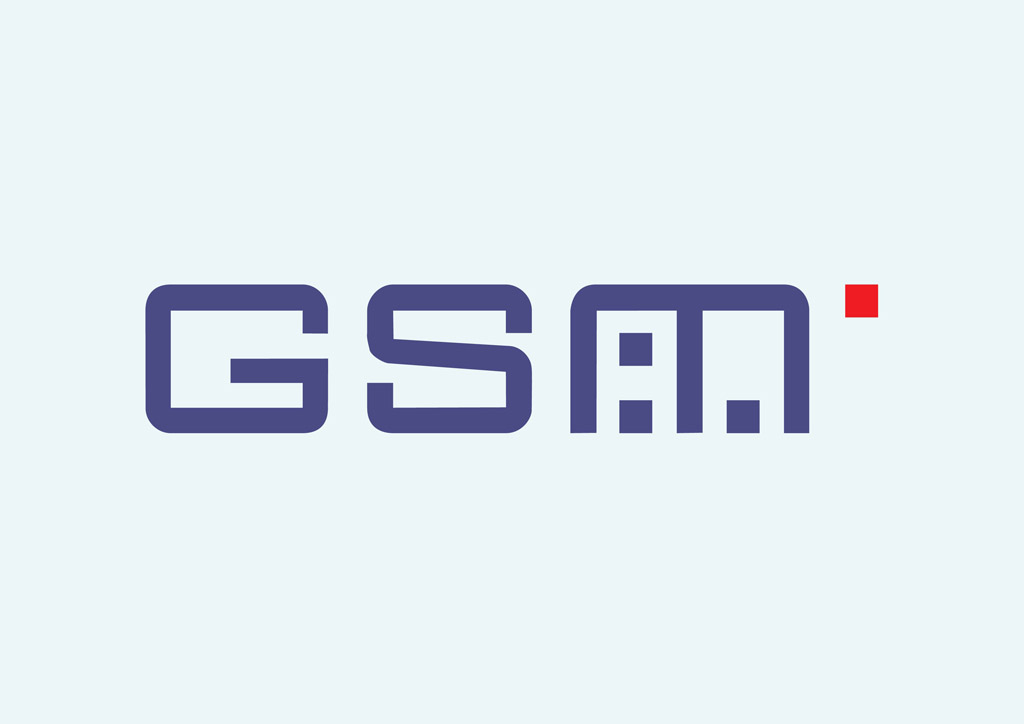

Macrotel X1/X2 Multimode manages calls from POTS (Plain Old Telephone Service), VoIP, BT or GSM (optional) telephone connections and it embeds a web server and a simple and intuitive GUI accessible from any device and browser. For services synchronisation and logs Macrotel X1/X2 Multimode connects to a NTP server.
The main XLR input and output connectors can manage analogue or AES/EBU signals according to the device settings (AES/EBU input/output is optional) while a second XLR analogue output is also available. When in BT mode the two outputs act like a stereo balanced output.
Macrotel X1/X2 Multimode records telephone calls on a USB flash memory plugged in the USB front panel slot. Audio will be recorded in PCM format with a self-explaining filename based on date/time and can include the RX audio only or both RX and TX signals. It is also possible to send an RTP-PCM audio stream to an external PC to record the call, in this case the recording will include the RX audio only or both RX and TX signals.
Customers using any digital console of the Oxygen series can control Macrotel X1/X2 Multimode through the network, just adding its IP address. In this way there is no need to use a GPIO but you should only connect the Macrotel X1/X2 Multimode to the Oxygen Console through the Telco module.
A multiple GPIO port allows to manage the device from external equipment, like audio console or PC. System sends “Ring”, “Hold”, “Hook” and “REC” status and manages “Hook”, “Rec”, “Mode” and “Hold” functions. On the front panel an audio meters with 18 LEDs shows the RX and TX audio level of each channel. Additional LEDs show working Mode and Power on. Power supply can be used between 90 and 260 V AC – 47-63 Hz: this allows to use it worldwide.
- Multi-line digital telephone hybrid POTS/GSM/VOIP
- Automatic gain control (AGC);
- Digital echo canceller;
- Hold caller/attenuator;
- Expander and compressor;
- Audio limiter;
- Digital AGC processor with 3 bands fully parametric EQ;
- Analog and AES/EBU digital inputs and outputs (optional);
- 1 line and 2 lines models;
- POTS/PSTN;
- GSM Quad Band (optional);
- Integrated web server for remote control;
- Separate send and receive;
- LAN and USB ports;
- Auto-answer and disconnection;
- Balanced XLR I/O;
- Remote control software and dialer;
- Echo cancellation through a digital process on DSP (POTS);
- Advanced audio processing functions: AGC, parametric EQ, audio filters, compressor, expander and limiter;
- Internal Web Server allows device configuration;
- Automatic setup;
- 1 selectable XLR input: Analogue or AES/EBU (AES/EBU is optional);
- 1 selectable XLR output: Analogue or AES/EBU (AES/EBU is optional);
- 1 balanced XLR analogue output;
- Phone call recording in PCM format on USB support (RX only or RX+TX);
- Front panel led meters displaying RX/TX levels;
- Audio stream generation in RTP/PCM format (RX only or RX+TX);
- Front panel LED: Gain RX, Gain TX, Mode;
- “Hook” and “Hold line” lighted buttons;
- 4 GPI interfaces, 4 GPO interfaces;
- Integrated Caller Identifier (CID) – only for VOIP;
- Input and output call logs;
- G711-G722 VOIP audio codecs:
- Local telephone output (POTS).
GENERAL FUNCTIONS
Macrotel X1/X2 Multimode parameters can be configured through a web interface and its web user friendly GUI is available from any kind of device: PC, notebook, tablet, smartphone.
Macrotel X1/X2 Multimode supports TCP/IP standards such as HTTP for web GUI and UDP for streaming. Connection to external NTP server (Internal RTC with buffer) for time synch and ethernet/GPIO connection are available. Macrotel X1/X2 Multimode has stainless steel enclosure and a front panel with 22 levels and status LEDs. Power supply: 90-260V AC 47-63 Hz – 10 W (green approach).
POTS MODULE
Macrotel X1/X2 Multimode embeds standard RJ11 sockets for connecting to the telephone line and to an external telephone set. Internal DIAL system via DTMF for direct call is also available (so the external telephone set is not mandatory). It is possible to export logs phone numbers of incoming and outgoing calls and save them on a USB key (date, call time start, call time end). It is possible to set the automatic telephone line hooking after a settable number of rings and automatic telephone line release based on the “dropped line” tone (this feature can be disabled). Among the many customizable parameters Macrotel X1/X2 Multimode also has adjustable AGC, compressor/limiter and equalizer parameters and adjustable telephone band (with low or hi-cut).
BT MODULE
Macrotel X1/X2 Multimode has a fully certified BT version 3.0 audio module, compatible with BT version 2.1+EDR, 1.2 and 1.1. SIP version 2.0 (RFC 3261) is also on, together with adjustable AGC, compressor/limiter and equalizer parameters.
Embedded BT stack profiles: A2DP and HFP/HSP. Supports iAP profile discovery for iPhone® and iPod® BT accessories G.711u. Dual-channels differential audio input and output for highest quality audio. Certifications: FCC, IC, CE.
VoIP MODULE
The VoIP is available through a standard network RJ45 connector. Macrotel X1/X2 Multimode embeds SIP version 2.0 (RFC 3261). Authentication methods: SIP/IAX Dynamic Registration (Register) and SIP Static IP authentication. Supported audio codecs: G.711u (PCM u) | G.711a (PCM a) | G.722 | G.722.1 24/32. Automatic telephone line hooking (after a settable number of rings) and automatic telephone line release based on the “dropped line” tone (this feature can be disabled). Logs of phone numbers of incoming and outgoing calls (date, call time start, call time end) are available and can get exported, as all the other logs, on USB key. Adjustable AGC, compressor/limiter and equalizer parameters are on as well as for the others connections mode.
Please note that supported PBXs and phone service providers require interoperability with established VoIP providers. Such services are delivered via either a SIP-based IP PBX or through a cloud-based telephone service provider. These are complex services, therefore sometimes configuring AxelTech products to interact with them can be difficult or not possible.
AxelTech constantly updates its products to reach compatibility with these services, nevertheless incompatibilities are still possible and any change or update made by the service providers or by the PBXs themselves can cause problems with Macrotel X1/X2 Multimode in VoIP mode.
Here below you can find the list of the PBXs and VoIP service providers that have been used successfully by our customers with our products: these services are not fully compatible 100% of the time, as one update can interfere with the compatibility and of course we cannot guarantee to test them. We would suggest to customers who are considering using Macrotel X1/X2 Multimode with services other than those listed below, to contact our technical support team before purchasing this service.
We will allow the customer to return the AxelTech product and obtain a refund if the device is not compatible with the service he has selected. The following services are currently reported as compatible with AxelTech Products: Supported PBXs: Asterix Supported VoIP Providers: Olimon Tel.
DIGITAL
- Digital audio AES/EBU input/Output
| GENERAL | |
|---|---|
| Power supply: | 90-260 V AC / 47-63 Hz |
| Power consumption: | 10 W |
| Dimensions WxHxD: | 483 x 44,5 x 140 mm (1 rack unit 19”) |
| Weight: | < 2Kg |
| ANALOG AUDIO INPUT | |
|---|---|
| Connectors: | Balanced on XLR – EMI Suppression |
| Input impedance: | 50 KΩ |
| Adjustable via software: -9 dBu ÷ +15,0 dBu | |
| Level range: | –20,0 dBu ÷ + 20,0 dBu |
| Input level max.: | +20,0 dBu |
| CMRR input: | >60 dB (20 Hz ÷ 20 kHz) |
| DIGITAL AUDIO INPUT (OPTIONAL) | |
|---|---|
| Connectors: | Balanced on XLR – EMI Suppression |
| Input impedance: | 110 Ω |
| Format: | AES3/EBU & SPDIF |
| Sample rate: | 32, 44.1, 48, 64, 88.2, 96 KHz |
| Nominal Input Level (sensitivity): | From 0,0 dBFs to –24dBFs (0,1dB step) |
| Level range: | 0,0 dBFs ÷ -36dBFs |
| ANALOG AUDIO OUTPUT | |
|---|---|
| Connectors: | Balanced on XLR – EMI Suppression |
| Output impedance: | 47 Ω |
| Output level: | Adjustable via software: -9dBu ÷ +15,0 dBu |
| Level range: | –20,0dBu ÷ + 20,0dBu |
| Output level max.: | + 20,0dBu |
| CMRR output: | >60dB (20Hz ÷ 20kHz) |
| DIGITAL AUDIO OUTPUT (OPTIONAL) | |
|---|---|
| Connectors: | Balanced on XLR – EMI Suppression |
| Input impedance: | 110 Ω |
| Format: | AES3/EBU |
| Sample rate: | 32, 44.1, 48, 64, 88.2, 96 KHz |
| Nominal Input Level (sensitivity): | From 0,0 dBFs to –24dBFs |
| Level range: | 0,0 dBFs ÷ -36dBFs |
| POTS INTERFACE | |
|---|---|
| Connectors: | 2x RJ11 Line and Telephone set |
| Output impedance: | Selectable |
| Bandwidth telephone line | 170Hz - 4.6kHz |
| Echo canceller suppression: | > 40dB |
| Signal to Noise Ratio (S/N) | ≤ -60dBu (Ref.0dB @1KHz Analog Out) |
| Frequency Response | ± 3dB (TBR21) ± 2dB (600 Ω) |
| Audio distortion | ≤ 0.2% (Ref.0dB @1KHz Analog Out) |
| VOIP INTERFACE | |
|---|---|
| Protocol: | SIP Version 2.0 - RFC 3261 |
| Codec Audio Compatibility: | G.711u (PCM u), G.711a (PCM a), G.722, G.722.1 24/32 |
| Authentication Methods: | SIP/IAX Dynamic Registration (Register) SIP Static IP authentication |
| BT INTERFACE | |
|---|---|
| Compatibility: | Fully certified BT version 3.0 audio module, Fully compatible with BT version 2.1+EDR Compatible with 1.2 and 1.1 |
| Connection mode: | Embedded BT stack profiles: A2DP and HFP/HSP |
| IOS: | Supports iAP profile discovery for iPhone® and iPod® BT accessories G.711u (PCM u) |
| GENERAL | |
|---|---|
| GPIO Inputs/Outputs: | 4 GPI 4 GPO |
| Communication Port: | 1xLAN |
| Front Panel LEDs: | 18+4+2 |
| USB: | Type A |
| Operating Temperature: | 0°C ÷ 50°C |
| COMMUNICATION | |
|---|---|
| Configuration Software: | Web Server |
| Password Protection: | Yes |
| UDP, TCP, HTTP, SNTP. | Yes |
| Supported Network Protocols: | HTTP, UDP, TCP, NTP, |
VJ Pro
FOCUS ON
Visual radio Automation
Introducing VJ Pro, the revolutionary Visual Radio solution by AxelTech, empowering radio stations to captivate audiences on TV.
In today’s diverse media environment, traditional and digital media are striving to capture larger audiences. Radio has the potential to broaden its impact through visual media by transmitting on television or web platforms. This presents an opportunity for stations to engage with individuals at home and in various public settings. Visual radio serves to strengthen stations at specific locations and VJ Pro enhances the visibility of your station.
VJ Pro seamlessly integrates with your existing setup, requiring no additional technicians or workflow adjustments. With minimal training, you can broadcast live radio programming and shows on both radio and TV, eliminating the usual costs and efforts associated with traditional TV production. Experience the power of Visual Radio without the need for TV expertise and with minimal investment. VJ Pro operates with the same technical staff and talent, ensuring a smooth transition without disrupting your radio station’s workflow. VJ Pro can be easily connected to any Radio Automation system and Digital Mixing Console, making it seamlessly integrate with your existing setup.
Why Should Radio Go Visual?
Radio is a versatile and strong media. In today’s competitive media market, both traditional and digital media are vying to reach bigger audiences. However, Radio has a unique opportunity to expand its reach going visual. Broadcasting Radio on a TV or Web Channel is a new frontier that allows stations to reach more people, including those at home and in public places such as malls where large monitors are available. Since Radio is already the go-to source for on-the-go media consumption, Visual Radio reinforces stations at fixed locations where it’s needed the most.
VJ Pro makes it possible for your station to be seen.
Benefits of simulcasting Radio on a TV channel:
- Expanding from a single media platform to a multi-media approach
- Reaching different audiences, thereby increasing the overall audience
- Managing multiple media platforms (Radio, TV, Web)
- Increasing advertising opportunities, leading to more revenue
- Cross-promotion and cross-selling
VJ Pro, the Visual Radio solution by AxelTech, has no impact on Studio Workflow, no need for additional technicians, and only quick training for the system setup. Live Radio programming and shows can be broadcast simultaneously on both Radio and TV without incurring the costs and efforts usually associated with traditional TV production. You don’t need TV expertise, the production cost is close to zero, and it involves a one-time minimal investment. Visual Radio runs with the same technical staff and talent used at the radio station. Radio keeps its workflow and equipment since VJ Pro can be connected to any Radio Automation system and Digital Mixing Console.
How VJ Pro Helps Radio Go Visual?
While a song is on the air VJ Pro coordinates to play the video, and switches the cameras when hosts activate the microphones or when journalists air the news. VJ Pro drives an intelligent switching for cameras: it can be manual or automatic according to the many criteria and combinations of status, and cameras can be controlled by the fader status or the microphone levels on the Radio mixer. VJ Pro does it at best with both simplicity and accuracy. Auxiliary sources from the Web or Desktop can be imported, such as video calls from Skype, clips from YouTube, etc. It is also possible to have a social network integration to display content from Facebook, WhatsApp, Twitter, and more. The VJ Pro Console is the engine and the control panel of whatever happens to the VJ Pro System and the connected devices. VJ Pro gets the info from the Radio automation system of any audio played (song, jingle, ads, news, recorder program, etc.), any live programs (talk shows, news, feeds, etc.), and any action on the audio mixer (fader, GPI, etc.) and consequently activates the related video content and graphics. The fully automatic production workflow can always be switched to manual.
The radio channel operations will go on running as usual because the VJ Pro Console seamlessly handles the synchronization between the TV and the radio stream. Any desired system behavior can be configured in the settings panel of the VJ Pro Console by the station manager or system administrator, who determines the style of the channel.
No matter how you name it – Radio Vision, Radio over TV, Visual Web Radio, Live Visual Radio, or Live TV for Radio – VJ Pro is the best way to achieve it!
The VJ Pro Console
The VJ Pro Console is the GUI that allows to control part or all of the features through a few Widgets:
- LAYOUTS, intended to manage the behavior of the whole system
- SWITCHER, dedicated to the Video Mixer control
- MASTERS, for choosing which automation is commanding the Visual Radio
- PLAYERS, to show information about playing clips. The playlist comes from the Radio Automation
- GRAPHICS, to manage superimposed graphics
- CAMERAS, to manage PTZ cameras
- STATUS, to view the status of all the system components
- RECORDER, to record what is currently on-air
The video format can be selected between PAL or NTSC. The resolution can be standard (SD), high resolution (HD), and 4K; in the case of SD, 4:3 or 16:9 can be chosen while in the case of HD, vertical 1080 or 720 pixels can be switched.
Versions
- VJ Pro
- VJ Pro Live
Add-Ons
- DMLX Compliance Recorder, useful for legal purposes and content repurposing;
- XMAM, for a structured management of the Video Clips to be put on-air with the Visual Radio;
- MXC, which extends the routing of the VJ Pro output to any IP output and manages SCTE signals.
- Fully Automatic or Manual workflow to produce a Visual Radio live video channel.
Figure 1 – VJ Pro Architecture
- VJ Pro is virtually compatible with any video and file format: DV, HDV, DVCPRO, MJPEG, MPEG-2, TS, MPG, VOB, H.264, H.265, AV1, MP4, QuickTime, PRORES, DNxHD, AVI, WMV, ASF, MXF, XDCAM, IMX, GXF, LXF, FLV, MKV, WebM, HuffYUV, VP8, VC3, JPEG2000, DPX in any resolution or frame rate with automatic adaption.
- Video Playout and Capture – 2 channels playout with video mixing/crossfade/effects. Perfect Audio/Video synch 1 channel recording.
- Graphics engine – Multi-layer CG for graphic generation with Fill and Key. Automatic titling (song author and title). Animations, logo, Ticker, Clock, etc. RSS feeds, Weather information, News, etc.).
- Free CG Composer software for graphic layout creation.
- User Interface – Smart GUI for manual control of graphics, layouts, video switcher, cameras, recorder, and studio switch. Hardware Instant keyboard with 64 hotkeys.
- Video Switcher control – Native integration with Atem, VMIX, Tricaster, etc. Connection: SDI/NDI/Stream (according to video switcher features). TCP/IP and serial connection.
- Integrations with external/third-party products are typically part of a Visual Radio setup:
- Radio Automation – Native integration with DJPro and Xradio automation from AxelTech;
- Middleware module to integrate third-party Radio automation (Zenon, Netia, etc.);
- Radio Console – Native integration with Oxygen digital radio console. Custom modules to integrate third-party mixing consoles (Studer, Axia, Lawo, DHD, Wheatstone, etc.). GPIO management;
- Cameras – Camera control (Sony/Visca/Panasonic protocols). Intelligent switch for automatic camera switch (multiple configurations and rules).
Figure 2 – Audio & Video typical routing
- Advanced Audio Routing: It allows to mixing of the studio audio live contribution, microphones, with the audio track of the video clip on air. This technicality adds a big value to the Visual Radio product, making possible a user experience identical to traditional radio broadcasting.
Figure 3 – VJ Pro Advanced Audio Routing
Free tools included in VJ Pro:
- XTrimmer > Metadata injector and quality control
- CGComposer > CG template creator
Video Out:
- Supported Video Cards: BMD DeckLink, AJA, Bluefish, Deltacast;
- Resolutions: SD, HD, 4K;
- NDI outputs;
- CG KEY and FILL output;
- BMD ATEM, NEWTEK TRICASTER, VMIX and others.
Video codecs:
- MPEG 4 part 2;
- Cisco OpenH264;
- Intel Quicksync H264;
- Nvidia NVEnc H264;
- Nvidia NVEnc H264 lossless;
- Nvidia NVEnc H265;
- MPEG 1;
- MPEG 2;
- DV;
- DVCPRO;
- MJPEG;
- FLV Sorenson;
- HuffYUV;
- WMV 8;
- Google VP8;
- Apple Prores proxy, LT, 422, HQ;
- QuickTime ANIM;
- Uncompressed 422 8-bit;
- Uncompressed 422 10-bit;
- DNxHD;
- VC3;
- OPEN JPEG2000;
- DPX.
File Format Wrappers:
- Mpeg Program (MPG);
- Mpeg Transport (TS);
- MPEG4 part 14 (MP4);
- QuickTime (MOV);
- DNxHD (MOV);
- IMX MPEG4;
- MXF;
- MXF D-10 (IMX);
- GXF;
- DV;
- FLV;
- DVD VOB;
- ASF;
- iPod Mp4;
- AVI;
- Matroska (MKV);
- WebM;
- Image Sequence (DPX, PNG, JPG).
Audio Codecs:
- WAV (16, 24, 32, Cinema, signed, floating, etc…);
- MP2;
- MP3;
- AC3 (ATSC A/52A);
- AAC;
- ALAC;
- ADCPM;
- VORBIS.
Graphic Formats:
- PNG, TGA, BMP, TIFF, JPG, GIF;
- Quicktime ANIM, Prores 4:4:4:4, bitmap sequences.
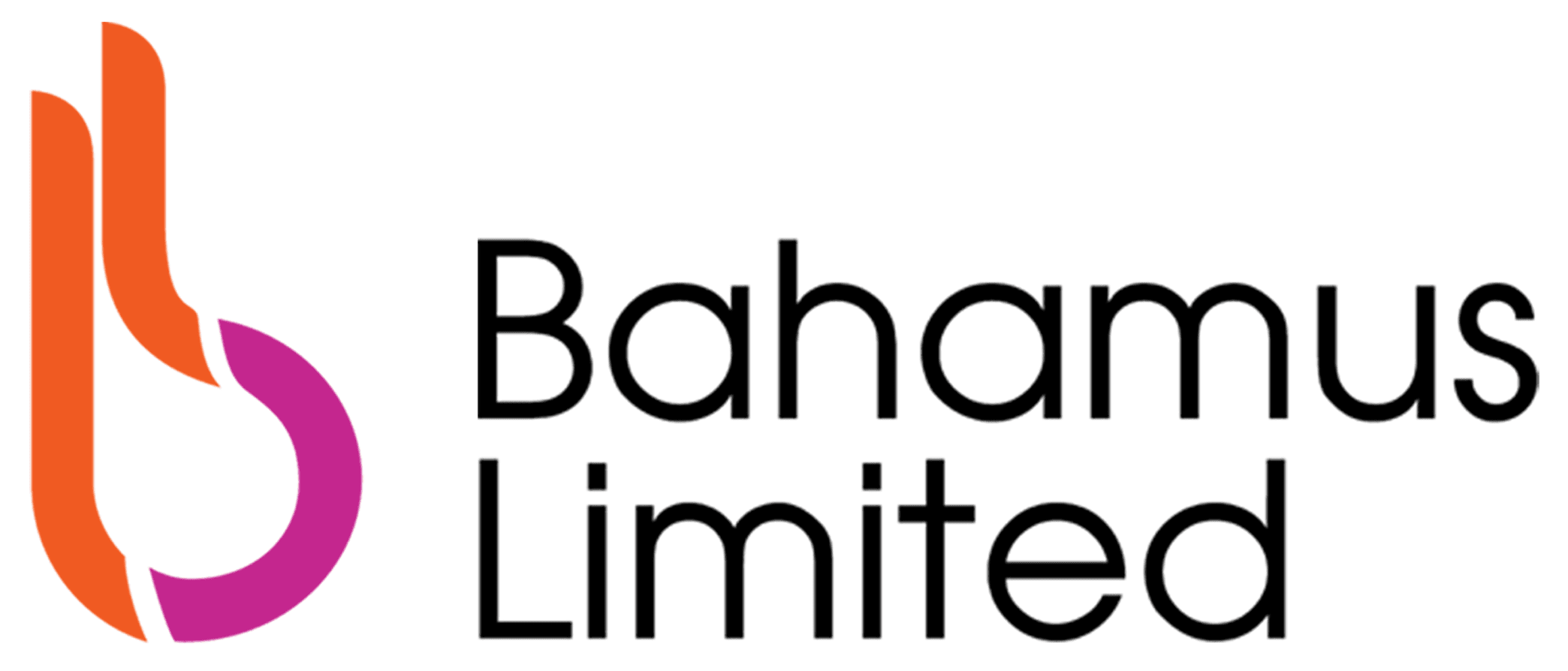
“We offer advanced broadcasting technology that combines visual and social media features to enhance user engagement. As a supplier, we have provided AxelTech’s products and solutions to various broadcasting companies, ensuring seamless integration into their existing infrastructures.
We are extremely satisfied with AxelTech as a partner and supplier. Their innovative solutions have consistently exceeded our expectations. The team at AxelTech is highly professional, responsive, and dedicated to delivering high-quality products and services that meet the unique needs of our clients.
Their ability to integrate advanced technology with practical broadcasting solutions has significantly enhanced the user experience in our projects.
AxelTech has demonstrated exceptional reliability in both the quality of its products and the timeliness of its support services. We are confident in their capacity to deliver high-level projects, such as the SABC tender, and we highly recommend them without reservation.”
Bahamus Limited – Ghana

Radio2 is the flagship FM/DAB channel of RAI, focusing on entertainment with a schedule primarily composed of live shows and music performances featuring both national and international talents.
The project aimed to create a Visual Radio channel for distribution on the national DVB-T 202 channel and streaming on the Raiplay portal (https://www.raiplay.it/dirette/rairadio2). RAI Radio 2 uses Netia Radio Assist for radio automation.
AxelTech provided the Visual Radio subsystem and advisory services for the commissioning. The centralized Visual Radio Control Room was configured to go on air with one of the 6 studios equipped for Visual Radio productions, including cameras, lights, monitors, and more.
“The project’s challenge was to launch the first RAI Visual Radio channel within a short timeframe. This involved integrating with existing automation and consoles, as well as collecting and post-producing 5,000 video clips. It also required defining the channel’s branding and establishing protocols for various scenarios such as automatic on-air, live studio, news bulletins, and advertisements. AxelTech played a crucial role, going beyond being a mere supplier by leveraging their experience to proactively guide through the production start process.”
Rai Radio2 – Italy
SBS owns and operates radio stations in major U.S. Hispanic markets, including New York, Los Angeles, Miami, Chicago, San Francisco, Orlando, Tampa, and Puerto Rico.
SBS has decided to implement Visual Radio for some of its stations to oversee live shows. During the shows, the DJ operates the broadcast consoles, while the VJ Pro manages everything else, such as camera switching, character generation (CG), animations, and other visual elements.
They have integrated Rubicon and Axia digital broadcast consoles for this purpose.
“After conducting several POCs with other vendors, we ultimately chose AxelTech as our Visual Radio solution provider due to its simple integration into our existing ecosystem. The support we received from the company throughout the system deployment was incredible.”
SBS – USA
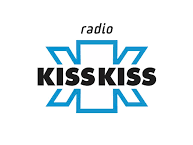
Radio Kiss Kiss, part of the CN Media Group, commissioned AxelTech to implement a Visual Radio system with specific requirements: no impact on current production processes, handling of live broadcasts and music videos, creation of independent advertising segments, management of video clips for jingles and stingers, automation of graphics production, frame-accurate synchronization of content, TV automation for nighttime slots, integration of Studer On-Air 2000 mixer & Zenon Media automation, audio signal distribution via Dante, and 4K visual channel production.
“Radio Kiss Kiss is well-known for its dedication to producing high-quality content with precision. We were worried that incorporating Visual Radio could compromise the meticulous work we do for our radio broadcasts. Additionally, we were concerned that integrating with the Zenon radio automation might lead to additional issues. However, AxelTech once again proved to be a reliable supplier, capable of assisting clients in finding the best solutions to meet their technical, editorial, and timing objectives.”
Radio Kiss Kiss – Italy
Case Histories
Radio Company
Visual Radio - Italy
Radio Bruno
Visual Radio - Italy
ON FM – Visual Radio
Portugal with SiteMaster
Asaase – Visual Radio
Ghana with Bahamus
Brothers FM, Lobi Broadcasting
Nigeria with Ecalpemos
RAI Radio
Italy
YouPlay
FOCUS ON
TV Production Playout
YouPlay is the smartest tool to manage video contribution in your PCR. YouPlay can send on-air any video format during news, talk shows or live events coverage. YouPlay can also feed studio video-walls, featuring clips playout or playlists, play/stop from still frame, animations and much more. YouPlay’s user-friendly interface fits perfectly into live productions and it is so intuitive that requires small to no training at all.


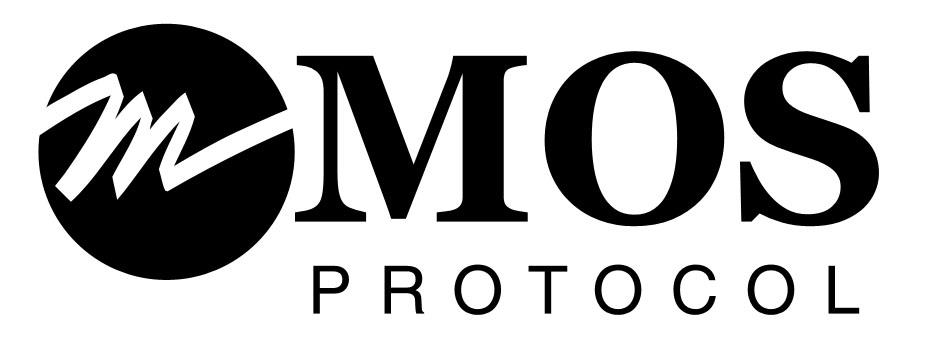



General
- SDI/NDI/IP 4K/2K/HD/SD Playout and Ingest (Ingest available on Youplay Server version only);
- Virtually any video and file format compatibility (SD/HD/2K/4K): DV, HDV, DVCPRO, MJPEG, MPEG-2, TS, MPG, VOB, H.264, H.265, AV1, MP4, QuickTime, PRORES, DNxHD, AVI, WMV, ASF, MXF, XDCAM, IMX, GXF, LXF, FLV, MKV, WebM, HuffYUV, VP8, VC3, JPEG2000, DPX and any audio or bitmap file format;
- Up to 16 Audio channels (Dynamic selection of enabled audio channels);
- Automatic Up and Down Scaling and Aspect Ratio adjustment (16/9, 4/3, etc…);
- Mosaic for Video Walls;
- Hardware Compatibility: BMD (SDI), AJA (SDI, SMPTE 2022 & SMPTE 2110), BlueFish (SDI, SMPTE 2022 & SMPTE 2110);
- Key output on SDI with 32 bits Bitmaps sequence, QuickTime Animation and ProRes 4:4:4;
- Timecode RP188-VITC-LTC;
- Crop, field swap, aspect correction mode (Letterbox, no Letterbox, stretch);
- Free CG Composer app for CG template creation;
- Timed CG on playlist with dynamic text metadata;
- Frame accurate single clip loops;
- Slow-motion up to -2x/+2x;
- Play while ingest (on YouPlay Server version only);
- Remote control with BMD Atem, Newtek Tricaster, BMD Hyperdeck Emulation, VDCP mixer, RS422 controller;
- MOS Protocol for Integration with most common Newsroom systems;
Versions
- YouPlay Pro (Playout only)
- YouPlay BRD (Playout only)
- YouPlay Server (Playout and Ingest)
YouPlay – Playout
- YouPlay is virtually compatible with any video and file format: DV, HDV, DVCPRO, MJPEG, MPEG-2, TS, MPG, VOB, H.264, H.265, AV1, MP4, QuickTime, PRORES, DNxHD, AVI, WMV, ASF, MXF, XDCAM, IMX, GXF, LXF, FLV, MKV, WebM, HuffYUV, VP8, VC3, JPEG2000, DPX in any resolution or frame rate with automatic adaption;
- YouPlay manages automatic upscale, downscale, framerate adaptation and aspect ratio correction, CG overlay, log and as run log files;
- Mark-in and mark-out and frame accurate loops are available together with slow motion (also with RS422 and VDCP controllers), REC while PLAY (for specific formats) with endless mark-out and a full set of Real Time tools such as Vertical and Horizontal Crop, field swap top bottom progressive, aspect ratio correction mode (letterbox, no letterbox, stretch, etc…), mirror and rotate;
- YouPlay also allows you to set the automatic load of the last playlist at start-up and offers a simple scheduling tool for automatic playout. Start time code can also be modified for each clip, audio preview is available on windows audio together with audio master volume and single clip volume;
- YouPlay also it embeds an advanced CG with clocks, tickers, rolls, crawls, bitmap animations and CG graphics as secondary events;
- You can use GPI in/out with MOXA and JLCOOPER for play and stop commands, you can remotely control BMD ATEM;
- and NewTek TriCaster and use Ableton Launchpad hotkeys Free CG composing app to create templates;
- SDI preview output with OSD (timecode) is also available and the free XTrimmer tool grants quality control with SDI/NDI output, metadata insertion and loudness control;
- In YouPlay you can also set a default behavior for duration, stop mode, aspect ratio, fields swap and stretch mode and a watch folder with GUI notification and 1 button load;
- Multiple channel control from main channel is available for play, stop, pause, rec and stop rec as well as the automatic use of external audio files with same filename. REST API commands and SNMP MIB, TRAPS and Alerts are also on;
- YouPlay is compatible with MOS protocol for multiple channel gateway (protocols supported : SONY RS422,VCDP RS422, VDCP TCP/IP, BMD HYPERDECK) and has an integration for 3rd party RS232 RS422 routing switchers.
YouPlay – Ingest
- With YouPlay Server you will also be able to manage the many tools of the YouPlay’s Ingest Core, such as the Capture time limit or automatic file switch and the simultaneous PROXY file capture;
- The Internal RTMP server allows a for point to point connections over internet and in case of live sources you can manage SDI to NDI. IP streaming encoder of live input in RTMP, UDP, RTSP, IIS, HLS, WMS is also available;
- The Ingest provides customizable memory buffer for capture and a batch capture from RS422 VTRs;
- You can get accurate statistics of capture process as well as scheduling a calendar for unattended capture processes, log files are off course available together with seamless file switching during capture and image grab with custom file syntax;
- Audio preview on sound card is available as well as volume adjustment with original volume simultaneous display;
- Remote control TCPIP of Blackmagic Design ATEM, Videohub and NewTek TriCaster and remote control of any RS232 or RS422 routing switcher or master control;
- SOAP & REST API and watchdog service are included.
YouPlay Playout
- Supported Video Cards: BMD DeckLink and Intensity, AJA Corvid, Bluefish
- Resolutions: SD, HD, 2K, 4K (depending on AV card)
- Simultaneous NDI output
- Up to 16 Audio channels
- 10 Bit video output for CC over SDI and ancillary data
- KEY and FILL output (if supported by video card)
- Timecode rp188 and LTC
- SDI inputs, NDI sources and URLs on the playlist
- MOS, RS422, BMD ATEM, NEWTEK TRICASTER, BMD HYPERDECK emulation
GUI
- Channel alias, icon and color
- Preview framerate adjust for RDP optimization
- Customizable shortcuts for CUE, PLAY, FIRST FRAME
- CC on preview
- Drag and Drop of multiple files
- Drag and Drop between Channels
- Single clip position duration and position display
- Total playlist duration and remain display
- First frame positioning
- OSD vu-meters and waveform
- Customizable number of vu-meters
- Realtime video preview
- Customizable skins
- Customizable drag and drop file sorting
- Simple player or graphical/grid playlist GUI
- Independent and sizable GUI for each channel
- 4 channel GUI scaled for 1920×1080 screen
YouPlay Ingest – GUI
- OSD vu-meters and waveform
- Counters for total and segment
- File code and Timecode counters
- Taskbar miniplayer
- User definable shortcuts
- WEB GUI
- Channel label
- Sizable GUI
- Realtime video preview
- Average and instant data rate monitoring
- Space and time left on disk real time calculation
- NDI source selection on main GUI
- OSD display for counters
- Custimizable 2-16 channel vu and peak meters
Video Codecs
- MPEG 4 part 2
- Cisco OpenH264
- Intel Quicksync H264
- Nvidia NVEnc H264
- Nvidia NVEnc H264 lossless
- Nvidia NVEnc H265
- MPEG 1
- MPEG 2
- DV
- DVCPRO
- MJPEG
- FLV Sorenson
- HuffYUV
- WMV 8
- Google VP8
- Apple Prores proxy, LT, 422, HQ
- QuickTime ANIM
- Uncompressed 422 8-bit
- Uncompressed 422 10-bit
- DNxHD
- VC3
- OPEN JPEG2000
- DPX
System requirements depend on
- Video playout and capture resolution
- Video codec format
- Number of simultaneous playout/capture/streaming/proxy
- GPU accelerated capture with Nvidia GTX or better and Intel quicksync
File format wrappers
- Mpeg Program (MPG)
- Mpeg Transport (TS)
- MPEG4 part 14 (MP4)
- QuickTime (MOV)
- DNxHD (MOV)
- IMX MPEG4
- MXF
- MXF D-10 (IMX)
- GXF
- DV
- FLV
- DVD VOB
- ASF
- iPod Mp4
- AVI
- Matroska (MKV)
- WebM
- Image Sequence (DPX, PNG, JPG)
Audio codecs
- WAV (16, 24, 32, Cinema, signed, floating etc)
- MP2
- MP3
- AC3 (ATSC A/52A)
- AAC
- ALAC
- ADCPM
- VORBIS
Suggested system requirement
- I7 8700K CPU
- Windows 10
- 16GB RAM
- NVidia GTX
Minimum system requirement
- I3 CPU
- Windows 7
- 4GB RAM
Case Histories
Asaase – Visual Radio
Ghana with Bahamus
XTV Suite
FOCUS ON
TV Automation Suite
XTV Suite is a professional set of software for TV Broadcast Automation which manages Video Playout, Capture, Trimming, Scheduling and CG. Granting automatic and unattended efficiency 24×7, XTV is the perfect tool for TV stations, Satellite Channels, Cable TV, News Room, Web TV, CCTV. Corporate TV, hotel pay TV channels, museums info channels and video wall display can also use it and take advantage of its user-friendly interface. XTV Channel In A Box (CIAB) architecture guarantees a linear scalability of your TV Playout facility.
XTV Suite supports SDI (HD, 4K, 8K), IP I/O such as NDI, SMPTE 2022 & SMPTE 2110 (with specific video cards), UDP, RTMP, HLS, RTSP and more. Now also ready for Cloud with the latest XTV Cloud release!






General
- All in one broadcast 4K – 2K – HD – SD playout
- Complete workflow management tools: scheduling, trimming, graphic composer
- Real-time capture from SDI-NDI-IP
- Multiple codec playout in the same playlist with resolution and frame rate automatic adaption
- Multiple format playout, automatic up/down scaling and aspect ratio adjustment (16/9, 4/3, etc…)
- File sharing on LAN architecture
- Direct file playout from NLE (no transcoding)
- Up to 16 audio channels management
- Simultaneous NDI output
- Direct streaming output transport stream MPEG2 and H.264 codec, or RTMP
- Automatic management of time during playout (delay/ahead) with filler
- Live source full handling inside the playlist control of VTR, Switcher, GPI to Cart Machine
- Multichannel and high availability configurations
- Hot Key feature for instant videos playout
- Graphic overlay: logos, clocks, tickers, animations
- High quality squeezeback with animated background
- Subtitles in overlay and Closed Caption
- Clip trimming and Metadata for advertisement graphic contents
- Support of SCTE-104 and SCTE-35 commands for AD Insertion
- Support of EAS (Emergency Alert System)
- User friendly playlist view with explicative colour scheme
- As run and system logs for certification
Versions
- XTV Suite (Software for 1 Playout + 1 Ingest)
- XTV Compact (Software+Hardware for 1 Playout + 1 Ingest)
- XPlayout (Software for 1 Playout)
- XPlayout Compact (Software+Hardware for 1 Playout)
- XIngest (Software for 1 Ingest)
- XIngest Compact (Software+Hardware for 1 Ingest)
Options
-
- XMirror
Media compatibility and multiformat benefits
XTV plays out any kind of media in any resolution: DV, HDV, MPEG-2, MPEG-4, MPEG-1, H.264, QuickTime, MXF, XDCAM, PRORES, DNXHD, GXF, LXF, etc. XTV allows to play and mix any media format according to broadcaster’s production workflow and pros and cons of each AV codec.
XTV is compatible with the video cards from these manufacturers: Aja, Blackmagic, Bluefish4444, DekTec, Deltacast, Magewell, Stream Labs, Yuan
Dynamic Playlist: Real time playlist management without black frames nor freezes. Advanced Scheduler: Unlimited playlist length with automatic clip skipping and cutting when late.
Duration stretching when ahead of time. Sequence loop.
Automatic filler insertion for gap handling.
Log Report: Status and playout logging, with XML export for easy processing and printing.
No Database: Metadata is saved directly into media file, allowing file rename, copying and moving.
IP workflows
Support of IP I/O such as NDI, SMPTE 2022 & SMPTE 2110 (with specific video cards) turns XTV Suite to a game changer. NDI and IP sources are also supported directly on the playlist allowing playout of NDI, UDP, RTP, RTSP, RTMP, HTTP streams and setting parameters specifically, such as aspect ratio correction modes, vertical and horizontal crop to minimize letterbox on air, field dominance inversion, etc.
An internal IP encoder allows sending playout output via UDP to external multiplexers, or via RTMP, HLS, RTSP, IIS Live smooth, or windows media streaming to cloud servers for media distribution on internet. If an Nvidia GTX or better board is installed, GPU accelerated compression allows to use H264 and H265 codecs without affecting the computer’s CPU.
XTV Cloud
The new version of the well-known XTV Suite: specially designed to be installed on physical or Virtual Machines, both at your own data center or at your favorite Cloud Provider’s premises.
XTV Cloud requires a Windows Server Operating System and a hardware configuration with enough performance to act as a Video Server with IP based I/O.
Access to the Playout and Management Applications is achieved using RDP over HTML technology through any web browser on any operating system and device.
User interface is automatically scaled to the device being used and up to three simultaneous users can connect allowing control of the Playout, Media Upload, Trimming and Playlist Management at the same time.
Audio Monitoring and preview is also passed directly through the web browser allowing a seamless user experience.
Final IP output can be configured in many formats including RTMP, SRT, HLS, DASH , etc… and scaled as desired, while SCTE-35 triggers are available in SRT, UDP, HLS embedded in the video stream (not in the manifest file).
Live inputs can be configured to receive IP streams from the studio or outside broadcasts and are displayed on the Playout Multiviewer with on-screen vu meters and audio preview on the web browser.
Among the available formats you’ll find WebRTC: high quality and low latency assured plus the chance to use an AxelTech MXC as an encoder. The popular SRT format can also be used, encoding from a Vmix Software or a hardware box.
Designed to achieve a true universal format compatibility
Multi-channel TV stations and TV networks will enjoy XTV scalable structure and universal file compatibility.
XTV is designed to achieve a full universal format compatibility. XTV ties together all production departments allowing direct playout of DV, HDV, MPEG-2, MPEG-4, H.264, H.265, QuickTime, AVI, MXF, XDCAM, PRORES, DNXHD, GXF, LXF, etc… in any resolution or frame rate with automatic adaption.
XTV Suite will satisfy those customers looking for second generation CIAB – Channel In A Box and will provide traditional playout deployment reliability and functionalities with the typical CIAB TCO.
SCTE-104 and SCTE-35 support
AD Insertion is a critical step for many video delivery systems and one of the most important considering the income that it should generate.
OTT (Over-The-Top) video delivery on the internet helps getting the best results in advertisement cause it is possible to send customised ads to each viewer. These systems are partially based on the AD Insertion workflow which uses the SCTE-104 and SCTE-35 standard commands as triggers.
AxelTech products for playout and encoding (XTV/XPlayout and MultiCrossConverter) support SCTE-104 on SDI outputs and SCTE-35 on IP streaming in Transport stream and SRT, inserting the SCTE metadata in the video signals/streams.
EAS (Emergency Alert System) support
The EAS (Emergency Alert System) interface, when used in conjunction with Xplayout automation software, offers broadcasters increased flexibility in broadcasting emergency alerts received from U.S. government agencies.
The critical EAS data information for on-screen text crawls received via Serial Port and audio received via a stream, are decoded by the XPlayout. The on-screen text alert is then generated, and the corresponding audio stream is delivered on-air via the SDI output (on BMD Decklink only), reducing the audio level of the current program to ensure recognition of the emergency messages.
One of the notable features of the system is the ability to customize the EAS feed for each channel. This includes adding separate logos for each channel, adjusting colors, and modifying the aspect ratio of the emergency alert graphic. These customizations can be made without disrupting the SDI signal, ensuring compatibility with existing broadcast infrastructure.
Furthermore, with the use of XPlayout, a single EAS Appliance can provide tailored EAS alerts to multiple channels simultaneously. This capability enables broadcasters to establish consistent branding across all their channels, creating a cohesive viewer experience during emergency situations.
The EAS interface in conjunction with XPlayout grants broadcasters greater flexibility in airing emergency alerts by allowing customization of on-screen graphics and audio streams, while also ensuring consistent branding across multiple channels using a single EAS Appliance.
Input Sources Multiview
In XPlayout all configured live sources in NDI, SDI and WebRTC can be displayed in a preview window on the main GUI.
The preview window features on screen vu-meters and audio waveform, audio pre listen, fast “take to air” button and a 2×2 multiview option.
XTV Suite includes:
- XPlayout > 24×7 Automation
- XIngest > real-time capture from SDI-NDI-IP
Free tools included in XTV Suite:
- XTrimmer > Metadata injector and quality control
- XScheduler > Offline playlist management
- CGComposer > CG template creator
- XLogsViewer > As run logs viewer
- XInfo > Playlist information display
- XRouter > Routing switcher sharing on LAN
- XRemote > Remote control or routing switcher
- XEmergency > N+1 playout redundancy (needs XPlayout licence)
Additional software modules not included in XTV Suite:
- XMirror > Playlist media cache copier
XMirror
XMirror is a great feature when using a network NAS workflow. XMirror copies all files which populate the playlist from the big NAS onto a small local hard disk. Copies are performed slowly (to avoid saturating LAN bandwidth) and constantly (any modification to the playlist will trigger the copy process). Old files are deleted automatically to preserve disk space. If LAN or NAS fails, files will be played automatically from the local disk. If Local hard disk path is specified as a preferred path, media will always be played locally.
XPlayout
- Supported Video Cards: Blackmagic Design DeckLink and Intensity, AJA Corvid, Bluefish
- Resolutions: SD, HD, 2K, 4K (depending on AV card)
- Simultaneous NDI output
- Simultaneous WebRTC output
- Preview output on SDI
- Up to 16 Audio channels
- Timecode rp188
- Virtual device emulation for use as capture device in 3rd party software
- Split CG layer on separate SDI or NDI in Key and Fill
- SDI or NDI inputs for LIVE sources in AV bypass
- Internal Digital Loudness processor ITU 1770 available on XPlayout to always get the right volume on the output
GUI
- Full screen GUI optimized for 1920×1080 monitor
- Channel Alias
- Preview framerate adjust for RDP optimization
- CC preview
- Drag and Drop of multiple files
- Single clip position duration and position display
- Total playlist duration and remain display
- First frame positioning
- Dual graphical or grid style playlist GUI
- Drag and Drop to GUI
- OSD vu-meters and waveform
- Realtime video preview
- GUI lock with password
- Customer Logo on main screen
- Colors according to file gender or status
Features
- Virtually any video and file format compatibility
- Automatic upscale, downscale, framerate adaptation and aspect ratio correction
- CG overlay
- Key output on SDI with 32 bits QuickTime Anim, QuickTime ProRes 4:4:4:4, bitmap sequence
- As run logs
- Log files
- VGA compatibility mode for old VGA cards
- Separate audio track file management
- Remote control of Blackmagic Design ATEM and NewTek TriCaster
- MarkIn and MarkOut management (triggering)
- Frame accurate loops REC while PLAY (for specific formats) with endless MarkOut
- Realtime Vertical and Horizontal Crop
- Realtime field swap: top bottom progressive
- Realtime aspect ratio correction mode: Letterbox, no letterbox, stretch
- Detailed info on playlist, preview and output status
- AGC – Automatic Gain Control
- Automatic switch on backup path in case of main path failure
- Automatic play from preferred path if same media copy is available
- Status file and thumbnail update of main output
- Autofill from folder when ahead of time or end of playlist
- Automatic load of playlist according to file syntax
- Emergency file with hotkeys, also with numeric keyboard
- Automatic load of last playlist at start-up
- Routing switcher remote control : Blackmagic Design ATEM and Videohub, NewTek TriCaster, any RS232 or RS422 routing switcher or master control
- VCR automation UVW, VP9xxx or and RS422 SONY
- Cart machine control: PROMATIC, DIGICART
- Fast CG for emergencies: clock, text and crawl
- Automatic CG according to file gender or user custom types
- Remote control of external CG
- Integrated master and slave workflow
- From 5 seconds to 1 day delay for SDI/NDI sources as time shifting
- Subtitle rendering for SRT files
- Advanced CG with clocks, tickers, rolls, crawls, bitmap animations, any video file format
- 2D Squeezeback with advanced background graphics layer
- All CG graphics as secondary events
- GPI in/out
- Automatic skip/cut if schedule is late
- Exact time management in cut/wait for end of current event
- CG composing tool for template creation
- Non-intrusive sub clip creation for advertisement insertion
- Crossfade/effects between files
- Traffic scheduling tool
- Quality control tool with SDI/NDI output, metedata insertion and loudness control
- Automatic media copy tool from NAS to local hard disk (optional)
- Automatic music playlist creator (optional)
XIngest
- Supported Video Cards: Blackmagic Design DeckLink and Intensity, AJA Corvid, Bluefish
- Resolutions: SD, HD, 2K, 4K (depending on AV card)
- Simultaneous NDI output
- Simultaneous WebRTC output
- Preview output on SDI
- Up to 16 Audio channels
- Virtual device emulation for use as capture device in 3rd party software
GUI
- Full screen GUI optimized for 1920×1080 monitor
- Channel Alias
- Preview framerate adjust for RDP optimization
- CC preview
- Drag and Drop of multiple files
- Single clip position duration and position display
- Total playlist duration and remain display
- First frame positioning
- Dual graphical or grid style playlist GUI
- Drag and Drop to GUI
- OSD vu-meters and waveform
- Realtime video preview
- GUI lock with password
- Customer Logo on main screen
Features
- Virtually any video and file format compatibility
- Automatic upscale, downscale, framerate adaptation and aspect ratio correction
- CG overlay
- Key output on SDI with 32 bits QuickTime Anim, QuickTime ProRes 4:4:4:4, bitmap sequence
- As run logs
- Log files
- VGA compatibility mode for old VGA cards
- Separate audio track file management
- Remote control of Blackmagic Design ATEM and NewTek TriCaster
- MarkIn and MarkOut management (triggering)
- Frame accurate loops REC while PLAY (for specific formats) with endless MarkOut
- Realtime Vertical and Horizontal Crop
- Realtime field swap: top bottom progressive
- Realtime aspect ratio correction mode: Letterbox, no letterbox, stretch
- Detailed info on playlist, preview and output status
- AGC – Automatic Gain Control
- Automatic switch on backup path in case of main path failure
Video Codecs
- MPEG 4 part 2
- Cisco OpenH264
- Intel Quicksync H264
- Nvidia NVEnc H264
- Nvidia NVEnc H264 lossless
- Nvidia NVEnc H265
- MPEG 1
- MPEG 2
- DV
- DVCPRO
- MJPEG
- FLV Sorenson
- HuffYUV
- WMV 8
- Google VP8
- Apple Prores proxy, LT, 422, HQ
- QuickTime ANIM
- Uncompressed 422 8-bit
- Uncompressed 422 10-bit
- DNxHD
- VC3
- OPEN JPEG2000
- DPX
File format wrappers
- Mpeg Program (MPG)
- Mpeg Transport (TS)
- MPEG4 part 14 (MP4)
- QuickTime (MOV)
- DNxHD (MOV)
- IMX MPEG4
- MXF
- MXF D-10 (IMX)
- GXF
- DV
- FLV
- DVD VOB
- ASF
- iPod Mp4
- AVI
- Matroska (MKV)
- WebM
- Image Sequence (DPX, PNG, JPG)
Audio codecs
- WAV (16, 24, 32, Cinema, signed, floating etc)
- MP2
- MP3
- AC3 (ATSC A/52A)
- AAC
- ALAC
- ADCPM
- VORBIS
Hardware Requirements
Suggested
- I7 8700K CPU
- Windows 10
- 16GB RAM
- NVidia GTX
Minimum
- I3 CPU
- Windows 7
- 4GB RAM
Hardware requirements depend on:
- Video capture resolution
- Video codec format
- Number of simultaneous capture/streaming/proxy
We recommend to check the requirements with your Sales Area Manager before to proceed


